UTT TECHNOLOGIES REG02-UTT Wireless Router User Manual
SHANGHAI UTT TECHNOLOGIES CO., LTD. Wireless Router
User Manual

AC750W Wireless Router
Advanced Configuration Guide
V1.0

UTT Technologies Table of Contents
http://www.uttglobal.com Page 2
UTT Technologies Co., Ltd.
http://www.uttglobal.com

Copyright Notice
Copyright © 2000-2011. UTT Technologies Co., Ltd. All rights reserved.
Information in this document, including URL and other Internet Web site references, is
subject to change without further notice.
Unless otherwise noted, the companies, organizations, people and events described in
the examples of this document are fictitious, which have no relationship with any real
company, organization, people and event.
Complying with all applicable copyright laws is the responsibility of the user. No part of this
document may be reproduced, stored in or introduced into a retrieval system, or
transmitted in any form or by any means (electronic, mechanical, photocopying, recording,
or otherwise), or used for any commercial and profit purposes, without the express prior
written permission of UTT Technologies Co., Ltd.
UTT Technologies Co., Ltd. has the patents, patent applications, trademarks, trademark
applications, copyrights and other intellectual property rights that are mentioned in this
document. You have no license to use these patents, trademarks, copyrights or other
intellectual property rights, without the express prior written permission of UTT
Technologies Co., Ltd.
艾泰®and UTT®are the registered trademarks of Technologies Co., Ltd.
HiPER ®is the registered trademark of UTT Technologies Co., Ltd.
Unless otherwise announced, the products, trademarks and patents of other companies,
organizations or people mentioned herein are the properties of their respective owners.
Product Number (PN): 0904-0003-008
Document Number (DN): PR-PMMU-1150.50-PPR-EN-1.0A

UTT Technologies Table of Contents
http://www.uttglobal.com Page I
Table of Contents
About This Manual............................................................................................................................... 1
0.1 Scope.......................................................................................................................................1
0.2 Web UI Style........................................................................................................................... 1
0.3 Documents Conventions.......................................................................................................2
0.3.1 Symbol Conventions..................................................................................................... 2
0.3.2 Other Conventions.........................................................................................................2
0.3.3 Common Button Descriptions......................................................................................2
0.3.4 Detailed Description of List.......................................................................................... 3
0.4 Factory Default Settings........................................................................................................5
0.5 Document Organization........................................................................................................ 5
0.6 Contact Information................................................................................................................9
Chapter 1 Product Overview..................................................................................................10
1.1 Product Brief.........................................................................................................................10
1.2 Key Features.........................................................................................................................11
1.3 Physical Specification..........................................................................................................12
Chapter 2 Hardware Installation...........................................................................................13
2.1 Physical Characteristics......................................................................................................13
2.1.1 Front Panel...................................................................................................................13
2.1.2 Rear Panel....................................................................................................................14
2.2 Installation Procedure..........................................................................................................15
Chapter 3 Quick Setup............................................................................................................ 18
3.1 Configuring Your Computer................................................................................................18
3.2 Logging in to the Wireless Router.....................................................................................20
3.3 Setup Wizard........................................................................................................................ 22
3.3.1 Running the Setup Wizard.........................................................................................22
3.3.2 Setup Wizard - Internet Access Mode......................................................................23
3.3.3 Setup Wizard - Internet Connection Settings..........................................................24
3.3.4 Setup Wizard - Wireless Settings............................................................................. 32
Chapter 4 Start Menu...............................................................................................................34
4.1 Setup Wizard........................................................................................................................ 34
4.2 System Status...................................................................................................................... 34
4.2.1 Wired Status.................................................................................................................34
4.2.2 Wireless Status............................................................................................................35

UTT Technologies Table of Contents
http://www.uttglobal.com Page II
4.3 Interface Traffic.....................................................................................................................37
4.4 Restart................................................................................................................................... 39
Chapter 5 Network....................................................................................................................40
5.1 WAN Settings....................................................................................................................... 40
5.1.1 Internet Connection List..............................................................................................40
5.1.2 Internet Connection Settings..................................................................................... 44
5.1.3 MAC Address Clone....................................................................................................50
5.2 Load Balancing.....................................................................................................................51
5.2.1 Introduction to Load Balancing and Failover...........................................................51
5.2.2 Load Balancing Global Settings................................................................................53
5.2.3 Load Balancing List.....................................................................................................54
5.2.4 Connection Detection Settings..................................................................................55
5.2.5 How to Configure Connection Detection Settings..................................................57
5.3 LAN Settings.........................................................................................................................58
5.4 DHCP Server........................................................................................................................59
5.4.1 DHCP Server Settings................................................................................................59
5.4.2 Static DHCP................................................................................................................. 61
5.4.3 DHCP Client List..........................................................................................................63
5.4.4 Configuration Example for DHCP.............................................................................65
5.5 DDNS.....................................................................................................................................68
5.5.1 Introduction to DDNS..................................................................................................68
5.5.2 Apply for a DDNS Account.........................................................................................68
5.5.3 DDNS Settings.............................................................................................................69
5.5.4 DDNS Status................................................................................................................71
5.5.5 DDNS Verification........................................................................................................72
5.6 UPnP......................................................................................................................................73
5.6.1 Enable UPnP................................................................................................................73
5.6.2 UPnP Port Forwarding List.........................................................................................73
Chapter 6 Wireless................................................................................................................... 75
6.1 Basic Wireless Settings...................................................................................................... 75
6.1.1 AP Mode....................................................................................................................... 75
6.1.2 APClient Mode.............................................................................................................77
6.1.3 WDS.............................................................................................................................. 79
6.1.4 Configuration Example for WDS...............................................................................84
6.2 Wireless Security Settings..................................................................................................88
6.2.1 Disabling Wireless Security....................................................................................... 88
6.2.2 Wireless Security Settings – WEP............................................................................88
6.2.3 Wireless Security Settings - WPA/WPA2.................................................................90
6.2.4 Wireless Security Settings - WPA-PSK/WPA2-PSK.............................................. 91
6.3 Wireless MAC Address Filtering........................................................................................93
6.3.1 MAC Address Filtering Global Settings....................................................................93
6.3.2 MAC Address Filtering List.........................................................................................94

UTT Technologies Table of Contents
http://www.uttglobal.com Page III
6.3.3 MAC Address Filtering Settings................................................................................ 94
6.3.4 How to Configure MAC Address Filtering................................................................95
6.3.5 Configuration Example for MAC Address Filtering.................................................95
6.4 Advanced Wireless Settings.............................................................................................. 97
6.5 Wireless Client List.............................................................................................................. 99
Chapter 7 Advanced.............................................................................................................. 100
7.1 NAT and DMZ.....................................................................................................................100
7.1.1 Introduction to NAT Features...................................................................................100
7.1.2 Port Forwarding.........................................................................................................103
7.1.3 NAT Rule.....................................................................................................................106
7.1.4 DMZ............................................................................................................................. 112
7.2 IP/MAC Binding..................................................................................................................114
7.2.1 Introduction to IP/MAC Binding............................................................................... 114
7.2.2 IP/MAC Binding Global Settings............................................................................. 115
7.2.3 IP/MAC Binding List.................................................................................................. 116
7.2.4 IP/MAC Binding Settings..........................................................................................117
7.2.5 How to Add IP/MAC Bindings..................................................................................118
7.2.6 Internet Whitelist and Blacklist.................................................................................119
7.3 Static Route........................................................................................................................122
7.3.1 Introduction to Static Route..................................................................................... 122
7.3.2 Static Route List........................................................................................................ 122
7.3.3 Static Route Settings................................................................................................ 123
7.3.4 How to Add Static Routes........................................................................................ 124
7.4 PPPoE Server.................................................................................................................... 126
7.4.1 PPPoE Overview.......................................................................................................126
7.4.2 PPPoE Server Global Settings................................................................................128
7.4.3 PPPoE Account List..................................................................................................129
7.4.4 PPPoE Account Settings..........................................................................................129
7.4.5 PPPoE User Status...................................................................................................130
Chapter 8 User Management...............................................................................................132
8.1 Global Management..........................................................................................................132
8.1.1 Global Management Policy Settings...................................................................... 132
8.1.2 An Example for Global Management Policy......................................................... 134
8.2 Group Management.......................................................................................................... 135
8.2.1 Group Management Policy List...............................................................................135
8.2.2 Group Management Policy Settings.......................................................................136
8.2.3 Execution Order of Group Management Policies.................................................138
8.2.4 Priorities of Global and Group Management Policies and Access Rules.........138
8.2.5 An Example for Group Management Policy..........................................................138
Chapter 9 Firewall.................................................................................................................. 143
9.1 Access Control...................................................................................................................143

UTT Technologies Table of Contents
http://www.uttglobal.com Page IV
9.1.1 Introduction to Access Control................................................................................ 143
9.1.2 Access Rule List........................................................................................................145
9.1.3 Access Rule Settings................................................................................................146
9.1.4 Configuration Examples for Access Rule.............................................................. 151
9.2 Domain Filtering.................................................................................................................157
9.2.1 Domain Filtering Global Settings............................................................................ 157
9.2.2 Domain Filtering Settings.........................................................................................157
9.3 Attack Prevention...............................................................................................................159
Chapter 10 VPN.........................................................................................................................160
10.1 Introduction to PPTP Implementation.............................................................................160
10.1.1 Protocol Overview.....................................................................................................161
10.1.2 Packet Flow - PPTP Client.......................................................................................162
10.1.3 User Authentication...................................................................................................163
10.1.4 Data Confidentiality...................................................................................................163
10.1.5 MTU and Fragmentation.......................................................................................... 163
10.1.6 PPTP Sessions Limit................................................................................................ 165
10.2 PPTP Client Settings.........................................................................................................165
10.3 PPTP Client List.................................................................................................................166
10.4 Configuration Example for PPTP Client.........................................................................167
Chapter 11 System Administration......................................................................................169
11.1 Administrator...................................................................................................................... 169
11.1.1 Administrator List.......................................................................................................169
11.1.2 Administrator Settings.............................................................................................. 170
11.2 System Time.......................................................................................................................171
11.3 Configuration......................................................................................................................173
11.3.1 Backup Configuration............................................................................................... 173
11.3.2 Restore Configuration...............................................................................................173
11.3.3 Reset to Factory Defaults........................................................................................ 174
11.4 Firmware Upgrade.............................................................................................................175
11.5 Remote Access..................................................................................................................177
11.6 Scheduled Task..................................................................................................................178
11.6.1 Scheduled Task Settings..........................................................................................178
11.6.2 Scheduled Task List..................................................................................................179
Chapter 12 Status.....................................................................................................................180
12.1 System Status.................................................................................................................... 180
12.2 Traffic Statistics..................................................................................................................182
12.3 System Information............................................................................................................183
Chapter 13 Support..................................................................................................................185
Appendix A How to Configure Your PC......................................................................................186

UTT Technologies Table of Contents
http://www.uttglobal.com Page V
Appendix B FAQ............................................................................................................................... 190
1. How to connect the Wireless Router to the Internet using PPPoE?......................... 190
2. How to connect the Wireless Router to the Internet using Static IP?....................... 191
3. How to connect the Wireless Router to the Internet using DHCP?...........................191
4. How to reset the Wireless Router to factory default settings?........................................ 193
Appendix C Common IP Protocols..............................................................................................194
Appendix D Common Service Ports........................................................................................... 195
Appendix E Figure Index................................................................................................................200
Appendix F Table Index..................................................................................................................205

UTT Technologies About This Manual
http://www.uttglobal.com Page 1
About This Manual
0.1 Scope
This guide mainly describes how to install and configure the AC750W Wireless Router
offered by UTT Technologies Co., Ltd. For more information, please visit our website at
www.uttglobal.com.
0.2 Web UI Style
The Web UI style complies with the browser standard, which is as follows:
Radio Button: It allows you to choose only one of a predefined set of options.
Check Box: It allows you to choose one or more options.
Button: It allows you to click to perform an action.
Text Box: It allows you to enter text information.
List Box: It allows you to select one or more items from
a list contained within a static, multiple line text box.
Drop-down List: It allows you to choose one item from a list. When a
drop-down list is inactive, it displays a single item. When activated, it drops down a list of
items, from which you may select one.
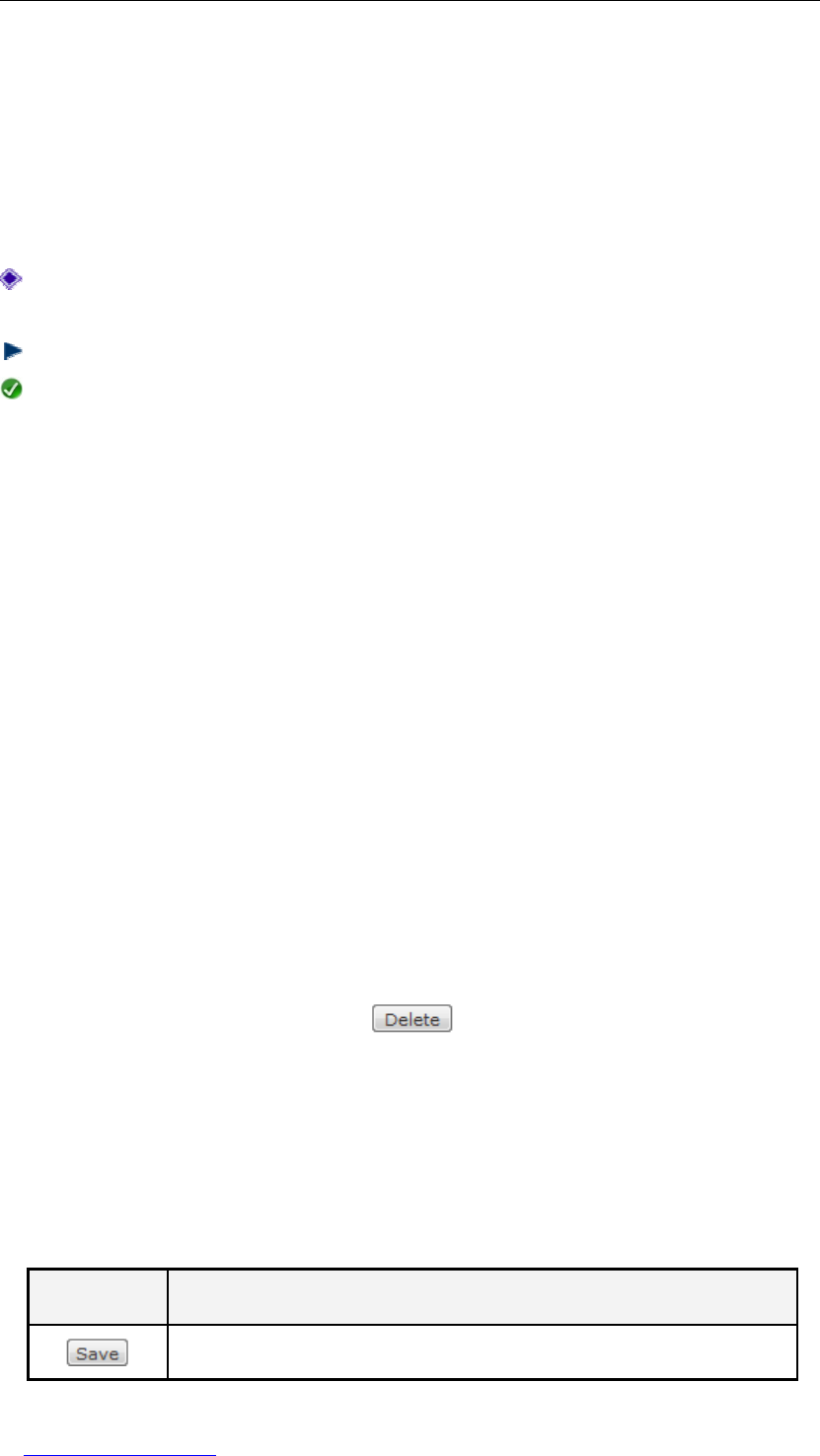
UTT Technologies About This Manual
http://www.uttglobal.com Page 2
0.3 Documents Conventions
0.3.1 Symbol Conventions
: It represents a configuration parameter. Parameters may be optional or required.
Required parameters are indicated by a red asterisk (*).
: It represents a button.
: It represents one or more notes.
0.3.2 Other Conventions
0.3.2.1 Convention for a Page Path
First Level Menu Item > Second Level Menu Item (bold font) means the menu path to
open a page. For example, Wireless > MAC Filtering means that in the Web UI, click the
first level menu item Wireless firstly, and then click the second level menu item MAC
Filtering to open the corresponding page.
0.3.2.2 Convention for Clicking a Button
Click the XXX button (XXX is the name of the button, bold font) means performing the
corresponding operation. E.g., click the Delete button means performing the delete
operation, the Delete button is shown as .
0.3.3 Common Button Descriptions
The following table describes the commonly-used buttons in the Web UI.
Button Description
Click to save your changes.
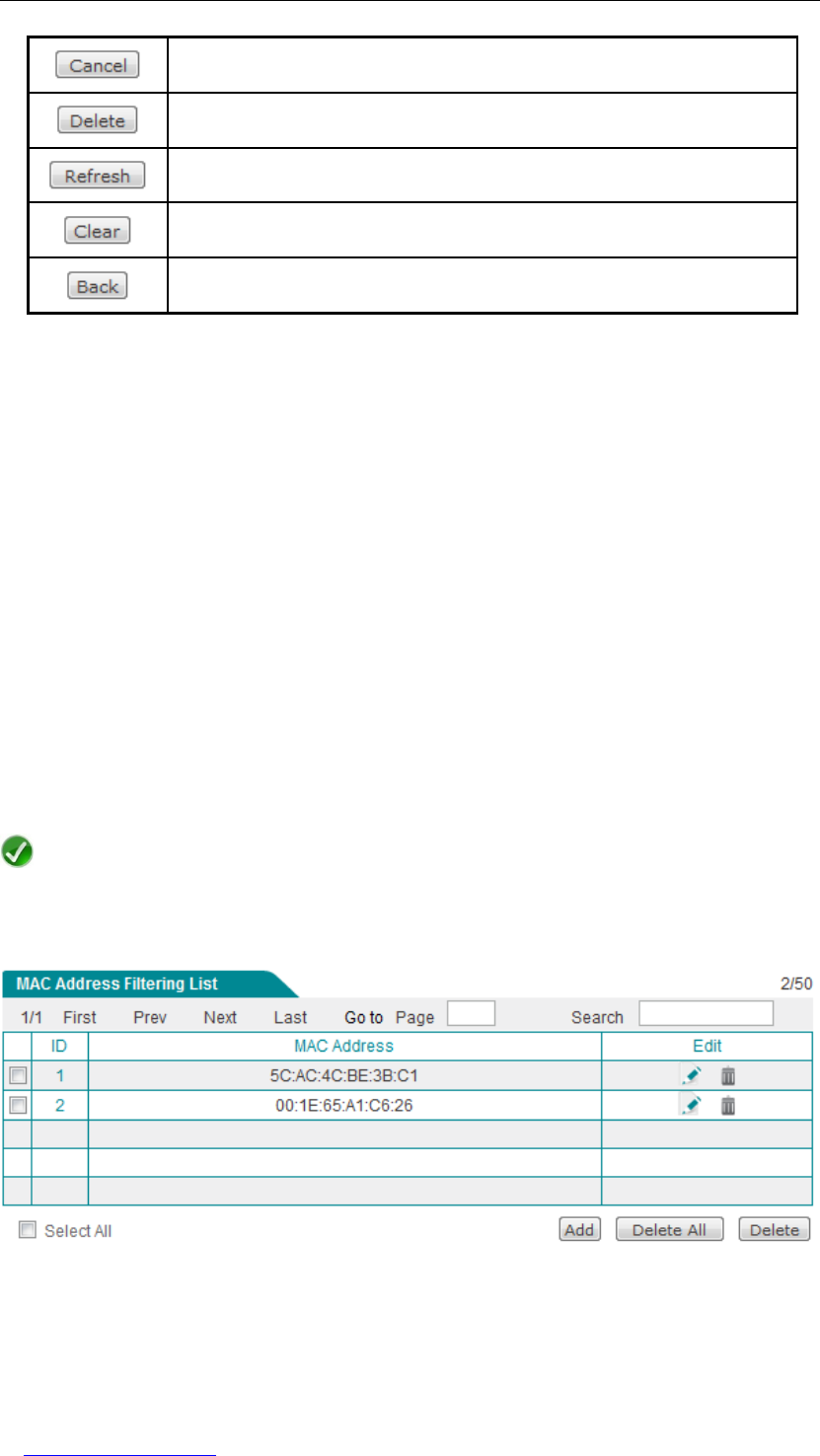
UTT Technologies About This Manual
http://www.uttglobal.com Page 3
Click to revert to the last saved settings.
Click to delete the selected entry(s).
Click to display the latest information on the page.
Click to clear all the statistics on the page.
Click to go back to the previous page.
Table 0-1 Common Button Descriptions
0.3.4 Detailed Description of List
0.3.4.1 Basic Elements and Features
The Web UI contains two kinds of lists: editable list and read-only list.
●An editable list is used to add, display, modify and delete the configuration entries.
●A read-only list is used to display the system status information which is not editable.
Let’s take the editable MAC Address Filtering List (see Figure 0-1) as an example to
explain the basic elements and features of the list.
Note
Only the editable lists support Add, Modify, and Delete operations. The read-only lists
don’t support them.
Figure 0- 1 MAC Address Filtering List
The following table describes the basic elements and features of the list.
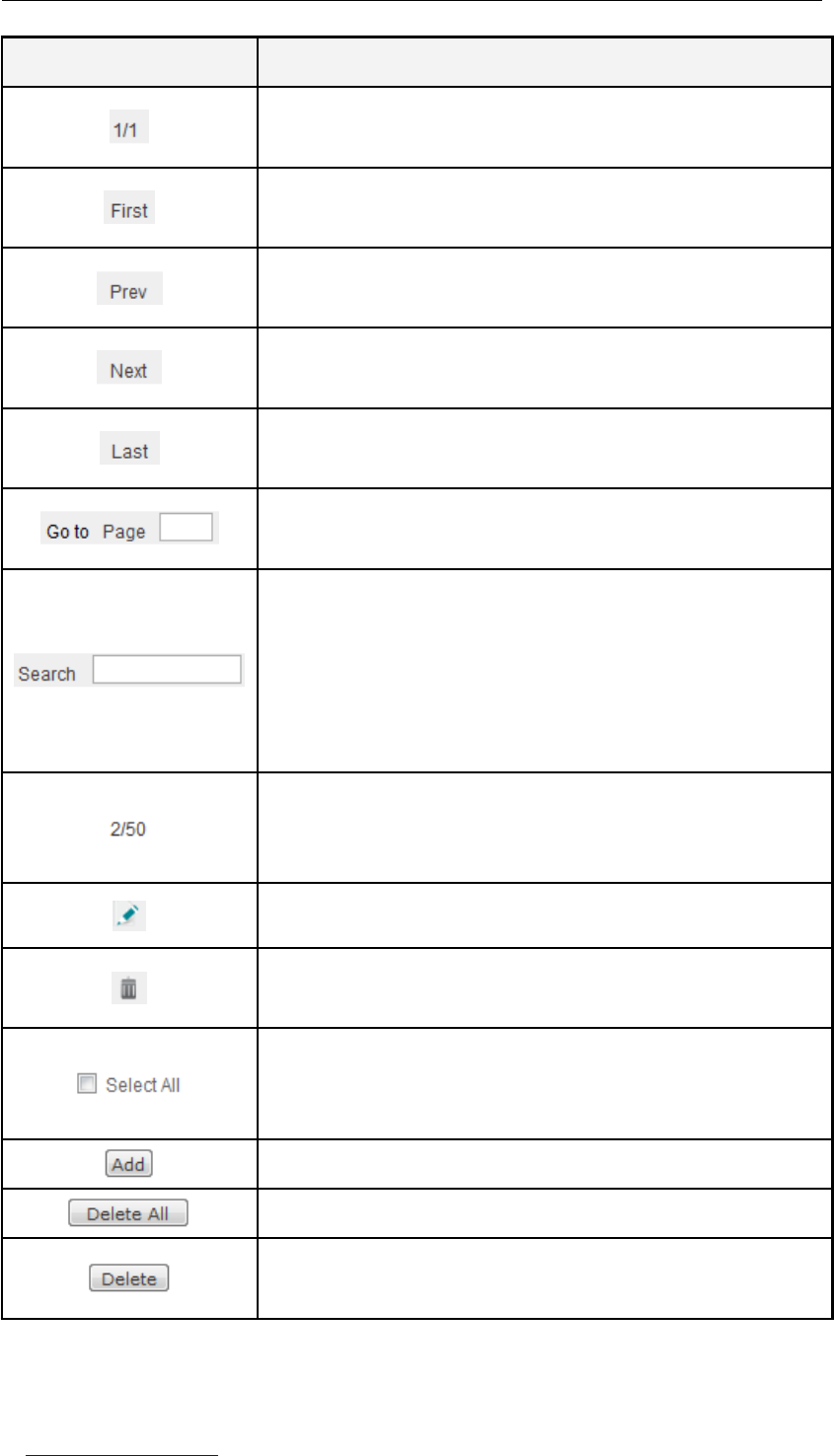
UTT Technologies About This Manual
http://www.uttglobal.com Page 4
Element Description
Current page number/ total pages, the example means that the current
page is the first page, and total one page.
Click to jump to the first page.
Click to jump to the previous page.
Click to jump to the next page.
Click to jump to the last page.
Enter page number in text field, then click Go to or press <Enter> key
to jump to that page.
Enter the text string you want to search for in this text box, then press
<Enter> key to display all the matched entries. In addition, you can do
the search within the displayed results. If you want to display all the
entries, you only need clear the text box and then press <Enter> key.
Note that the matching rule is substring matching, that is, it will search
for and display those entries that contain the specified text string.
Configured number / maximum number, the example means that there
are 2 configured MAC address filtering entries, and the maximum
number of MAC address filtering allowed is 50.
Click to go to the setup page to modify the corresponding entry.
Click to delete the corresponding entry.
Click (add the check mark) to select all the entries in the current page.
Click again (remove the check mark) to unselect all the entries in the
current page.
Click to go to the setup page to add a new entry to the list.
Click to delete all the entries in the list.
To delete one or more entries, select the leftmost check boxes of them,
and then click the Delete button.
Table 0-2 Basic Elements and Features of the List

UTT Technologies About This Manual
http://www.uttglobal.com Page 5
0.3.4.2 Sorting Function
All the lists in the Web UI support sorting function. The operation is as follows: You can
click any column header to sort the entries in a list by that column. Click once to sort the
entries in descending order, click again to sort them in ascending order. Click a third time
to sort them in descending order, and so forth. After sorted, the list will be displayed from
the first page.
0.4 Factory Default Settings
The following table lists the default values of several important parameters.
Parameter Default Value Description
Administrator User Name admin You can use the administrator account to login
to the Wireless Router’s Web UI.
Note: Both the User Name and Password are
case sensitive.
Administrator Password admin
LAN IP Address 192.168.1.1 They are the IP address and subnet mask of
the Wireless Router’s LAN interface. You can
use this IP address to access and manage the
Wireless Router.
LAN Subnet Mask 255.255.255.0
SSID UTT-HIPER_XXXXXX
To connect to the Wireless Router, wireless
clients must use the same SSID as the
Wireless Router. Therein, “XXXXXX” is the
Wireless Router’s serial number in
hexadecimal format.
Table 0-3 Factory Default Settings
0.5 Document Organization
This guide mainly describes the settings and applications of the AC750W Wireless Router,
which include product overview, hardware installation, quick setup, start menu, network,
wireless, advanced, user management, firewall, VPN, system administration, status and
support.

UTT Technologies About This Manual
http://www.uttglobal.com Page 6
Chapter 1 Product Overview
This chapter describes functions and features of the Wireless Router.
Chapter 2 Hardware Installation
This chapter describes how to install the Wireless Router.
Chapter 3 Quick Setup
This chapter describes the following contents:
•How to install and configure TCP/IP properties on your PC.
•How to login to the Wireless Router; and introduction to the WEB UI layout.
•How to use the Setup Wizard to quickly configure the basic parameters for the
Wireless Router to operate properly.
Chapter 4 Start Menu
This chapter describes how to quickly go to the following pages to configure the related
features via the Start menu items:
•Setup Wizard: How to configure the basic parameters for the Wireless Router to
operate properly.
•System Status: How to view wired and wireless status of the Wireless Router.
•Interface Traffic: How to view the real-time traffic chart for each interface, and the
ingress and egress traffic statistics for each interface.
•Restart: How to restart the Wireless Router.
Chapter 5 Network
This chapter describes how to configure the basic network parameters of the Wireless
Router, including:
•WAN: How to configure Internet connections and view their configuration and status.
•Load Balancing: How to configure the load balancing feature which includes
detection and weight settings, global settings; and how to view the load balancing list.
•LAN Settings: How to configure the parameters of the LAN interface, such as IP
address, subnet mask, MAC address, and so on.
•DHCP Server: How to configure DHCP server, DNS proxy, static DHCP; how to view
the static DHCP list and DHCP client list.
•DDNS: How to apply for DDNS account and configure DDNS service, and view
DDNS status.
•UPnP: How to enable or disable UPnP, and view the UPnP port forwarding list.
Chapter 6 Wireless

UTT Technologies About This Manual
http://www.uttglobal.com Page 7
This chapter describes how to configure the wireless features of the Wireless Router,
including:
•Basic Wireless Settings: How to configure basic wireless settings.
•Wireless Security Settings: How to configure wireless security settings.
•Wireless MAC Address Filtering: How to filter the wireless clients based on their
MAC addresses.
•Advanced Wireless Settings: How to configure advanced wireless settings.
•Wireless Client List: How to view the status of the wireless clients, and easily
configure MAC address filtering entries via the list.
Chapter 7 Advanced
This chapter describes how to configure the advanced features of the Wireless Router,
including:
•NAT and DMZ: How to configure and view NAT rules, port forwarding entries and
DMZ host.
•IP/MAC Binding: How to configure IP/MAC bindings to prevent IP address spoofing.
How to configure an Internet whitelist or blacklist for the LAN users.
•Static Route: How to configure and view the static routes.
•PPPoE Server: How to configure PPPoE server global settings and PPPoE account
settings, and view PPPoE user status.
Chapter 8 User Management
This chapter describes how to control and manage the Internet behaviors of the LAN
users based on schedule, including:
•Global Management: How to allow or block the LAN users from using popular IM
(e.g., QQ, MSN) and P2P applications (e.g., Bit Comet, Bit Spirit, Thunder Search)
based on schedule.
•Group Management: How to allow or block the LAN users from using popular IM
and P2P applications based on user group and schedule.
Chapter 9 Firewall
This chapter describes how to configure firewall features, including:
•Access Control: How to configure access control rules to assign Internet access
privileges to the LAN users based on schedule, and to prevent external attacks.
•Domain Filtering: How to configure domain filtering feature to block access to the
specified websites.
•Attack Prevention: How to configure attack prevention features.
Chapter 10 VPN

UTT Technologies About This Manual
http://www.uttglobal.com Page 8
This chapter describes the PPTP implementation, and how to configure the Wireless
Router as a PPTP client.
Chapter 11 System Administration
This chapter describes how to perform maintenance activities on the Wireless Router,
including:
•Administrator: How to add, view, modify and delete the administrator accounts.
•System Time: How to set the system date and time manually or automatically.
•Configuration: How to backup and restore the system configuration, and reset the
Wireless Router to factory default settings.
•Firmware upgrade: How to backup, download and upgrade firmware.
•Remote Access: How to enable HTTP remote management feature to remotely
configure and manage the Wireless Router via Internet.
•Scheduled Task: How to create and view the scheduled tasks. Now the Wireless
Router only supports one scheduled task: Restart.
Chapter 12 Status
This chapter describes how to view the system status information and statistics, including:
•System Status: It displays wired and wireless status of the Wireless Router.
•Traffic Statistics: It displays wired and wireless data traffic statistics of the Wireless
Router.
•System Information: It displays the current system time, system up time, system
resources usage information, SN, firmware version, and system log messages.
Chapter 13 Support
This chapter describes how to link to the UTTCare, Forum, Knowledge and Reservation
page of the UTT website, which can help you quickly learn the UTT Technologies service
system and enjoy the most intimate and professional services.
Appendix
This guide provides six appendixes, including:
•Appendix A How to Configure Your PC: How to configure TCP/IP settings on a
Windows XP-based computer.
•Appendix B FAQ: Frequent questions and answers.
•Appendix C Common IP Protocols: Provides the list of common IP protocols and
their protocol numbers.
•Appendix D Common Service Ports: Provides the list of common services and their
port numbers.

UTT Technologies About This Manual
http://www.uttglobal.com Page 9
•Appendix E Figure Index: Provides a figure index directory.
•Appendix F Table Index: Provides a table index directory.
0.6 Contact Information
If you have any questions regarding the operation or installation of the AC750W Wireless
Router, please contact us in any of the following ways.
•Technical Support Phone: +86-4006-120-780, +86-4006-880-780
•UTT Forum: http://www.uttglobal.com/forum/
•E-mail:uttglobal@utt.com.cn

UTT Technologies Chapter 1 Product Overview
http://www.uttglobal.com Page 10
Chapter 1 Product Overview
Thanks for choosing the AC750W Wireless Router from UTT Technologies Co., Ltd.
This chapter describes the functions and features of the AC750W Wireless Router in brief.
1.1 Product Brief
The AC750W Wireless Router is designed for small-sized businesses and branch offices,
integrating wired networks with 3G and 802.11 wireless networks. In addition, it adheres to
the characteristics of UTT Technologies products: open, easy-to-use, safe, smooth, and
so on.
The AC750W is based on IEEE 802.11n standard and is compatible with IEEE 802.11b
and IEEE 802.11g standards. It provides maximum wireless transfer rate up to 300Mbps,
wide wireless coverage, and stable wireless data transmission.
The AC750W supports multiple security modes which include WEP, WPA-Enterprise,
WPA2-Enterprise, WPA-PSK and WPA2-PSK. What’s more, it provides simple and
efficient wireless MAC address filtering to improve the security of your wireless network.
The AC750W supports DHCP server, NAT, static route, DDNS, IP/MAC binding, PPPoE
server and other advanced features. Furthermore, it provides feature-rich user
management, which can help you control and manage the Internet behaviors of the LAN
users based on schedule and address group, including QQ, MSN and P2P applications
(e.g., Bit Comet, Bit Spirit, and Thunder Search) control, the maximum upload and
download rate limiting.
The AC750W supports flexible firewall features like access control and domain filtering to
effectively prevent network attacks, and provide security for the LAN users.
The AC750W provides a concise, intuitive, and feature-rich Web User Interface. The
Setup Wizard can help you quickly configure the basic parameters for the Wireless Router
to operate properly. The status information (System Status, Wireless Client List, Traffic
Statistics, etc.) can help you identify and diagnose the source of current system problems,
or predict potential system problems. In addition, the Support page provides links to the
UTT website to help you quickly learn the UTT Technologies service system and enjoy the
most intimate and professional services.

UTT Technologies Chapter 1 Product Overview
http://www.uttglobal.com Page 11
1.2 Key Features
•Supports multiple Internet connection types: 3G, PPPoE, Static IP, DHCP and Wi-Fi
AP
•Provides two wired WAN interfaces (WAN1 and WAN2), two wireless WAN interfaces
(3G and APClient), and three 10M/100M LAN ports
•Supports multiple Internet connections that provide intelligent load balancing and
automatic failover
•Supports 6kV lightning protection
•Conforms to IEEE 802.11n (802.11g and 802.11b Compatible).
•Provides maximum wireless transfer rate up to 300Mbps
•Supports multiple wireless security modes which include WEP, WPA-Enterprise,
WPA2-Enterprise, WPA-PSK and WPA2-PSK
•Supports hidden SSID
•Supports VPN pass-through (IPSec, PPTP and L2TP)
•Supports PPTP client
•Supports WMM (Wi-Fi Multimedia)
•Supports wireless MAC address filtering feature, whitelist, blacklist, one-click filtering
of MAC addresses
•Supports DHCP server
•Supports DNS proxy
•Supports DDNS (Dynamic Domain Name System)
•Supports IP/MAC binding
•Supports feature-rich PPPoE server
•Supports upload and download rate limiting for the LAN users
•Supports Internet behavior management for the LAN users, such as block or allow
QQ, MSN and P2P applications (e.g., Bit Comet, Bit Spirit, and Thunder Search)
•Supports flexible and strong firewall features
•Supports IP packet filtering based on IP address, protocol and TCP/UDP port
•Supports URL and keyword filtering
•Supports DNS request filtering
•Supports HTTP remote management
•Provides the Web User Interface (Web UI) for ease of use
•Supports firmware upgrade via the Web UI
•Supports configuration backup and restore

UTT Technologies Chapter 1 Product Overview
http://www.uttglobal.com Page 12
•Provides wireless client list and system status
1.3 Physical Specification
●Conforms to IEEE 802.11n, IEEE 802.11b and IEEE 802.11g standards
●Conforms to IEEE 802.3 Ethernet and IEEE 802.3u Fast Ethernet standards
●Supports TCP/IP, PPPoE, DHCP, ICMP, NAT, Static Route, etc.
●Each physical port supports auto-negotiation for the port speed and duplex mode
●Each physical port supports auto MDI/MDI-X
●Provides system and port LEDs
●Operating Environment:
Temperature: 32° to 104° F (0° to 40° C)
Relative Humidity: 10% to 90%, Non-condensing
Height: 0m to 4000m
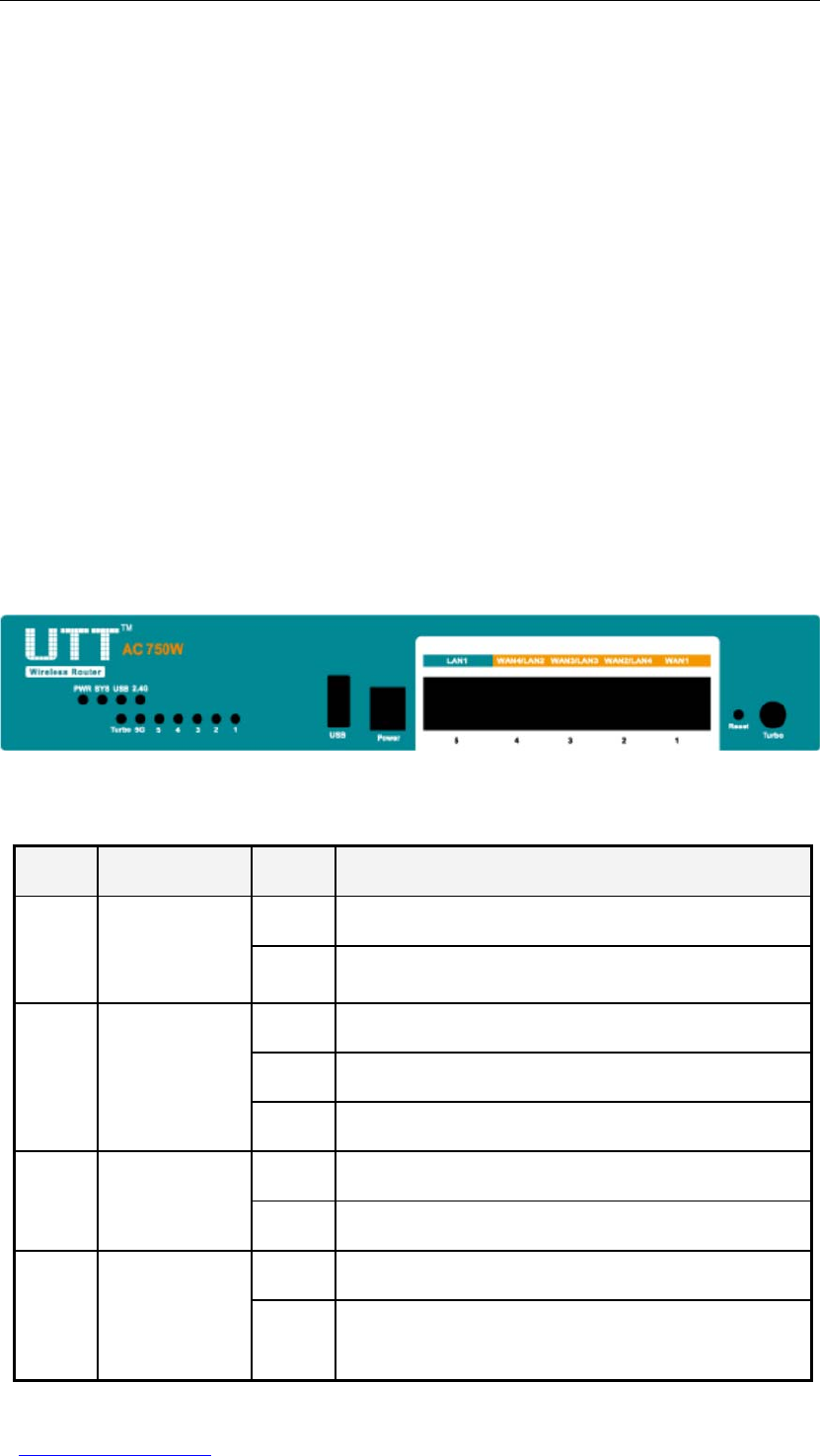
UTT Technologies Chapter 2 Hardware Installation
http://www.uttglobal.com Page 13
Chapter 2 Hardware Installation
2.1 Physical Characteristics
2.1.1 Front Panel
As shown in Figure 2- 1, the LEDs are located on the front panel of the Wireless Router.
The LEDs indicate the status of the system and each port. Table 2- 1 describes these
LEDs.
Figure 2-1 Front Panel of the Wireless Router
LED Full Name State Description
PWR Power LED
On The Wireless Router is powered on.
Off The Wireless Router is powered off.
SYS System LED
Blinking The system is operating properly.
On The system is not operating properly.
Off The system is not operating properly.
USB 3G USB Modem
Status LED
On A 3G USB modem is connected to the USB port.
Off No 3G USB modem is connected.
WLAN Wireless LAN
Status LED
On The wireless function is enabled.
Blinking The Wireless Router is sending or receiving data over the
wireless network.
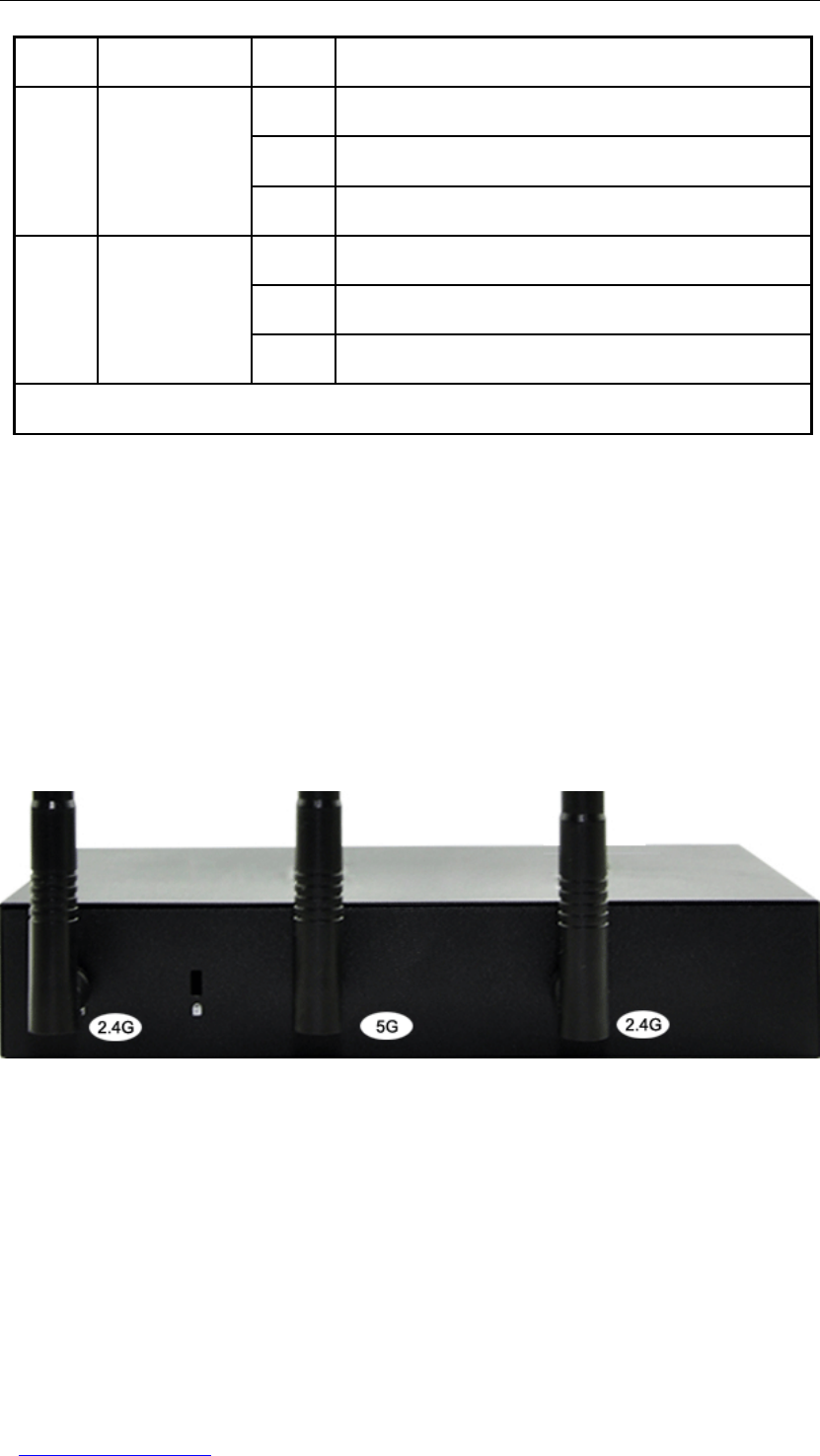
UTT Technologies Chapter 2 Hardware Installation
http://www.uttglobal.com Page 14
Off The wireless function is disabled.
WAN1/
WAN2
WAN1/WAN2
Port Status LED
On A valid link is established on the corresponding port.
Blinking The corresponding port is sending or receiving data.
Off No link is established on the corresponding port.
1, 2, 3 LAN Port Status
LED
On A valid link is established on the corresponding port.
Blinking The corresponding port is sending or receiving data.
Off No link is established on the corresponding port.
Note: The Wireless Router doesn’t support WPS feature at present.
Table 2-1 Description of LEDs on the Front Panel
2.1.2 Rear Panel
As shown in Figure 2-2, the rear panel of the Wireless Router contains a POWER
connector, a RESET button, a USB port, two wired WAN ports (WAN1 and WAN2), three
LAN ports, a WPS button, and two Antenna ports. Note that the Wireless Router doesn’t
support WPS feature at present.
Figure 2- 2 Back Panel of the Wireless Router
1. RESET Button
If you forget the administrator password, you need to use the RESET button to reset the
Wireless Router to factory default settings. The operation is as follows: While the Wireless
Router is powered on, use a pin or paper clip to press and hold the RESET button for
more than 5 seconds, and then release the button. After that, the Wireless Router will
restart with factory default settings.
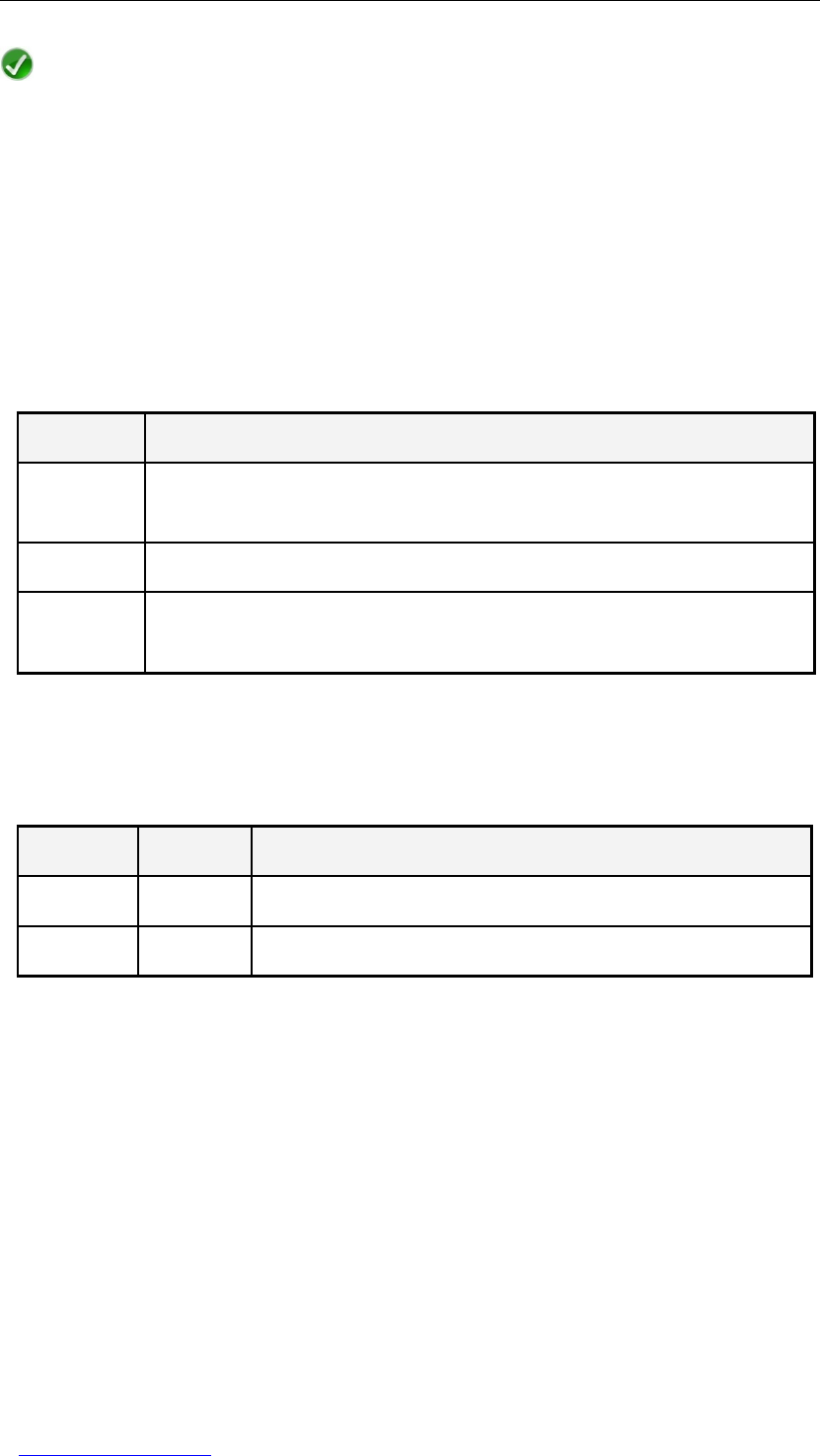
UTT Technologies Chapter 2 Hardware Installation
http://www.uttglobal.com Page 15
Note
This operation will clear all the custom settings on the Wireless Router. If you
remember the administrator account, it is strongly recommended that you go to
Administration > Configuration page to backup the current configuration firstly, and
then reset the Wireless Router to factory default settings.
2. Ports
The Wireless Router provides three LAN ports, two WAN ports, and a USB port. Table 2- 2
describes these ports.
Port Description
LAN (1, 2, 3) They are used to connect the wired computers, hubs, switches, and other Ethernet
network devices on the LAN to the Wireless Router.
WAN1/WAN2 They are used to connect the Wireless Router to the Internet.
USB The Wireless Router provides a USB port for connecting a 3G USB Modem, which
is used to connect the Wireless Router to the Internet.
Table 2-2 Description of Ports on the Rear Panel
3. Components
Component Number Description
Antenna 2 They are used to receive and transmit wireless signals.
Power 1 It is used to connect the power adapter.
Table 2-3 Description of Components on the Rear Panel
2.2 Installation Procedure
1. Selecting a Proper Location
Please make sure that the Wireless Router is powered off before installing it. Then you
need to select a proper location to install the Wireless Router. In most cases, you can
install it on a level surface such as a desktop or shelf.
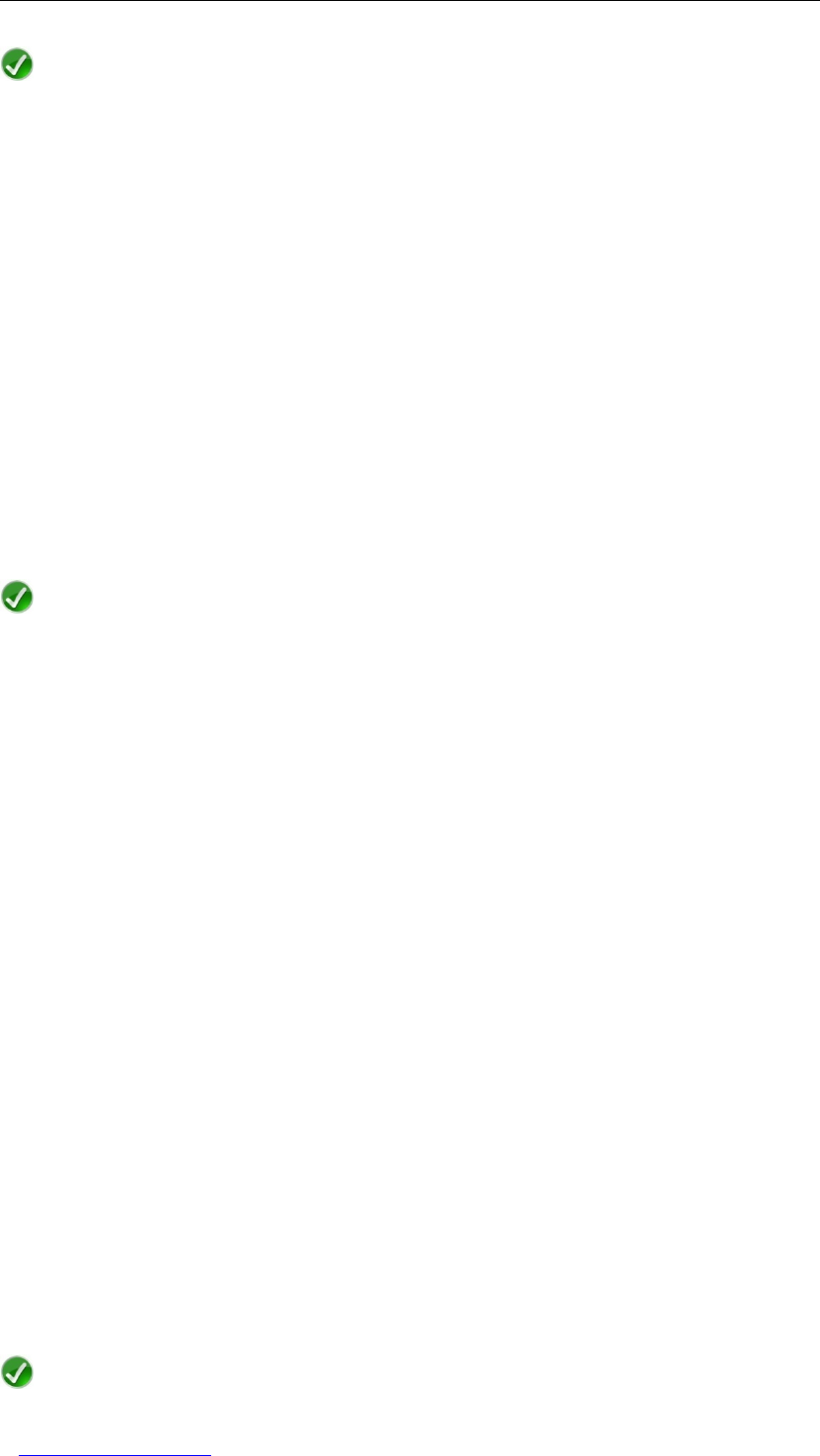
UTT Technologies Chapter 2 Hardware Installation
http://www.uttglobal.com Page 16
Note
Please ensure that the desktop or shelf is stable and the power outlet is grounded
properly, and do not place heavy objects on the Wireless Router.
2. Attach the Antennas
When shipped, the two antennas are not connected to the Wireless Router. To attach the
antennas to the Wireless Router, follow these steps:
1) Remove one antenna from the box.
2) Locate one antenna port (threaded knob) on the back panel of the Wireless Router,
see Figure 2- 2.
3) Screw the antenna in a clockwise direction to the threaded knob until firmly seated.
Don’t over-tighten.
4) Repeat the above steps to attach the other antenna.
Note
Please make sure that you have attached the two antennas to the Wireless Router
properly. The antennas will greatly enhance wireless communication capacity of the
Wireless Router.
3. Connecting the Wireless Router to the LAN
Connect a standard network cable from a PC or switch to a LAN port of the Wireless
Router, or connect a PC to the Wireless Router wirelessly. The Wireless Router will
automatically adapt to any network device operating at 10Mbps or 100Mbps.
4. Connecting the Wireless Router to the Internet
Connect the network cable provided by the manufacturer from the DSL, cable or fiber
optic modem to a WAN port of the Wireless Router, or insert your 3G USB modem to the
USB port of the Wireless Router.
5. Powering On the Wireless Router
Connect the supplied power cord to the power connector on the rear panel of the Wireless
Router, and then plug the other end of the power cord to a grounded power outlet. The
Wireless Router will start automatically.
Note

UTT Technologies Chapter 2 Hardware Installation
http://www.uttglobal.com Page 17
To prevent the Wireless Router from working abnormally or being damaged, please
make sure that the power supply and connectivity are normal, and the power outlet is
grounded properly before powering on the Wireless Router.
6. Checking the LEDs
Verify that the Wireless Router starts up properly and the network connections are
operational by checking the LED states, as described in Table 2-1.

UTT Technologies Chapter 3 Quick Setup
http://www.uttglobal.com Page 18
Chapter 3 Quick Setup
This chapter describes how to properly configure TCP/IP settings on your computer, how to
login to the Wireless Router, and how to configure the basic parameters to quickly connect
the Wireless Router to the Internet via the Start > Setup Wizard.Inaddition,italsobriefly
describes the layout and style of the Wireless Router’s Web UI.
3.1 Configuring Your Computer
Before configuring the Wireless Router via the Web UI, you should properly configure
TCP/IP settings on the computer that you use to administer the Wireless Router. To do this,
follow these steps:
Step 1 Connect the computer to a LAN port of the Wireless Router.
Step 2 Install TCP/IP protocol on your computer. If it has been installed, please ignore
it.
Step 3 Configure TCP/IP settings on your computer: set the computer’s IP address to
an IP address in the range of 192.168.1.2 through 192.168.1.254, set its subnet
mask to 255.255.255.0, set its default gateway to 192.168.16.1 (the Wireless
Router’s default LAN IP address is 192.168.1.1 with a subnet mask of
255.255.255.0), and set its DNS server to an available IP address provided by
your ISP.
Step 4 To verify the network connection between your computer and the Wireless
Router, you can use the ping command at the command prompt on the
computer: Ping 192.168.1.1
•If the displayed page is similar to the screenshot below, the connection
between your computer and the Wireless Router has been established.
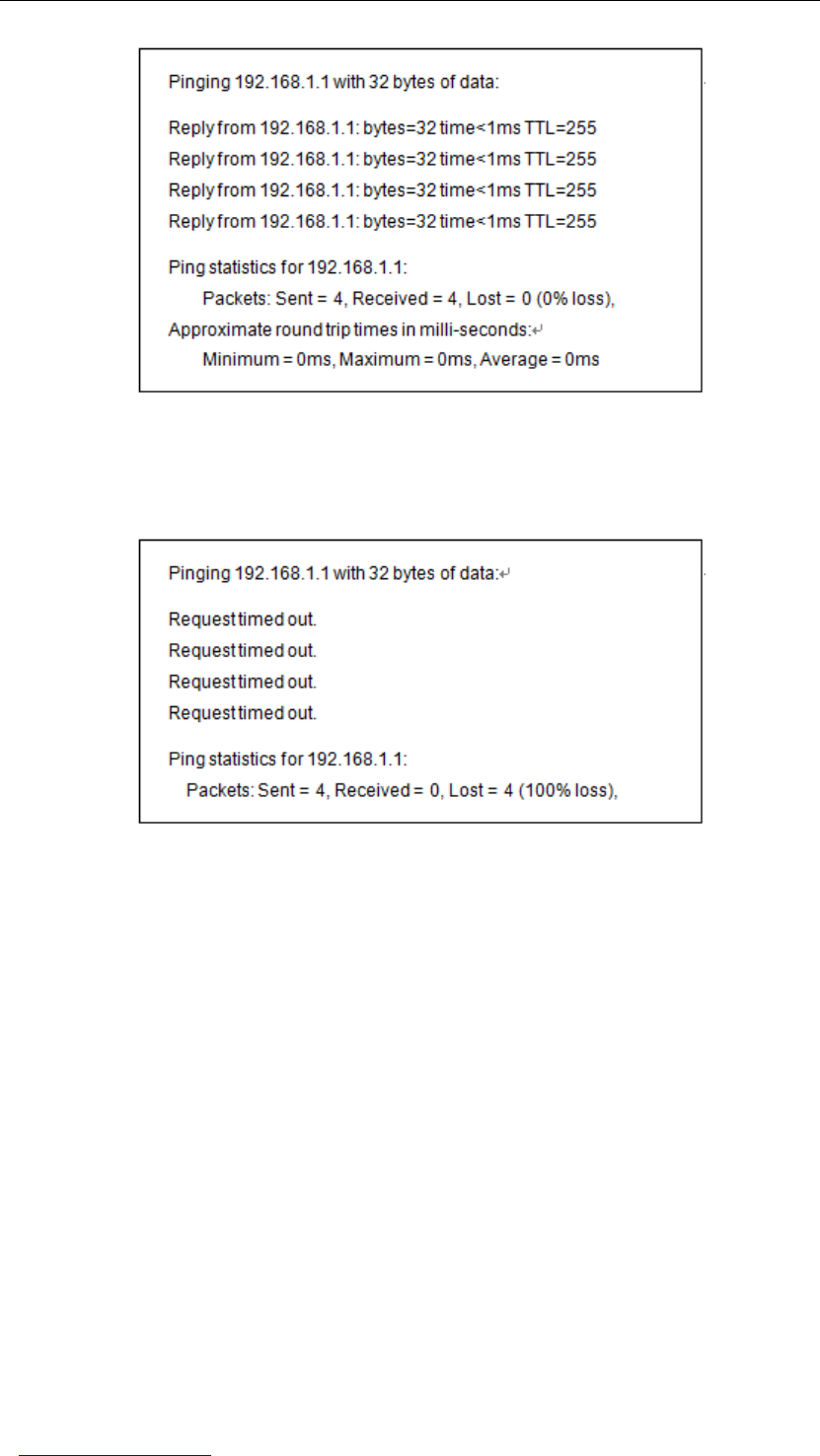
UTT Technologies Chapter 3 Quick Setup
http://www.uttglobal.com Page 19
•If the displayed page is similar to the screenshot below, the connection
between your computer and the Wireless Router hasn't been established
yet.
If the connection hasn't been established, please take the following steps to resolve the
problem:
1. Is the physical link between your computer and the Wireless Router connected
properly?
Verify that the LED corresponding to the Wireless Router’s LAN port and the LED on your
computer’s adapter are lit.
2. Is the TCP/IP configuration for your PC correct?
Verify that your computer is on the same subnet as the Wireless Router’s LAN interface.
For example, if the Wireless Router’s LAN IP address is 192.168.1.1/24 (default value),
your computer’s IP address must be an IP address in the range of 192.168.1.2 through
192.168.1.254, which is not being used by another network device; and its default
gateway must be 192.168.1.1.
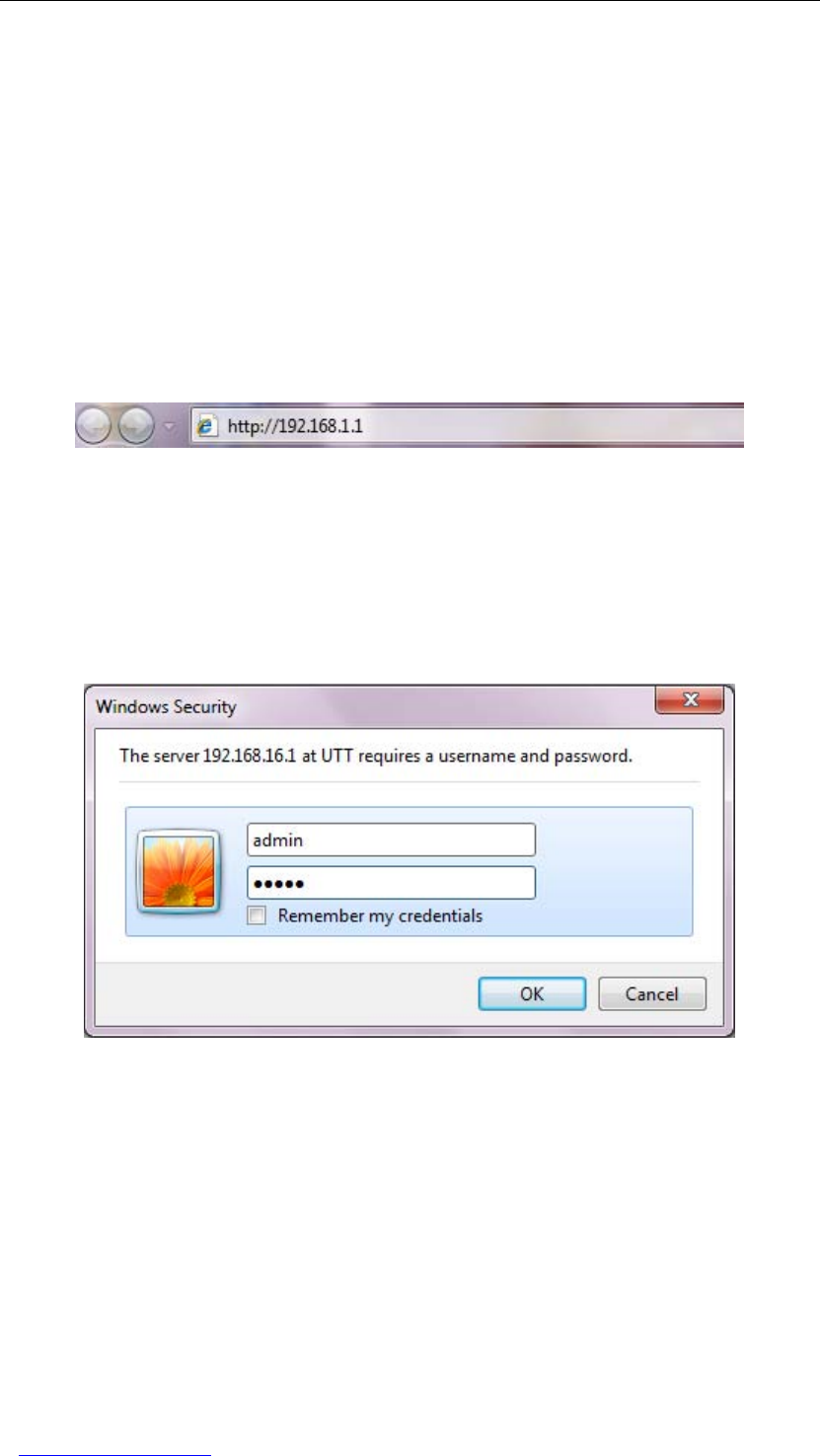
UTT Technologies Chapter 3 Quick Setup
http://www.uttglobal.com Page 20
3.2 Logging in to the Wireless Router
This section describes how to login to the Wireless Router.
No matter what operating system is installed on your computer, such as, MS Windows,
Macintosh, UNIX, or Linux, and so on, you can login to and configure the Wireless Router
through the Web browser (for example, Internet Explorer).
To login to the Wireless Router, do the following: Open a Web browser, enter the Wireless
Router’s LAN interface IP address (the default is 192.168.1.1) in the address bar, and
then press <Enter> key, see Figure 3- 1.
Figure 3- 1 Entering IP address in the Address Bar
A login screen prompts you for your user name and password, see Figure 3-2. When you
first login to the Wireless Router, please use the default administrator account: Enter
admin in both the User name and Password boxes (the default user name and
password both are admin), lastly click OK.
Figure 3- 2 Login Screen
If your user name and password are correct, it will display the homepage, see Figure 3-3.
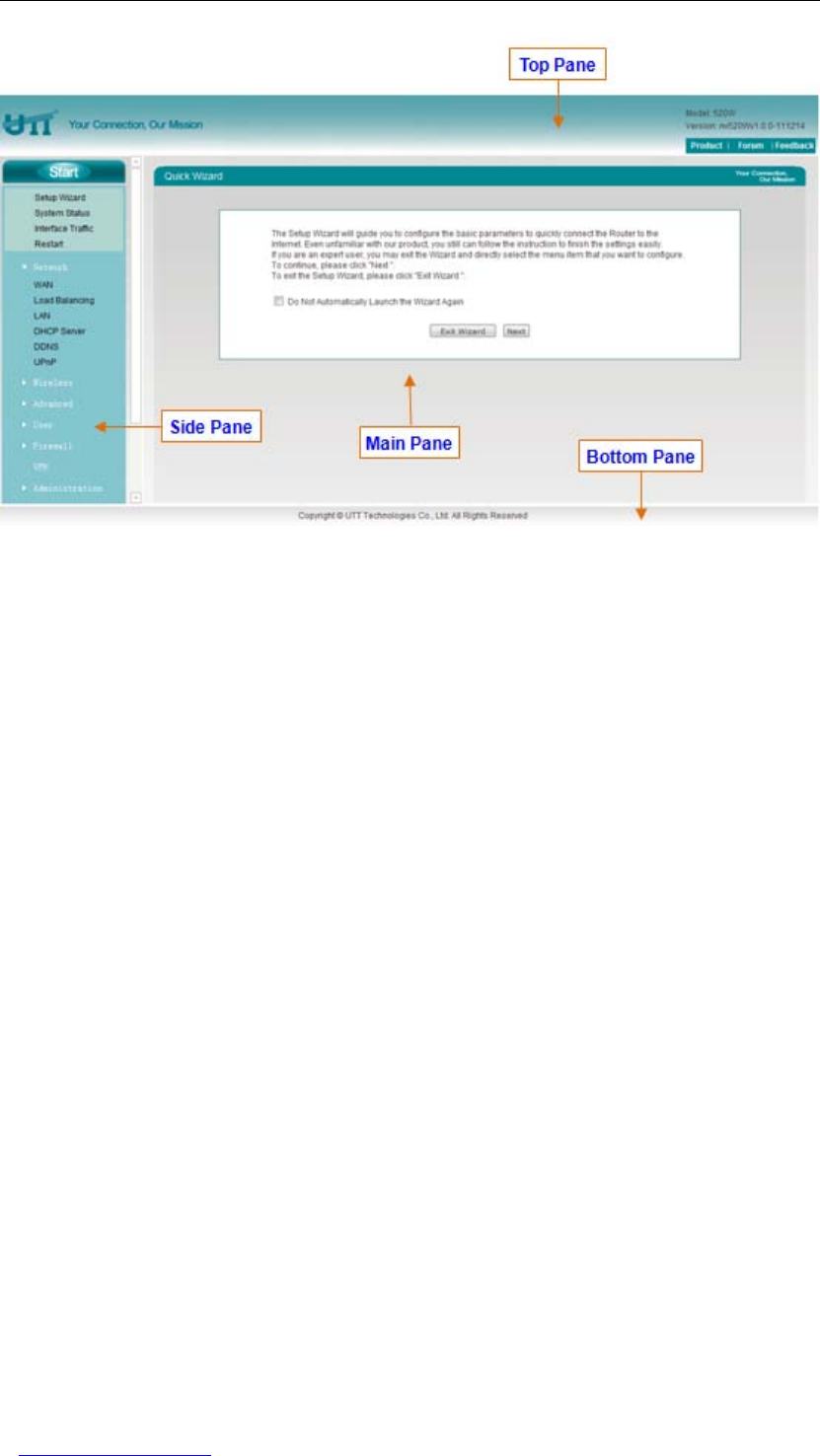
UTT Technologies Chapter 3 Quick Setup
http://www.uttglobal.com Page 21
Figure 3- 3 Homepage
Each page of the Wireless Router’s Web UI consists of four panes:
1. Top Pane: It displays UTT logo, model and version, and three shortcut icons.
1) UTT Logo: Click to link to the homepage of the UTT website.
2) Model and Version: The product model and firmware version of the Wireless
Router.
3) Short Icons: They are used for fast link to the corresponding pages on the
website of UTT Technologies Co., Ltd.
●Product: Click to link to the products page of the UTT website to find more
products.
●Forum: Click to link to the forum homepage of the UTT website to
participate in product discussions.
●Feedback: Click to link to send us your feedback by E-mail.
2. Main Pane: It is the location where you can configure each feature of the Wireless
Router, view configuration, status and statistics.
3. Side Pane: It displays the two-level main menu bar (i.e., navigation bar). The first
level menu is always visible. The second level menu is hidden by default. You can
click a first level menu item to reveal its submenu items, click again to hide them.
4. Bottom Pane: It displays copyright information.
If this is the first time that you login to the Wireless Router, the first page of the Setup
Wizard appears. In the next section we will describe how to use the Setup Wizard to
configure the basic parameters for the Wireless Router to operate properly.
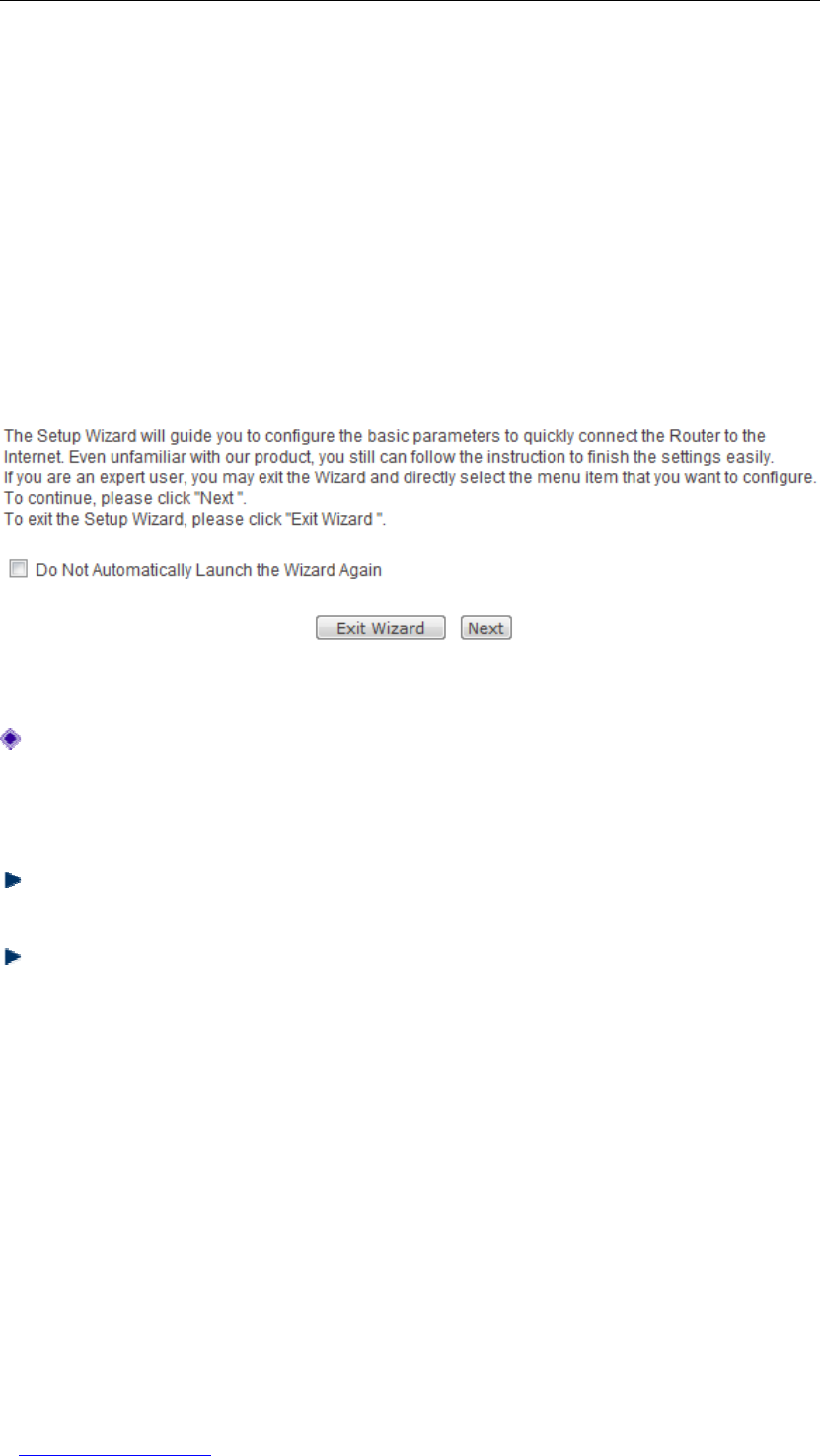
UTT Technologies Chapter 3 Quick Setup
http://www.uttglobal.com Page 22
3.3 Setup Wizard
This section describes the Start > Setup Wizard page.
3.3.1 Running the Setup Wizard
As mentioned earlier, the first page of the Setup Wizard appears immediately after your
first login, see the following figure.
Figure 3-4 Running the Setup Wizard
Do Not Automatically Launch the Wizard Again: If you select this check box, the
system don’t automatically launch the Setup Wizard thenexttimeyoulogintothe
Wireless Router, instead directly open the Welcome page shown in Figure 3- 5. Else,
the system will still launch the Setup Wizard automatically.
Exit Wizard: Click to exit the Setup Wizard andgototheWelcome page (see
Figure 3- 5). The changes made in the Setup Wizard will be discarded.
Next: ClicktogotothenextpageoftheSetup Wizard,thatis,theSetupWizard-
Internet Access Mode page shown in Figure 3- 6.
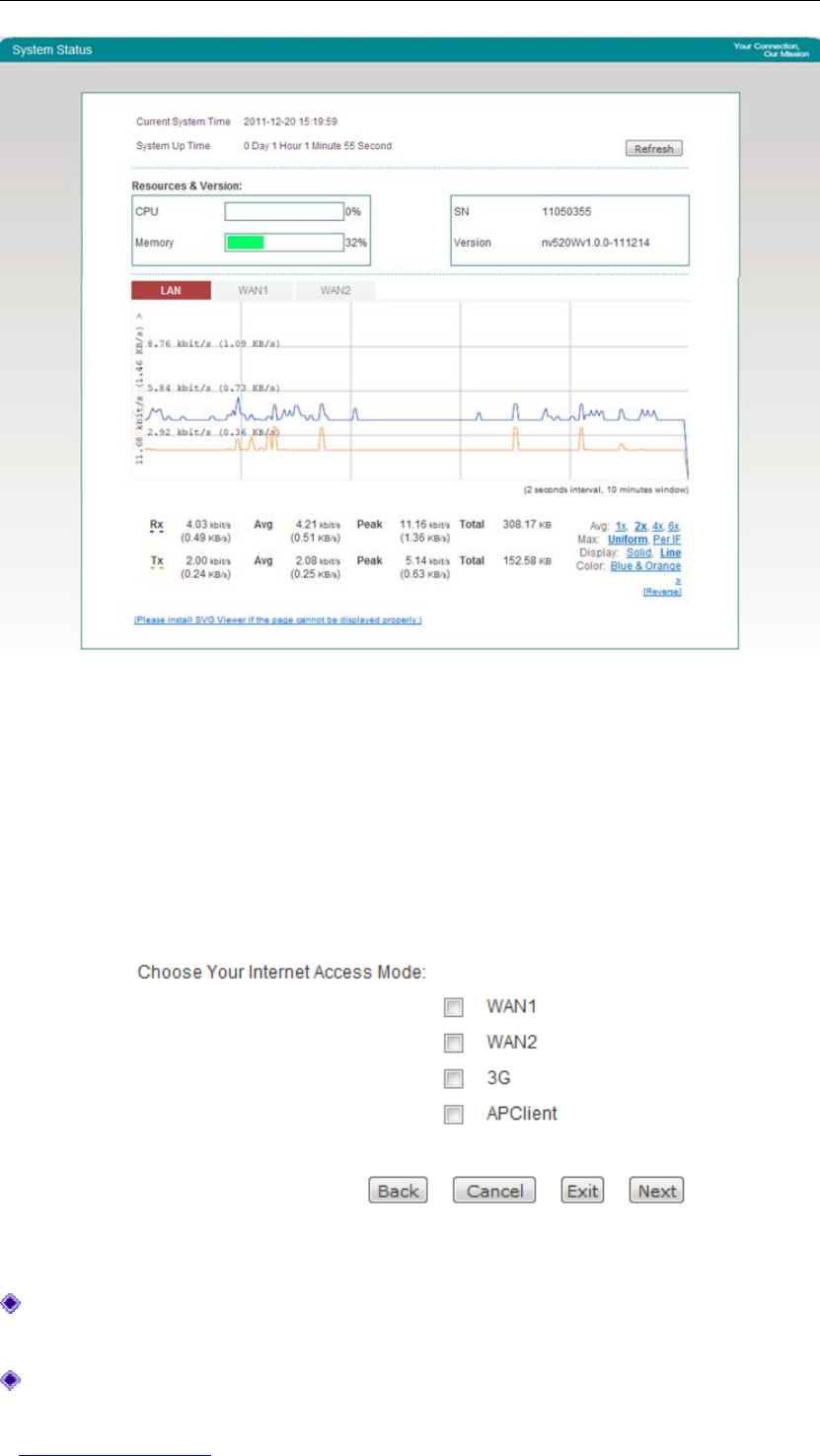
UTT Technologies Chapter 3 Quick Setup
http://www.uttglobal.com Page 23
Figure 3- 5 Welcome Page
3.3.2 Setup Wizard - Internet Access Mode
In this page, you can choose one or more Internet connections that you want to configure
via the Setup Wizard, see Figure 3- 6.
Figure 3- 6 Setup Wizard - Internet Access Mode
WAN1: If you want to configure a wired Internet connection on the WAN1 interface
via the Setup Wizard, select this check box.
WAN2: If you want to configure a wired Internet connection on the WAN2 interface
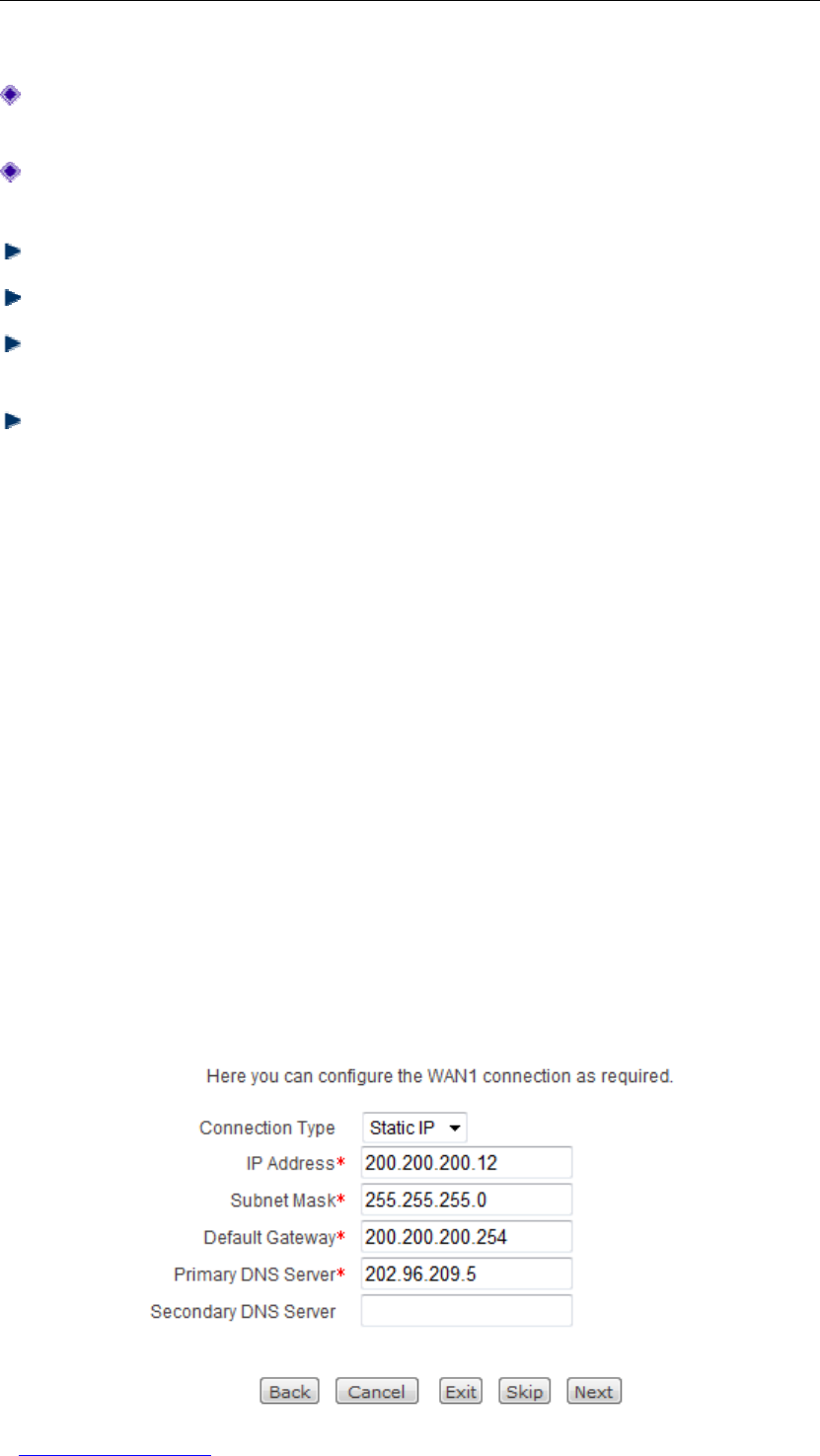
UTT Technologies Chapter 3 Quick Setup
http://www.uttglobal.com Page 24
via the Setup Wizard, select this check box.
3G Client: If you want to configure a 3G Internet connection via the Setup Wizard,
select this check box. Here the Wireless Router acts as a 3G client.
AP Client: If you want to configure a wireless Internet connection via the Setup
Wizard, select this check box. Here the Wireless Router acts as an AP client.
Back: Click to go back to the previous page of the Setup Wizard.
Cancel: Click to revert to the last saved settings.
Exit Wizard: Click to exit the Setup Wizard andgototheWelcome page (see
Figure 3- 5). The changes made in the Setup Wizard will be discarded.
Next: Click to go to the next page of the Setup Wizard.
3.3.3 Setup Wizard - Internet Connection Settings
In the Setup Wizard, you can configure each Internet connection respectively. For each
Internet access mode, the Internet connection settings are different.
3.3.3.1 WAN1/WAN2 Internet Connection Settings
For the WAN1 or WAN2 Internet connection, there are three connection types: PPPoE,
Static IP and DHCP.
3.3.3.1.1 Static IP Internet Connection Settings
If you are required to use a static IP address, please select Static IP from the Connection
Type drop-down list. Then the following page will be shown.
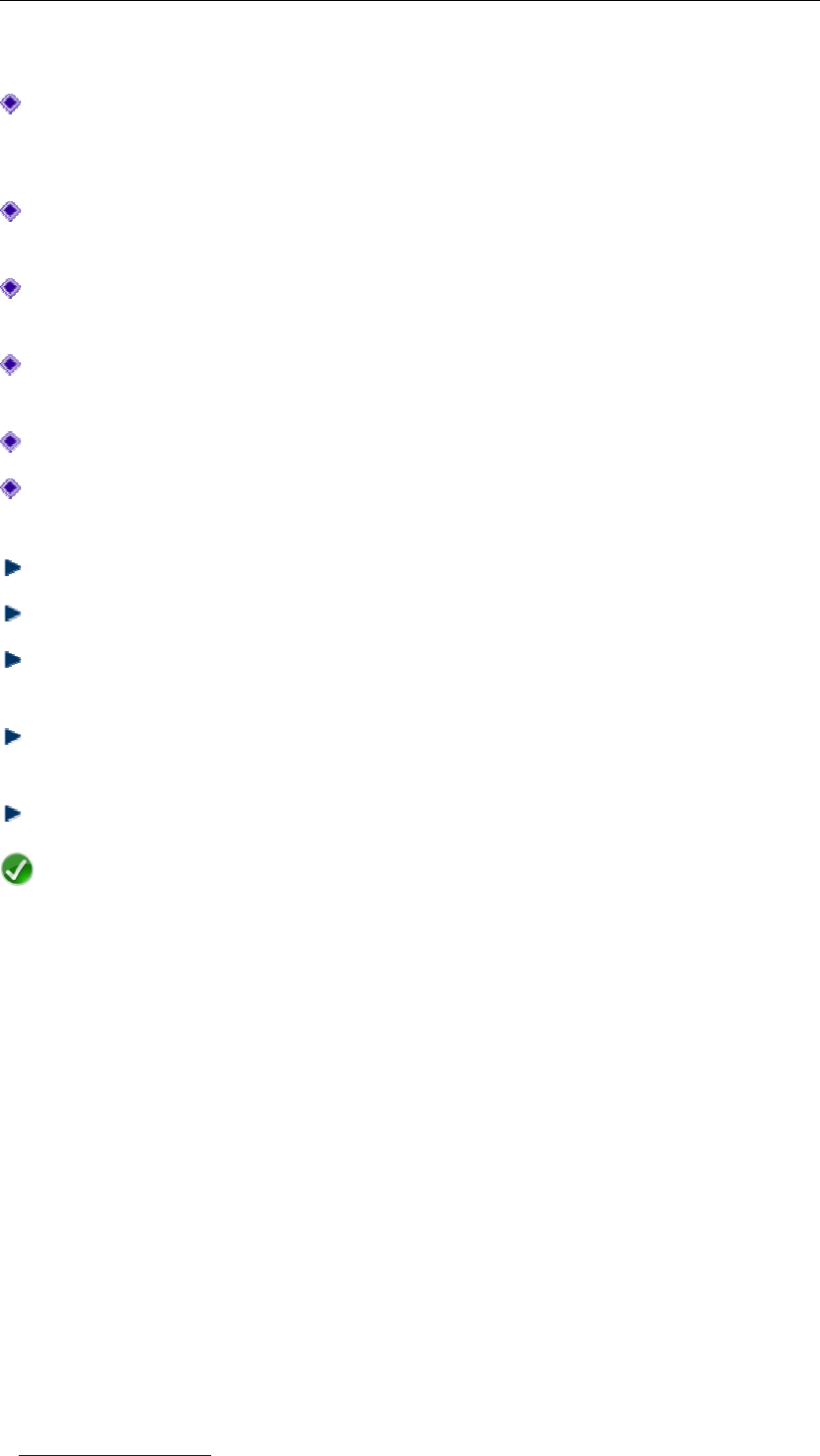
UTT Technologies Chapter 3 Quick Setup
http://www.uttglobal.com Page 25
Figure 3-7 Setup Wizard - WAN1/WAN2 Internet Connection Settings (Static IP)
Connection Type: It specifies the type of the Internet connection. Here please select
Static IP. You need to manually configure IP address, subnet mask, default gateway
and DNS server addresses, which are provided by your ISP.
IP Address: It specifies the IP address of the WAN interface, which is provided by
your ISP.
Subnet Mask: It specifies the subnet mask of the WAN interface, which is provided
by your ISP.
Default Gateway: It specifies the IP address of the default gateway, which is
provided by your ISP.
Primary DNS Server: It specifies the IP address of your ISP’s primary DNS server.
Secondary DNS Server: It specifies the IP address of your ISP’s secondary DNS
server. If it is available, you may set it. Else, please leave it blank.
Back: Click to go back to the previous page of the Setup Wizard.
Cancel: Click to revert to the last saved settings.
Exit: Click to exit the Setup Wizard andgototheWelcome page (see Figure 3- 5).
The changes made in the Setup Wizard will be discarded.
Skip: Click to go directly to the next page of the Setup Wizard. The changes made
on the current page will be discarded.
Next: Click to go to the next page of the Setup Wizard.
Note
The WAN IP address and default gateway IP address must be on the same subnet. If
not, please modify the Subnet Mask to make them be on the same subnet. If you
don’t have the subnet related knowledge, please ask a professional or UTT customer
engineer for help.
3.3.3.1.2 DHCP Internet Connection Settings
If your ISP automatically assigns an IP address to the Wireless Router via DHCP, please
select DHCP from the Connection Type drop-down list. Then the following page will be
shown.
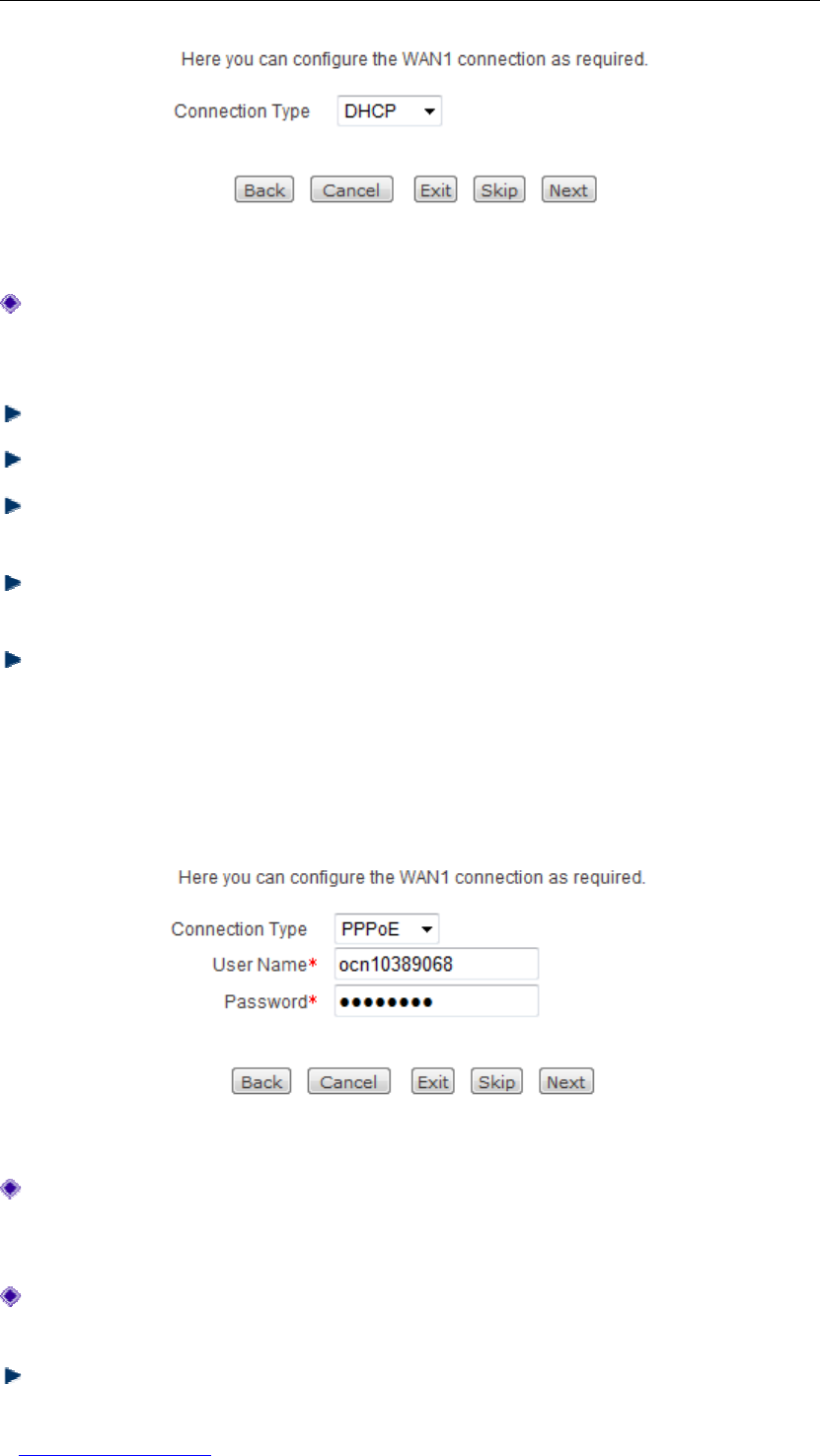
UTT Technologies Chapter 3 Quick Setup
http://www.uttglobal.com Page 26
Figure 3- 8 Setup Wizard - WAN1/WAN2 Settings (DHCP)
Connection Type: It specifies the type of the Internet connection. Here please select
DHCP. The Wireless Router will automatically obtain the WAN IP address, subnet
mask and gateway and DNS server addresses from your ISP’s DHCP server.
Back: Click to go back to the previous page of the Setup Wizard.
Cancel: Click to revert to the last saved settings.
Exit: Click to exit the Setup Wizard andgototheWelcome page (see Figure 3- 5).
The changes made in the Setup Wizard will be discarded.
Skip: Click to go directly to the next page of the Setup Wizard. The changes made
on the current page will be discarded.
Next: Click to go to the next page of the Setup Wizard.
3.3.3.1.3 PPPoE Internet Connection Settings
Please select PPPoE from the Connection Type drop-down list if your ISP uses PPPoE
to establish the Internet connection for you. Then the following page will be shown.
Figure 3- 9 Setup Wizard - WAN1/WAN2 Settings (PPPoE)
Connection Type: It specifies the type of the Internet connection. Here please select
PPPoE. The Wireless Router will automatically obtain the WAN IP address, subnet
mask and gateway IP address from your ISP’s PPPoE server.
User Name and Password: They specify the PPPoE login user name and password
provided by your ISP. Please ask your ISP if you have any questions.
Back: Click to go back to the previous page of the Setup Wizard.
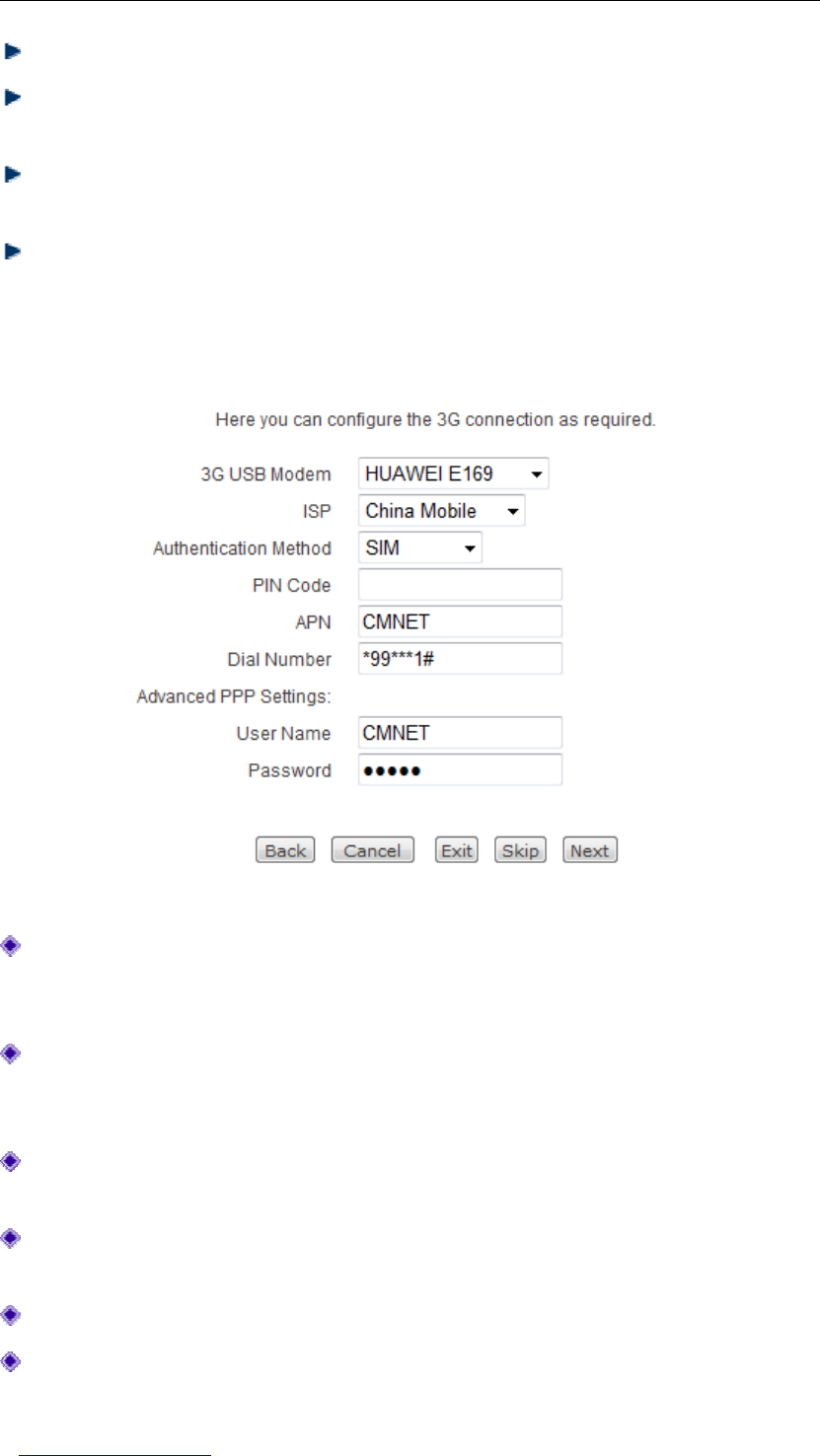
UTT Technologies Chapter 3 Quick Setup
http://www.uttglobal.com Page 27
Cancel: Click to revert to the last saved settings.
Exit: Click to exit the Setup Wizard andgototheWelcome page (see Figure 3- 5).
The changes made in the Setup Wizard will be discarded.
Skip: Click to go directly to the next page of the Setup Wizard. The changes made
on the current page will be discarded.
Next: Click to go to the next page of the Setup Wizard.
3.3.3.2 3G Internet Connection Settings
Figure 3-10 Setup Wizard - 3G Internet Connection Settings
3G USB Modem: It specifies the model of the 3G USB modem. Now the Wireless
Router supports five models: HUAWEI E169,HUEWEI E1750,HUAWEI EC1260,
HUAWEI ET128,andZTE MF637U.
ISP: It is short for Internet Service Provider, a company that provides 3G wireless
Internet access service for you. Now the Wireless Router supports three ISPs: China
Mobile,China Unicom and China Telecom.
Authentication Method: It specifies the authentication method used by your ISP.
The options are SIM and Password.
PIN Code: It specifies the PIN code of your 3G SIM card. PIN is short for Personal
Identification Number.
APN: It is short for Access Point Name, which is provided by your ISP.
Dial Number: It specifies the dial number provided by your ISP.
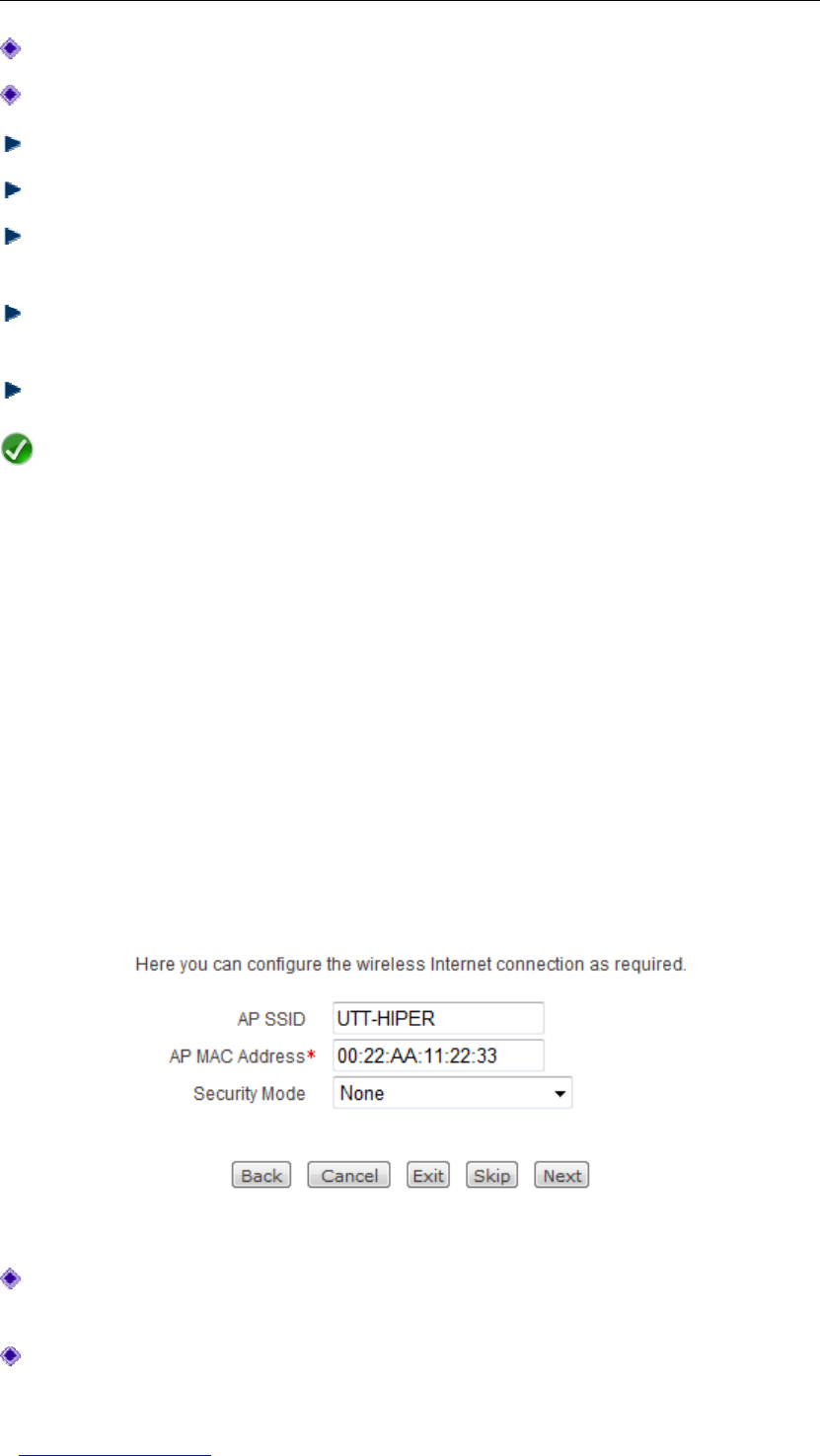
UTT Technologies Chapter 3 Quick Setup
http://www.uttglobal.com Page 28
User Name: It specifies the user name used for PPP authentication.
Password: It specifies the password used for PPP authentication.
Back: Click to go back to the previous page of the Setup Wizard.
Cancel: Click to revert to the last saved settings.
Exit: Click to exit the Setup Wizard andgototheWelcome page (see Figure 3- 5).
The changes made in the Setup Wizard will be discarded.
Skip: Click to go directly to the next page of the Setup Wizard. The changes made
on the current page will be discarded.
Next: Click to go to the next page of the Setup Wizard.
Note
It is strongly recommended that you configure only the 3G USB Modem and ISP of
the 3G Internet connection, and leave the other parameters at their default values. If
necessary, please change them under the guidance of a professional.
3.3.3.3 APClient Internet Connection Settings
In the Setup Wizard - APClient Connection Settings page, the security settings depend
on the value of Security Mode. The following sections describe the APClient connection
settings under each security mode respectively.
3.3.3.3.1 APClient Connection Settings - Disabling Wireless
Security
Figure 3-11 Setup Wizard - APClient Connection Settings (Disabling Wireless Security)
AP SSID: It specifies the SSID of the remote AP. It must be between 1 and 32
characters long, and it is case sensitive.
AP MAC Address: It specifies the MAC address of the remote AP.
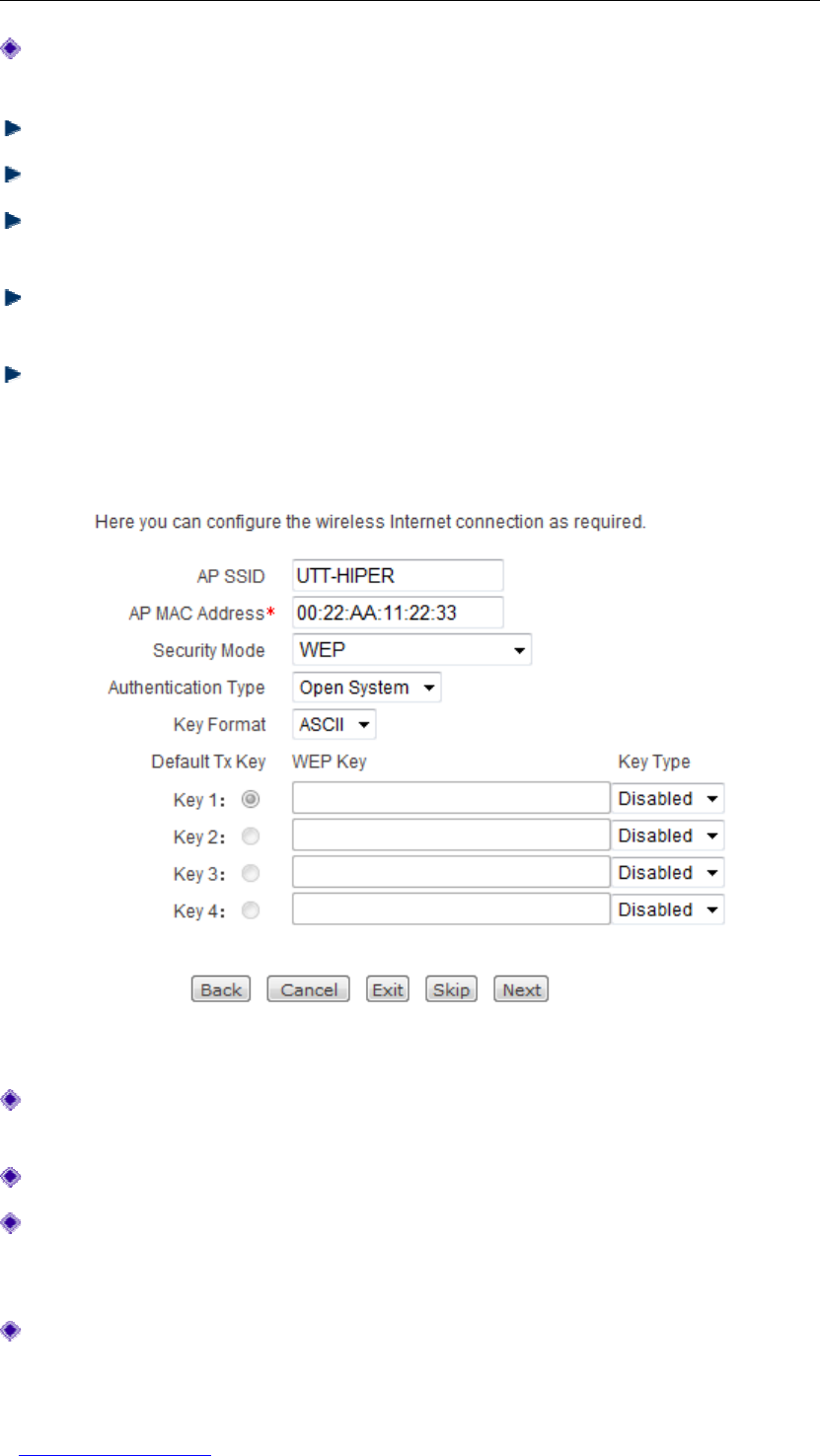
UTT Technologies Chapter 3 Quick Setup
http://www.uttglobal.com Page 29
Security Mode: It specifies the security mode to be used by the Wireless Router.
Here please select None.
Back: Click to go back to the previous page of the Setup Wizard.
Cancel: Click to revert to the last saved settings.
Exit: Click to exit the Setup Wizard andgototheWelcome page (see Figure 3- 5).
The changes made in the Setup Wizard will be discarded.
Skip: Click to go directly to the next page of the Setup Wizard. The changes made
on the current page will be discarded.
Next: Click to go to the next page of the Setup Wizard.
3.3.3.3.2 APClient Connection Settings - WEP
Figure 3-12 Setup Wizard - APClient Connection Settings (WEP)
AP SSID: It specifies the SSID of the remote AP. It must be between 1 and 32
characters long, and it is case sensitive.
AP MAC Address: It specifies the MAC address of the remote AP.
Security Mode: It specifies the security mode to be used by the Wireless Router.
Here please select WEP. WEP is the basic encryption mode which is not as secure
as WPA.
Authentication Type: It allows you to select the authentication type under WEP
security mode. The options are Open System and Shared Key.

UTT Technologies Chapter 3 Quick Setup
http://www.uttglobal.com Page 30
●Open System: It allows the Wireless Router regardless of its WEP keys to
authenticate and attempt to associate with the remote AP. However, even if the
Wireless Router can complete authentication and associate with the remote AP,
the Wireless Router cannot send or receive data from the remote AP unless it
has the correct WEP key.
●Shared Key: It requires that the Wireless Router and remote AP have the
same WEP key to authenticate. Without the correct key, authentication will fail
and the Wireless Router won’t be allowed to associate with the remote AP.
Key Format: It specifies the format for entering the WEP keys. The options are Hex
and ASCII.
●Hex: Select this option if you want to enter the WEP keys in hexadecimal
format. Hexadecimal digits are a set of characters that includes numbers 0
through 9 and letters A through F (or a through f). Hex WEP keys are case
insensitive.
●ASCII: Select this option if you want to enter the WEP keys in ASCII format.
ASCII WEP keys are case sensitive.
Default Tx Key: It allows you to select one of the WEP keys as the default transmit
key to transmit data. All keys can be used to receive data.
WEP Key: It allows you to enter a key in one of the WEP Key boxes. You can enter
up to four WEP keys. You should enter a key according to the Key Format and Key
Type selected.
●For 64-bit encryption, enter 10 hex characters or 5 ASCII characters.
●For 128-bit encryption, enter 26 hex characters or 13 ASCII characters.
Key Type: It allows you to select the size of each key, and it also allows you to
disable or enable each key. The options are Disabled,64-bit and 128-bit. By default,
Disabled is selected, which means the key is of no effect.
Back: Click to go back to the previous page of the Setup Wizard.
Cancel: Click to revert to the last saved settings.
Exit: Click to exit the Setup Wizard andgototheWelcome page (see Figure 3- 5).
The changes made in the Setup Wizard will be discarded.
Skip: Click to go directly to the next page of the Setup Wizard. The changes made
on the current page will be discarded.
Next: Click to go to the next page of the Setup Wizard.
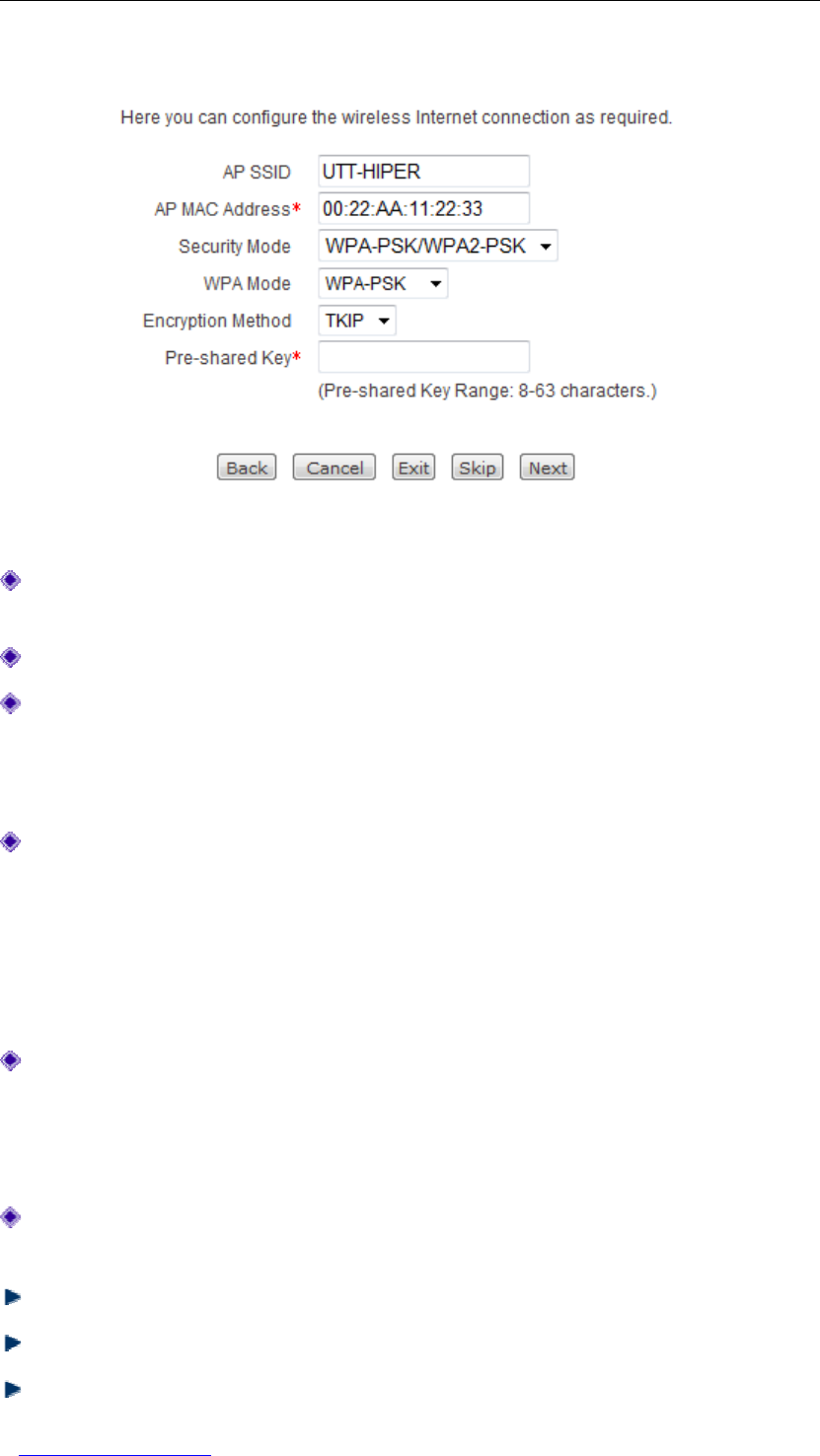
UTT Technologies Chapter 3 Quick Setup
http://www.uttglobal.com Page 31
3.3.3.3.3 APClient Connection Settings - WPA-PSK/WAP2-PSK
Figure 3- 13 Setup Wizard - APClient Connection Settings (WPA-PSK/WAP2-PSK)
AP SSID: It specifies the SSID of the remote AP. It must be between 1 and 32
characters long, and it is case sensitive.
AP MAC Address: It specifies the MAC address of the remote AP.
Security Mode: It specifies the security mode to be used by the Wireless Router.
Here please select WPA-PSK/WPA2-PSK to use WPA-PSK mode or WPA2-PSK
mode. In WPA-PSK or WPA2-PSK mode, the Wireless Router uses the pre-shared
key that is manulally entered to generate encryption keys.
WPA Mode: It specifies the WPA mode to be used by the Wireless Router. The
options are WPA-PSK and WPA2-PSK.
●WPA-PSK: It means that the Wireless Router will use WAP-PSK security
mode.
●WPA2-PSK: It means that the Wireless Router will use WAP2-PSK security
mode.
Encrption Method: It specifies the encrytion method used for data encryption. The
options are TKIP and AES.
●TKIP: It means that the Wireless Router will use TKIP for data encryption.
●AES: It means that the Wireless Router will use AES for data encryption.
Pre-shared Key: This key serves as seed for generating encryption keys. It must be
identical to the remote AP’s. It must be between 8 and 63 characters long.
Back: Click to go back to the previous page of the Setup Wizard.
Cancel: Click to revert to the last saved settings.
Exit: Click to exit the Setup Wizard andgototheWelcome page (see Figure 3- 5).
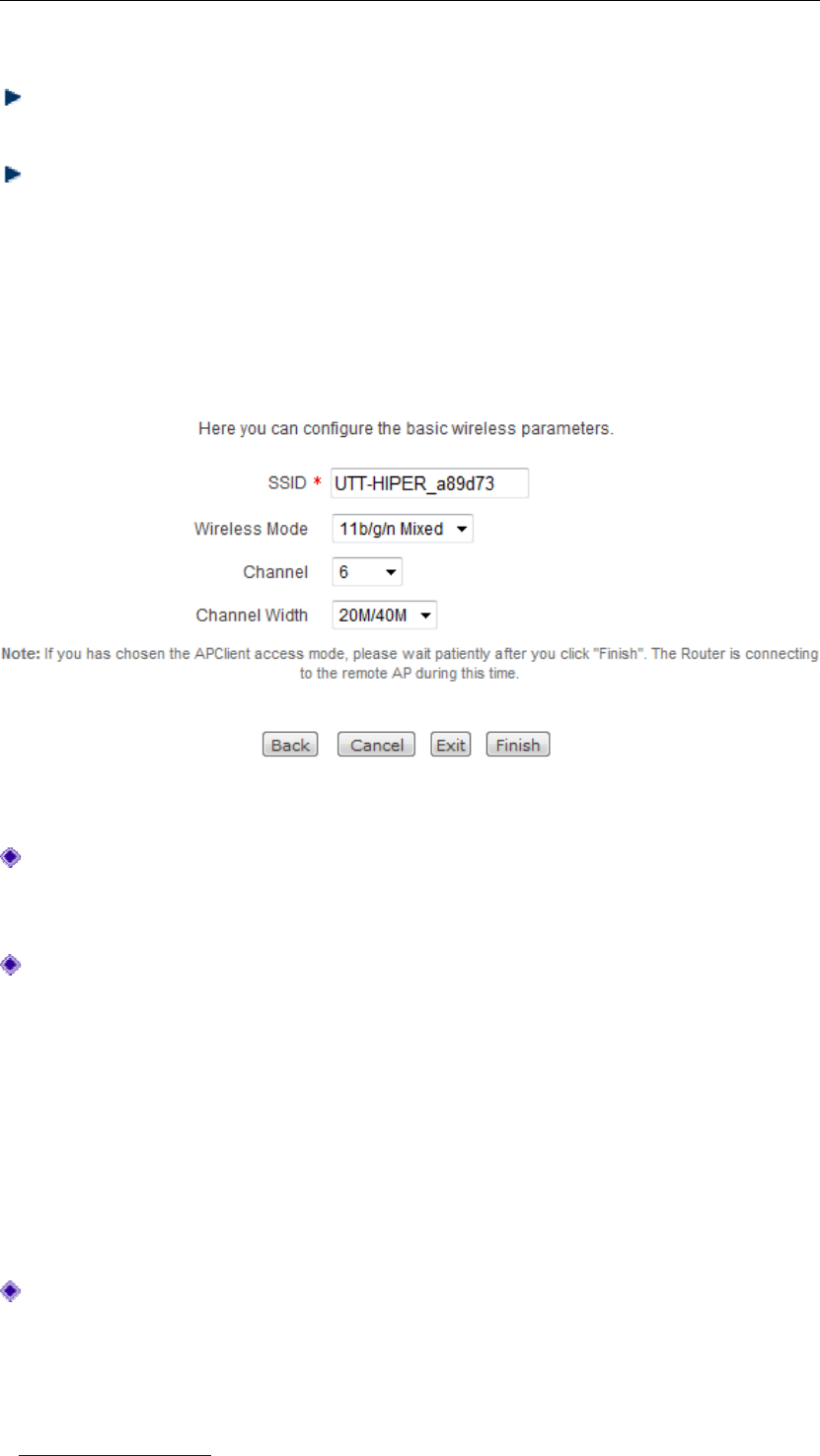
UTT Technologies Chapter 3 Quick Setup
http://www.uttglobal.com Page 32
The changes made in the Setup Wizard will be discarded.
Skip: Click to go directly to the next page of the Setup Wizard. The changes made
on the current page will be discarded.
Next: Click to go to the next page of the Setup Wizard.
3.3.4 Setup Wizard - Wireless Settings
In this page, you can configure basic wireless settings of the Wireless Router.
Figure 3-14 Setup Wizard - Wireless Settings
SSID: The SSID (Service Set Identification) is also known as the wireless network
name, which is used to uniquely identify a wireless network. It must be between 1 and
32 characters long, and it is case sensitive.
Wireless Mode: It specifies the wireless standards running on your wireless network.
The options are 11g Only,11n Only and 11b/g/n Mixed.
●11g Only: In allows both 802.11g and 802.11n wireless clients to connect to the
Wireless Router at 802.11g data rates with a maximum speed of 54Mbps.
●11n Only: It only allows 802.11n wireless clients to connect to the Wireless
Router at 802.11n data rates with a maximum speed of 300Mbps.
●11b/g/n Mixed: It allows 802.11b, 802.11g and 802.11n wireless clients to
connect to the Wireless Router at their respective data rates. The maximum
speeds are 11Mbps, 54Mbps and 300Mbps respectively.
Channel: It specifies the wireless channel used between the Wireless Router and
wireless clients. The valid range is 1 through 11. You can also select Auto to let the
Wireless Router automatically select the best channel. If there are multiple wireless
routers in your area, please make sure that their channels don’t interfere with each

UTT Technologies Chapter 3 Quick Setup
http://www.uttglobal.com Page 33
other.
Channel Width: It specifies the range of frequecies used by your wireless network.
The options are 20/40M and 20M. Note that this parameter can only act on 802.11n
wireless clients. 802.11b and 802.11g wireless clients can only use 20MHz channel.
●20M/40M: If you select this option, 802.11n wireless clients will negotiate the
channel width with the Wireless Router.
●20M: It you select this option, 802.11n wireless clients will use 20MHz channel.
Back: Click to go back to the previous page of the Setup Wizard.
Cancel: Click to revert to the last saved settings.
Exit: Click to exit the Setup Wizard andgototheWelcome page (see Figure 3- 5).
The changes made in the Setup Wizard will be discarded.
Finish: Click to save the changes you have made in the Setup Wizard and close the
Setup Wizard.
Note
Do not forget to click the Finish button to save the changes you have made in the
Setup Wizard, else these changes will be discarded.

UTT Technologies Chapter 4 Start Menu
http://www.uttglobal.com Page 34
Chapter 4 Start Menu
The Start menu item is the first one under the top-level menu. It provides links to several
commonly used pages including Setup Wizard,System Status,Interface Traffic and
Restart, where you can quickly configure the basic parameters for the Wireless Router to
operate properly, view system status, view interface traffic statistics, and restart the
Wireless Router.
4.1 Setup Wizard
The Start > Setup Wizard can help you configure the basic parameters for the Wireless
Router to operate properly. Refer to Section 3.3 Setup Wizard for detailed information.
4.2 System Status
This section describes the Start > System Status page, where you can view the current
status information of the Wireless Router.
4.2.1 Wired Status
This page displays the current status information of the wired interfaces, which include
WAN1, WAN2 and LAN.
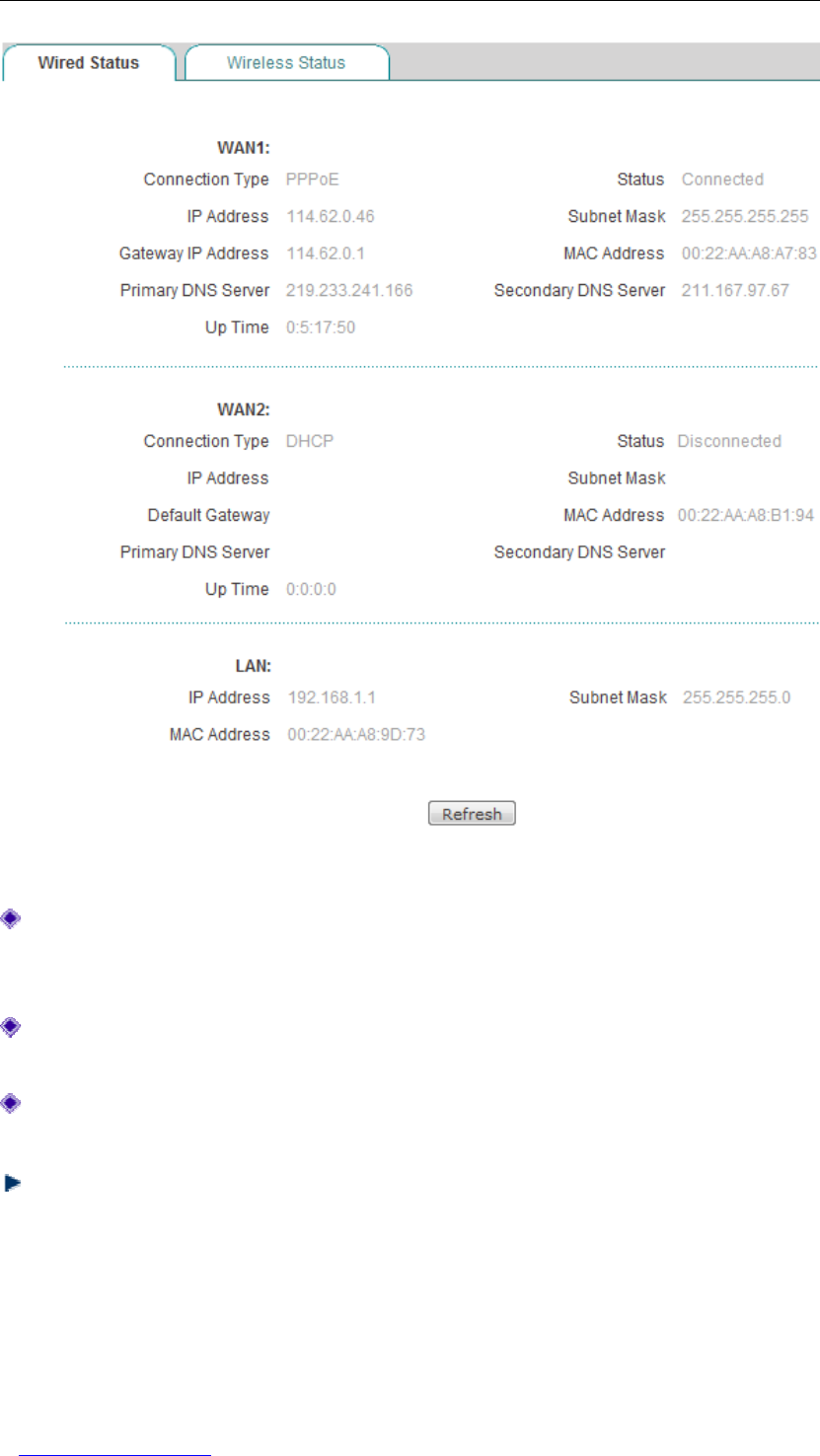
UTT Technologies Chapter 4 Start Menu
http://www.uttglobal.com Page 35
Figure 4- 1 System Status - Wired Status
WAN1: It displays the current status and basic configuration of the WAN1 Internet
connection, which include connection type, status, IP address, subnet mask, MAC
address, default gateway and DNS server addresses, and up time.
WAN2: It displays the current status and basic configuration of the WAN2 Internet
connection, which are the same as those of the WAN1 Internet connection.
LAN: It displays the basic configuration of the LAN inteface, which include IP address,
subnet mask and MAC address.
Refresh: Click to view the latest wired status information.
4.2.2 Wireless Status
This page displays the current status information of the wireless interfaces, which include
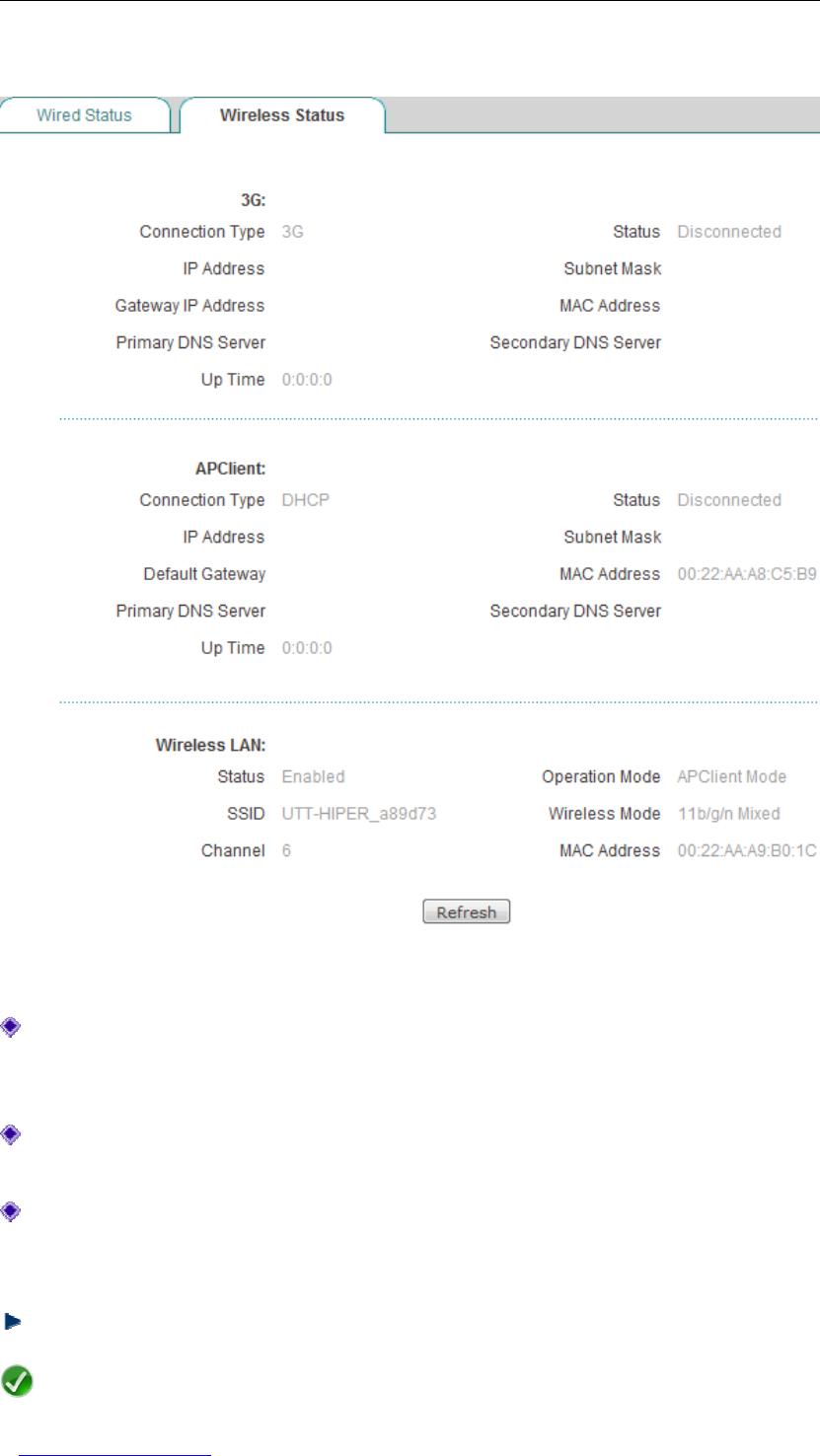
UTT Technologies Chapter 4 Start Menu
http://www.uttglobal.com Page 36
3G, APClient and Wireless LAN.
Figure 4- 2 System Status - Wireless Status
3G: It displays the current status and basic configuration of the 3G Internet
connection, which include connection type, status, IP address, subnet mask, MAC
address, default gateway and DNS server addresses, and up time.
APClient: It displays the current status and basic configuration of the APClient
Internet connection, which are the same as those of the 3G Internection connection.
Wireless LAN: It displays the current status and basic configuration of the Wireless
LAN, which include status, operation mode, SSID, wireless mode, channel and MAC
address.
Refresh: Click to view the latest wireless status information.
Note
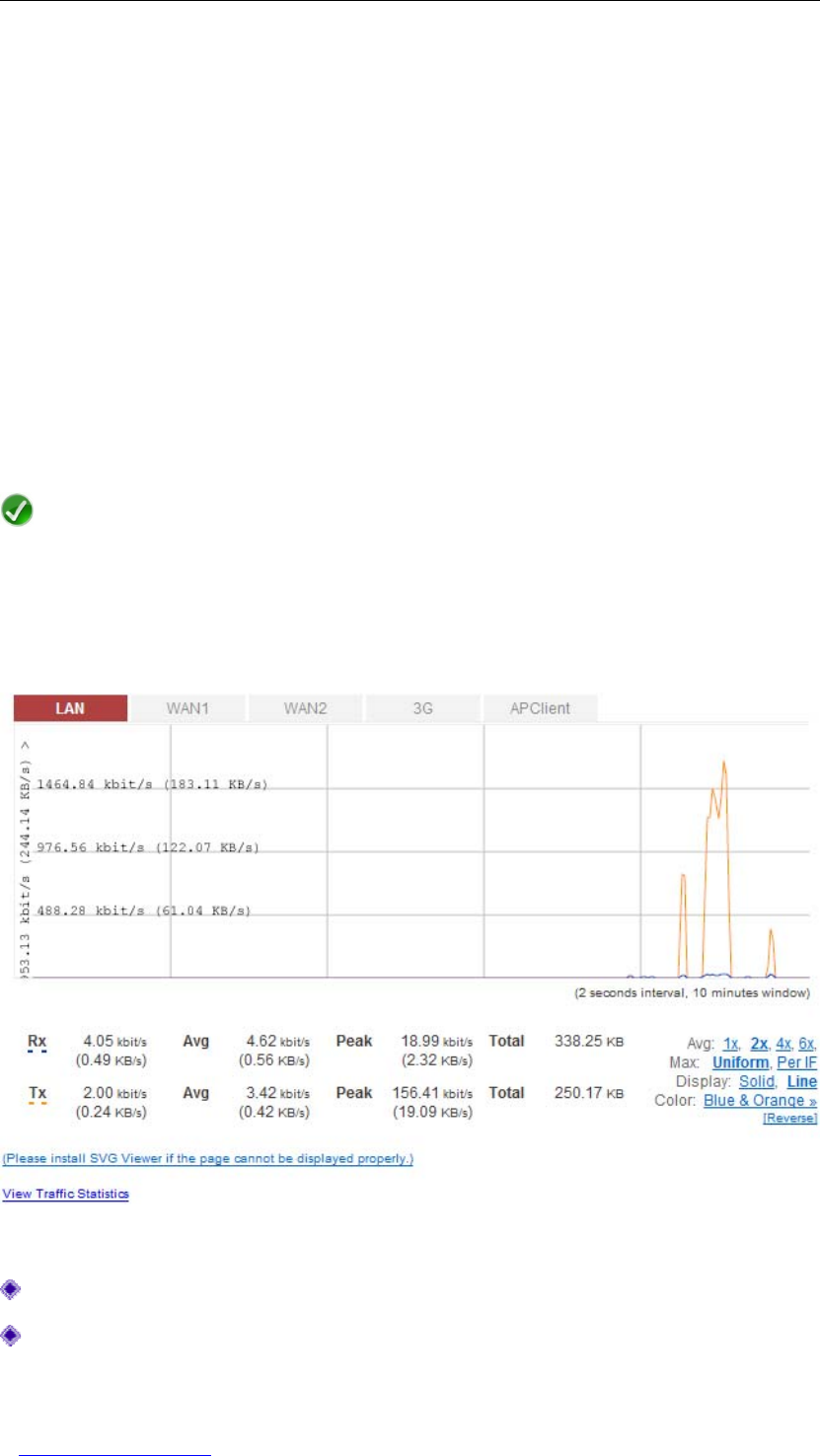
UTT Technologies Chapter 4 Start Menu
http://www.uttglobal.com Page 37
The Wired Status page and Wireless Status page only display the status
information of the interfaces that have been configured.
4.3 Interface Traffic
This section describes the Start > Interface Traffic page.
This page provides the real-time traffic chart for each interface that has been configured,
which displays the real-time Rx/Tx rate, average Rx/Tx rate, maximum Rx/Tx rate and
total Rx/Tx traffic of each interface. For example, as shown in Figure 4- 3, all of the
Wireless Router’s interfaces (LAN, WAN1, WAN2, 3G and APClient) have been
configured.
Note
If the SVG Viewer plug-in isn’t installed on your web browser, the port traffic chart
cannot be displayed properly. Please click the (Please install SVG Viewer if the
page cannot be displayed properly.) hyperlink to download and install the SVG
Viewer to view the traffic chart.
Figure 4- 3 Interface Traffic Chart
Avg: 1x, 2x, 4x, 6x: It specifies the number of samples to average, or no averaging.
Max: It determines that the charts are scaled uniformly to the max traffic value of all
interfaces or individually per interface.
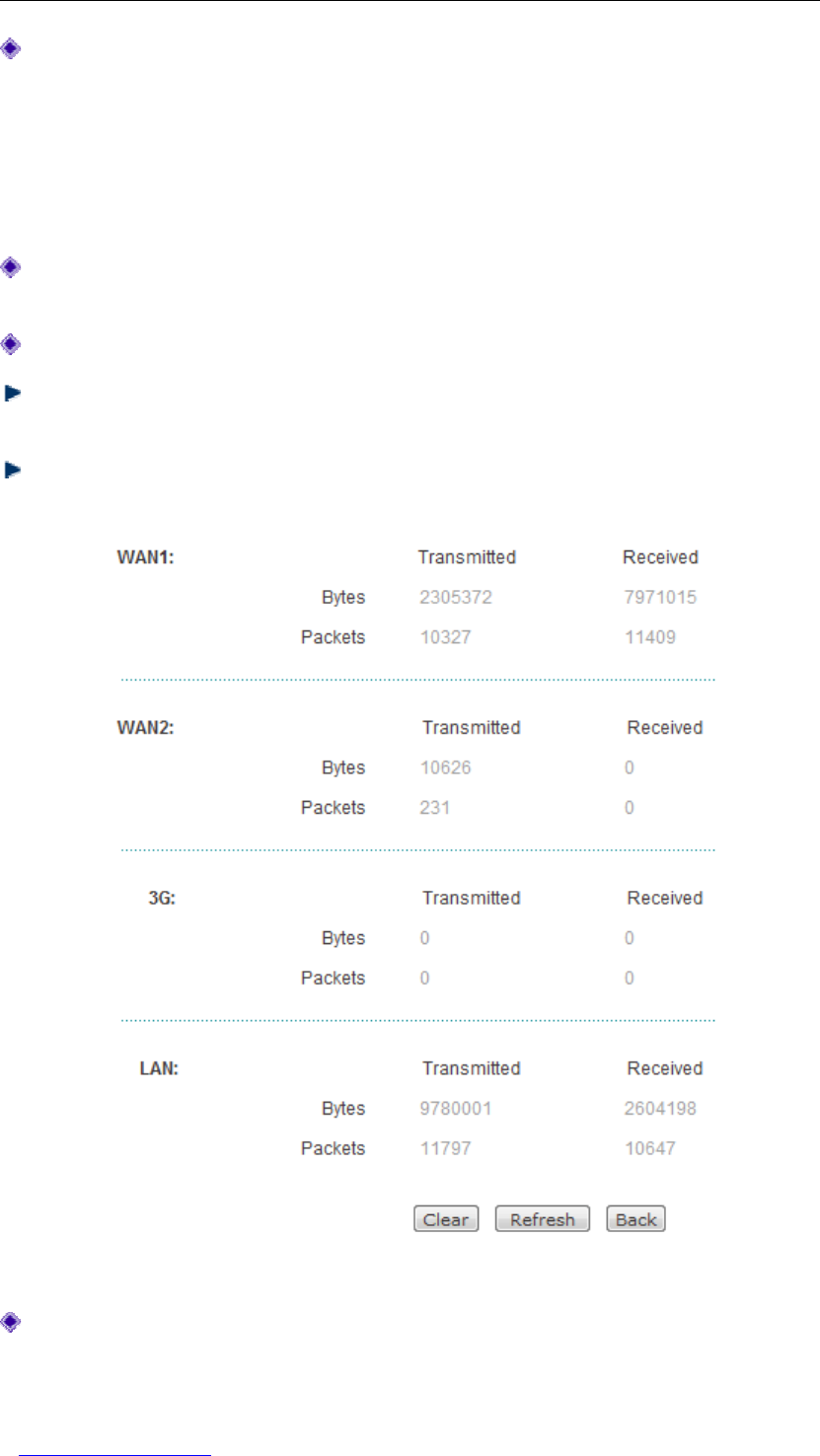
UTT Technologies Chapter 4 Start Menu
http://www.uttglobal.com Page 38
Display: It allows you to change the type of chart displayed. The options are Line
and Solid.
●Line: Select this option to display a line chart. The chart includes two lines with
different colors, which represent the real-time Rx rate and Tx rate resectively.
●Solid: Select this option to display an area chart. The area chart is like the line
chart except that the area between the axis the plot line is solid.
Color: It specifies the colors of the two lines (or filled areas), such as red, blue, black,
etc.
Reverse: Click to toggle the colors of the two lines (or filled areas).
LAN,WAN1,WAN2,APClient and 3G: You can select an interface name at the top
to view the traffic chart for that interface.
View Traffic Statistics: Click to view the ingress and egress traffic statistics for the
interfaces that have been configured, see Figure 4- 4.
Figure 4- 4 Traffic Statistics
WAN1,WAN2,3G,APClient and LAN: You can view the traffic statistics for each
interface, including the number of bytes received and transmitted, and the number of
packets received and transmitted.
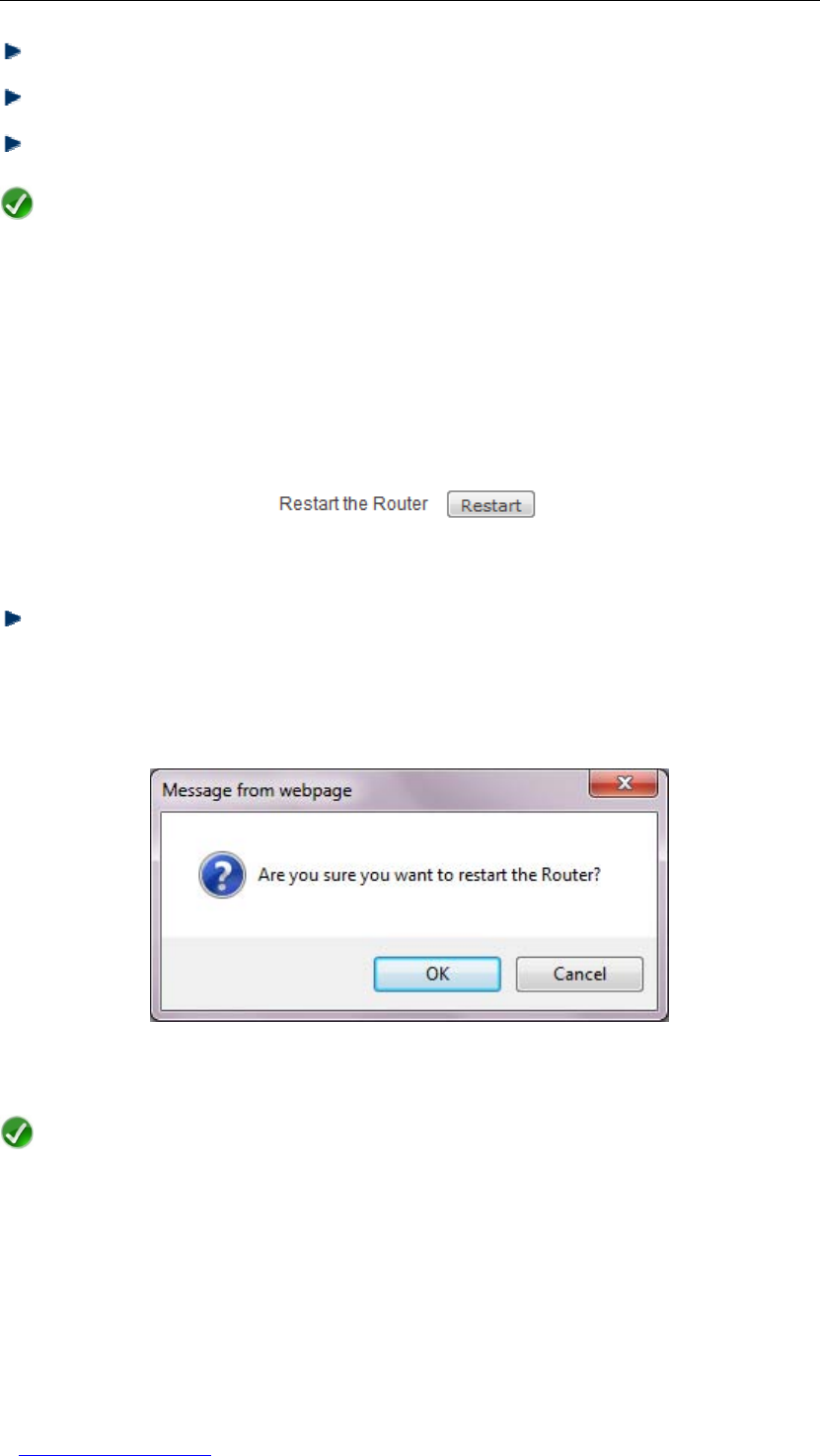
UTT Technologies Chapter 4 Start Menu
http://www.uttglobal.com Page 39
Clear: Click to clear all traffic statistics.
Refresh: Click to view the latest traffic statistics.
Back: ClicktogobacktotheStart > Interface Traffic page.
Note
This page only displays the traffic statistics for the interfaces that have been
configured.
4.4 Restart
Figure 4- 5 Restart the Wireless Router
Restart: Click to restart the Wireless Router.
If you click the Restart button, the system will pop up a prompt dialog box (see Figure
4- 6). Then you can click OK to restart the Wireless Router, or click Cancel to cancel
the operation.
Figure 4- 6 Prompt Dialog Box - Restart the Wireless Router
Note
Restarting the Wireless Router will disconnect all the sessions, so please do it with
caution.
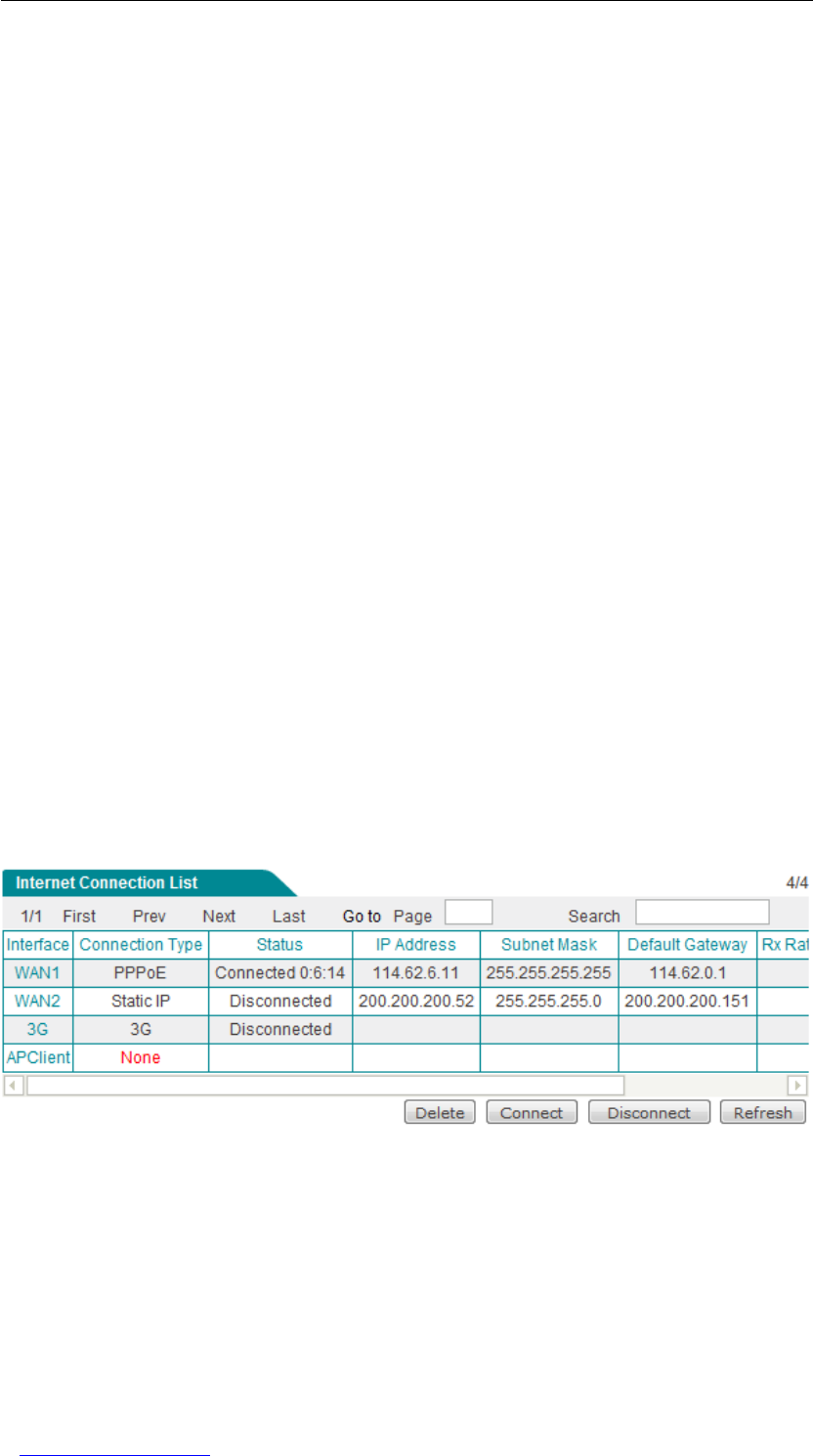
UTT Technologies Chapter 5 Network
http://www.uttglobal.com Page 40
Chapter 5 Network
This chapter describes how to configure the basic network parameters of the Wireless
Router, which include WAN settings, load balancing, LAN settings, DHCP server, DDNS,
and UPnP.
5.1 WAN Settings
This section describes the Network > WAN page.
If you have configured one or more Internet connections in the Start > Quick Wizard,you
can view their configuration and status in this page, and modify or delete them if needed.
You also can directly configure one or more Internet connections in this page.
5.1.1 Internet Connection List
You can view the configuration and status of each Internet connection in the Internet
Connection List, see Figure 5- 1.
Figure 5-1 Internet Connection List
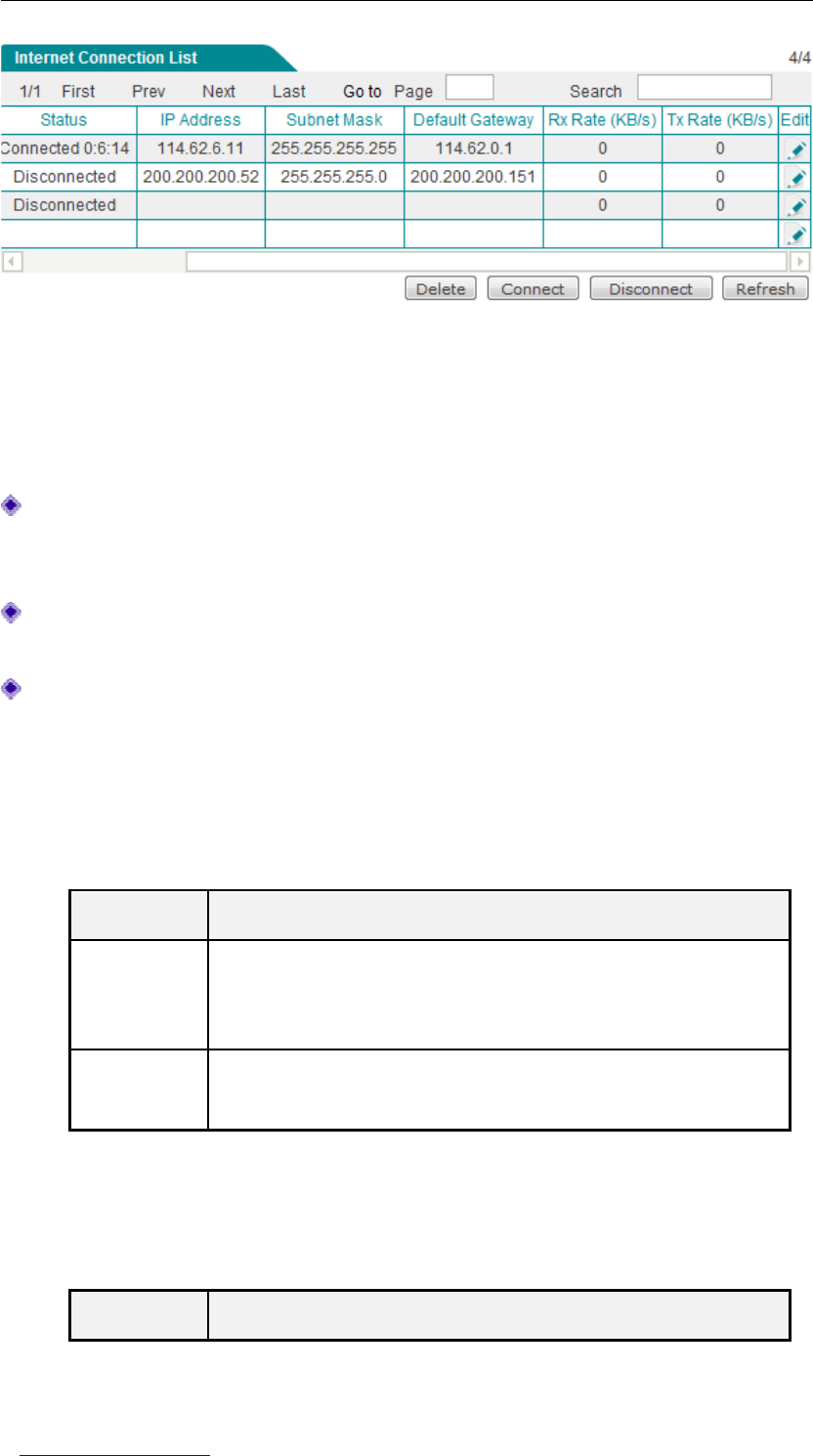
UTT Technologies Chapter 5 Network
http://www.uttglobal.com Page 41
Figure 5-2 Internet Connection List (Continue)
5.1.1.1 Parameter Definitions
Interface: It displays the name of the WAN interface. The Wireless Router has four
WAN interfaces: WAN1, WAN2, 3G, and APClient. Therein, WAN1 and WAN2 are
wired interfaces, and 3G and APClient are wireless interfaces.
Connection Type: It displays the type of the Internet connection. There are four
connection types: Static IP, PPPoE, DHCP and 3G.
Status: It displays current status of the connection. There are four cases:
1. PPPoE Connection Status
For the PPPoE connection, there are two kinds of status, see Table 5- 1. When it is
connected, it will also display the elapsed time (days: hours: minutes: seconds) since
connected.
Status Description
Disconnected
The connection is disconnected due to that the interface is disabled or
not connected, or the Wireless Router doesn’t dial up yet, or wrong user
name or password, etc.
Connected Authentication succeeded, and the connection is established and ready
for data transmission.
Table 5-1 Description of PPPoE Connection Status
2. Static IP Connection Status
For the static IP connection, there are two kinds of status, see Table 5- 2.
Status Description
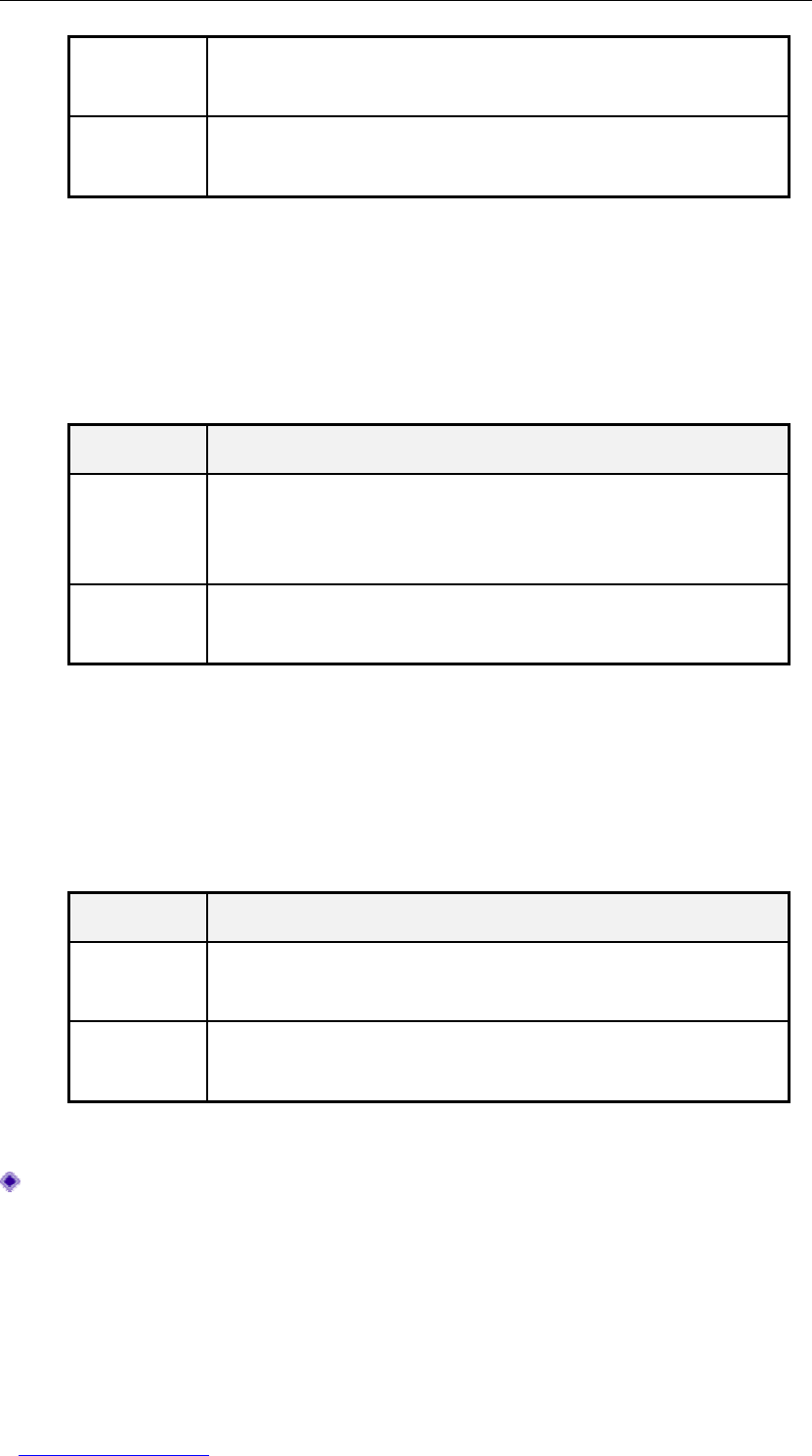
UTT Technologies Chapter 5 Network
http://www.uttglobal.com Page 42
Disconnected The connection is disconnected due to that the interface is disabled or
not connected, etc.
Connected The connection is established between the Wireless Router and peer
device.
Table 5- 2 Description of Static IP Connection Status
3. DHCP Connection Status
For the DHCP connection, there are two kinds of status, see Table 5- 3. When it is
connected, it will also display the elapsed time (days: hours: minutes: seconds) since
connected.
Status Description
Disconnected
The connection is disconnected due to that the interface is disabled or
not connected, or the Wireless Router has released the IP address but
hasn’t obtained a new one yet, etc.
Connected The Wireless Router has obtained an IP address, and the connection is
established successfully.
Table 5- 3 Description of DHCP Connection Status
4. 3G Connection Status
For the 3G connection, there are two kinds of status, see Table 5- 4. When it is
connected, it will also display the elapsed time (days: hours: minutes: seconds) since
connected.
Status Description
Disconnected The connection is disconnected due to that the 3G USB modem isn’t
inserted properly, or wrong ISP, 3G USB modem settings, etc.
Connected The Wireless Router has obtained an IP address, and the connection is
established successfully.
Table 5- 4 Description of 3G Connection Status
IP Address, Subnet Mask and Default Gateway: They display the current IP
settings of the connection. There are two cases:
●For the PPPoE, DHCP or 3G Internet connection, it will show the current WAN IP
address, subnet mask and gateway IP address which are assigned by your ISP.
●For the static IP Internet connection, it will show the information you have
entered manually.

UTT Technologies Chapter 5 Network
http://www.uttglobal.com Page 43
Rx Rate: It displays the average download speed (in kilobytes per second) of the
Internet connection during the time interval between two refresh operations.
Tx Rate: It displays the average upload speed (in kilobytes per second) of the
Internet connection during the time interval between two refresh operations.
5.1.1.2 How to Add, View, Modify and Delete Internet
Connections
Add an Internet Connection: To add a new Internet connection, first click its
Interface hyperlink or icon, and then configure it, lastly click the Save button.
View Internet Connection(s): When you have configured one or more Internet
connections, you can view them in the Internet Connection List.
Modify an Internet Connection: To modify a configured Internet connection, click its
Interface hyperlink or icon, the related information will be displayed in the setup
fields. Then modify it, and click the Save button.
Delete an Internet Connection: To delete an Internet connection, click its Interface
hyperlink or icon to select the connection, and then click the Delete button below
the list.
Refresh Internet Connection List: To view the latest status of the Internet
connections, click the Refresh button below the list.
5.1.1.3 How to Connect and Disconnect a PPPoE/3G
Connection
If you click the Interface hyperlink or icon of a PPPoE or 3G connection, the Connect
and Disconnect button will appear below the list, see Figure 5- 3.
If the PPPoE connection’s Dial Type is set to Manual (see Section 5.1.2.1.3 PPPoE
Internet Connection Settings), you need to click the Connect button to connect it, and
click the Disconnect button to disconnect it.
Connect: Click to connect the PPPoE or 3G Internet connection manually.
Disconnect: Click to disconnect the PPPoE or 3G Internet connection manually.
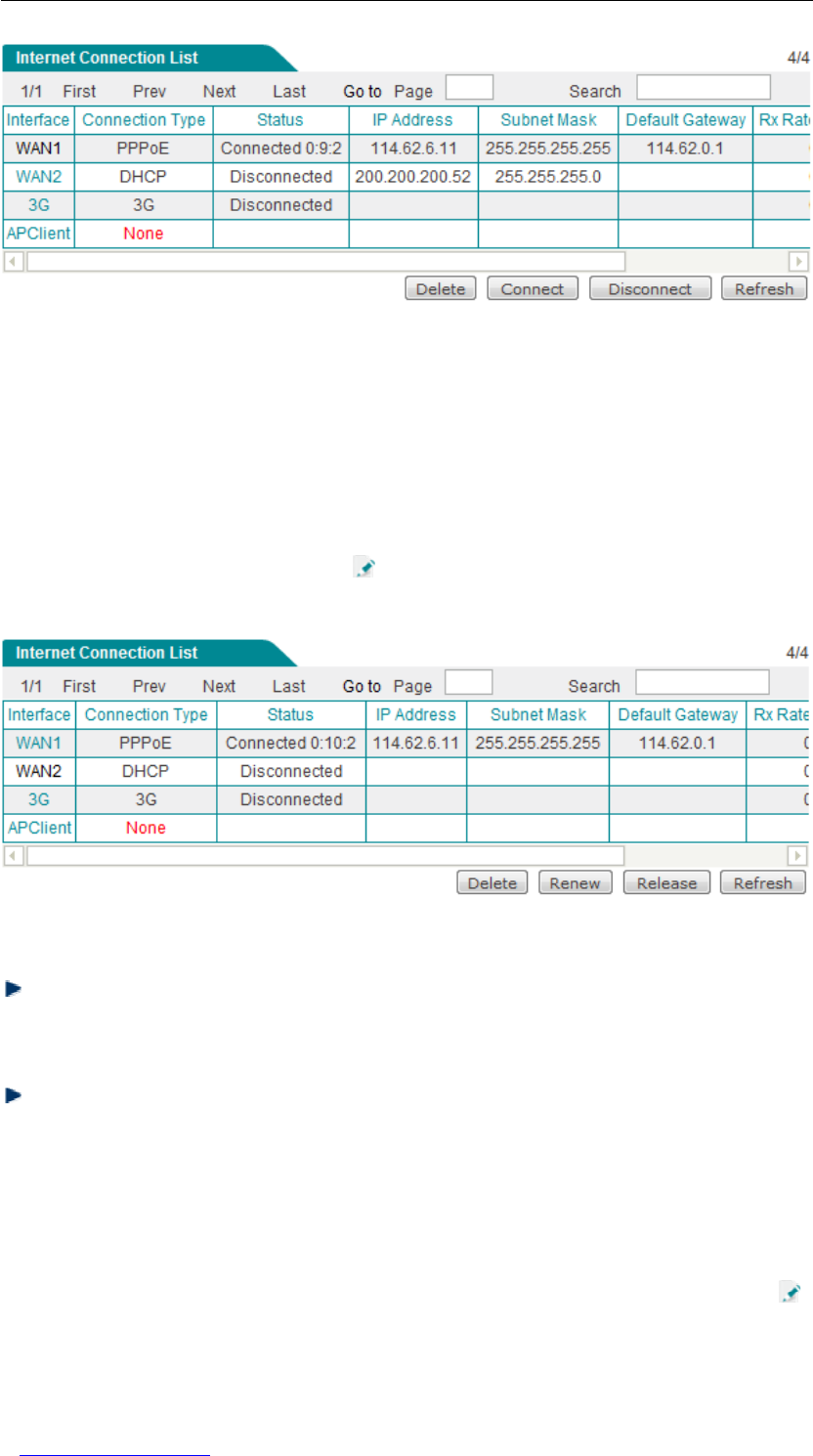
UTT Technologies Chapter 5 Network
http://www.uttglobal.com Page 44
Figure 5- 3 Internet Connection List - PPPoE/3G Connection
5.1.1.4 How to Renew and Release a DHCP
Connection
If you click the Interface hyperlink or icon of a DHCP connection, the Renew button
and Release button will appear below the list, see Figure 5-4.
Figure 5-4 Internet Connection List - DHCP Connection
Renew: Click to re-obtain an IP address from the ISP’s DHCP server. The Wireless
Router will automatically release the assigned IP address firstly, and then obtain a
new IP address from the DHCP server.
Release: Click to release the IP address obtained from the ISP’s DHCP server.
5.1.2 Internet Connection Settings
If you want to configure an Internet connection, please click its Interface hyperlink or
icon in the Internet Connection List. The setup page is shown in Figure 5- 5.
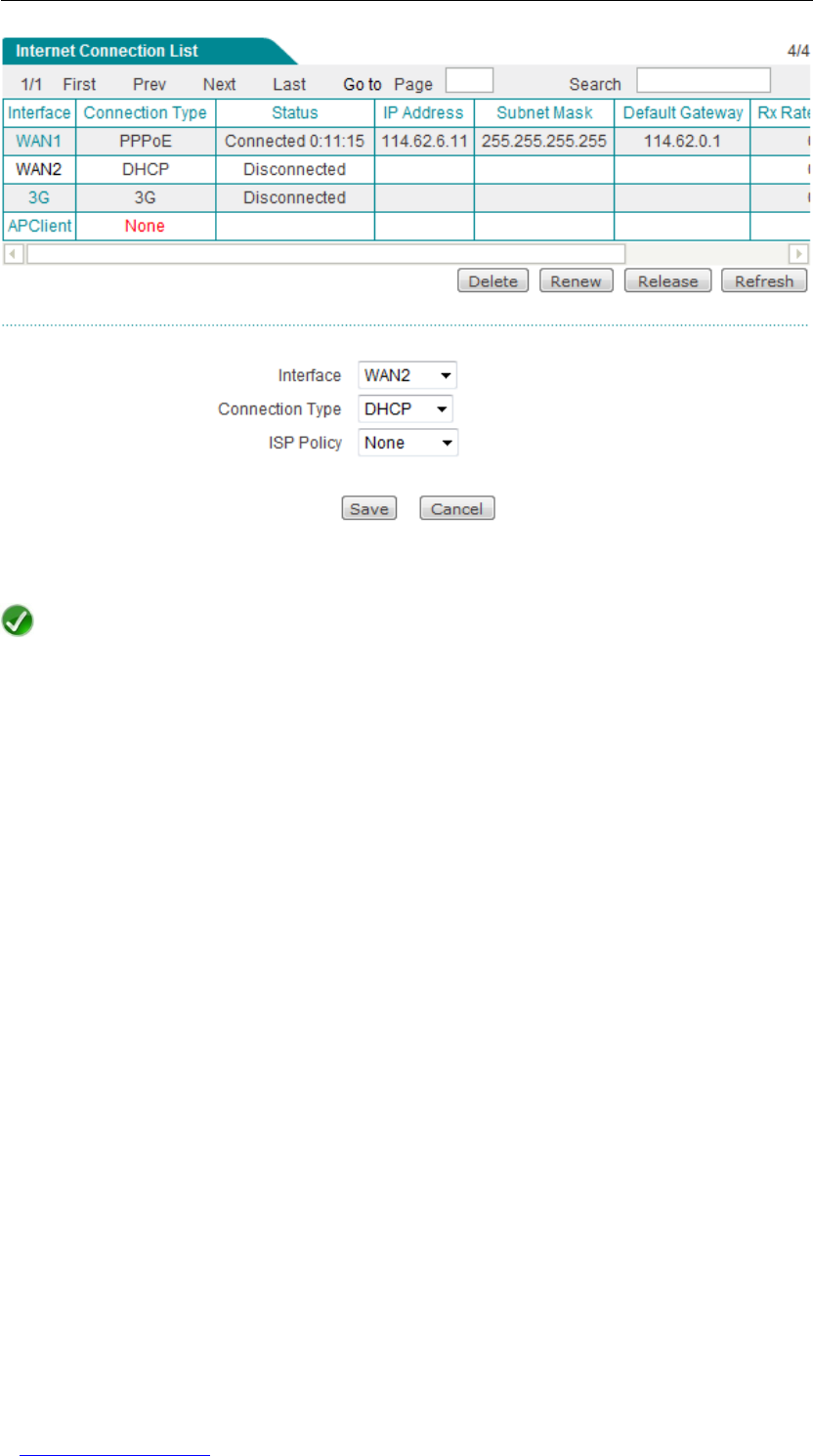
UTT Technologies Chapter 5 Network
http://www.uttglobal.com Page 45
Figure 5-5 Network - WAN Settings
Note
1. It allows you to choose the ISP Policy (i.e., route policy database) for each Internet
connection. The system will automatically create the associated static routes
according to your selection. Thus all traffic destined for one ISP’s servers will be
forwarded through this ISP’s connection.
2. If you want to configure and use an APClient Internet connection, please choose
APClient Mode as the Operation Mode in the Wireless > Basic page.
5.1.2.1 WAN1/WAN2/APClient Internet Connection
Settings
For the WAN1, WAN2 or APClient Internet connection, there are three connection types
which include PPPoE, Static IP and DHCP. The following subsections describe how to
configure the PPPoE, Static IP and DHCP Internet connection respectively.
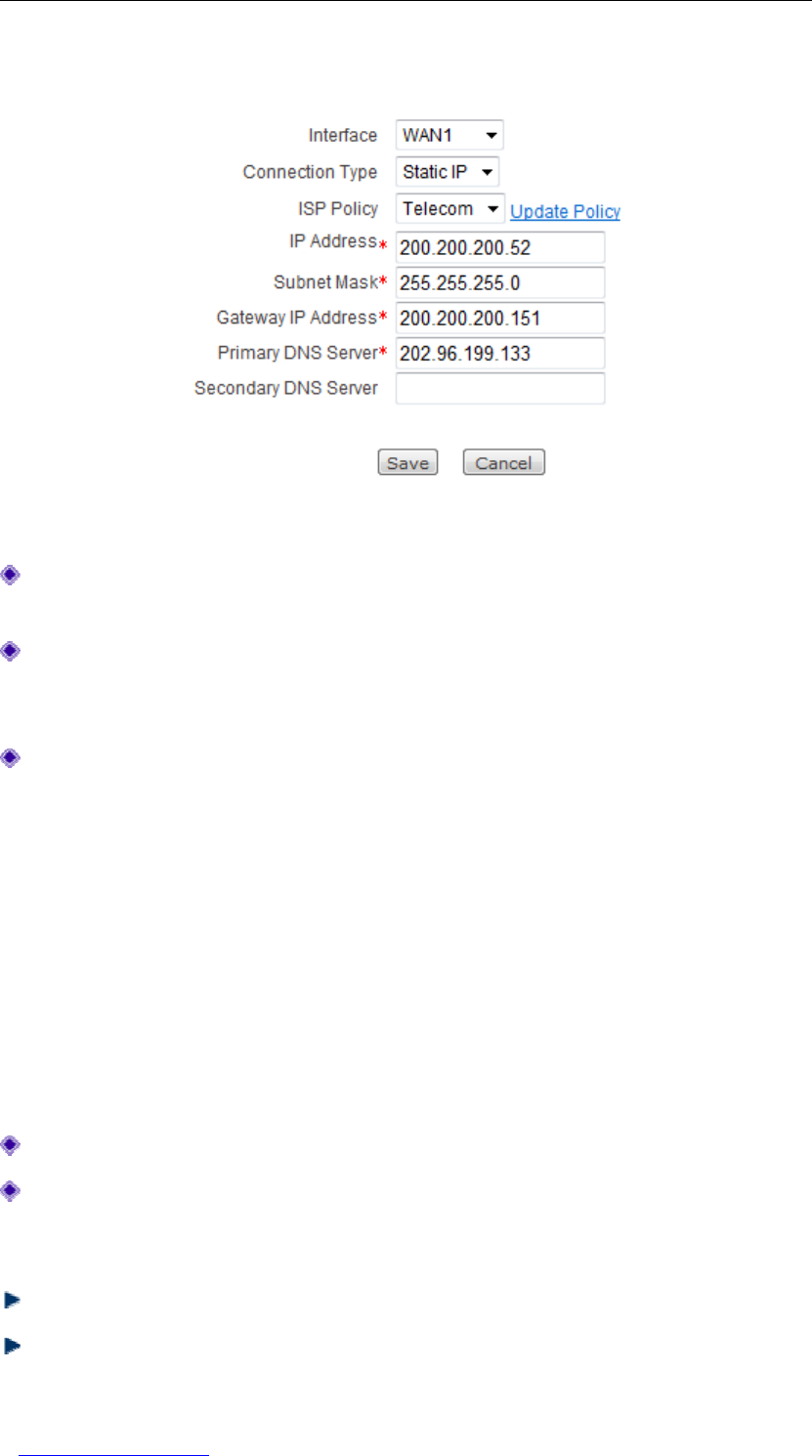
UTT Technologies Chapter 5 Network
http://www.uttglobal.com Page 46
5.1.2.1.1 Static IP Internet Connection Settings
Figure 5- 6 Static IP Internet Connection
Interface: It specifies the name of the WAN interface. Here please select WAN1,
WAN2 or APClient.
Connection Type: It specifies the type of the Internet connection. Here please select
Static IP. You need to manually configure IP address, subnet mask, default gateway
and DNS server addresses, which are provided by your ISP.
ISP Policy: It specifies the route policy database used for the Interent connection.
There are four options: None, Telecom, Unicom and Mobile.
●None: It means that no route policy database is used. This option is selected by
default.
●Telecom: If your ISP is China Telecom, you may select this option. Then the
traffic destined for China Telecom servers will be forwarded through the
connection.
●Unicom: If your ISP is China Unicom, you may select this option. Then the traffic
destined for China Unicom servers will be forwarded through the connection.
●Mobile: If your ISP is China Mobile, you may select this option. Then the traffic
destined for China Mobile servers will be forwarded through the connection.
Update Policy: Click to update the corresponding route policy database.
IP Address,Subnet Mask,Default Gateway,Primary DNS Server and Secondary
DNS Server: Refer to Section 3.3.3.1.1 Static IP Internet Connection Settings for
detailed information.
Save: Click to save your changes.
Cancel: Click to revert to the last saved settings.
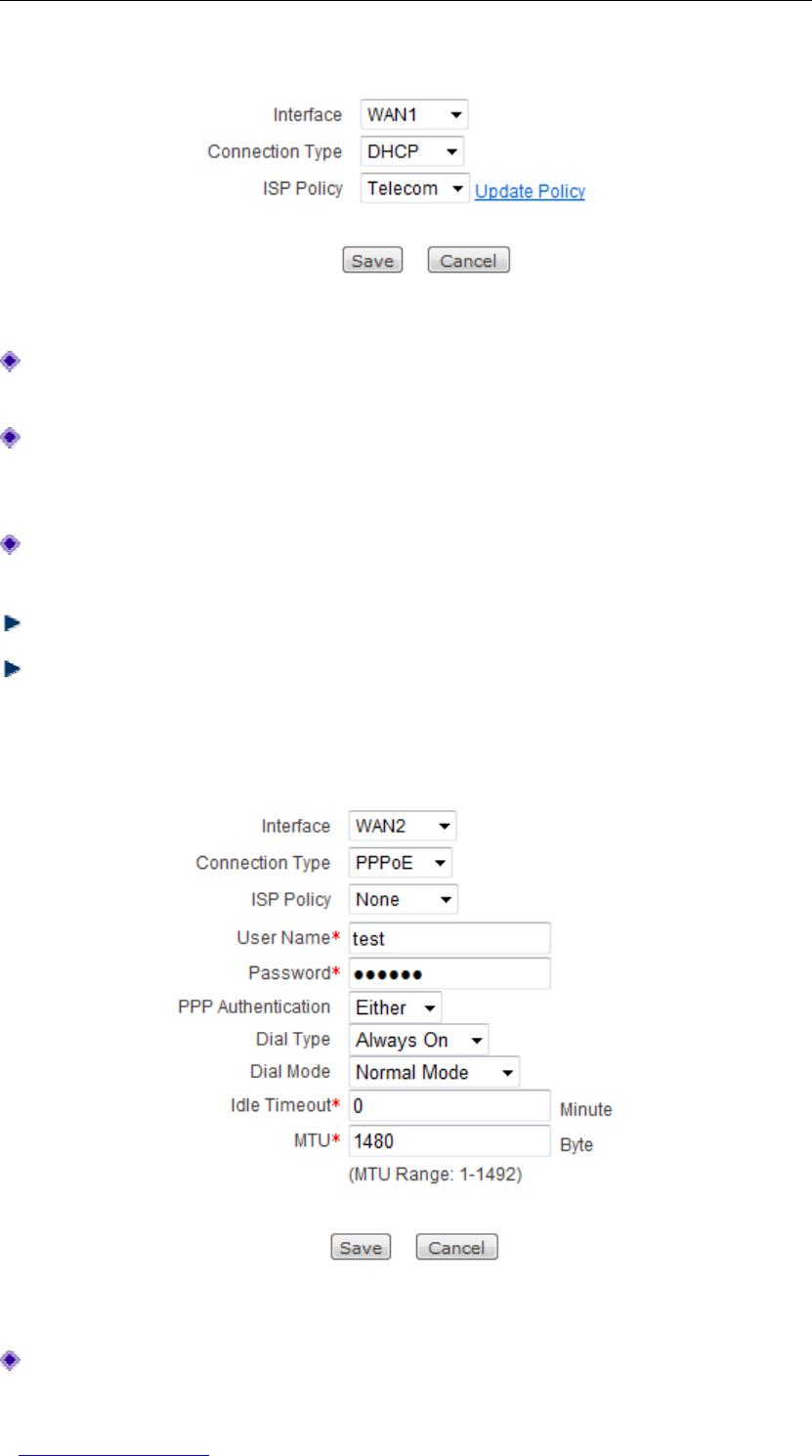
UTT Technologies Chapter 5 Network
http://www.uttglobal.com Page 47
5.1.2.1.2 DHCP Internet Connection Settings
Figure 5-7 DHCP Internet Connection Settings
Interface: It specifies the name of the WAN interface. Here please select WAN1,
WAN2 or APClient.
Connection Type: It specifies the type of the Internet connection. Here please select
DHCP. The Wireless Router will automatically obtain the WAN IP address, subnet
mask and gateway and DNS server addresses from your ISP’s DHCP server.
ISP Policy and Update Policy: Refer to Section 5.1.2.1.1 Static IP Internet
Connection Settings for detailed information.
Save: Click to save your changes.
Cancel: Click to revert to the last saved settings.
5.1.2.1.3 PPPoE Internet Connection Settings
Figure 5- 8 PPPoE Internet Connection Settings
Interface: It specifies the name of the WAN interface. Here please select WAN1,

UTT Technologies Chapter 5 Network
http://www.uttglobal.com Page 48
WAN2 or APClient.
Connection Type: It specifies the type of the Internet connection. Here please select
PPPoE. The Wireless Router will automatically obtain the WAN IP address, subnet
mask and gateway IP address from your ISP’s PPPoE server.
ISP Policy and Update Policy: Refer to Section 5.1.2.1.1 Static IP Internet
Connection Settings for detailed information.
User Name and Password: They specify the PPPoE login user name and password
provided by your ISP. Please ask your ISP if you have any questions.
PPP Authentication: It specifies the PPP authentication mode of the PPPoE
connection. The available options are Either,PAP,CHAP and NONE. The default
value is Either, which means that the Wireless Router will automatically negotiate it
with the remote PPPoE Server. NONE means that no authentication is performed.
Dial Type: It specifies the dial type of the PPPoE connection. The available options
are Always On,Manual and On Demand.
•Always On: If you want the Wireless Router to establish the PPPoE connection
when starting up and to automatically re-establish the PPPoE connection once
disconnected, please select this option.
•Manual: If you want to connect and disconnect the PPPoE connection manually
in the Internet connection List (see Section 5.1.1.3 How to Connect and
Disconnect a PPPoE/3G Connection), please select this option.
•On Demand: If you want the Wireless Router to establish the PPPoE connection
only when it listens for packets destined for the Internet, please select this option.
Dial Mode: It specifies the dial mode of the PPPoE Internet connection. The default
value is Normal mode. If the PPPoE connection isn’t established successfully even
using correct user name and password, you may try to use another mode.
Idle Timeout: It specifies how long the PPPoE connection keeps connected since no
Internet activity. The Wireless Router will automatically terminate the connection after
it has been inactive for the specified period of time. The default value is zero, which
means that the Wireless Router will not terminate it.
MTU: It the maximum packet size that can be transmitted over a network. When
dialing, the Wireless Router will automatically negotiate it with the peer device.
Please leave the default value of 1480 bytes, unless you have a special application.
Save: Click to save your changes.
Cancel: Click to revert to the last saved settings.
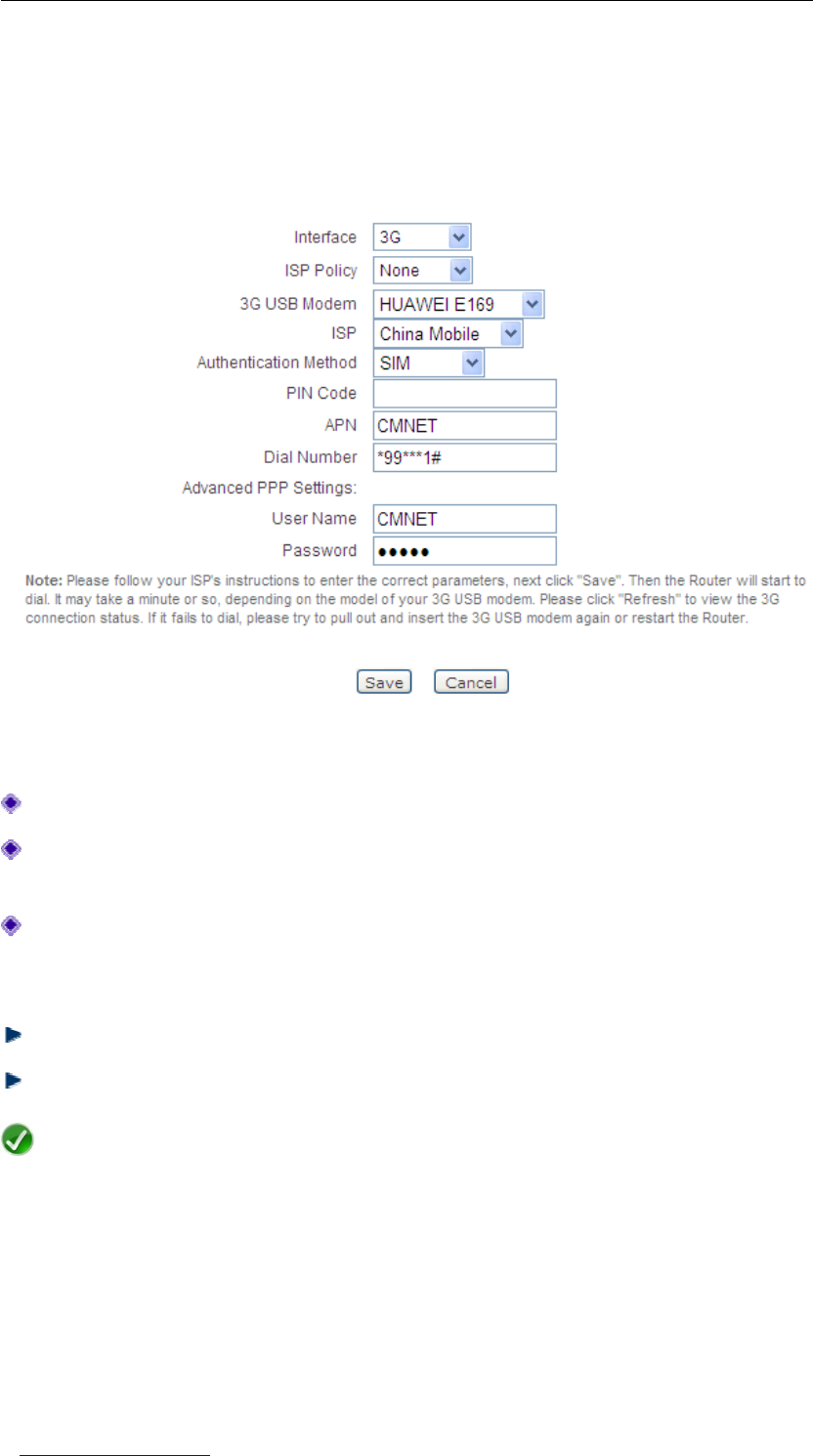
UTT Technologies Chapter 5 Network
http://www.uttglobal.com Page 49
5.1.2.2 3G Internet Connection Settings
To configure a 3G Internet connection, select 3G from the Interface drop-down list. Then
the following page will be shown.
Figure 5-9 3G Internet Connection Settings
Interface: It specifies the name of the WAN interface. Here please select 3G.
ISP Policy and Update Policy: Refer to Section 5.1.2.1.1 Static IP Internet
Connection for detailed information.
3G USB Modem,ISP,Authentication Method,PIN Code,APN,Dial Number,
User Name,andPassword: Refer to Section 3.3.3.2 3G Internet Connection
Settings for detailed information.
Save: Click to save your changes.
Cancel: Click to revert to the last saved settings.
Note
It is strongly recommended that you configure only the 3G USB Modem and ISP of
the 3G Internet connection, and leave the other parameters at their default values. If
necessary, please follow your ISP’s instructions to change them. After you click the
Save button, the Wireless Router will start to dial. It may take a minute or so,
depending on the model of your 3G USB modem. Please click the Refresh button to
view the 3G connection status. If it fails to dial, please try to pull out and insert the 3G
USB modem again or restart the Wireless Router.
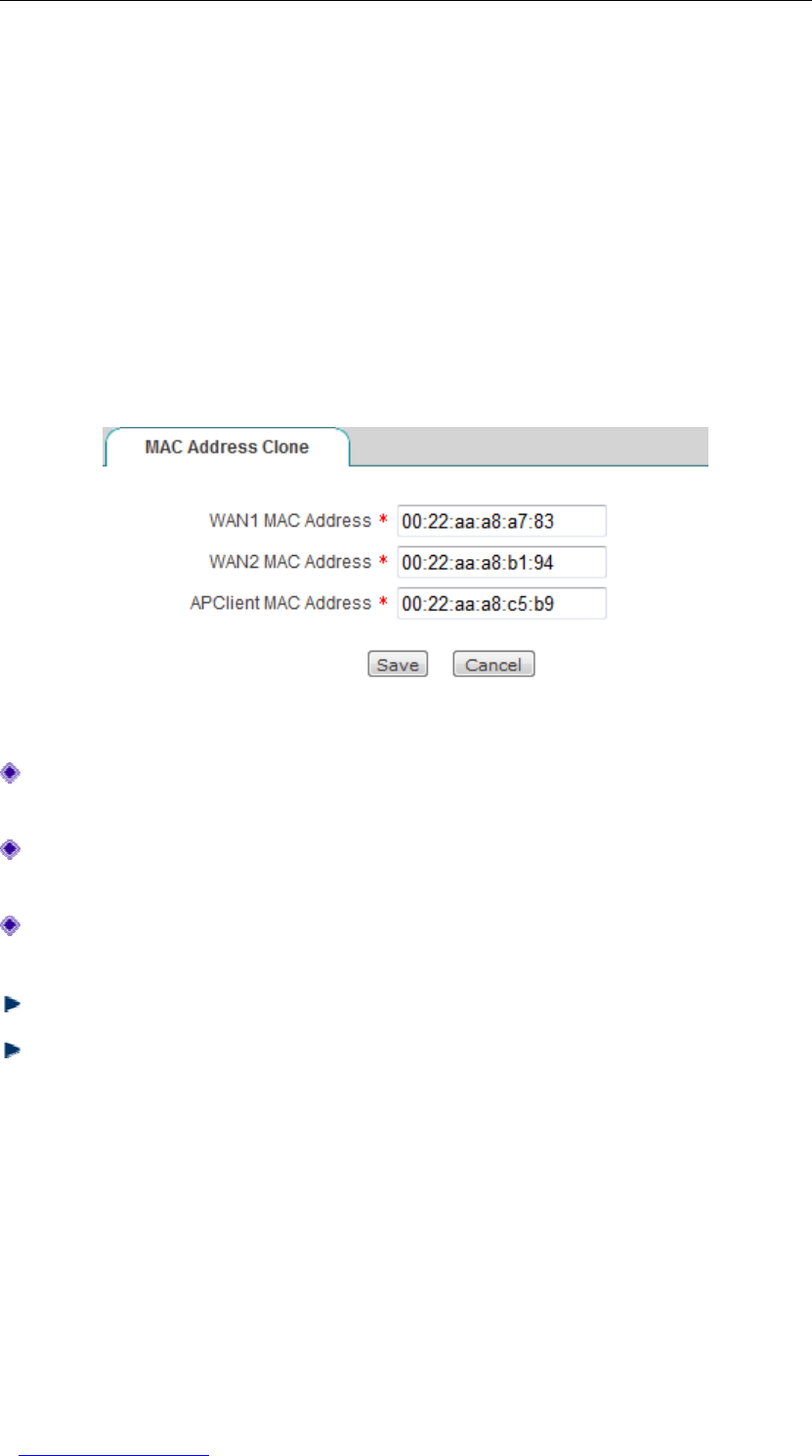
UTT Technologies Chapter 5 Network
http://www.uttglobal.com Page 50
5.1.3 MAC Address Clone
Some ISPs register the MAC address of your network device (usually a computer) when
your account is first opened, and they will only accept traffic from that MAC address. With
MAC address clone feature, you may assign the registered MAC address to the Wireless
Router’s external interface if you don’t want to re-register the MAC address with your ISP.
To configure MAC address clone, go to the Network > WAN page, and then select the
MAC Address Clone tab to go to the setup page shown in Figure 5- 10 MAC Address
CloneFigure 5- 10. In this page, you can change the MAC address of each external
interface (WAN1, WAN2, or APClient interface) as required.
Figure 5- 10 MAC Address Clone
WAN1 MAC Address: It specifies the MAC address of the Wireless Router’s WAN1
interface.
WAN2 MAC Address: It specifies the MAC address of the Wireless Router’s WAN2
interface.
APClient MAC Address: It specifies the MAC address of the Wireless Router’s
APClient interface.
Save: Click to save your changes.
Cancel: Click to revert to the last saved settings.

UTT Technologies Chapter 5 Network
http://www.uttglobal.com Page 51
5.2 Load Balancing
This section describes the Network > Load Balancing page.
In this page, you can configure load balancing global parameters, the connection
detection parameters (including detection target IP, detection interval, retry times, etc.) for
each Internet connection, and view the status and configuration of them.
5.2.1 Introduction to Load Balancing and Failover
5.2.1.1 Internet Connection Detection Mechanism
When using multiple Internet connections, to ensure that the network will not be
interrupted when a connection is faulty, the Wireless Router should have the ability of
real-time monitoring each Internet connection. To this end, we design flexible automatic
detection mechanism on the Wireless Router, and provide multiple detection methods to
meet the actual requirements.
For the sake of convenience, we firstly introduce several related parameters including
Detection Target IP,Detection Interval,Retry Times,andDetection Period.
●Detection Target IP: It indicates the IP address of a target device. The Wireless
Router will monitor an Internet connection by sending detection packets to the
specified target IP address.
●Detection Interval: It indicates the time interval at which the Wireless Router
periodically sends detection packets, one packet at a time. The default value is 0,
which means that connection detection is disabled.
●Retry Times: It indicates the number of retries per detection period.
●Detection Period: It indicates a period of time during which the Wireless Router
detects whether the Internet connection is available or not. Its value is the product of
Detection Interval and Retry Times. For example, if the Detection Interval is set to
10 seconds and the Retry Times is set to 3, then the Detection Period is 30 (10 × 3
= 30) seconds.
For a normal Internet connection and a faulty Internet connection, the detection
mechanisms are different, the following describes them respectively.
For a normal Internet connection, the detection mechanism is as follows: The Wireless
Router periodically sends a detection packet at the specified time interval to the target IP
address. Once no response packet received during a detection period, the Wireless
Router will consider that the connection is faulty and shield it immediately. For example,

UTT Technologies Chapter 5 Network
http://www.uttglobal.com Page 52
when the Retry Times is set to 5, if the Wireless Router has sent five consecutive
detection packets but not received any response packet during a detection period, it will
consider that the connection is faulty.
For a faulty Internet connection, the detection mechanism is as follows: Similarly, the
Wireless Router also periodically sends a detection packet at the specified time interval to
the target IP address. Once more than half of the response packets received during a
detection period, the Wireless Router will consider that the connection is back to normal
and enable it immediately. For example, when the Retry Times issetto5,iftheWireless
Router has sent five consecutive detection packets and received three or more packets
during a detection period, it will consider that the connection is back to normal.
On the Wireless Router, you can assign a preferential Internet connection to some local
computers in advance by setting the connection’s Start Internal IP and End Internal IP,
thus the computers in the specified address range will preferentially use the assigned
Internet connection to access the Internet. If the assigned Internet connection is normal,
those computers can only use it to access the Internet. Else, they will use other normal
Internet connections to access the Internet.
Note
If you don’t want to monitor an Internet connection, please leave its Detection
Interval at the default value of 0.
5.2.1.2 Load Balancing Mode
The Wireless Router provides two connection groups: primary connection group and
backup connection group. An Internet connection in the primary connection group is a
primary connection, while an Internet connection in the backup connection group is a
backup connection. By default, all the Internet connections are primary connections. You
can move one or more connections into the backup connection group if needed.
The Wireless Router provides two load balancing modes: Full Load Balancing and
Partial Load Balancing.
If you choose to use Full Load Balancing, all the Internet connections are used as
primary connections. The working principle is as follows:
1. If all the Internet connections are normal, the LAN users will use these connections to
access the Internet.
2. If an Internet connection is faulty, the Wireless Router will shield it immediately, and
the traffic through the faulty connection will be distributed to other normal connections
automatically.
3. Once the faulty connection is back to normal, the Wireless Router will enable it
immediately, and the traffic will be redistributed automatically.
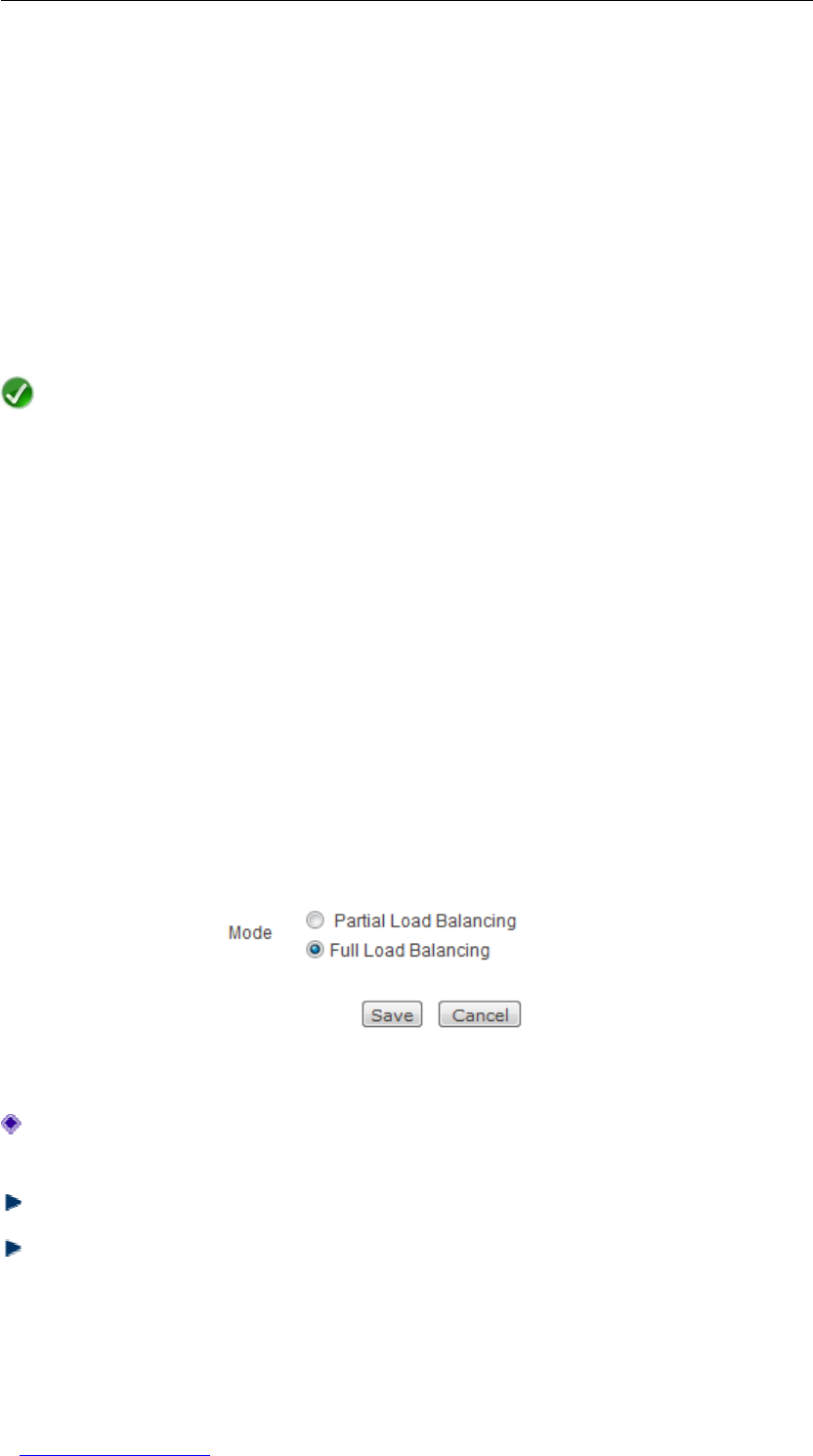
UTT Technologies Chapter 5 Network
http://www.uttglobal.com Page 53
If you choose to use Partial Load Balancing, some Internet connections are used as
primary connections, and others are used as backup connections. The working principle is
as follows:
1. As long as one or more primary connections are normal, the LAN users will use the
primary connection(s) to access the Internet.
2. If all the primary connections are faulty, it will automatically switch to the backup
connection(s) to let the LAN users use them to access the Internet.
3. Once one or more faulty primary connections are back to normal, it will automatically
switch back to the primary connection.
Note
During connections switching, some user applications (such as some online games)
may be interrupted unexpectedly due to the nature of TCP connection.
5.2.2 Load Balancing Global Settings
The following sections describe the global settings related to Full Load Balancing and
Partial Load Balancing respectively. For more information, please refer to Section
5.2.1.2 Load Balancing Mode.
5.2.2.1 Global Settings - Full Load Balancing
Figure 5-11 Global Settings - Full Load Balancing
Mode: It specifies the mode of load balancing. Here please leave the default value of
Full Load Balancing.
Save: Click to save your changes.
Cancel: Click to revert to the last saved settings.
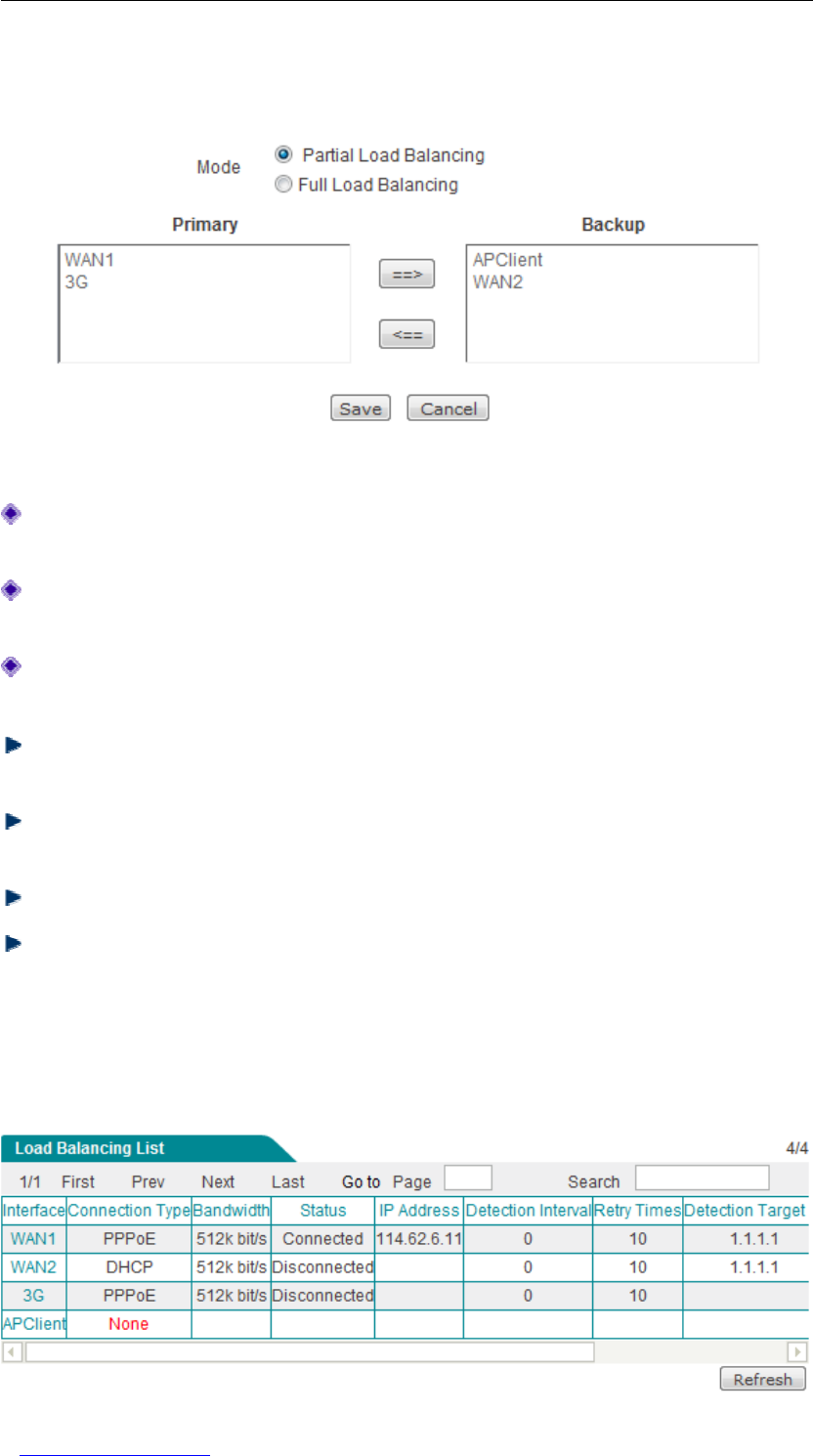
UTT Technologies Chapter 5 Network
http://www.uttglobal.com Page 54
5.2.2.2 Global Settings - Partial Load Balancing
Figure 5-12 Global Settings - Partial Load Balancing
Mode: It specifies the mode of load balancing. Here please select Partial Load
Balancing.
Primary: It specifies the primary connection group. An Internet connection in the
Primary list box is a primary connection.
Backup: It specifies the backup connection group. An Internet connection in the
Backup list box is a backup connection.
==>: Select one or more Internet connections in the Primary list box, and then click
==> to move the selected connection(s) to the Backup list box.
<==: Select one or more Internet connections in the Backup list box, and then click
==> to move the selected connection(s) to the Primary list box.
Save: Click to save your changes.
Cancel: Click to revert to the last saved settings.
5.2.3 Load Balancing List
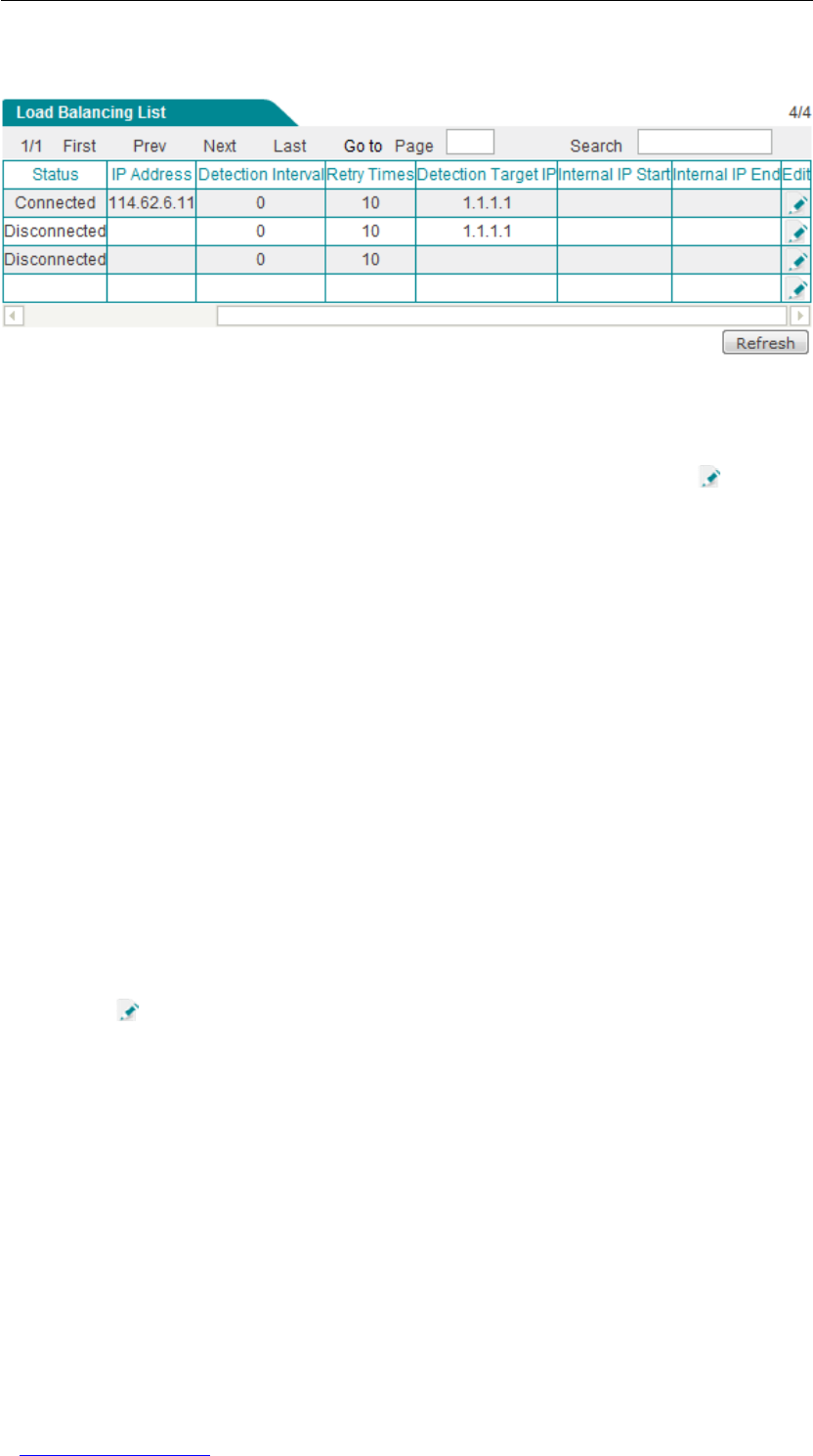
UTT Technologies Chapter 5 Network
http://www.uttglobal.com Page 55
Figure 5-13 Load Balancing List
Figure 5- 14 Load Balancing List (Continue)
¾Edit an Internet Connection: To configure or modify the detection related
parameters of an Internet connection, click its Interface hyperlink or icon, the
related information will be displayed in the Connection Detection Settings page.
Then configure or modify it, and click the Save button.
¾View Load Balancing List: When you have configured load balancing global
settings and connection detection settings, you can view the related configuration and
status in the Load Balancing List.
¾Refresh Load Balancing List: Click the Refresh button to view the latest
information in the list.
5.2.4 Connection Detection Settings
You can configure the connection detection related parameters for each Internet
connection as required. The operation is as follows: Go to the Network > Load
Balancing > Load Balancing List page, and click an Internet connection’s Interface
hyperlink or icon to go the Connection Detection Settings page to configure them.
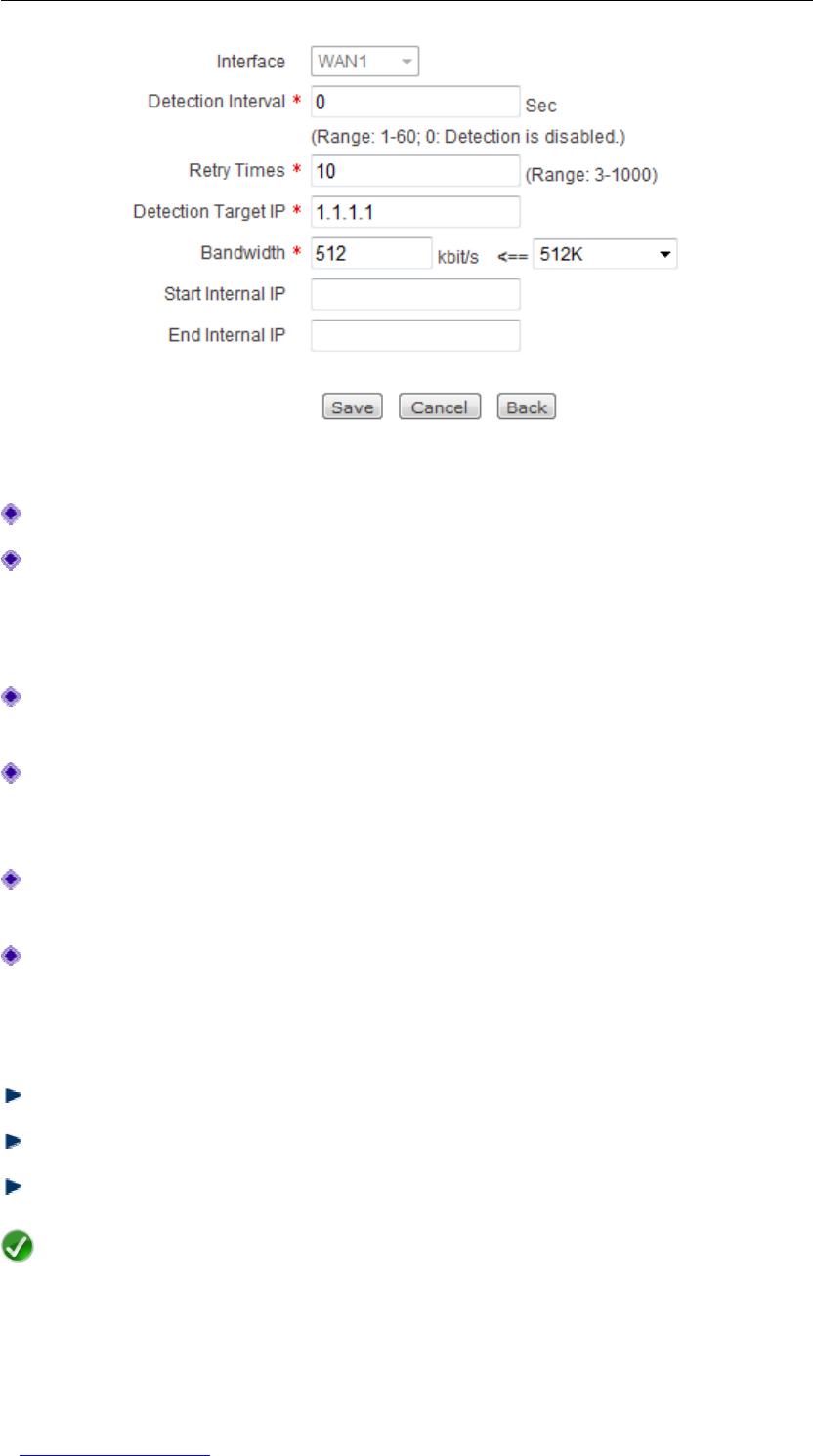
UTT Technologies Chapter 5 Network
http://www.uttglobal.com Page 56
Figure 5- 15 Connection Detection Settings
Interface: It indicates the name of the WAN interface. It is non-editable.
Detection Interval: It specifies the time interval at which the Wireless Router
periodically sends detection packets, one packet at a time. It must be between 1 and
60 seconds, or 0. The default value is 0, which means that connection detection is
disabled on the Internet connection.
Retry Times: It specifies the number of retries per detection period. The default value
is 3.
Detection Target IP: It specifies the IP address of a detection target device. The
Wireless Router will monitor the Internet connection by sending the detection packets
to the detection target IP address.
Bandwidth: It specifies the Internet connection’s bandwidth, which is provided by
your ISP.
Start Internal IP and End Internal IP: They specify a range of internal IP addresses.
The local computers within the specified range will preferentially use the Internet
connection. Refer to Section 5.2.1.1 Internet Connection Detection Mechanism
for more information.
Save: Click to save your changes.
Cancel: Click to revert to the last saved settings.
Back: ClicktogobacktotheLoad Balancing List page.
Note
The Detection Target IP,Detection Interval,andRetry Times are connection
detection related parameters. Please refer to Section 5.2.1.1 Internet Connection
Detection Mechanism for more information.

UTT Technologies Chapter 5 Network
http://www.uttglobal.com Page 57
5.2.5 How to Configure Connection Detection Settings
To configure connection detection settings, follow these steps:
Step 1 Go to the Network > Load Balancing > Load Balancing List page.
Step 2 Click an Internet connection’s Interface hyperlink or icon to go the
Connection Detection Settings page.
Step 3 Configure detection related parameters (Detection Target IP,Detection
Interval,Retry Times, etc.) for the selected Internet connection as required.
Step 4 Click the Save button to save your changes.
Step 5 To configure the detection settings for another Internet connection, please
repeat the above steps.
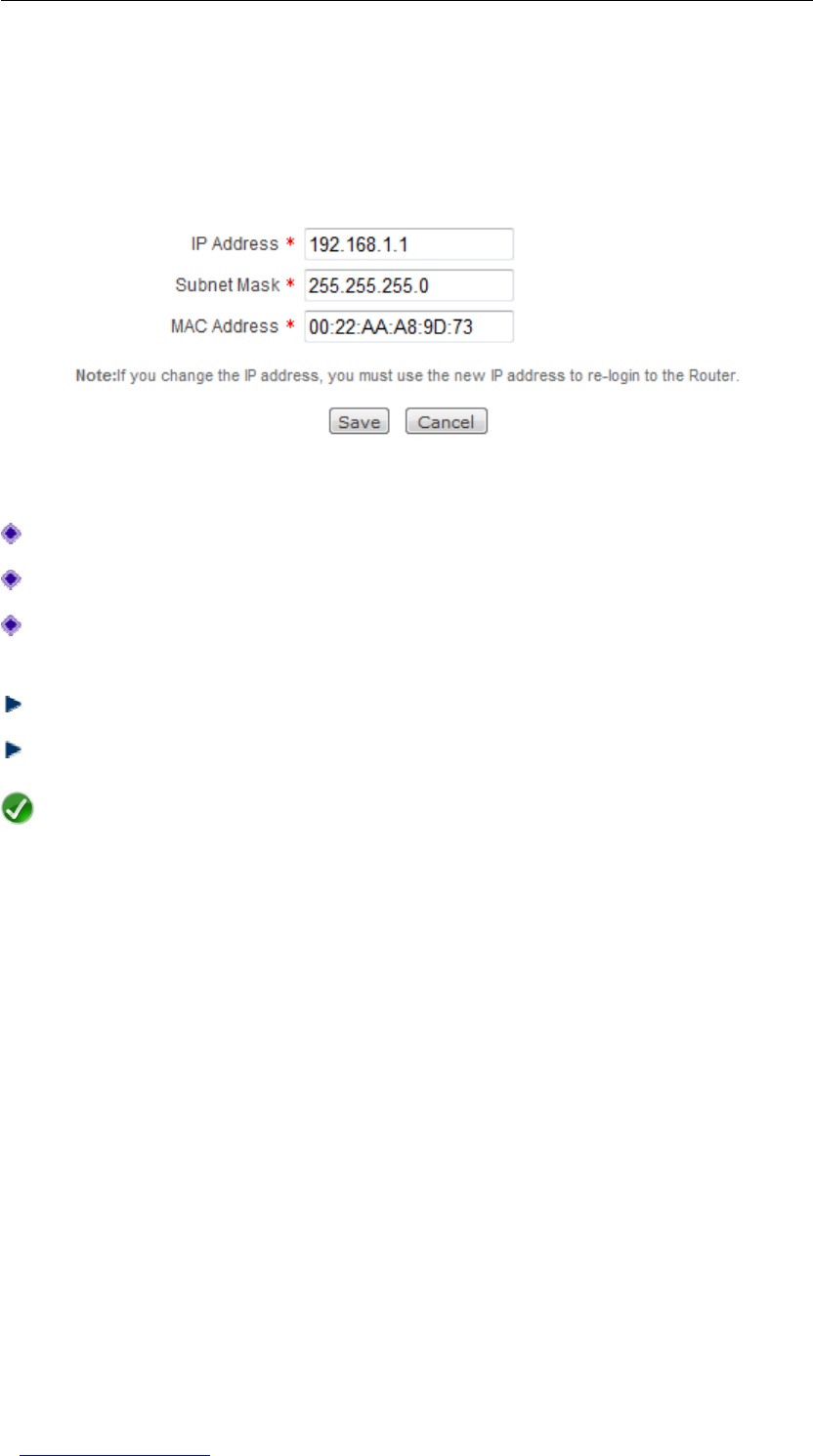
UTT Technologies Chapter 5 Network
http://www.uttglobal.com Page 58
5.3 LAN Settings
This section describes the Network > LAN page, where you can configure the IP address,
subnet mask and MAC address of the Wireless Router’s LAN interface.
Figure 5-16 LAN Interface Settings
IP Address: It specifies the IP address of the LAN interface.
Subnet Mask: It specifies the subnet mask that defines the range of the LAN.
MAC Address: It specifies the MAC address of the LAN interface. In most cases,
please leave the default value.
Save: Click to save your changes.
Cancel: Click to revert to the last saved settings.
Note
If you have changed the IP address of the LAN interface and saved the change, you
must use the new IP address to re-login to the Wireless Router.
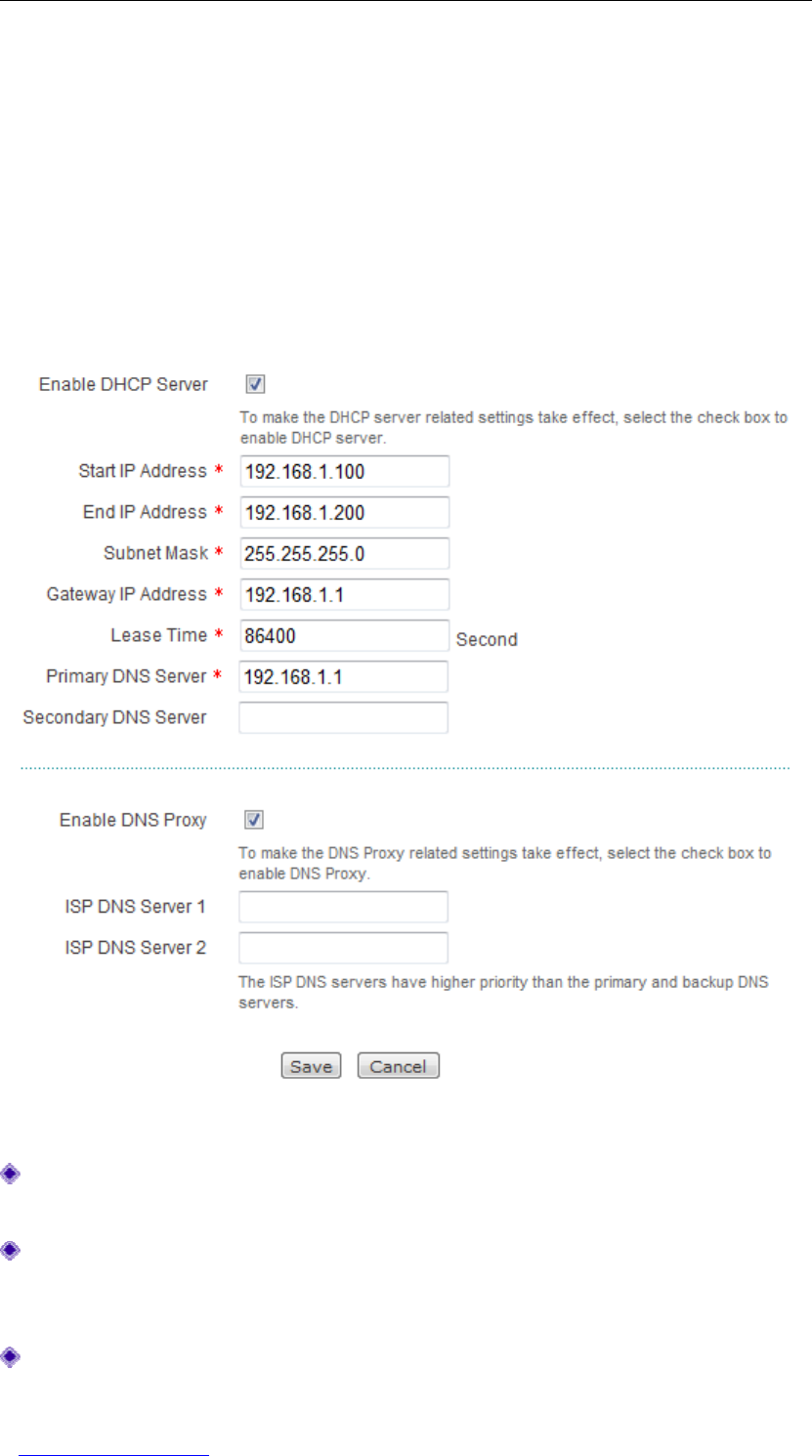
UTT Technologies Chapter 5 Network
http://www.uttglobal.com Page 59
5.4 DHCP Server
This section describes the Network > DHCP Server page, which includes DHCP server
settings, static DHCP and DHCP client list.
5.4.1 DHCP Server Settings
Figure 5- 17 DHCP Server Settings
Enable DHCP Server: It allows you to enable or disable DHCP server. If you want to
enable DHCP server on the Wireless Router, please select this check box.
Start IP Address: It specifies the first IP address assigned by the DHCP server. In
most cases, this address must be on the same subnet as the Wireless Router’s LAN
IP address.
End IP Address: It specifies the last IP address assigned by the DHCP server. In
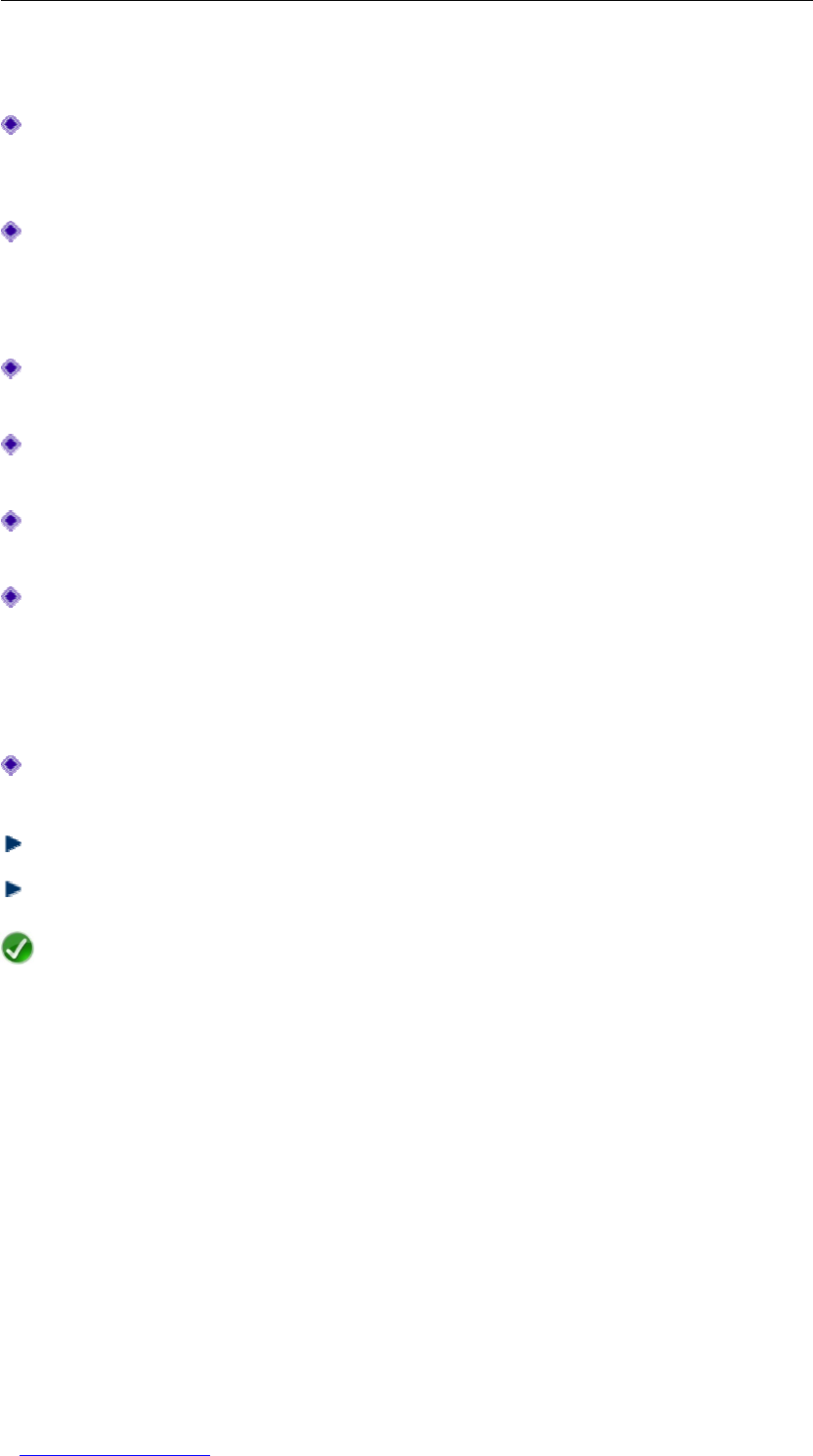
UTT Technologies Chapter 5 Network
http://www.uttglobal.com Page 60
most cases, this address must be on the same subnet as the Wireless Router’s LAN
IP address.
Subnet Mask: It specifies the subnet mask of the IP addresses assigned by the
DHCP server. In most cases, this subnet mask must be identical to the Wireless
Router’s LAN subnet mask.
Default Gateway: It specifies the IP address of the default gateway for a DHCP client.
In most cases, this address must be identical to the Wireless Router’s LAN IP
address, that is, the Wireless Router is used as the default gateway for the local
computers.
Lease Time: It specifies the length of time (in seconds) during which a DHCP client
can use an assigned IP address.
Primary DNS Server: It specifies the IP address of the primary DNS server that is
available to a DHCP client.
Secondary DNS Server: It specifies the IP address of the secondary DNS server
that is available to a DHCP client.
Enable DNS Proxy: It allows you to enable or disable DNS proxy. If you want to
enable DNS proxy on the Wireless Router, please select this check box. When acting
as a DNS proxy, the Wireless Router listens for incoming DNS requests on the LAN
interface, relays the DNS requests to the current public DNS servers, and replies as a
DNS resolver to the requesting local computers.
ISP DNS Server 1 and ISP DNS Server 2: They specify the IP addresses of the ISP
DNS servers.
Save: Click to save your changes.
Cancel: Click to revert to the last saved settings.
Note
1. If you want a local computer to obtain an IP address and other TCP/IP parameters
from the Wireless Router’s built-in DHCP server, please configure the computer to
obtain an IP address automatically.
2. If the DNS proxy is enabled on the Wireless Router, in order to use DNS proxy
service normally, you need to set the local computers’ primary DNS server to the
Wireless Router’s LAN IP address. In addition, if the DHCP server is also enabled on
the Wireless Router, the Wireless Router will assign its LAN IP address as the
primary DNS server address to the local computers automatically.
3. To ensure that the DNS proxy works well, you must at least specify the primary DNS
server provided by your ISP on the Wireless Router.
4. The Wireless Router can act as a DNS proxy server to all local computers. This
greatly simplifies configuration of your local computers. For example, there is a LAN
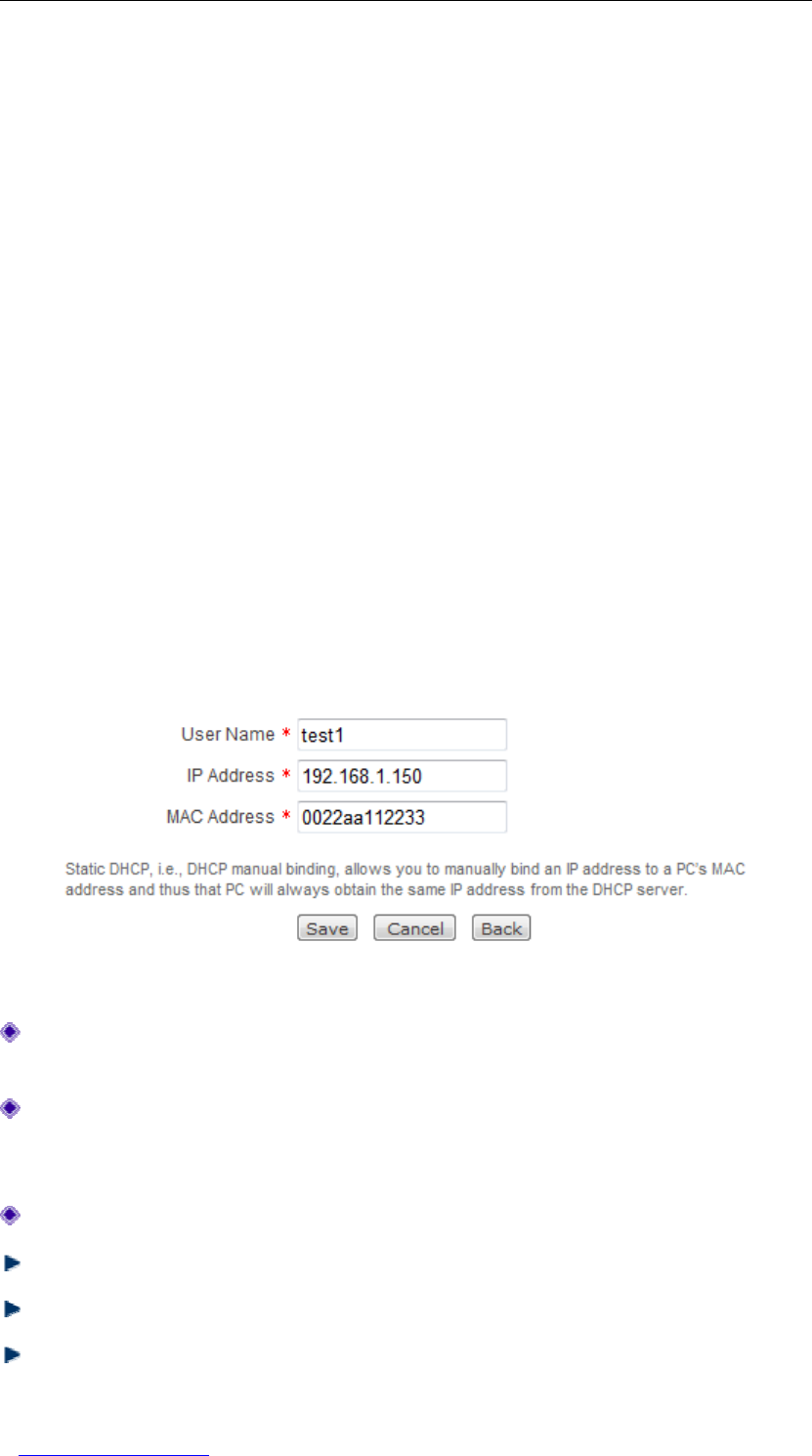
UTT Technologies Chapter 5 Network
http://www.uttglobal.com Page 61
DNS proxy server on which a DNS proxy software is installed (e.g., Wingate), and the
local computers use this server as the primary DNS server. Now, the Wireless Router
will be used as a new gateway for the local computers. In this case, in order to use
DNS proxy service normally, the administrator only need to change the Wireless
Router’s LAN IP address to the old proxy DNS server’s IP address, and enable DNS
proxy on the Wireless Router, without having to change each computer.
5.4.2 Static DHCP
The Wireless Router offers static DHCP feature which allows you to manually bind an IP
address to a computer’s MAC address and thus that computer will always obtain the same
IP address from the DHCP server. More specifically, each time the specified computer
boots and requests its IP address from the Wireless Router’s DHCP server, the DHCP
server will recognize the computer’s MAC address and always assign the reserved IP
address to it.
5.4.2.1 Static DHCP Settings
Figure 5- 18 Static DHCP Settings
User Name: It specifies a unique user name of the DHCP client that wants to be
assigned a static IP address.
IP Address: It specifies the IP address that you want to reserve for the DHCP client.
It must be a valid IP address within the range of IP addresses assigned by the DHCP
server.
MAC Address: It specifies the MAC address of the DHCP client.
Save: Click to save your changes.
Cancel: Click to revert to the last saved settings.
Back: ClicktogobacktotheNetwork > DHCP Server > Static DHCP page.
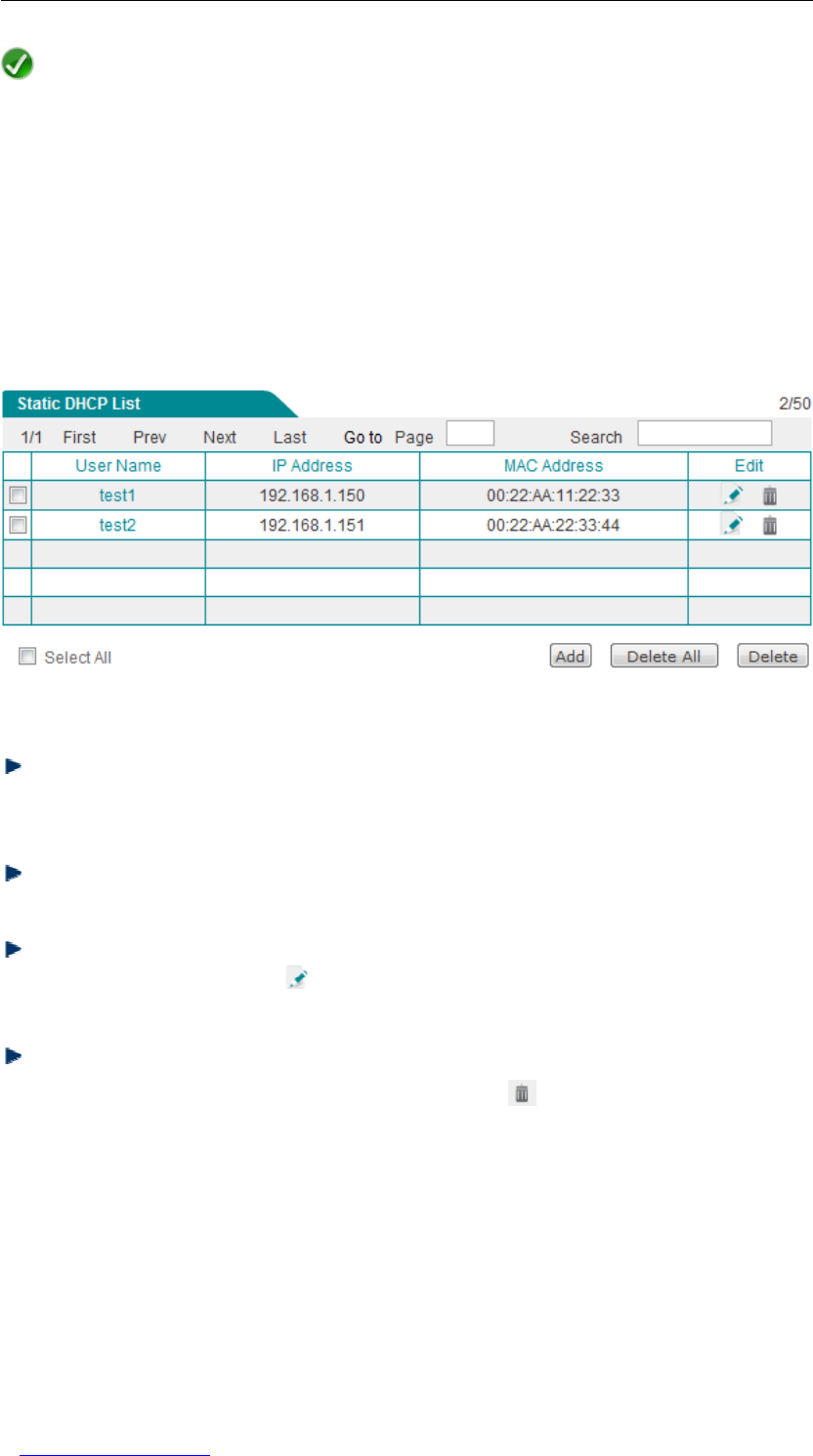
UTT Technologies Chapter 5 Network
http://www.uttglobal.com Page 62
Note
1. The reserved IP address must be a valid IP address within the range of IP addresses
assigned by the DHCP server.
2. After you have added the static DHCP entry successfully, the Wireless Router will
always assign the reserved IP address to the specified computer.
5.4.2.2 Static DHCP List
Figure 5- 19 Static DHCP List
Add a Static DHCP Entry: To add a new static DHCP entry, first click the Add button
to go to the Static DHCP Settings page, next configure it, lastly click the Save
button.
View Static DHCP Entry(s): When you have configured one or more static DHCP
entries, you can view them in the Static DHCP List.
Modify a Static DHCP Entry: To modify a configured static DHCP entry, click its
User Name hyperlink or icon, the related information will be displayed in the
Static DHCP Settings page. Then modify it, and click the Save button.
Delete Static DHCP Entry(s): There are three ways to delete static DHCP entry(s).
1. To delete a static DHCP entry, directly click its icon.
2. To delete more than one static DHCP entry at a time, select the leftmost check
boxes of the static DHCP entries that you want to delete, and then click the
Delete button.
3. To delete all the static DHCP entries at a time, directly click the Delete All button.
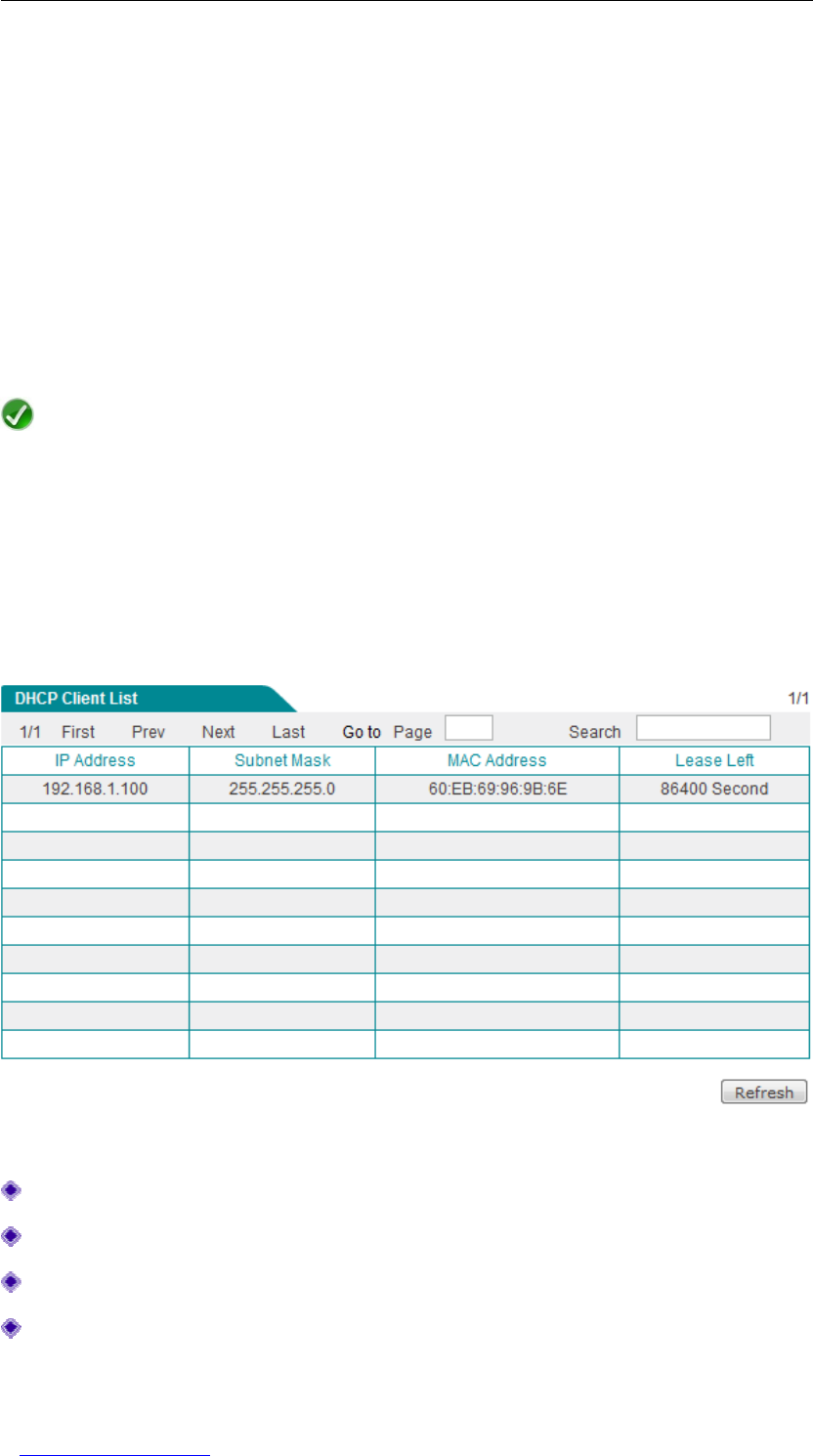
UTT Technologies Chapter 5 Network
http://www.uttglobal.com Page 63
5.4.2.3 How to Add Static DHCP Entries
To add one or more static DHCP entries, follow these steps:
Step 1 Go to the Network > DHCP Server > Static DHCP page.
Step 2 Click the Add button to go to the Static DHCP Settings page, and then specify
the User Name,IP Address and MAC Address,lastlyclicktheSave button.
Step 3 Now you can view the static DHCP entry in the Static DHCP List.
Step 4 To add another static DHCP entry, please repeat the above steps.
Note
If you want to delete static DHCP entry(s), please follow the ways described in
Section 5.4.2.2 Static DHCP List.
5.4.3 DHCP Client List
Figure 5-20 DHCP Client List
IP Address: It displays the IP address assigned to the DHCP client.
Subnet Mask: It displays the subnet mask of the current IP address.
MAC Address: It displays the MAC address of the DHCP client.
Lease Left: It displays the time remaining (in seconds) until the current IP address
lease expires.

UTT Technologies Chapter 5 Network
http://www.uttglobal.com Page 64
Refresh: Click to view the latest information in the list.
Note
The DHCP Client List only displays the DHCP clients with dynamically assigned IP
addresses. It doesn’t display the DHCP clients specified by the static DHCP entries.

UTT Technologies Chapter 5 Network
http://www.uttglobal.com Page 65
5.4.4 Configuration Example for DHCP
1. Requirements
In this example, the Wireless Router acts as a DHCP server to dynamically assign the IP
addresses to the clients that reside on the same subnet. The Wireless Router’s LAN IP
address is 192.168.1.1/24. The start IP address of the DHCP address pool is
192.168.1.11, and the number of addresses is 100.
Besides, there are two computers that must always have the same IP address: one’s MAC
address is 00:21:85:9B:45:46 and IP address is 192.168.1.15, the other’s MAC address is
00:1f:3c:0f:07:f4 and IP address is 192.168.1.16.
2. Configuration Steps
Step 1 Go to the Network > DHCP Server > DHCP Server Settings page.
Step 2 As shown in the following figure, select the Enable DHCP Server check box,
and enter 192.168.1.11 and 192.168.1.110 in the Start IP Address and End IP
Address text boxes respectively. Leave the other parameters at their default
values. Then click the Save button to save the settings.
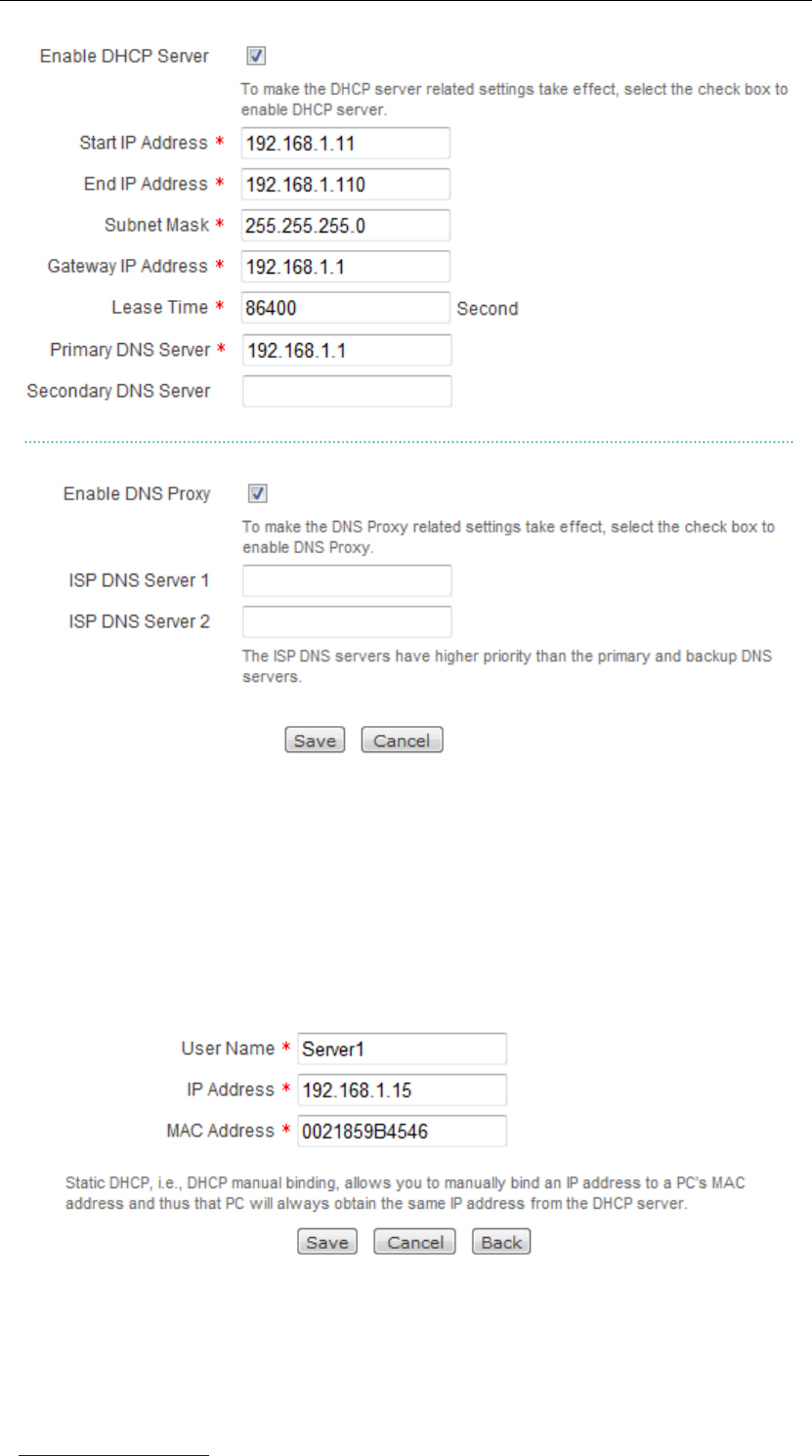
UTT Technologies Chapter 5 Network
http://www.uttglobal.com Page 66
Figure 5-21 DHCP Server Settings - Example
Step 3 Go to the Network > DHCP Server > Static DHCP page.
Step 4 Add the static DHCP entry 1: Click the Add button to go to the Static DHCP
Settings page (see Figure 5- 22), enter Server1 in the User Name text box,
192.168.1.15 in the IP Address text box, and 0021859B4546 in the MAC
Address text box, and then click the Save button.
Figure 5- 22 Adding the Static DHCP Entry 1 - Example
Step 5 Add the static DHCP entry 2: Click the Add button to go to the Static DHCP
Settings page (see Figure 5- 23), enter Server2 in the User Name text box,
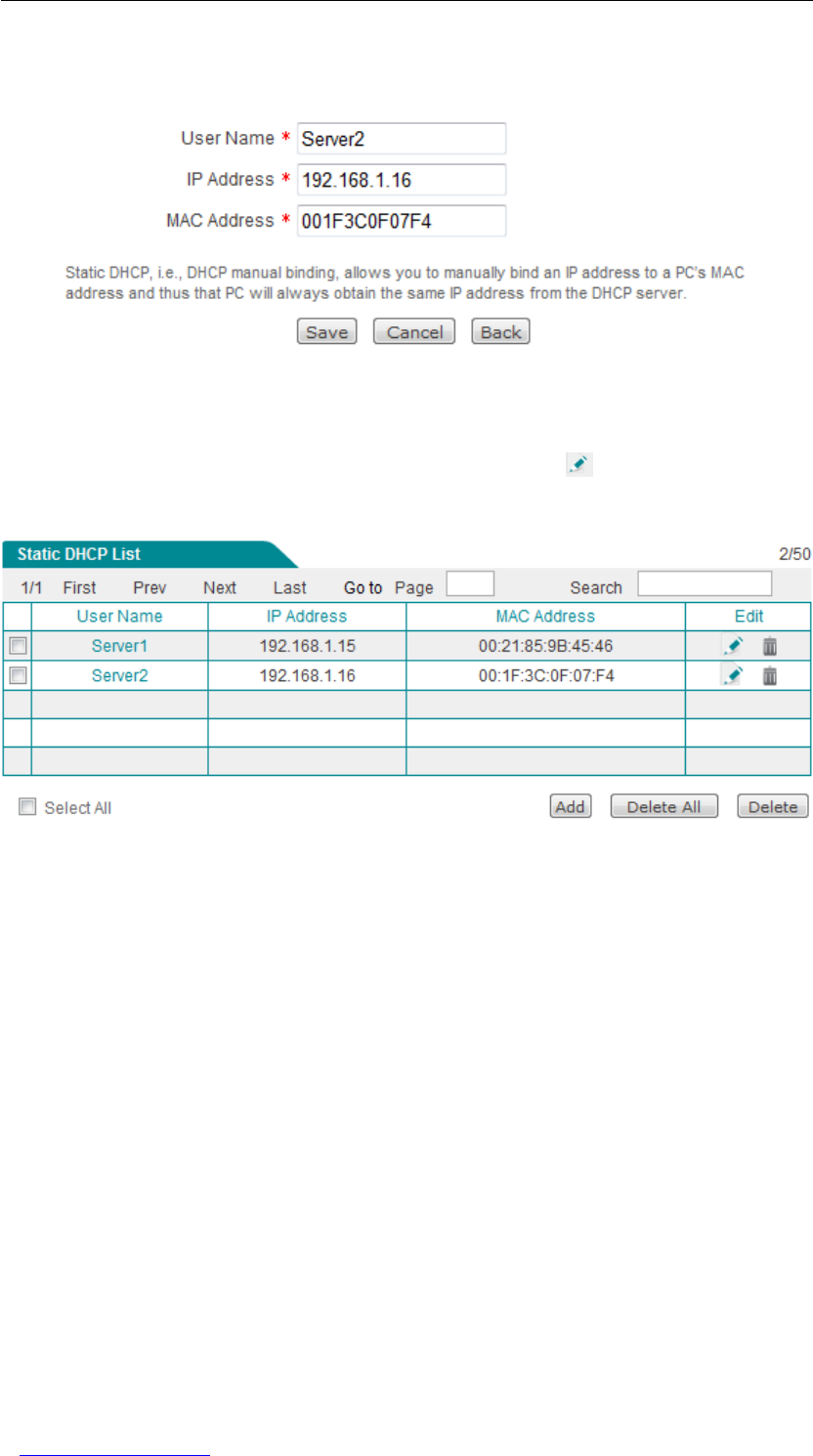
UTT Technologies Chapter 5 Network
http://www.uttglobal.com Page 67
192.168.1.16 in the IP Address text box, and 001f3c0f07f4 in the MAC
Address text box, and then click the Save button.
Figure 5- 23 Adding the Static DHCP Entry 2 - Example
Now you have configured the two static DHCP entries. You can view them in the Static
DHCP List (see Figure 5- 24), and you can directly click the icon to modify either of
them if desired.
Figure 5-24 Static DHCP List - Example

UTT Technologies Chapter 5 Network
http://www.uttglobal.com Page 68
5.5 DDNS
This section describes the Network > DDNS page. In this page, you can not only
configure DDNS parameters, but also view and update DDNS status.
5.5.1 Introduction to DDNS
Dynamic Domain Name Service (DDNS) is a service used to map a domain name which
never changes to a dynamic IP address which can change quite often. For example, if you
have applied for a PPPoE connection with a dynamically assigned IP address from the
ISP’s PPPoE server, you can use DDNS to allow the external computers to access the
Wireless Router by a constant domain name.
In order to use DDNS service, you should apply for a DDNS account from a DDNS service
provider. Each DDNS provider offers its own specific network services. The DDNS service
provider reserves the right to change, suspend or terminate your use of some or all
network services at any time for any reason. The DDNS service providers supported by
UTT Technologies Co., Ltd. currently provide free DDNS services, but they may charge
for the DDNS services in the future. In this case, UTT Technologies Co., Ltd. will notify
you as soon as possible; if you refuse to pay for the services, you will no longer be able to
use them. During the free phase, UTT Technologies Co., Ltd. does not guarantee that the
DDNS services can meet your requirements and will be uninterrupted, and UTT does not
guarantee the timeliness, security and accuracy of the services.
So far, UTT Technologies Co., Ltd. supports only two DDNS service providers:
iplink.com.cn and 3322.org. It will successively support other DDNS service providers in
the future.
5.5.2 Apply for a DDNS Account
Please login to http://www.3322.org or http://www.utt.com.cn/ddns to apply for a fully
qualified domain name (FQDN). This section describes how to apply for a FQDN with
suffix of 3322.org from http://www.3322.org.
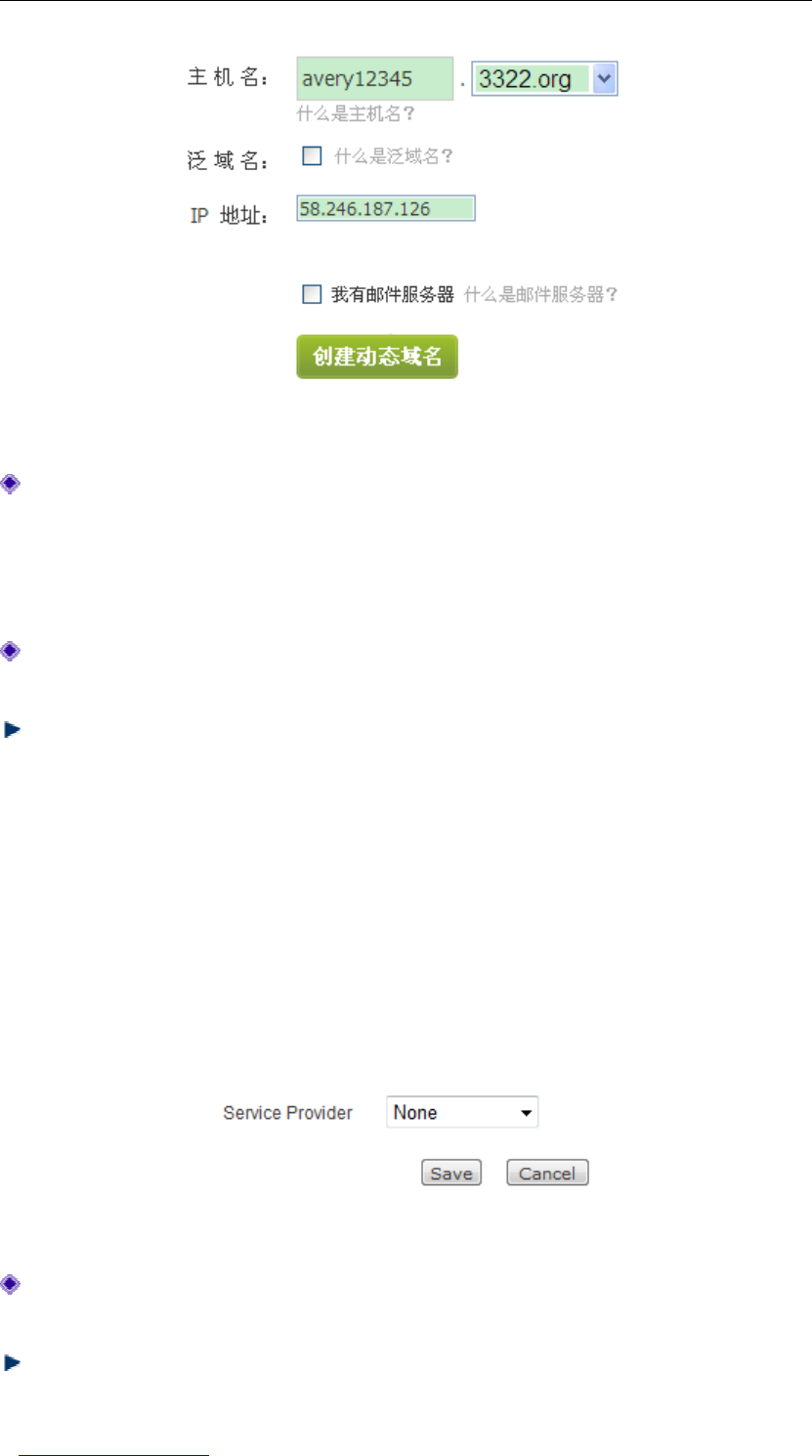
UTT Technologies Chapter 5 Network
http://www.uttglobal.com Page 69
Figure 5- 25 Apply for a DDNS Account from 3322.org
Host Name: It specifies a unique host name of the Wireless Router. The suffix of
3322.org will be appended to the host name to create a fully qualified domain name
(FQDN) for the Wireless Router. For example, if the Wireless Router’s host name is
test,thenitsFQDNistest.3322.org; and it allows you to use test.3322.org to
access the Wireless Router.
IP Address: It specifies the IP address mapped to the registered domain name of the
Wireless Router.
Register: Click to register the domain name.
5.5.3 DDNS Settings
5.5.3.1 Disabling DDNS Service
If you want to disable DDNS service, please leave the Service Provider at its default
value of None, see Figure 5- 26.
Figure 5- 26 Disabling DDNS Service
Service Provider: It specifies the DDNS service provider who offers services to the
Wireless Router. Here please select None to disable DDNS service.
Save: Click to save your changes.
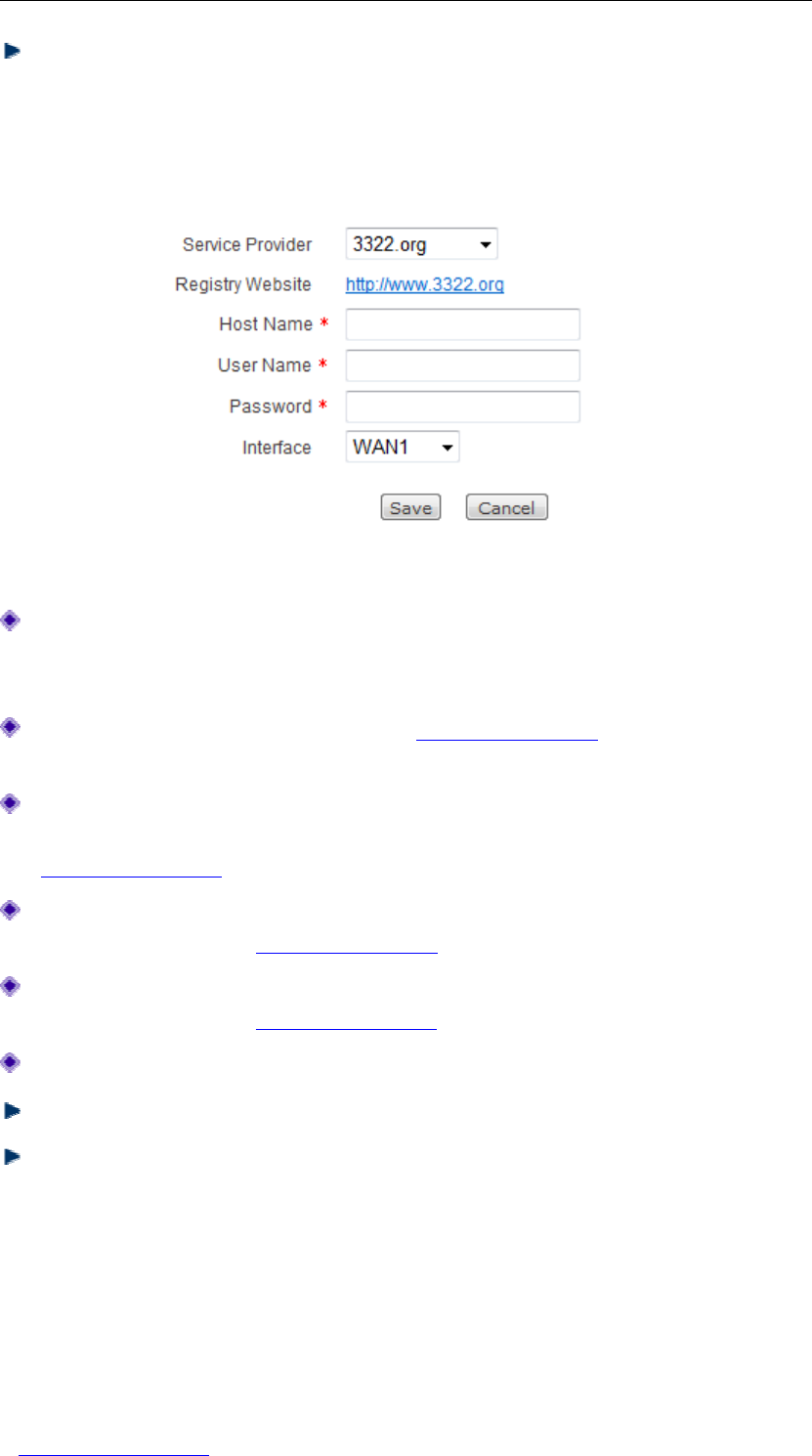
UTT Technologies Chapter 5 Network
http://www.uttglobal.com Page 70
Cancel: Click to revert to the last saved settings.
5.5.3.2 DDNS Service Offered by 3322.org
Figure 5-27 DDNS Settings Related to 3322.org
Service Provider: It specifies the DDNS service provider who offers services to the
Wireless Router. Now the Wireless Router only supports two DDNS service providers:
iplink.com.cn and 3322.org. Here please select 3322.org.
Registry Website: It allows you to click http://www.3322.org to go to this website to
register a DDNS account for the Wireless Router.
Host Name: It specifies the host name of the Wireless Router. It must be identical to
the host name that you entered when registering the DDNS account on the website
http://www.3322.org.
User Name: It specifies the user name that you entered when registering your user
account on the website http://www.3322.org.
Password: It specifies the password that you entered when registering your user
account on the website http://www.3322.org.
Interface: It specifies the interface on which DDNS service is applied.
Save: Click to save your changes.
Cancel: Click to revert to the last saved settings.
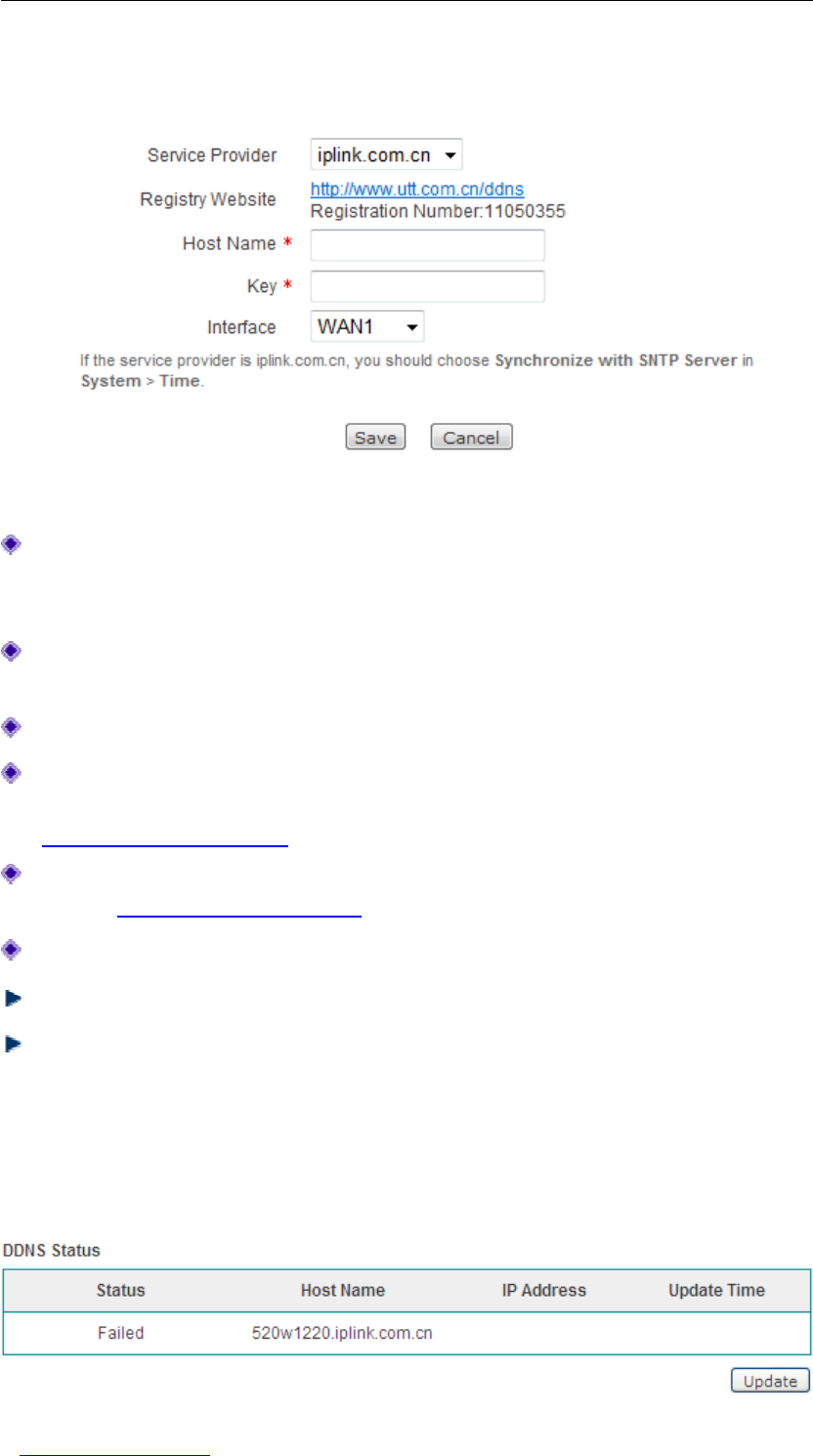
UTT Technologies Chapter 5 Network
http://www.uttglobal.com Page 71
5.5.3.3 DDNS Service Offered by IPLink
Figure 5-28 DDNS Settings Related to iplink.com.cn
Service Provider: It specifies the DDNS service provider who offers services to the
Wireless Router. Now the Wireless Router only supports two DDNS service providers:
iplink.com.cn and 3322.org. Here please select iplink.com.cn.
Registry Website: Itallowsyoutoclick togotothiswebsitetoregisteraDDNS
account for the Wireless Router.
Registration Number: It specifies the registration number of the Wireless Router.
Host Name: It specifies the host name of the Wireless Router. It must be identical to
the host name that you entered when registering the DDNS account on the website
http://www.utt.com.cn/ddns.
Key: It specifies the key that you got when registering the DDNS account on the
website http://www.utt.com.cn/ddns.
Interface: It specifies the interface on which DDNS service is applied.
Save: Click to save your changes.
Cancel: Click to revert to the last saved settings.
5.5.4 DDNS Status
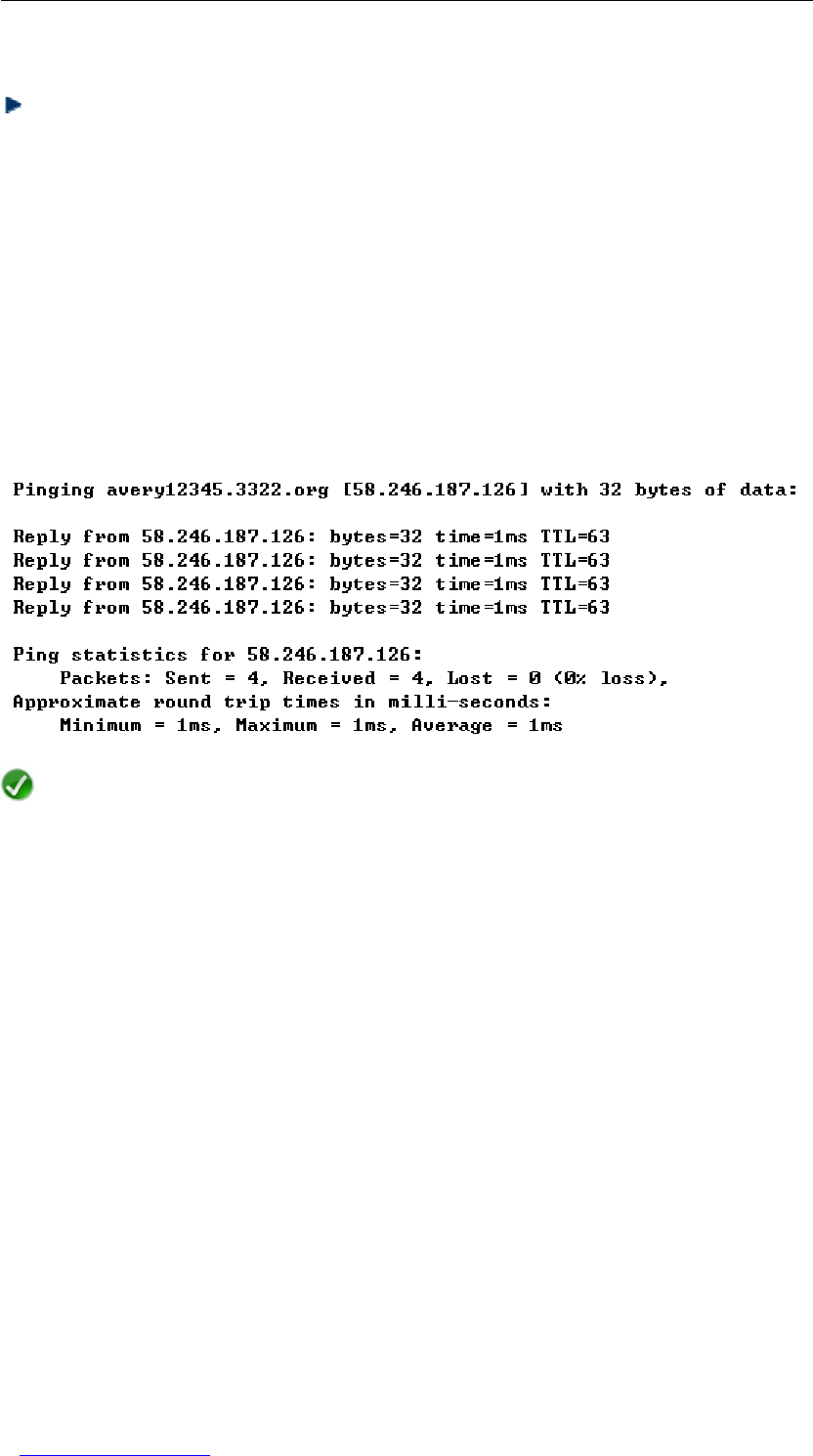
UTT Technologies Chapter 5 Network
http://www.uttglobal.com Page 72
Figure 5- 29 DDNS Status
Update: Click to update DDNS status.
5.5.5 DDNS Verification
To verify whether DDNS is updated successfully, you can use the ping command at the
command prompt on the PC, for example: ping avery12345.3322.org
If the displayed page is similar to the screenshot below: the domain name is resolved to
an IP address successfully (58.246.187.126 in this example), DDNS is updated
successfully.
Note
1. Only when the WAN interface IP address is a public IP address, the Internet users
can use its mapped domain name to access the Wireless Router normally.
2. DDNS feature can help you implement VPN tunnels using dynamic IP addresses on
the Wireless Router.
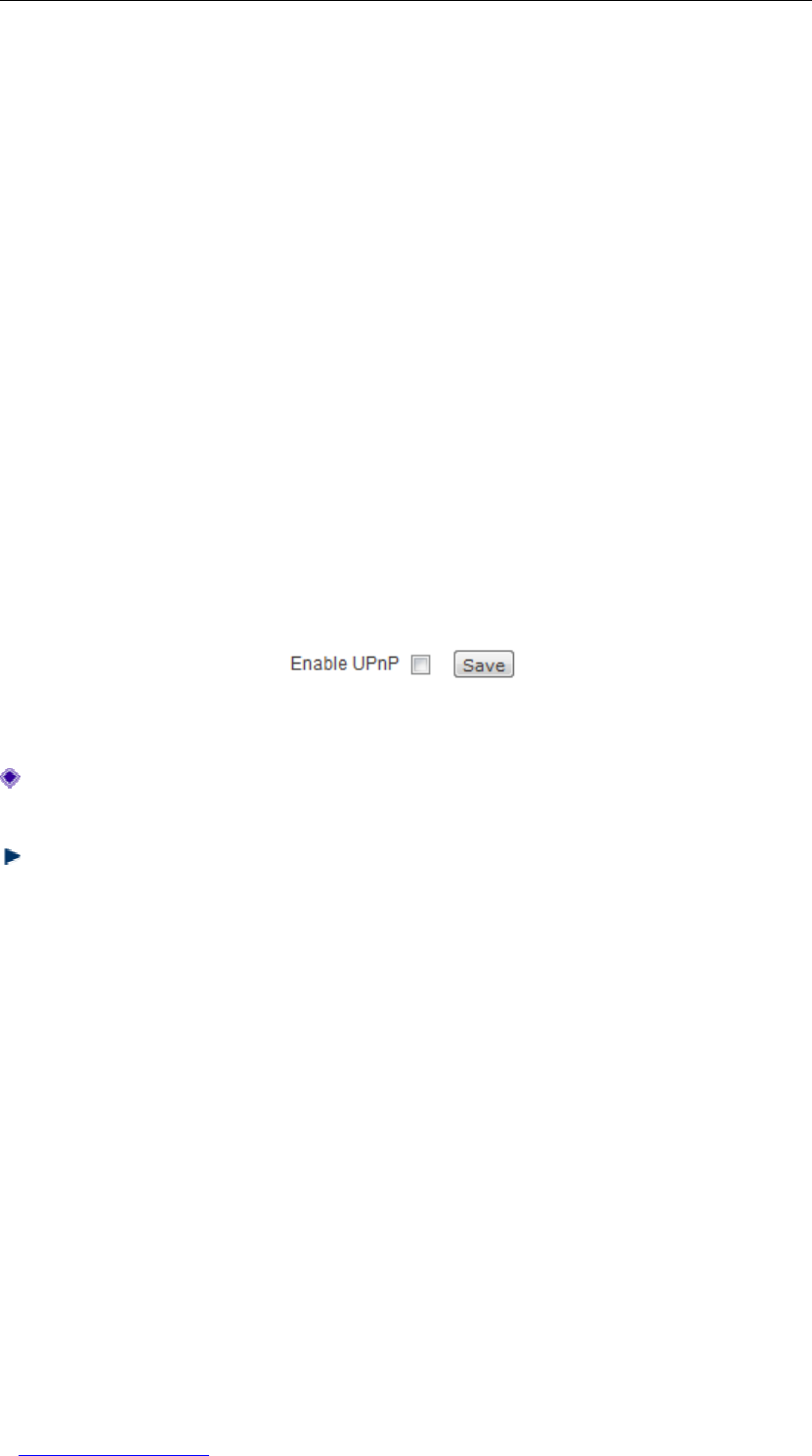
UTT Technologies Chapter 5 Network
http://www.uttglobal.com Page 73
5.6 UPnP
This section describes the Network > UPnP page.
The Universal Plug and Play (UPnP) is architecture that implements zero configuration
networking, that is, it provides automatic IP configuration and dynamic discovery of the
UPnP compatible devices from various vendors. A UPnP compatible device can
dynamically join a network and work properly.
When you enable UPnP, the Wireless Router allows any local UPnP-enabled device to
perform a variety of actions, including retrieving the public IP address, enumerating
existing port mappings, and adding or removing port mappings. By adding a port mapping,
a UPnP-enabled device opens the related service ports on the Wireless Router to allow
outside computers to access.
5.6.1 Enable UPnP
Figure 5- 30 Enable UPnP
Enable UPnP: It allows you to enable or disable UPnP. If you want to enable UPnP,
please select this check box.
Save: Click to save your changes.
5.6.2 UPnP Port Forwarding List
The UPnP Port Forwarding List lists all the port forwarding entries established using
UPnP, see the following figure.
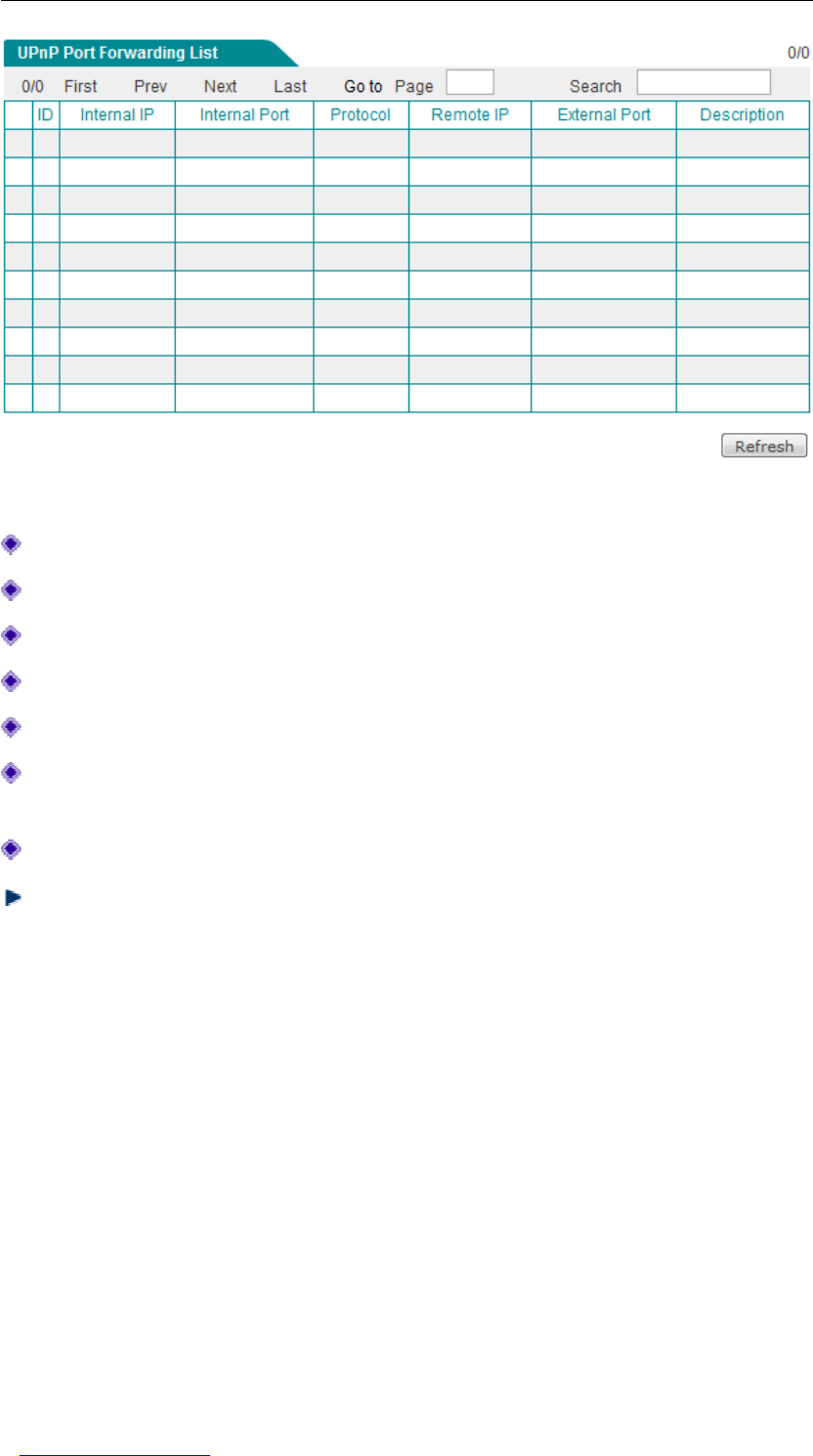
UTT Technologies Chapter 5 Network
http://www.uttglobal.com Page 74
Figure 5-31 UPnP Port Forwarding List
ID: It is used to identify each UPnP port forwarding entry in the list.
Internal IP: It displays the IP address of the local computer.
Internal Port: It displays the service port provided by the local computer.
Protocol: It displays the transport protocol used by the service.
Remote IP: It displays the IP address of the remote computer.
External Port: It displays the external port of the UPnP port forwarding, which is
opened for outside user to access.
Description: It displays the description of the UPnP port forwarding entry.
Refresh: Click to view the latest information in the list.

UTT Technologies Chapter 6 Wireless
http://www.uttglobal.com Page 75
Chapter 6 Wireless
This chapter describes how to configure and use the wireless features of the Wireless
Router, which include: basic wireless settings, wireless security settings, wireless MAC
address filtering, and advanced wireless settings; and how to view the status of the
wireless clients.
6.1 Basic Wireless Settings
This section describes the Wireless > Basic page. In this page, you can configure the
basic wireless settings of the Wireless Router, which include: enable or disable wireless
function, operation mode, SSID, wireless mode, channel, channel width, enable or disable
SSID broadcast, and so on.
The Wireless Router supports multiple operation modes: AP mode, AP Client mode, and
three WDS modes including Repeater mode, Bridge mode and Lazy mode. The following
sections describe the basic wireless settings under each operation mode.
Note
1. The Wireless Router functions differently under each operation mode. Please select
the one that best meets your needs.
2. After you modify the wireless parameters and save the changes, the wireless module
will automatically restart. This will disconnect all wireless connections, but won’t affect
the wired connections.
6.1.1 AP Mode
If you want the Wireless Router to operate in AP mode, please select AP Mode from the
Opeartion Mode drop-down list, see Figure 6-1. In this mode, the Wireless Router can
connect to other wireless network devices in AP Client mode, and at at same time it can
provide connectivity for wireless clients.
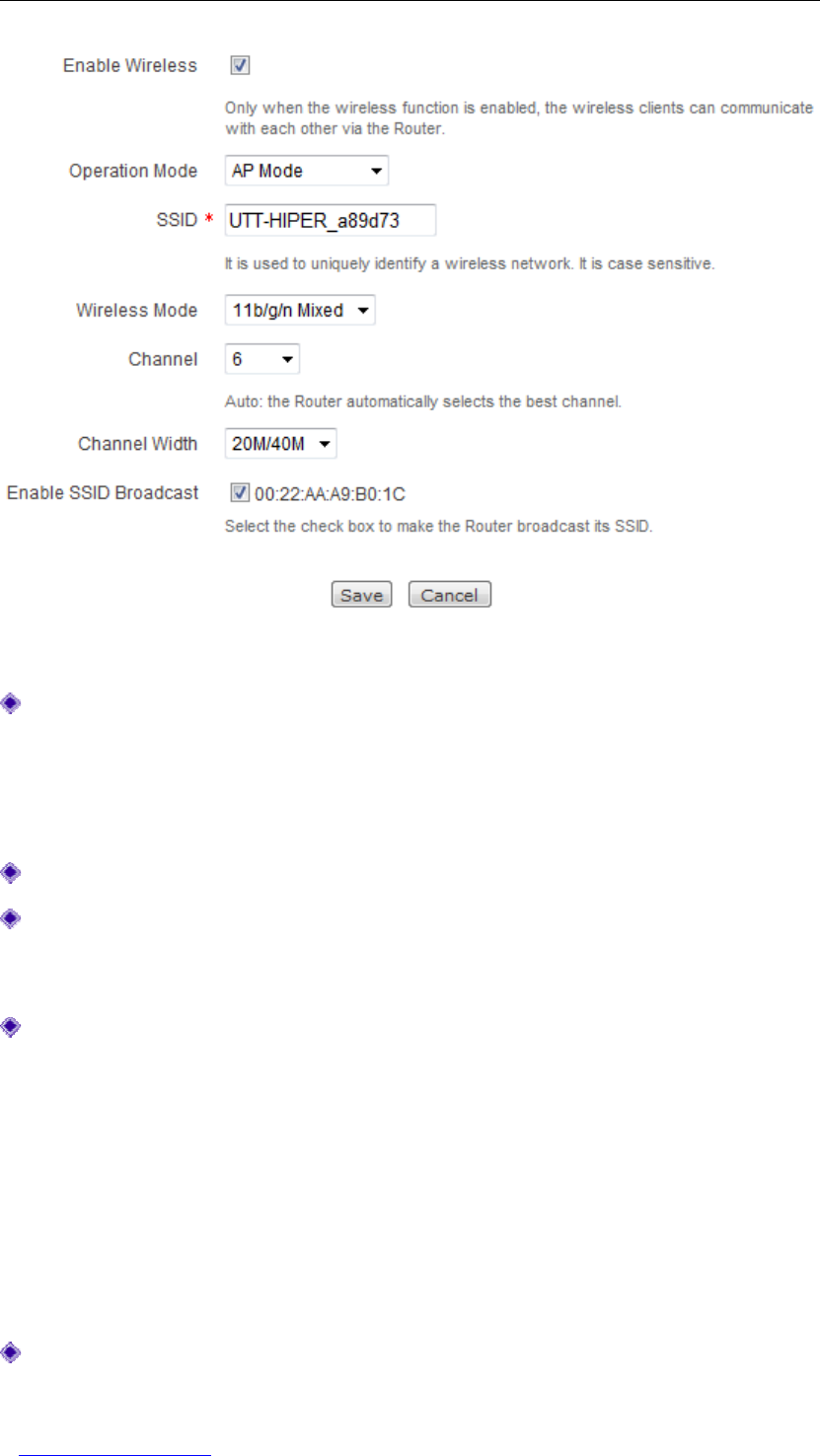
UTT Technologies Chapter 6 Wireless
http://www.uttglobal.com Page 76
Figure 6- 1 Basic Wireless Settings - AP Mode
Enable Wireless: It allows you to enable or disable wireless function. If you select
the check box to enable wireless function, wireless clients can connect to the
Wireless Router to access the Internet, commnuicate with each other via the Wireless
Router, and access the wired network connected to the Wireless Router. Else, the
Wireless Router accepts only wired computers and other wired network devices.
Operation Mode: Here please select AP Mode.
SSID: The SSID (Service Set Identification) is also known as the wireless network
name, which is used to uniquely identify a wireless network. It is case sensitive. It
must be identical for all wireless devices in the wireless network.
Wireless Mode: It specifies the wireless standards running on your wireless network.
The options are 11g Only,11n Only and 11b/g/n Mixed.
●11g Only: In allows both 802.11g and 802.11n wireless clients to connect to the
Wireless Router at 802.11g data rates with a maximum speed of 54Mbps.
●11n Only: It only allows 802.11n wireless clients to connect to the Wireless
Router at 802.11n data rates with a maximum speed of 300Mbps.
●11b/g/n Mixed: It allows 802.11b, 802.11g and 802.11n wireless clients to
connect to the Wireless Router at their respective data rates. The maximum
speeds are 11Mbps, 54Mbps and 300Mbps respectively.
Channel: It specifies the wireless channel used between the Wireless Router and
wireless clients. The valid range is 1 through 11. You can also select Auto to let the

UTT Technologies Chapter 6 Wireless
http://www.uttglobal.com Page 77
Wireless Router automatically select the best channel. If there are multiple wireless
routers in your area, please make sure that their channels don’t interfere with each
other.
Channel Width: It specifies the range of frequecies used by your wireless network.
The options are 20/40M and 20M. Note that this parameter can only act on 802.11n
wireless clients. 802.11b and 802.11g wireless clients can only use 20MHz channel.
●20M/40M: If you select this option, 802.11n wireless clients will negotiate the
channel width with the Wireless Router.
●20M: It you select this option, 802.11n wireless clients will use 20MHz channel.
Enable SSID Broadcast: It allows you to enable or disable SSID broadcast. If you
select the check box to enable this feaute, the Wireless Router will periodically
broadcast its SSID, so that wireless clients can automatically find it to connect to the
Wireless Router and join the wireless network identified by the SSID. However, this
feature also makes it easier for hackers to know your SSID and break into your
WLAN. It is suggested that you disable this feature to improve security of your WLAN.
In this case, you need to manually configure the right SSID for your wireless clients.
Save: Click to save your changes.
Cancel: Click to revert to the last saved settings.
6.1.2 APClient Mode
If you want the Wireless Router to operate in APClient mode, please select APClient
Mode from the Opeartion Mode drop-down list, see Figure 6- 2. In this mode, the
Wireless Router can connect to a remote network device in AP mode, and at same time it
can provide connectivity for wireless clients.
If you configure the APClient Internet connection in the Start > Setup Wizard, the system
will automatically choose APClient Mode as the Operation Mode.
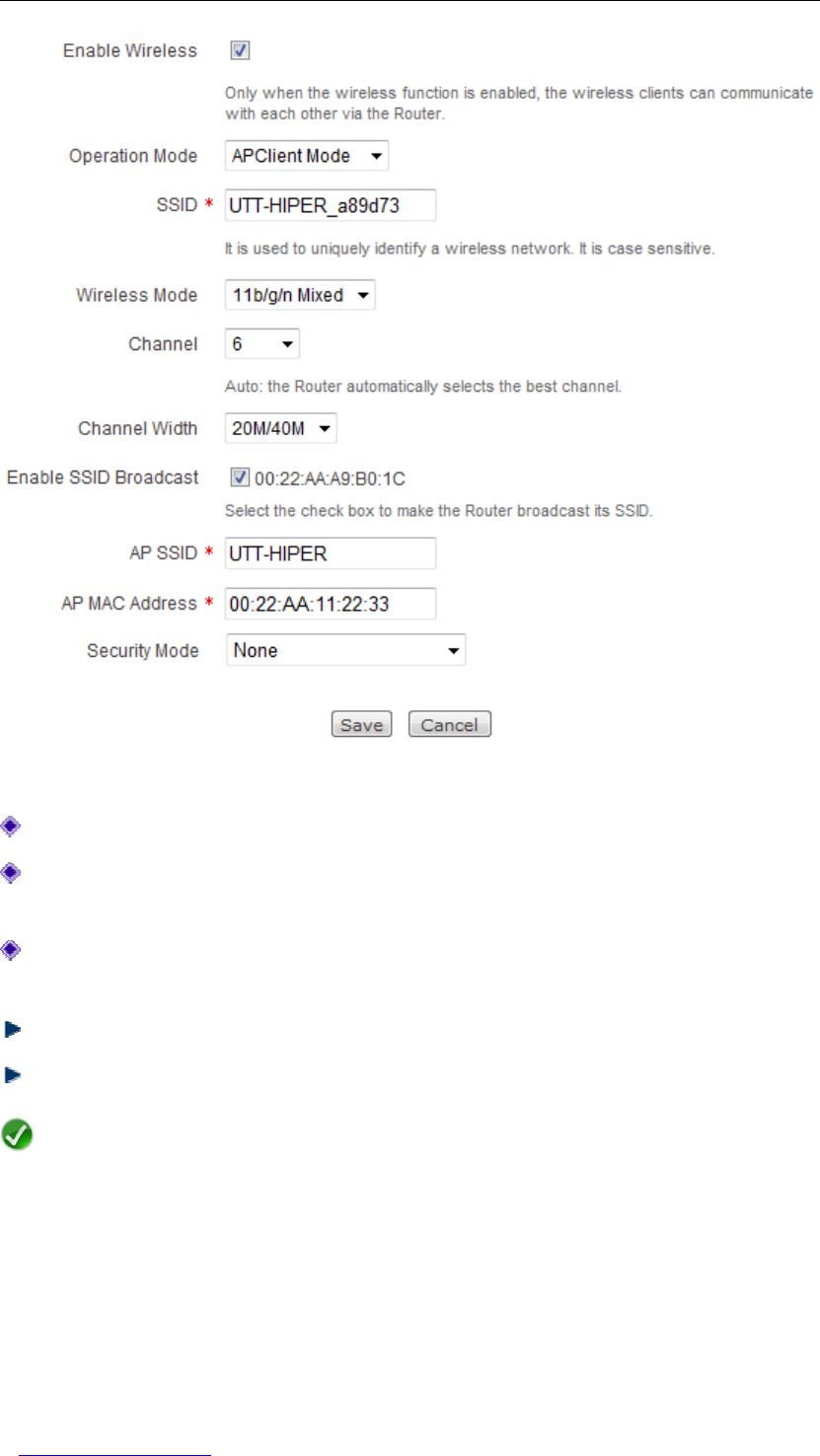
UTT Technologies Chapter 6 Wireless
http://www.uttglobal.com Page 78
Figure 6- 2 Basic Wireless Settings - APClient Mode
Operation Mode: Here please select APClient Mode.
Enable Wireless,SSID,Wireless Mode,Channel,Channel Width,andEnable
SSID Broadcast: Refer to Section 6.1.1 AP Mode for detailed information.
AP SSID,AP MAC Address and Security Mode: Refer to Section 3.3.3.3 APClient
Internet Connection Settings for detailed information.
Save: Click to save your changes.
Cancel: Click to revert to the last saved settings.
Note
In APClient Mode, the Securtiy Mode,Channel and Channel Width configured on
the Wireless Router must match those on the remote AP. Otherwise, the Wirelesss
Router is unable to connect to the remote AP.

UTT Technologies Chapter 6 Wireless
http://www.uttglobal.com Page 79
6.1.3 WDS
A Wireless Distribution System (WDS) is a method of interconnecting access points (AP)
in a wireless local area network (WLAN) without requiring that they connect through a
wired backbone. This feature is usually used to extend the range of the wireless network
to reach remote clients.
The Wireless Router can be configured to operate in a WDS mode (Repeater Mode,
Bridge Mode or Lazy Mode) that allows it to forward traffic directly to other wireless
access points, repeaters or routers. Note that the Securtiy Mode,Channel and Channel
Width configured on the Wireless Router must match those on the remote AP, and their
LAN IP addresses must be on the same subnet.
6.1.3.1 Repeater Mode
If you want the Wireless Router to operate in repeater mode, please select Repeater
Mode from the Opeartion Mode drop-down list, see Figure 6- 3. In this mode, the
Wireless Router can connect to other wireless network devices in bridge mode, repeater
mode or lazy mode, and at the same time it can provide connectivity for wireless clients.
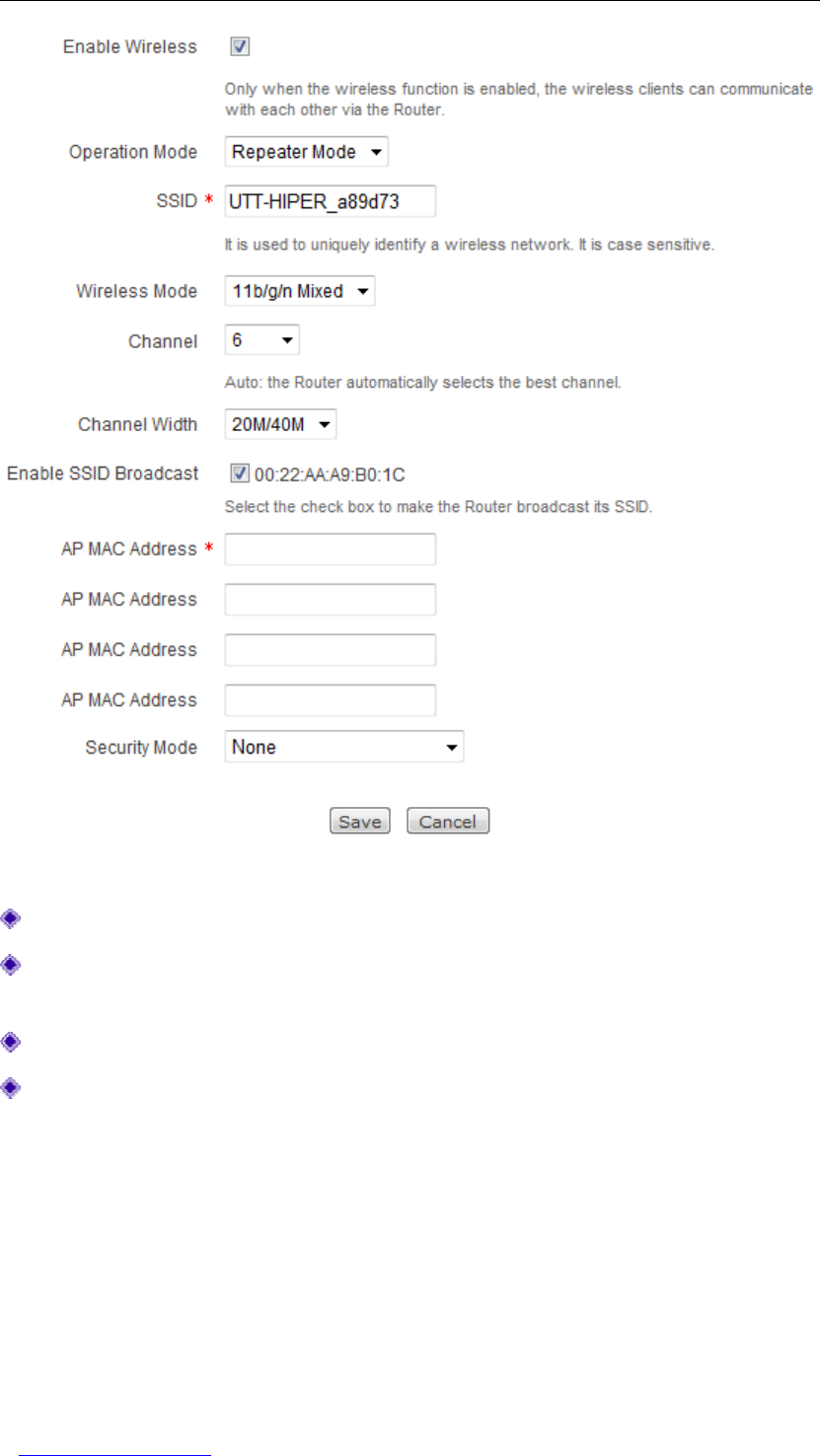
UTT Technologies Chapter 6 Wireless
http://www.uttglobal.com Page 80
Figure 6- 3 Basic Wireless Settings - Repeater Mode
Operation Mode: Here please select Repeater Mode.
Enable Wireless,SSID,Wireless Mode,Channel,Channel Width,andEnable
SSID Broadcast: Refer to Section 6.1.1 AP Mode for detailed information.
AP MAC Address: It specifies the MAC address of the remote AP.
Security Mode: It specifies the security mode to be used by the Wireless Router.
There are four options: None, WEP, TKIP and AES.
●None: It means that no security mode will be used.
●WEP: It means that the Wireless Router will use WEP for data encryption, see
Figure 6- 4.
●TKIP: It means that the Wireless Router will use TKIP for data encryption, see
Figure 6- 6.
●AES: It means that the Wireless Router will use AES for data encryption, see
Figure 6- 7.
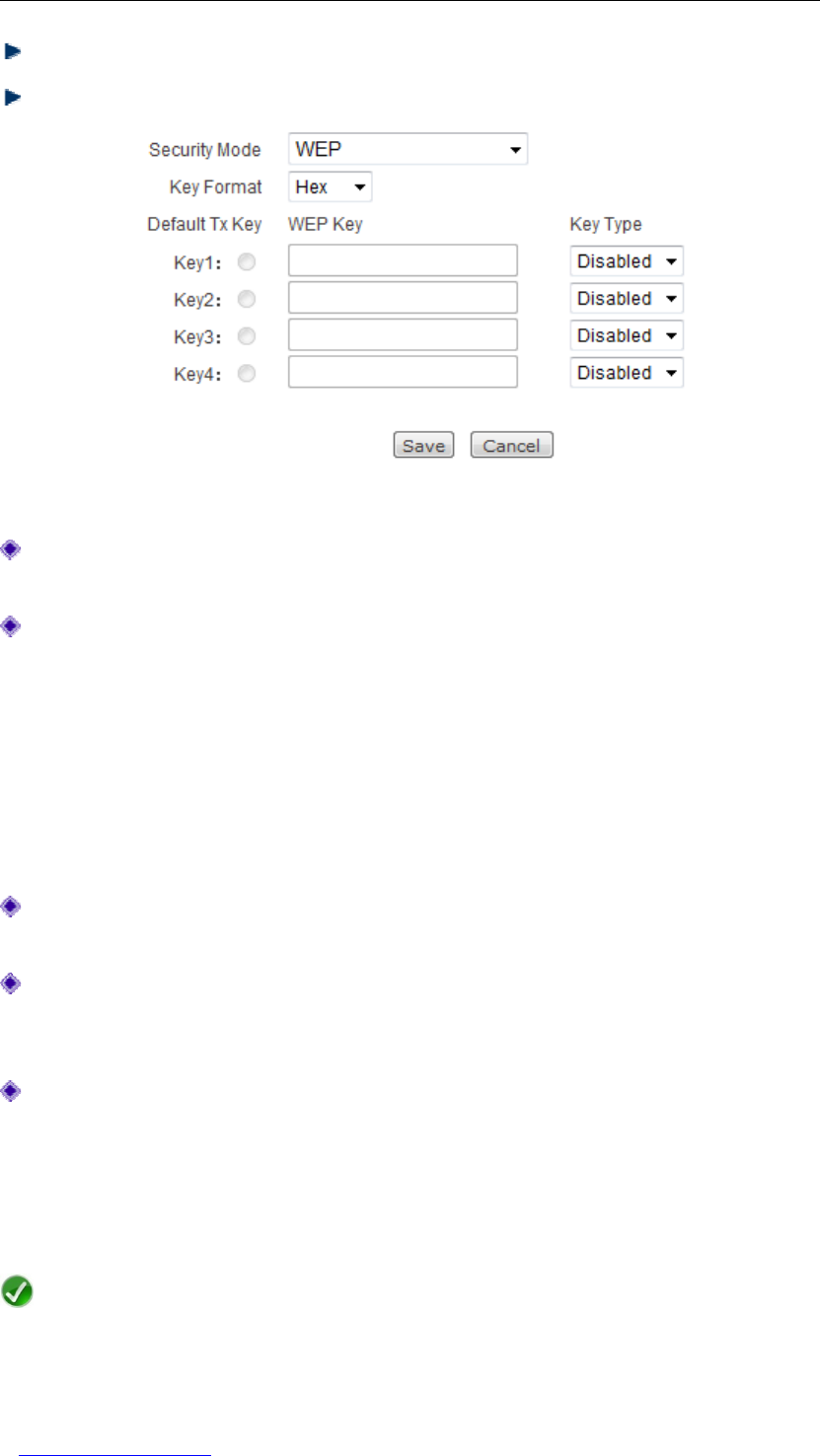
UTT Technologies Chapter 6 Wireless
http://www.uttglobal.com Page 81
Save: Click to save your changes.
Cancel: Click to revert to the last saved settings.
Figure 6- 4 Security Settings - WEP Mode
Security Mode: It specifies the security mode to be used by the Wireless Router.
Here please select WEP.
Key Format: It specifies the format for entering the WEP keys. The options are Hex
and ASCII.
●Hex: Select this option if you want to enter the WEP keys in hexadecimal
format. Hexadecimal digits are a set of characters that includes numbers 0
through 9 and letters A through F (or a through f). Hex WEP keys are case
insensitive.
●ASCII: Select this option if you want to enter the WEP keys in ASCII format.
ASCII WEP keys are case sensitive.
Default Tx Key: It allows you to select one of the WEP keys as the default transmit
key to transmit data. All keys can be used to receive data.
Key Type: It allows you to select the size of each key, and it also allows you to
disable or enable each key. The options are Disabled,64-bit and 128-bit. By default,
Disabled is selected, which means the key is of no effect.
WEP Key: It allows you to enter a key in one of the WEP Key boxes. You can enter
up to four WEP keys. You should enter a key according to the Key Format and Key
Type selected.
●For 64-bit encryption, enter 10 hex characters or 5 ASCII characters.
●For 128-bit encryption, enter 26 hex characters or 13 ASCII characters.
Note
1. The WEP keys on the Wireless Router must match the WEP keys on the remote
wireless device in the same order. That is, WEP Key 1 on the Wireless Router must
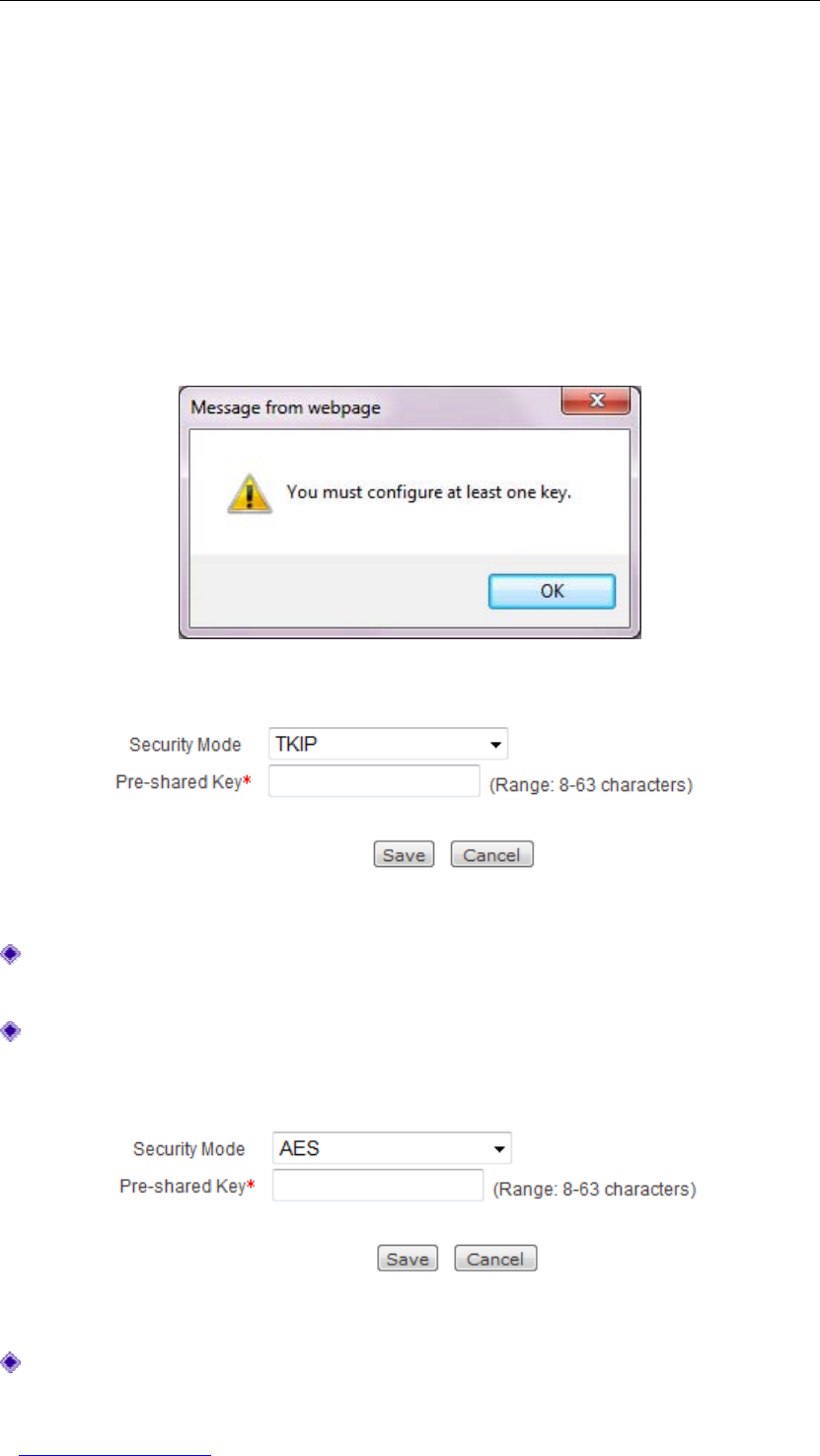
UTT Technologies Chapter 6 Wireless
http://www.uttglobal.com Page 82
match WEP Key 1 on the remote wireless device, and WEP Key 2, 3 and 4 must
match in a similar fashion. However, the two devices can have different Default Tx
Keys as long as the keys are in the same order. For example, the Wireless Router
can use WEP Key 1 as its Default Tx Key, while the remote wireless device can use
WEP Key 3 as its Default Tx Key. The two devices will communicate as long as the
Wireless Router’s WEP Key 1 is identical to the remote wireless device’s WEP Key 1,
and the Wireless Router’s WEP Key 3 is identical to the remote wireless device’s
WEP Key 3.
2. You must configure at least one WEP key. Otherwise, the system will pop up a prompt
dialog box after you click the Save button, see Figure 6- 5.
Figure 6-5 Key Settings Prompt Dialog Box
Figure 6-6 Security Settings - TKIP Mode
Security Mode: It specifies the security mode to be used by the Wireless Router.
Here please select TKIP.
Pre-shared Key: This key serves as seed for generating encryption keys. It must be
identical to the remote wireless network device’s. It must be between 8 and 63
characters long.
Figure 6- 7 Security Settings - AES Mode
Security Mode: It specifies the security mode to be used by the Wireless Router.
Here please select AES.
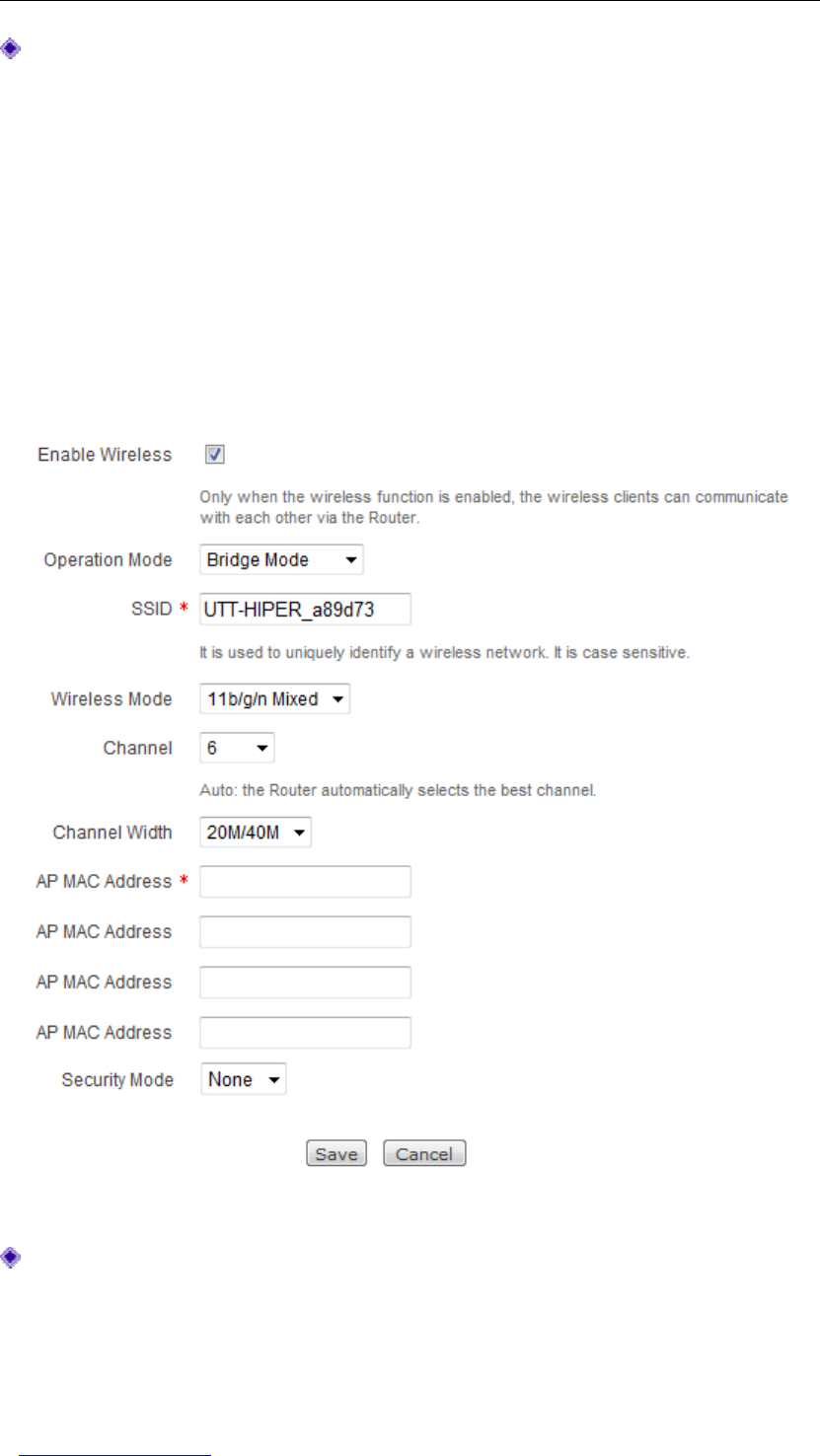
UTT Technologies Chapter 6 Wireless
http://www.uttglobal.com Page 83
Pre-shared Key: This key serves as seed for generating encryption keys. It must be
identical to the remote wireless network device’s. It must be between 8 and 63
characters long.
6.1.3.2 Bridge Mode
If you want the Wireless Router to operate in bridge mode, please select Bridge Mode
from the Opeartion Mode drop-down list, see Figure 6- 8. In this mode, the Wireless
Router can connect to other wireless network devices in repeater mode or lazy mode.
However, in this mode wireless clients are unable to connect to the Wireless Router
directly.
Figure 6- 8 Basic Wireless Settings - Bridge Mode
Operation Mode: Here please select Bridge Mode.
The other paramters are the same as those of Repeater Mode. Please refer to Section
6.1.3.1 Repeater Mode for detailed information.
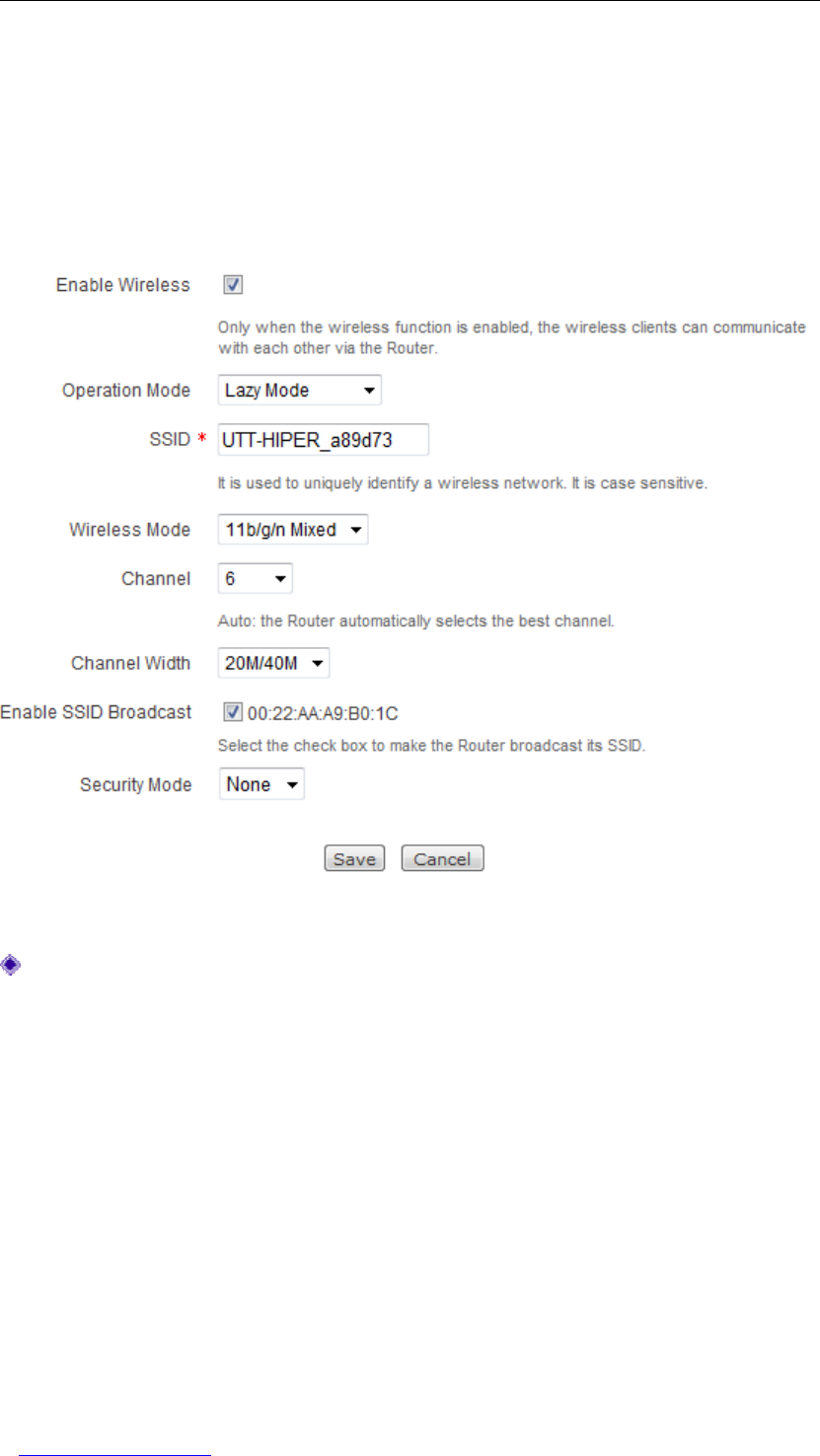
UTT Technologies Chapter 6 Wireless
http://www.uttglobal.com Page 84
6.1.3.3 Lazy Mode
If you want the Wireless Router to operate in lazy mode, please select Lazy Mode from
the Opeartion Mode drop-down list, see Figure 6- 9. In this mode, the Wireless Router
can connect to other wireless network devices in bridge mode or repearter mode; and at
the same time it can provide connectivity for wilreless clients.
Figure 6- 9 Basic Wireless Settings - Lazy Mode
Operation Mode: Here please select Laze Mode.
The other paramters are the same as those of Repeater Mode. Please refer to
Section 6.1.3.1 Repeater Mode for detailed information.
6.1.4 Configuration Example for WDS
1. Requirements
In this example (see Figure 6- 10), there are two Wireless Routers: Router A and Router B.
The Wireless Router A operates in Bridge Mode, its SSID is UTT123, security mode is
TKIP, pre-shared key is 123456789 and LAN IP address is 192.168.1.1/25. The Wireless
Router B’s IP address is 192.168.1.2/25. We want the two Routers to communicate with

UTT Technologies Chapter 6 Wireless
http://www.uttglobal.com Page 85
each other wirelessly.
Figure 6-10 Configuration Example for WDS - Network Topology
2. Configuration and Verification
To connect the Wireless Router A to the Wireless Router B properly, the Wireless Router
B’s operation mode may be Lazy Mode or Repeater Mode (here we take Lazy Mode for
example), its SSID, security mode and pre-shared key must be the same as those of the
Wireless Router A.
Besides, we leave the other parameters at their default values on both Routers.
1)Configuring the Wireless Router A
The following figure shows the detailed settings on the Wireless Router A.
Note
Please enter the Wireless Router B’s MAC address (c83a350057e0 in this example)
in the first AP MAC Address text box on the Wireless Router A.
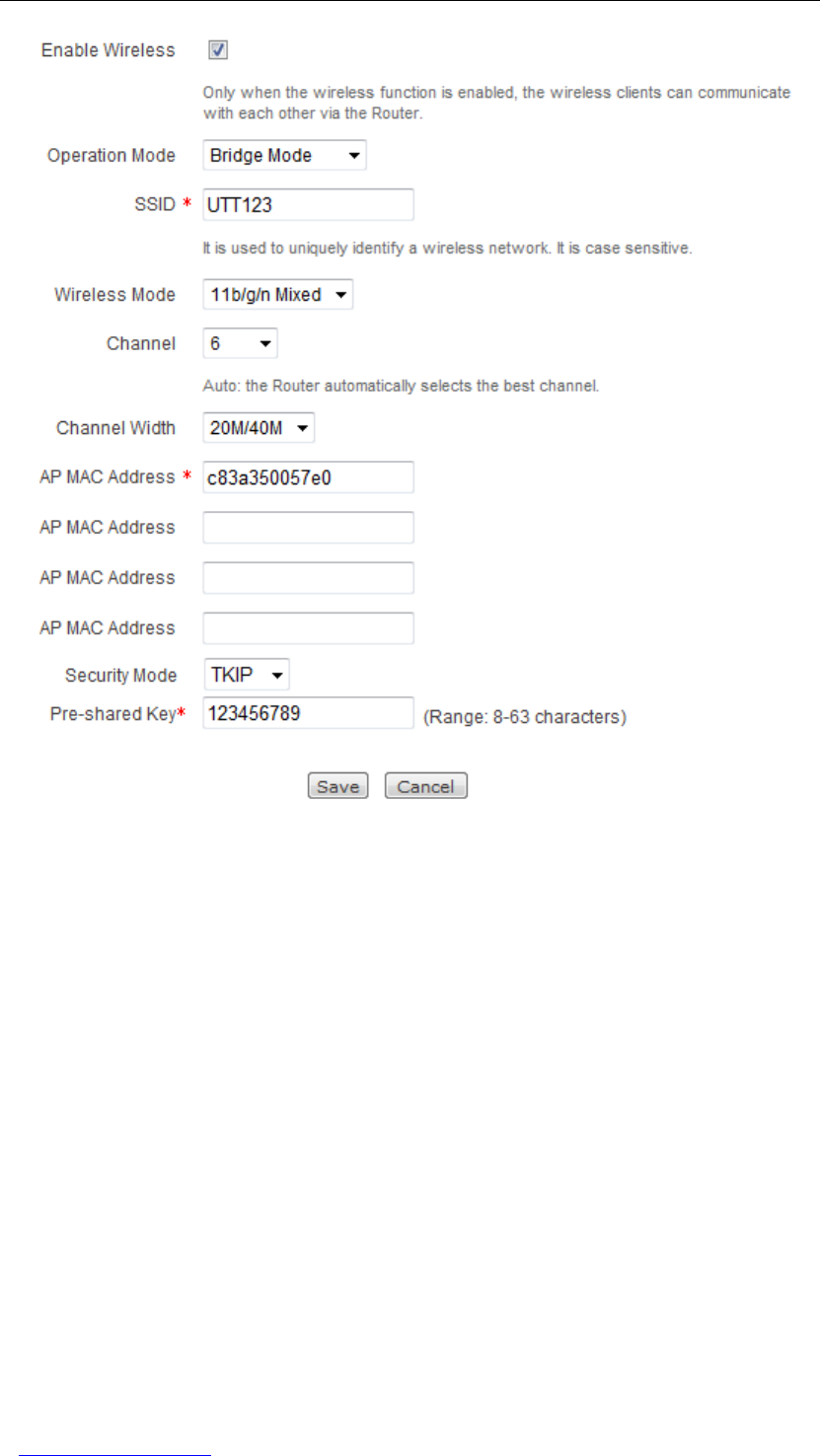
UTT Technologies Chapter 6 Wireless
http://www.uttglobal.com Page 86
Figure 6- 11 Configuration Example for WDS - Configuring the Wireless Router A
2)Configuring the Wireless Router B
The following figure shows the detailed settings on the Wireless Router B.
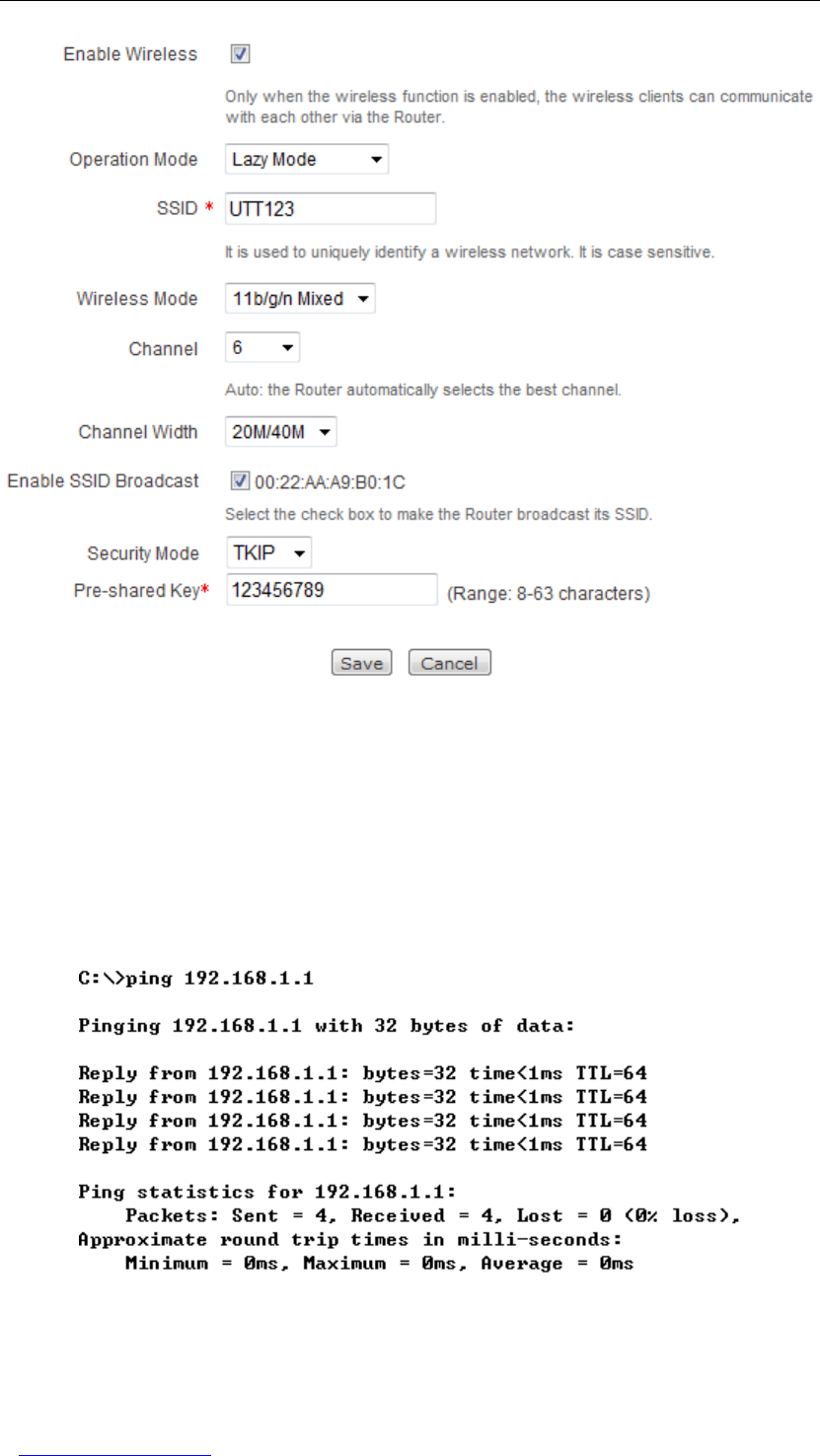
UTT Technologies Chapter 6 Wireless
http://www.uttglobal.com Page 87
Figure 6- 12 Configuration Example for WDS - Configuring the Wireless Router B
3)Verifying Connectivity between the Two Routers
To verify connectivity between the two Routers, you can use the ping command at the
command prompt on the Wireless Router B: Ping 192.168.1.1
If the displayed page is similar to the screenshot below, the connection between the two
Routers has been established.
Figure 6-13 Configuration Example for WDS - Verifying Connectivity
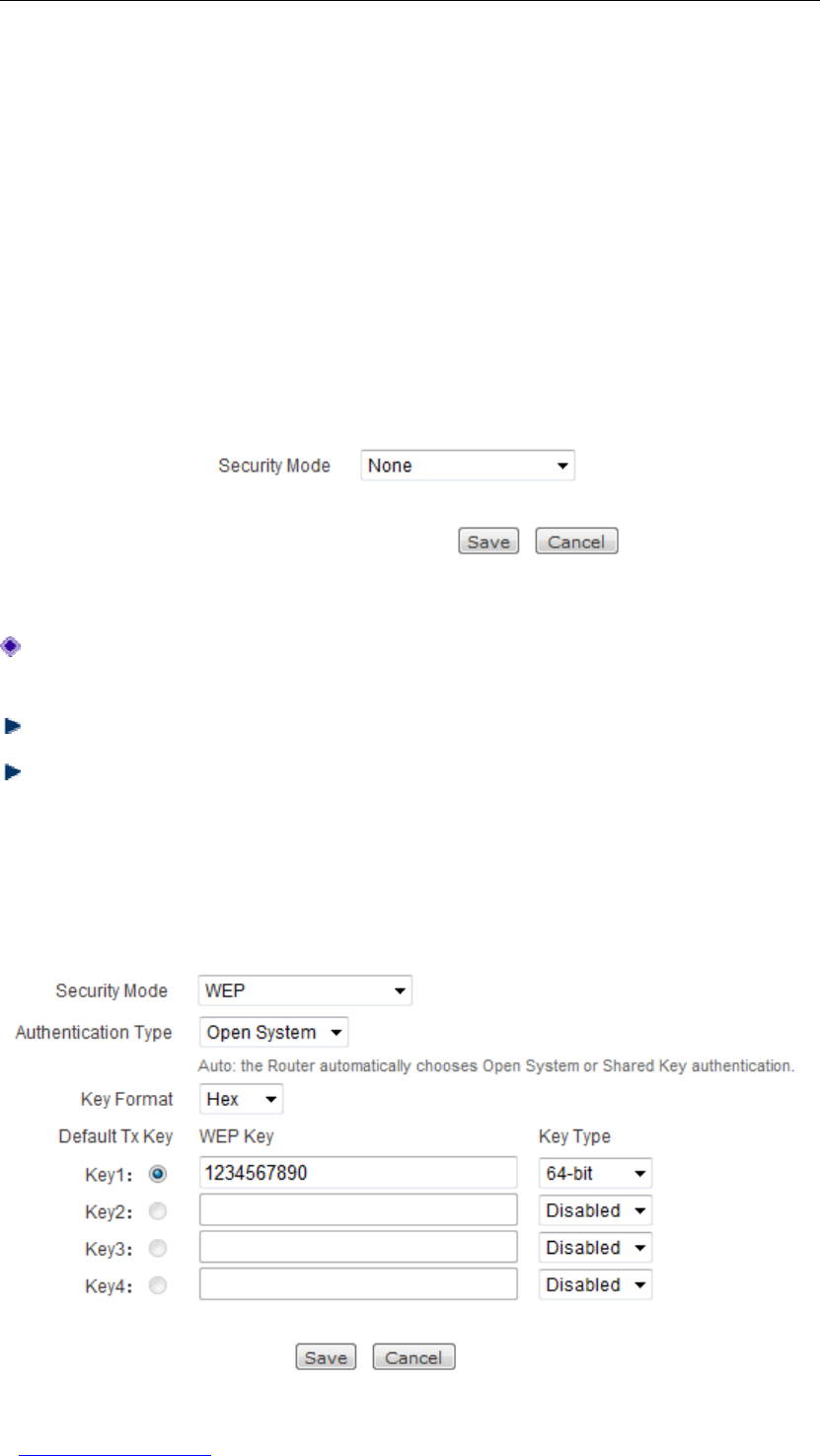
UTT Technologies Chapter 6 Wireless
http://www.uttglobal.com Page 88
6.2 Wireless Security Settings
This section describes the Wireless > Security page.
The Wireless Router provides four security mode options including None,WEP,
WPA/WPA2,andWPA-PSK/WPA2-PSK. If you want an open network without wireless
security, keep the default value of None.
6.2.1 Disabling Wireless Security
Figure 6- 14 Disabling Wireless Security
Security Mode: It specifies the security mode that you want to use on your wireless
network. Here please select None to disable wireless securtiy.
Save: Click to save you changes.
Cancel: Click to revert to the last saved settings.
6.2.2 Wireless Security Settings – WEP

UTT Technologies Chapter 6 Wireless
http://www.uttglobal.com Page 89
Figure 6- 15 Wireless Security Settings - WEP
Security Mode: It specifies the security mode that you want to use on your wireless
network. Here please select WEP. WEP is the basic encryption mode which is not as
secure as WPA.
Authentication Type: It allows you to select the authentication type under WEP
security mode. The Wireless Router must authenticate a wireless client before the
client can join the wireless network. There are three options: Auto,Open System
and Shared Key.
●Auto: It allows either Open System or Shared Key authentication to be used.
The Wireless Router will automatically choose the authentication type.
●Open System: It allows any wireless client regardless of its WEP keys to
authenticate and attempt to associate with the Wireless Router. However, even if
a client can complete authentication and associate with the Wireless Router, the
client cannot send or receive data from the Wireless Router unless the client has
the correct WEP key.
●Shared Key: It requires that the wireless client and the Wireless Router have
the same WEP key to authenticate. Without the correct key, authentication will
fail and the client won’t be allowed to associate with the Wireless Router.
Key Format: It specifies the format for entering the WEP keys. The options are Hex
and ASCII.
●Hex: Select this option if you want to enter the WEP keys in hexadecimal
format. Hexadecimal digits are a set of characters that includes numbers 0
through 9 and letters A through F (or a through f). Hex WEP keys are case
insensitive.
●ASCII: Select this option if you want to enter the WEP keys in ASCII format.
ASCII WEP keys are case sensitive.
Default Tx Key: It allows you to select one of the WEP keys as the default transmit
key to transmit data. All keys can be used to receive data.
WEP Key: It allows you to enter a key in one of the WEP Key boxes. You can enter
up to four WEP keys. You should enter a key according to the Key Format and Key
Type selected.
●For 64-bit encryption, enter 10 hex characters or 5 ASCII characters.
●For 128-bit encryption, enter 26 hex characters or 13 ASCII characters.
Key Type: It allows you to select the size of each key, and it also allows you to
disable or enable each key. The options are Disabled,64-bit and 128-bit. By default,
Disabled is selected, which means the key is of no effect.
Save: Click to save your changes.
Cancel: Click to revert to the last saved settings.
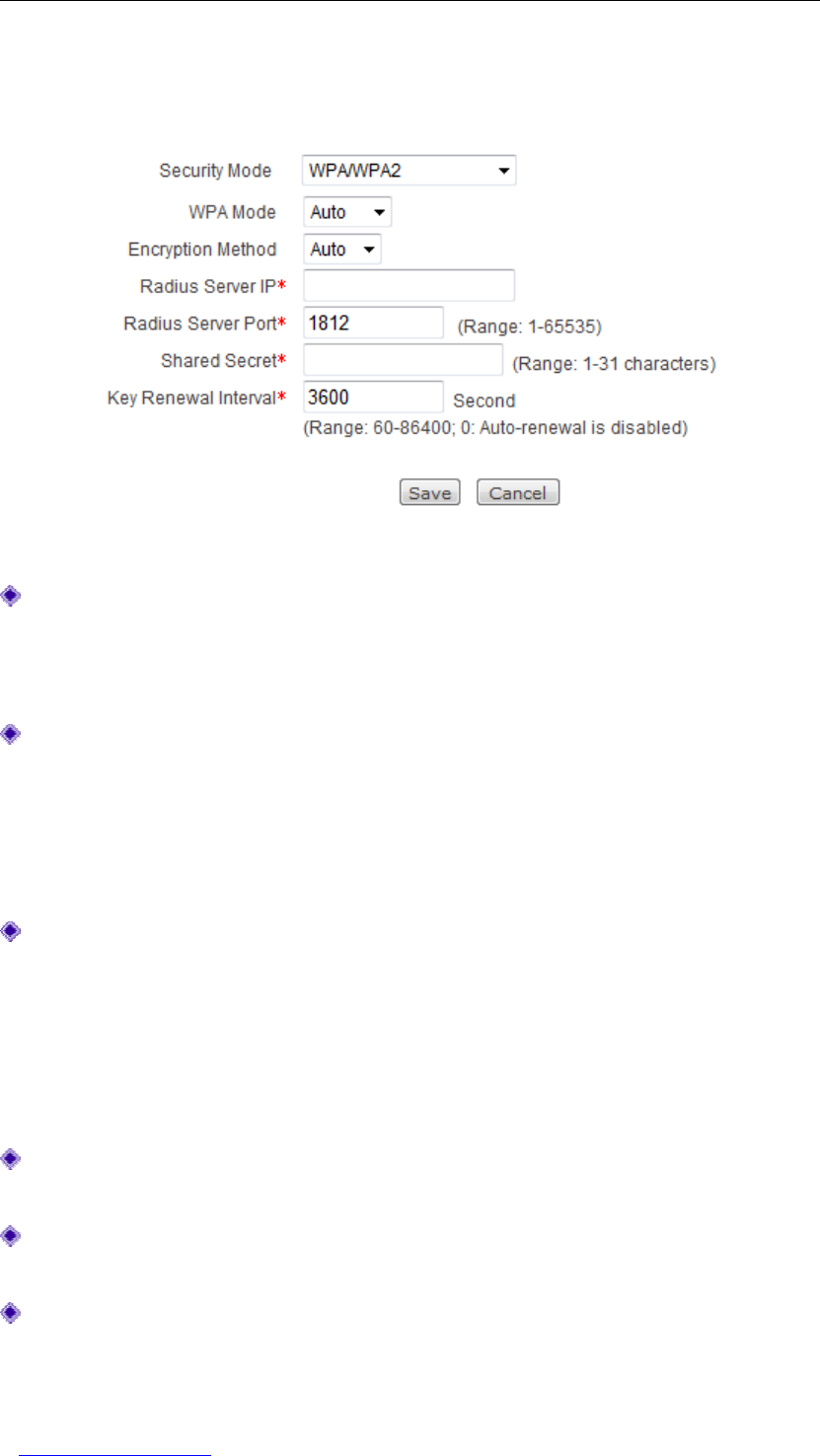
UTT Technologies Chapter 6 Wireless
http://www.uttglobal.com Page 90
6.2.3 Wireless Security Settings - WPA/WPA2
Figure 6- 16 Wireless Security Settings - WPA/WPA2
Security Mode: It specifies the security mode that you want to use on your wireless
network. Here please select WPA/WPA2 to use WPA mode, WPA2 mode or both. In
WPA or WPA2 mode, the Wireless Router uses an external RADIUS server to
authenticate wireless clients.
WPA Mode: It specifies the WPA mode that you want to use on your wireless network.
The options are Auto,WPA and WPA2.
●Auto: It allows both WPA and WPA2 clients to connect to the Wireless Router.
●WPA: It only allows WPA clients to connect to the Wireless Router.
●WPA2: It only allows WPA2 clients to connect to the Wireless Router.
Encrption Method: It specifies the encrytion method used for data encryption. The
options are Auto,TKIP and AES.
●Auto: It means that the Wireless Router will automatically choose to use TKIP
or AES for data encryption.
●TKIP: It means that the Wireless Router will use TKIP for data encryption.
●AES: It means that the Wireless Router will use AES for data encryption.
RADIUS Server IP: It specifies the IP address of the RADIUS server, which is used
to authenticate the wireless clients.
RADIUS Server Port: It specifies the UPD port number of the RADIUS server. The
vaild range is 1 to 65535, and the default value is 1812.
Shared Secret: It specifies the shared secret key to be used for authentication
between the Wireless Router and the RADIUS server. It must be the same on both
the Wireless Router and the RADIUS server.
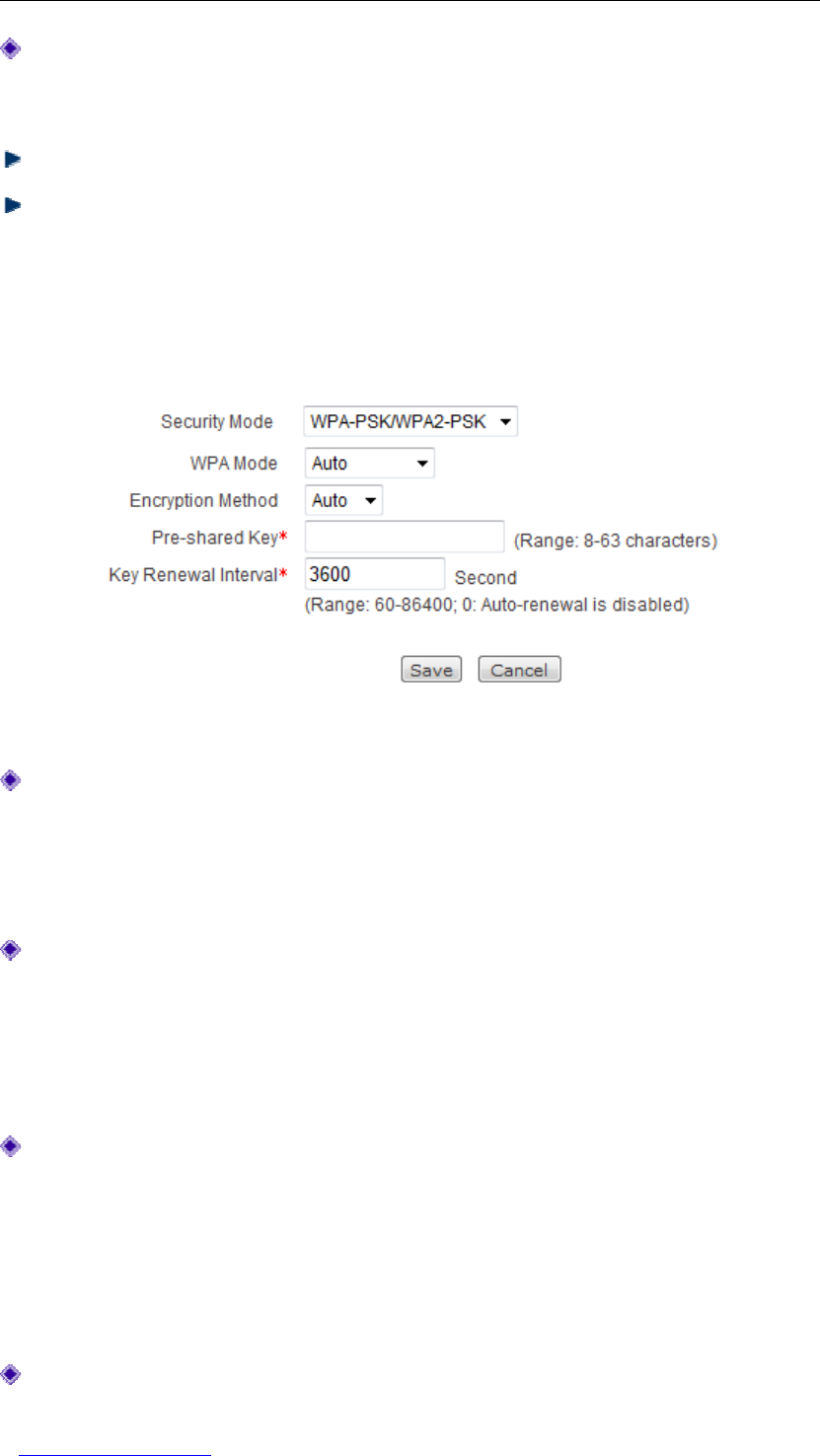
UTT Technologies Chapter 6 Wireless
http://www.uttglobal.com Page 91
Key Renewal Interval: It specifies how often the WPA group key changes. The valid
range is 60-86400 or 0, and the default value is 3600 seconds. Enter 0 to disable
automatic renewal.
Save: Click to save your changes.
Cancel: Click to revert to the last saved settings.
6.2.4 Wireless Security Settings - WPA-PSK/WPA2-PSK
Figure 6- 17 Wireless Security Settings - WPA-PSK/WPA2-PSK
Security Mode: It specifies the security mode that you want to use on your wireless
network. Here please select WPA-PSK/WPA2-PSK to use WPA-PSK mode,
WPA2-PSK mode or both. This mode intends for the wireless network that doesn’t
have a RADIUS server. In this mode, the Wireless Router uses the pre-shared key
that is manulally entered to generate encryption keys.
WPA Mode: It specifies the WPA mode that you want to use on your wireless network.
The options are Auto,WPA-PSK and WPA2-PSK.
●Auto: It allows both WPA and WPA2 clients to connect to the Wireless Router.
●WPA-PSK: It only allows WPA clients to connect to the Wireless Router.
●WPA2-PSK: It only allows WPA2 clients to connect to the Wireless Router.
Encrption Method: It specifies the encrytion method used for data encryption. The
options are Auto,TKIP and AES.
●Auto: It means that the Wireless Router will automatically choose encryption
method for each wireless client.
●TKIP: It means that the Wireless Router will use TKIP for data encryption.
●AES: It means that the Wireless Router will use AES for data encryption.
Pre-shared Key: This key serves as seed for generating encryption keys. The

UTT Technologies Chapter 6 Wireless
http://www.uttglobal.com Page 92
wireless clients also need to be configurd with the same pre-shared key. It must be
between 8 and 63 characters long.
Key Renewal Interval: It specifies how often the WPA group key changes. The valid
range is 60-86400 or 0, and the default value is 3600 seconds. Enter 0 to disable
automatic renewal.
Save: Click to save your changes.
Cancel: Click to revert to the last saved settings.
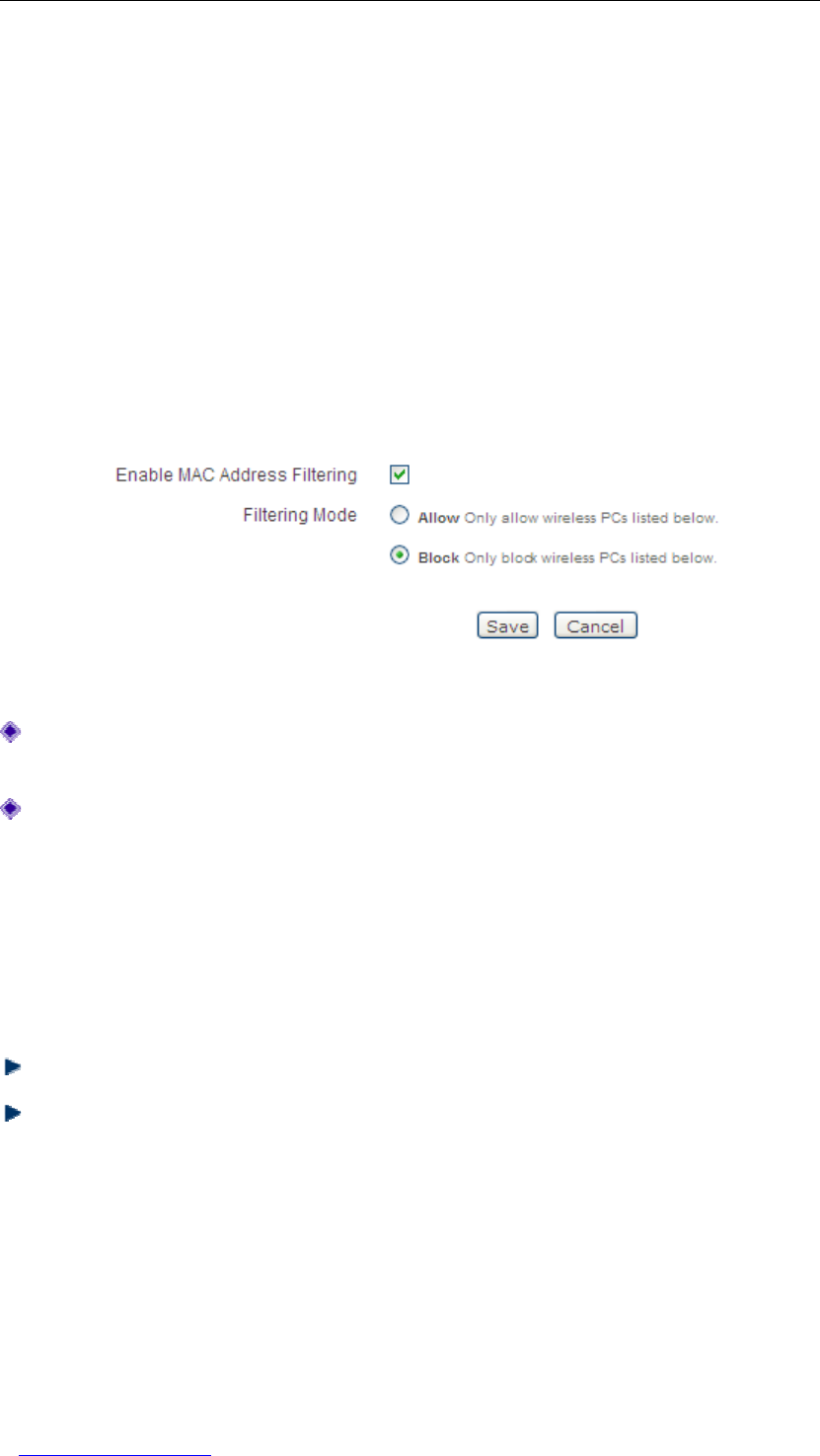
UTT Technologies Chapter 6 Wireless
http://www.uttglobal.com Page 93
6.3 Wireless MAC Address Filtering
This section describes the Wireless > MAC Filtering page.
The MAC address filtering is used to filter the wireless clients based on their MAC
addresses. With this feature, you can either allow or block specific wireless clients to
connect to the Wireless Router.
6.3.1 MAC Address Filtering Global Settings
Figure 6- 18 MAC Address Filtering Global Settings
Enable MAC Address Filtering: It allows you to enable or disable MAC address
filtering. If you want to enable MAC address filtering, please select the check box.
Filtering Mode: It specifies the mode of MAC address filtering.
●Allow: Choose this option to allow the wireless clients with the MAC addresses
listed in the MAC Address Filtering List to connect to the Wireless Router, but
block all other wireless clients.
●Deny: Choose this option to block the wireless clients with the MAC addresses
listed in the MAC Address Filtering List from connecting to the Wireless Router,
but allow all other wireless clients.
Save: Click to save your changes.
Cancel: Click to revert to the last saved settings.
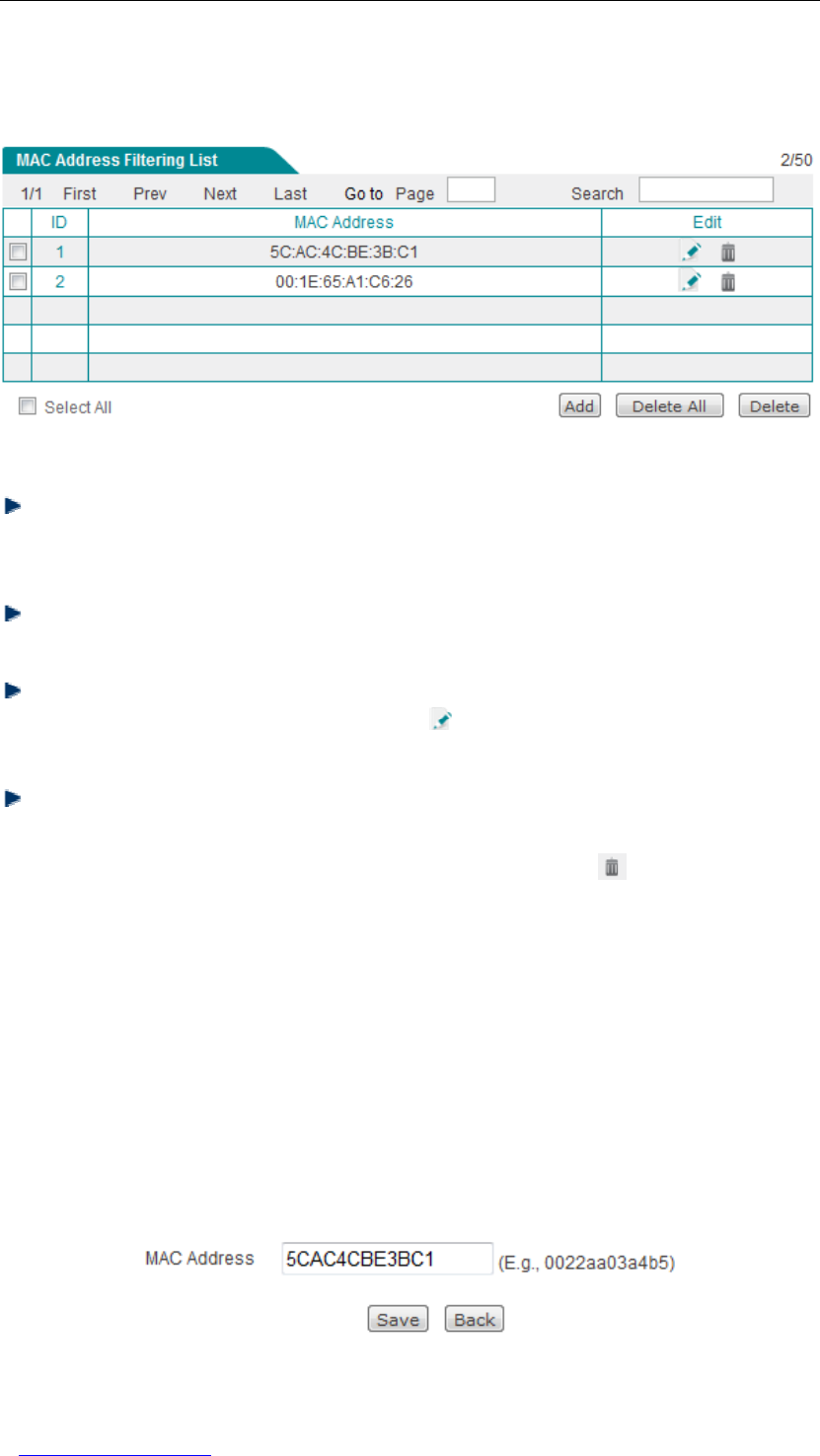
UTT Technologies Chapter 6 Wireless
http://www.uttglobal.com Page 94
6.3.2 MAC Address Filtering List
Figure 6- 19 MAC Address Filtering List
Add a MAC Address Filtering Entry: To add a new MAC address filtering entry, first
click the Add button to go to the MAC Address Filtering Settings page, next
configure it, lastly click the Save button.
View MAC Address Filtering Entry(s): When you have configured one or more
MAC address filtering entries, you can view them in the MAC Address Filtering List.
Modify a MAC Address Filtering Entry: To modify a configured MAC address
filtering entry, click its ID hyperlink or icon, the related information will be
displayed in the setup page. Then modify it, and click the Save button.
Delete MAC Address Filtering Entry(s): There are three ways to delete MAC
address filtering entry(s).
1. To delete a MAC address filtering entry, directly click its icon.
2. To delete more than one MAC address filtering entry at a time, select the leftmost
check boxes of the entries that you want to delete, and then click the Delete
button.
3. To delete all the MAC address filtering entries at a time, directly click the Delete
All button.
6.3.3 MAC Address Filtering Settings
Figure 6- 20 MAC Address Filtering Settings

UTT Technologies Chapter 6 Wireless
http://www.uttglobal.com Page 95
MAC Address: It specifies the MAC address of the wireless client that you want to
allow or block.
Save: Click to save your changes.
Back: ClicktogobacktotheWireless > MAC Filtering page.
6.3.4 How to Configure MAC Address Filtering
To configure MAC address filtering, follow these steps:
Step 1 Go to the Wireless > MAC Filtering page.
Step 2 Click the Add button to go to MAC Address Filtering Settings page, next
enter the MAC address of the wireless client that you want to control in the
MAC Address text box.
Step 3 Now you can view the MAC address filtering entry in the MAC Address
Filtering List.
Step 4 Continue to configure other MAC address filtering entries.
Step 5 If you want to allow the wireless clients with the MAC addresses listed in the
MAC Address Filtering List to connect to the Wireless Router, but block all
other wireless clients, select the Enable MAC Address Filtering check box,
and choose Allow as the Filtering Mode. If you want to block the specified
wireless clients from connecting to the Wireless Router, but allow all other
wireless clients, select the Enable MAC Address Filtering check box, and
choose Block as the Filtering Mode.
After you have configured MAC address filtering, the Wireless Router will allow or block
wireless clients based on their MAC addresses.
To temporarily disable MAC address filtering, clear the Enable MAC Address Filtering
check box.
6.3.5 Configuration Example for MAC Address Filtering
1. Requirements
In this example, we want to block the wireless clients with the MAC addresses
00b08c0517ed, 001f3c47f481 and 001f3c0f07f4 accessing the Wireless Router, and allow
all other wireless clients to access the Wireless Router.
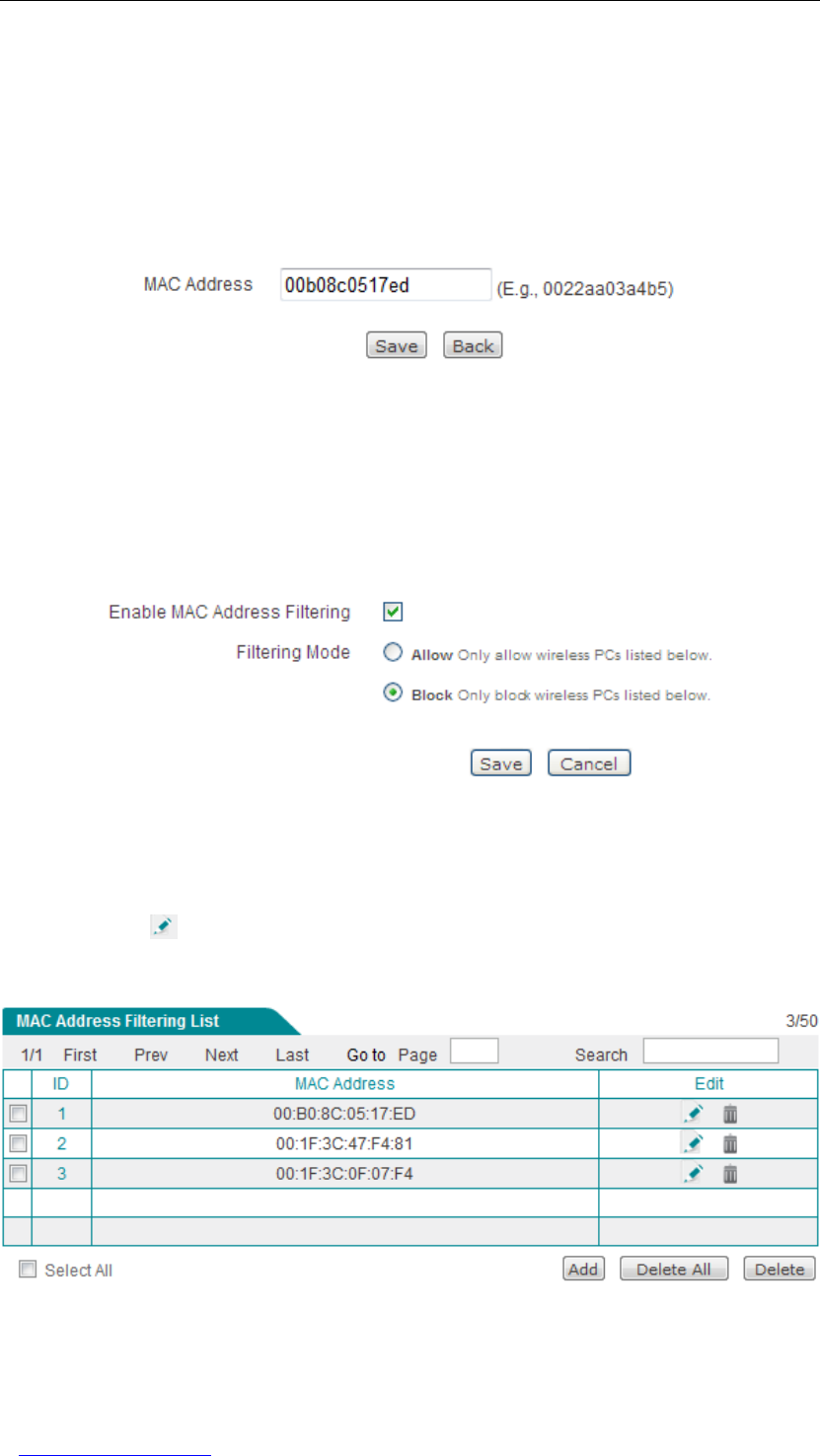
UTT Technologies Chapter 6 Wireless
http://www.uttglobal.com Page 96
2. Configuration Steps
Step 1 Go to the Wireless > MAC Filtering page.
Step 2 Click the Add button to go to MAC Address Filtering Settings page (see
Figure 6- 21), enter 00b08c0517ed in the MAC Address text box, and then
click the Save button.
Figure 6- 21 Adding a MAC Address Filtering Entry - Example
Step 3 Continue to add the other two MAC addresses (001f3c47f481 and 001f3c0f07f4)
to the MAC Address Filtering List.
Step 4 Select the Enable MAC Address Filtering check box, choose Block as the
Filtering Mode, and then click the Save button.
Figure 6- 22 MAC Address Filtering Global Settings - Example
Now the configuration is complete, and you can view the three MAC address filtering
entries in the MAC Address Filtering List. If you have entered an incorrect MAC address,
directly click its icon to go to the MAC Address Filtering Settings page to modify it,
and click the Save button to save the change.
Figure 6- 23 MAC Address Filtering List - Example
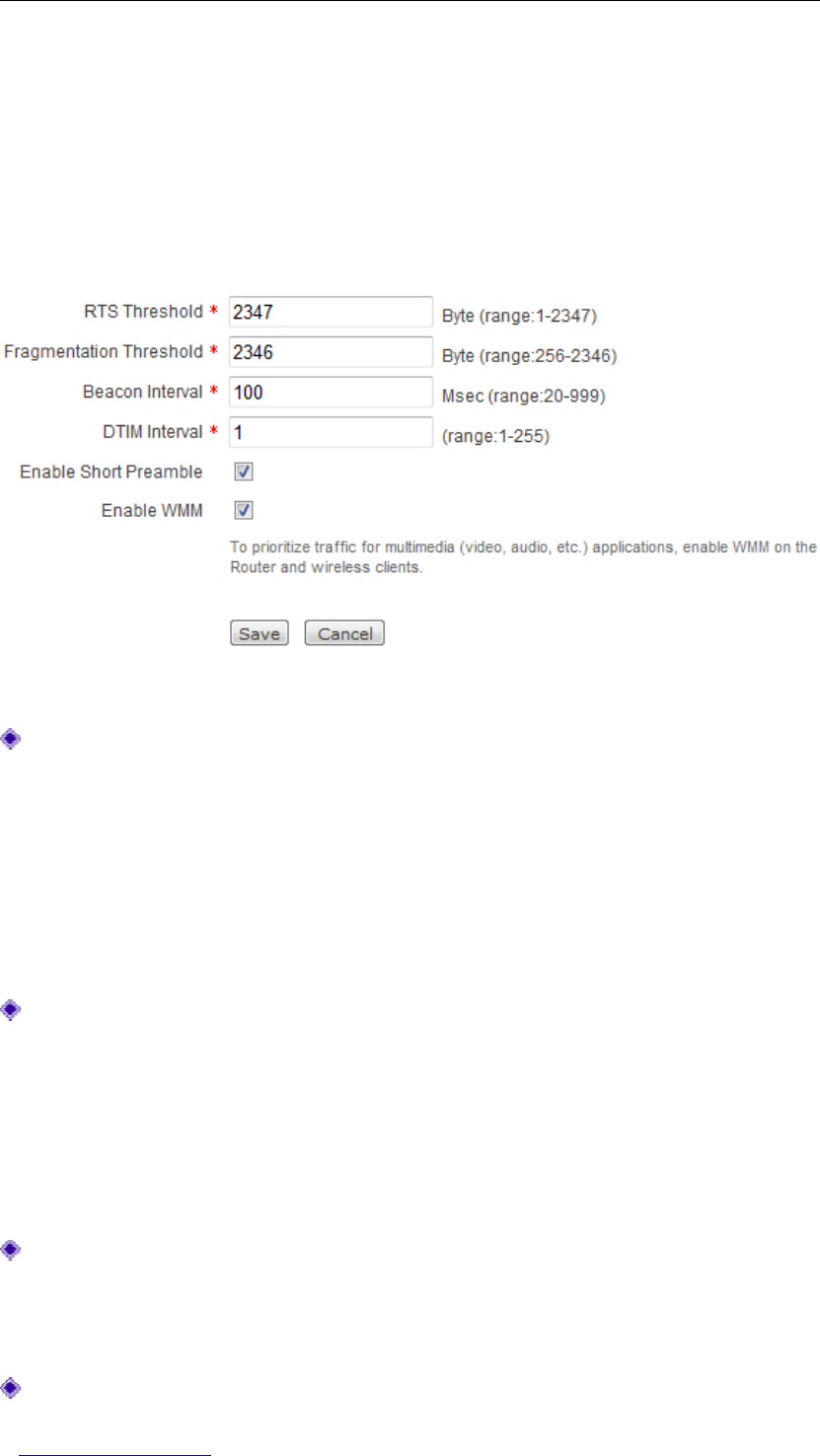
UTT Technologies Chapter 6 Wireless
http://www.uttglobal.com Page 97
6.4 Advanced Wireless Settings
This section describes the Wireless > Advanced Wireless Settings page.
In this page, you can configure advanced wireless settings for your wireless connection.
We suggest that you don’t adjust these settings unless you are an expert user. Incorrect
settings will reduce the performance of your wireless network.
Figure 6- 24 Advanced Wireless Settings
RTS Threshold: It specifies the packet size above which an RTS/CTS handshake
will be performed before sending the packet. It must be between 1 and 2347, and the
default value is 2347 bytes.
RTS/CTS handshake is used to reduce collisions introduced by hidden nodes in the
WLAN. A low threshold causes RTS packts to be sent more frequently, which
consume more available bandwidth and reduce the throughput of other network
packets. However, frequent RTS packets can help the network to recover from
interference or collisions.
Fragmentation Threshold: It speicifies the maximum size of a packet that can be
transmitted. The packets larger than the specified size will be fragmented before
transmission. It must be between 256 and 2346, and the default value is 2346 bytes.
Reducing this value will decrease network performance. In most cases, please leave
the default value. However, to ensure data transmission, you may decrease this value
in areas where communication is poor, or in areas where there is a great deal of radio
interference.
Beacon Interval: It specifies the time interval between beacons. The Wireless
Router periodically broadcasts beacons at the specified interval to synchronize the
wireless network. It must be between 20 and 999, and the default value is 100
milliseconds.
DTIM Interval: It determines how often the beacon contains a Delivery Traffic

UTT Technologies Chapter 6 Wireless
http://www.uttglobal.com Page 98
Indication Message (DTIM). The DTIM notifies wireless clients in power-save mode
that a packet is waiting for them. The DTIM interval is a multiple of the Beacon
Interval. For example, if it is set to 4, a DTIM message will be sent with every fourth
beacon. It must be between 1 and 255, and the default value is 1.
Enable Short Preamble: It allows you to enable short preamble or long preamble.
●Select the check box to enable short preamble. The short preamble can
improve network performance.
●Clear the check box to enable long preamble. The long preamble ensures
compatibilities with some old 802.11b devices that require the long preamble, but
it can slightly reduce throughout at high data rate.
Enable WMM: It allows you to enable or disable WMM (Wi-Fi Multimedia). WMM is a
subset of the 802.11e standard. Enable this feature to improve the quality of
multimedia (video, audio, etc.) applications by prioritizing traffic for them. To use this
feature, your wireless clients must also support WMM.
Save: Click to save your changes.
Cancel: Click to revert to the last saved settings.
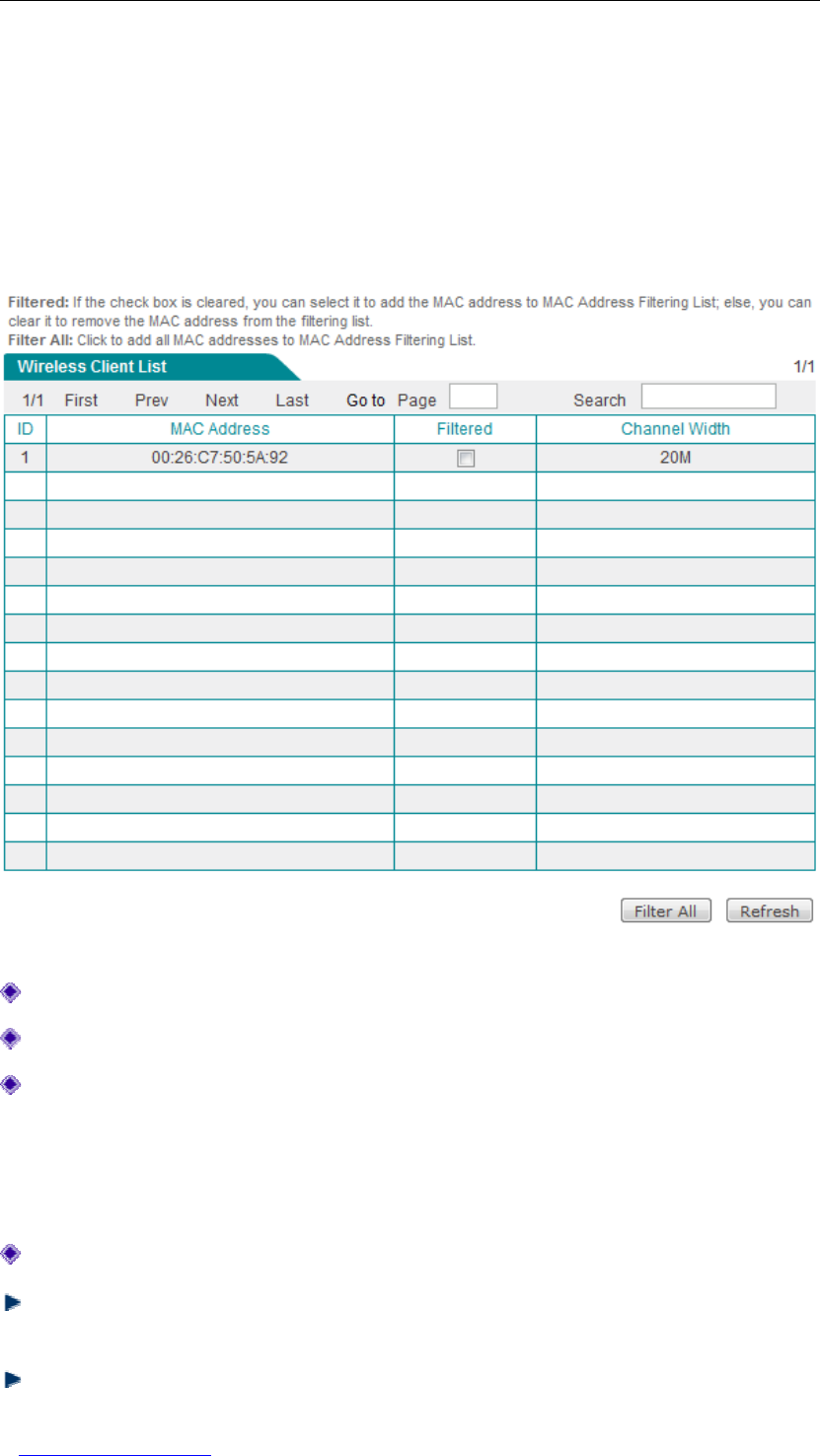
UTT Technologies Chapter 6 Wireless
http://www.uttglobal.com Page 99
6.5 Wireless Client List
This section describes the Wireless > Client List page.
In the Wireless Client List, you can view the status of all wireless clients which are
connected to the Wireless Router. In addition, you can also easily configure MAC address
filtering entries via the list.
Figure 6- 25 Wireless Client List
ID: It is used to identify each wireless client entry in the list.
MAC Address: It displays the MAC address of the wireless client.
Filtered: It indicates whether the corresponding MAC address has been added to the
MAC Address Filtering List in the Wireless > MAC Filtering page. If the MAC
address has been added to the MAC Address Filtering List,theFiltered check box
is checked. Else, the Filtered check box is cleared; and in this case, you can click the
check box to add the MAC address to the MAC Address Filtering List.
Channel Width: It displays the current channel width in MHz.
Filter All: Click to select the Filtered check boxes of all MAC addresses and add
them into the MAC Address Filtering List, except those already added.
Refresh: Click to view the latest information in the list.

UTT Technologies Chapter 7 Advanced
http://www.uttglobal.com Page 100
Chapter 7 Advanced
This chapter describes how to configure and use the advanced features of the Wireless
Router, which include NAT and DMZ, IP/MAC binding, static route, and PPPoE server.
7.1 NAT and DMZ
This section describes the Advanced > NAT&DMZ page.
7.1.1 Introduction to NAT Features
7.1.1.1 NAT Overview
The NAT (Network Address Translation) is an Internet standard that is used to map one IP
address space (i.e., Intranet) to another IP address space (i.e., Internet). The NAT is
designed to alleviate the shortage of IP addresses, that is, it allows all the local computers
to share a single or a small group of IP addresses: On the Internet, there is only a single
network device using a single or a small group of public IP addresses; but the local
computers can use any range of private IP addresses, and these IP addresses are not
visible from the Internet. As the internal network can be effectively isolated from the
outside world, the NAT can also provide the benefit of network security assurance.
The Wireless Router provides flexible NAT features. The following sections describe them
in detail.
7.1.1.2 NAT Address Space Definitions
To ensure that NAT operates properly, the Wireless Router uses and maintains two
address spaces:
●Internal IP address: It indicates the IP address assigned to a local computer by the
administrator. It is usually a private IP address.
●External IP address: It indicates the IP address assigned to the Wireless Router’s
Internet connection by the ISP. It is a legal public IP address that can represent one or
more internal IP addresses to the outside world.

UTT Technologies Chapter 7 Advanced
http://www.uttglobal.com Page 101
7.1.1.3 NAT Types
The Wireless Router provides two types of NAT: One2One and EasyIP.
●One2One (One to One): It indicates static network address translation. It is always
referred to as Basic NAT, which provides a one to one mapping between an internal
and an external IP address. In this type of NAT, IP address needs to be changed, but
port needn’t.
One to One NAT can be used to allow the outside users to access a LAN server: In the
local network, the LAN server still use the private IP address, which is provided to the
local computers to access; and on the Internet, the Wireless Router will assign an
external IP address to the local server, then the outside users can using this external IP
address to access the server through the Wireless Router.
●EasyIP: It indicates network address and port translation (NAPT). Since it is the most
common type of NAT, it is often simply referred to as NAT. NAPT provides many-to-one
mappings between multiple internal IP addresses and a single external IP addresses,
that is, these multiple internal IP addresses will be translated to the same external IP
address. In this type of NAT, to avoid ambiguity in the handling of returned packets, it
must dynamically assign a TCP/UDP port to an outgoing session and change the
packets’ source port to the assigned port before forwarding them. Besides, the
Wireless Router must maintain a translation table so that return packets can be
correctly translated back.
When you obtain multiple public IP addresses from your ISP, you can create more than
one NAT rule for either type of NAT. In actual network environment, the two types of NAT
rules are often used together.
7.1.1.4 Port Forwarding and DMZ Host
When NAT is enabled on the Wireless Router, the Wireless Router will block all the
requests initiated from outside users. However, in some cases, the outside users want to
access the LAN internal servers through the Wireless Router. To achieve this purpose,
you need to configure port forwarding entries or DMZ host on the Wireless Router.
1. Port Forwarding
Port forwarding feature allows you to create the mapping between <external IP address:
external port> and <internal IP address: internal port>, then all the requests from outside
users to the specified external IP address: port on the Wireless Router will be forwarded to
the mapped local server, so the outside users can access the service offered by the
server.
For example, if you want to allow the local SMTP server (IP address: 192.168.1.88) to be
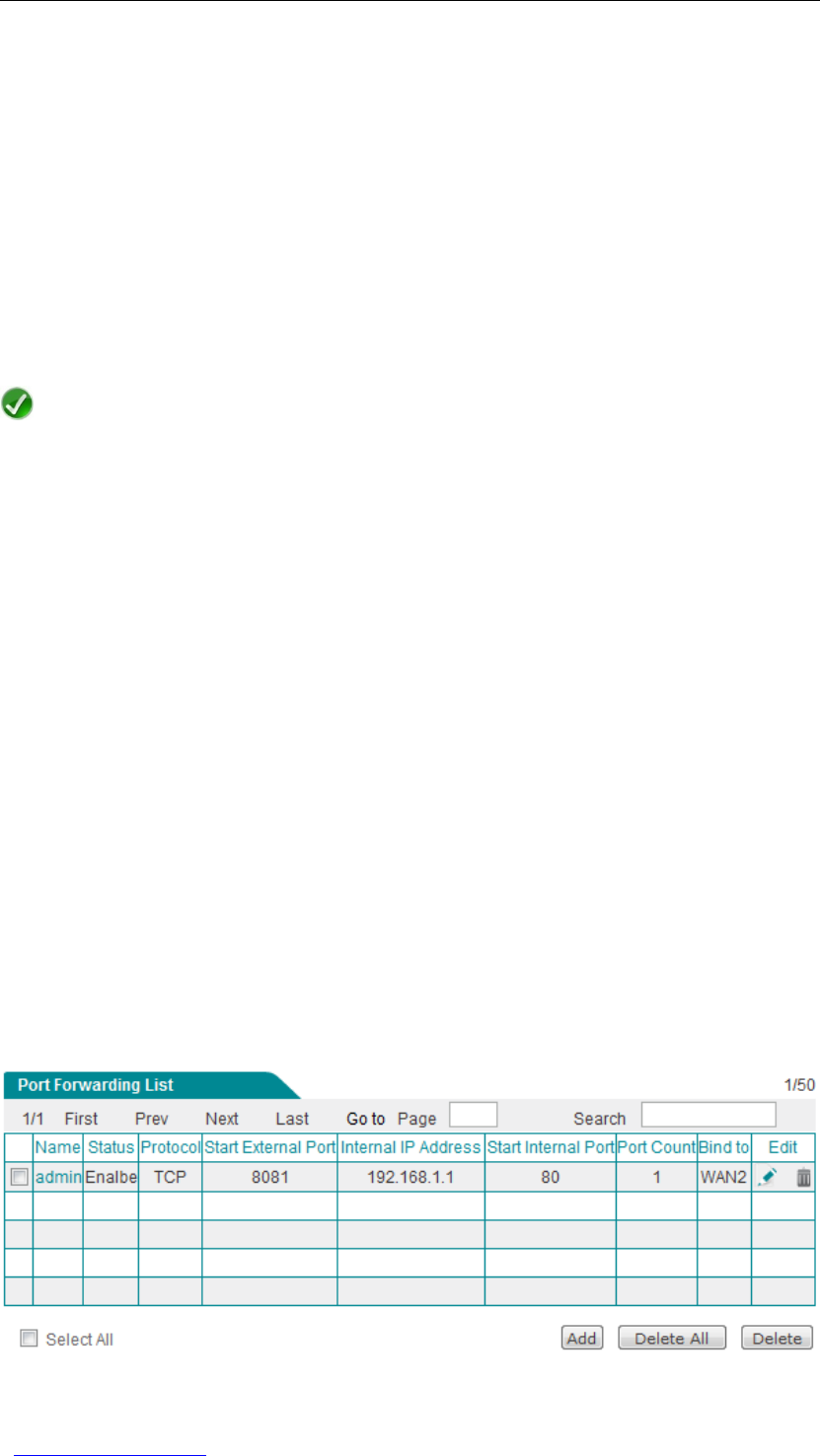
UTT Technologies Chapter 7 Advanced
http://www.uttglobal.com Page 102
available to the outside users, you can create a port forwarding entry: external IP address
is WAN1 IP address (200.200.201.88 in this example), external port is 2100, internal IP
address is 192.168.1.88, and internal port is 25. Then all the requests to SMTP service
from outside users to 200.200.201.88:2100 will be forwarded to 192.168.1.88:25.
2. DMZ Host
The DMZ (Demilitarized Zone) feature allows one local computer to be exposed to the
Internet for the use of a special service such as online game or video conferencing. When
receiving the requests initiated from outside users, the Wireless Router will directly
forward these requests to the specified DMZ host.
Note
When a local computer is designated as the DMZ host, it loses firewall protection
provided by the Wireless Router. As the DMZ host is exposed to many exploits from
the Internet, it may be used to attack your network.
3. The Priorities of Port Forwarding Entries and DMZ Host
The port forwarding entries take priority over the DMZ host. When receiving a request
packet initiated from an outside user, the Wireless Router will firstly search the Port
Forwarding List to find out if there is a port forwarding entry matching the destination IP
address and port of the packet. If a match is found, the Wireless Router will forward the
packet to the mapped local computer. Else, the Wireless Router will try to find out if there
is an available DMZ host.
7.1.2 Port Forwarding
7.1.2.1 Port Forwarding List
Figure 7- 1 Port Forwarding List
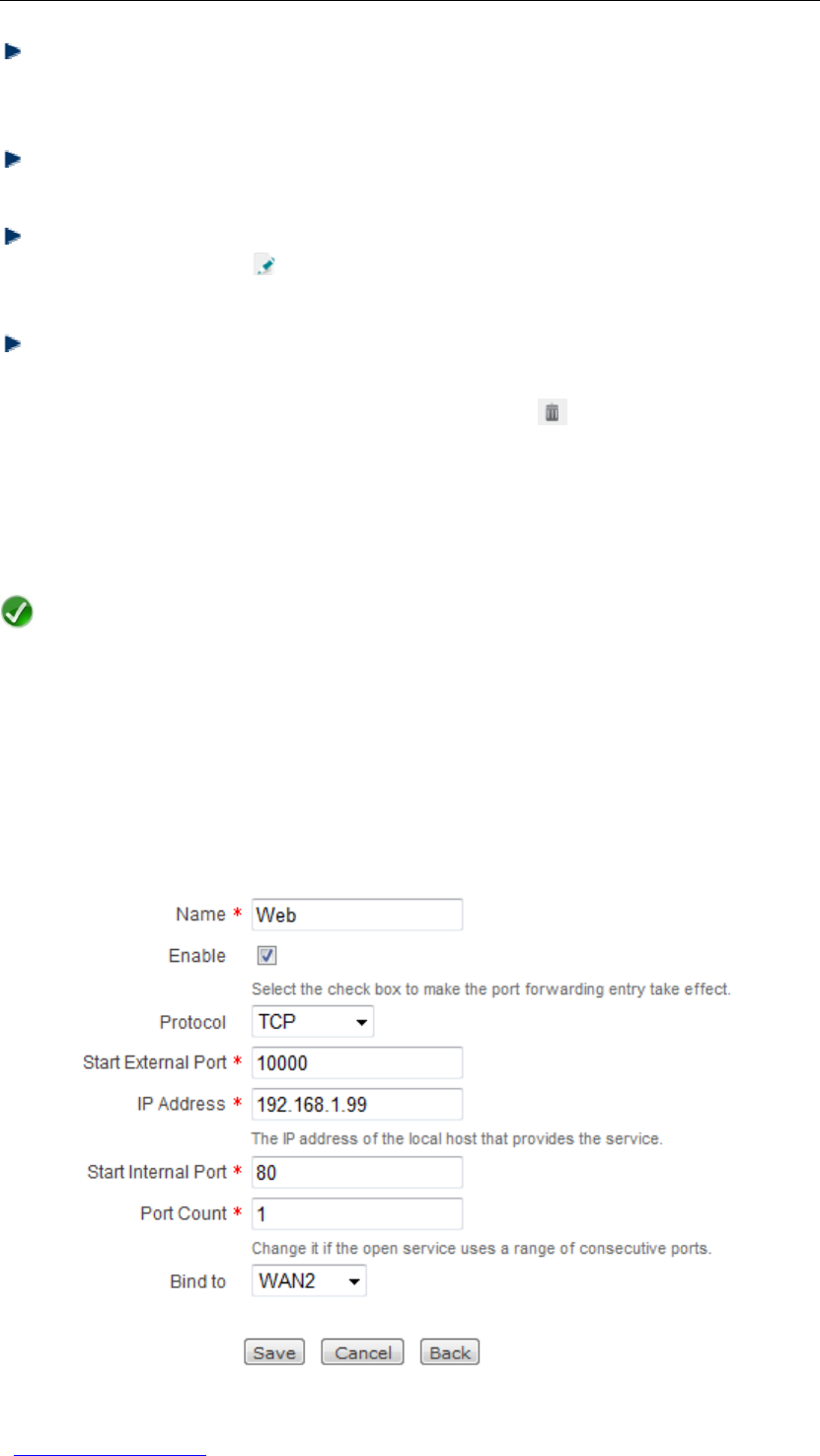
UTT Technologies Chapter 7 Advanced
http://www.uttglobal.com Page 103
Add a Port Forwarding Entry: To add a new port forwarding entry, first click the Add
button to go to the Port Forwarding Settings page, next configure it, lastly click the
Save button.
View Port Forwarding Entry(s): When you have configured one or more port
forwarding entries, you can view them in the Port Forwarding List.
Modify a Port Forwarding Entry: To modify a configured port forwarding entry, click
its Name hyperlink or icon, the related information will be displayed in the setup
page. Then modify it, and click the Save button.
Delete Port Forwarding Entry(s): There are three ways to delete port forwarding
entry(s).
1. To delete a port forwarding entry, directly click its icon.
2. To delete more than one port forwarding entry at a time, select the leftmost check
boxes of the entries that you want to delete, and then click the Delete button.
3. To delete all the port forwarding entries at a time, directly click the Delete All
button.
Note
After you enable HTTP remote management in the Administration > Remote
Access page, the system will automatically create a port forwarding entry for it. You
cannot modify or delete it in this page.
7.1.2.2 Port Forwarding Settings
Figure 7- 2 Port Forwarding Settings

UTT Technologies Chapter 7 Advanced
http://www.uttglobal.com Page 104
Name: It specifies a unique name of the port forwarding entry.
Enable: It allows you to enable or disable the port forwarding entry. The default value
is checked, which means the port forwarding entry is in effect. If you want to disable
the entry temporarily instead of deleting it, please clear the check box.
Protocol: It specifies the transport protocol used by the service. The available
options are TCP,UDP and TCP/UDP. If you are not sure, select TCP/UDP.
Start External Port: It specifies the lowest port number provided by the Wireless
Router. The external ports are opened for outside users to access.
Internal IP Address: It specifies the IP address of the local computer that provides
the service.
Start Internal Port: It specifies the lowest port number of the service provided by the
local computer. The Start External Port and Start Internal Port can be different.
Port Count: It specifies the number of service ports provided by the local computer. If
the service uses only one port number, enter 1. Change it if the service uses a range
of consecutive ports. The maximum value is 20. For example, if the start internal port
is 20, the start external port is 2000, and the port count is 2, then the internal port
range is from 20 to 21, and the external port range is from 2000 to 2001.
Bind to: It specifies the interface to which this port forwarding entry is bound. The
port forwarding entry will use the selected interface’s IP address as its external IP
address.
Save: Click to save your changes.
Cancel: Click to revert to the last saved settings.
Back: ClicktogobacktothePort Forwarding List.
7.1.2.3 How to Add Port Forwarding Entries
To add one or more static port forwarding entries, follow these steps:
Step 1 Go to the Advanced > NAT > Port Forwarding page, and click the Add button
to go to the Port Forwarding Settings page.
Step 2 Specify the Name, and leave the Enable check box checked.
Step 3 Specify the Protocol,Internal IP Address and Start Internal Port as required.
Step 4 Specify the Start External Port as required. The Start External Port and Start
Internal Port can be different.
Step 5 If the open service uses a range of consecutive ports, you need to specify the
Port Count.
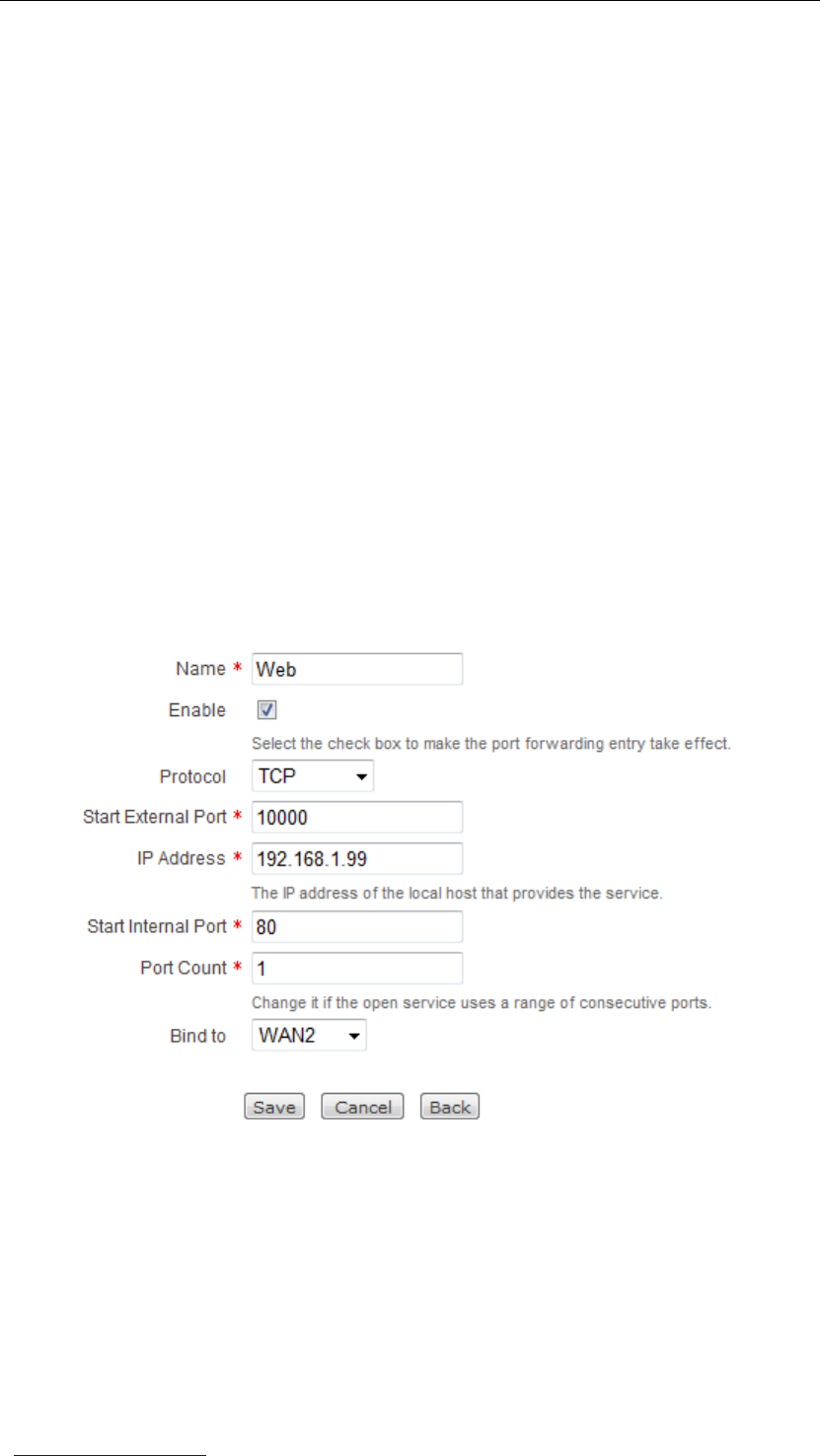
UTT Technologies Chapter 7 Advanced
http://www.uttglobal.com Page 105
Step 6 Select an interface from the Bind to drop-down list as required. The port
forwarding entry will use the selected interface’s IP address as its external IP
address.
Step 7 Click the Save button to save the settings. You can view the port forwarding
entry in the Port Forwarding List.
Step 8 If you want to add another new port forwarding entry, please repeat the above
steps.
7.1.2.4 Configuration Example for Port Forwarding
An organization wants a LAN server (IP Address: 192.168.1.99) to open Web service
(Protocol: TCP; Port: 80) to the outside users. And the Wireless Router will use 10000 as
the external port and the WAN2 IP address (200.200.200.88 in this example) as the
external IP address. Then all the requests to Web service from outside users to
200.200.200.88:10000 will be forwarded to 192.168.1.99:80.
The following figure shows the detailed settings.
Figure 7-3 Port Forwarding Settings - Example
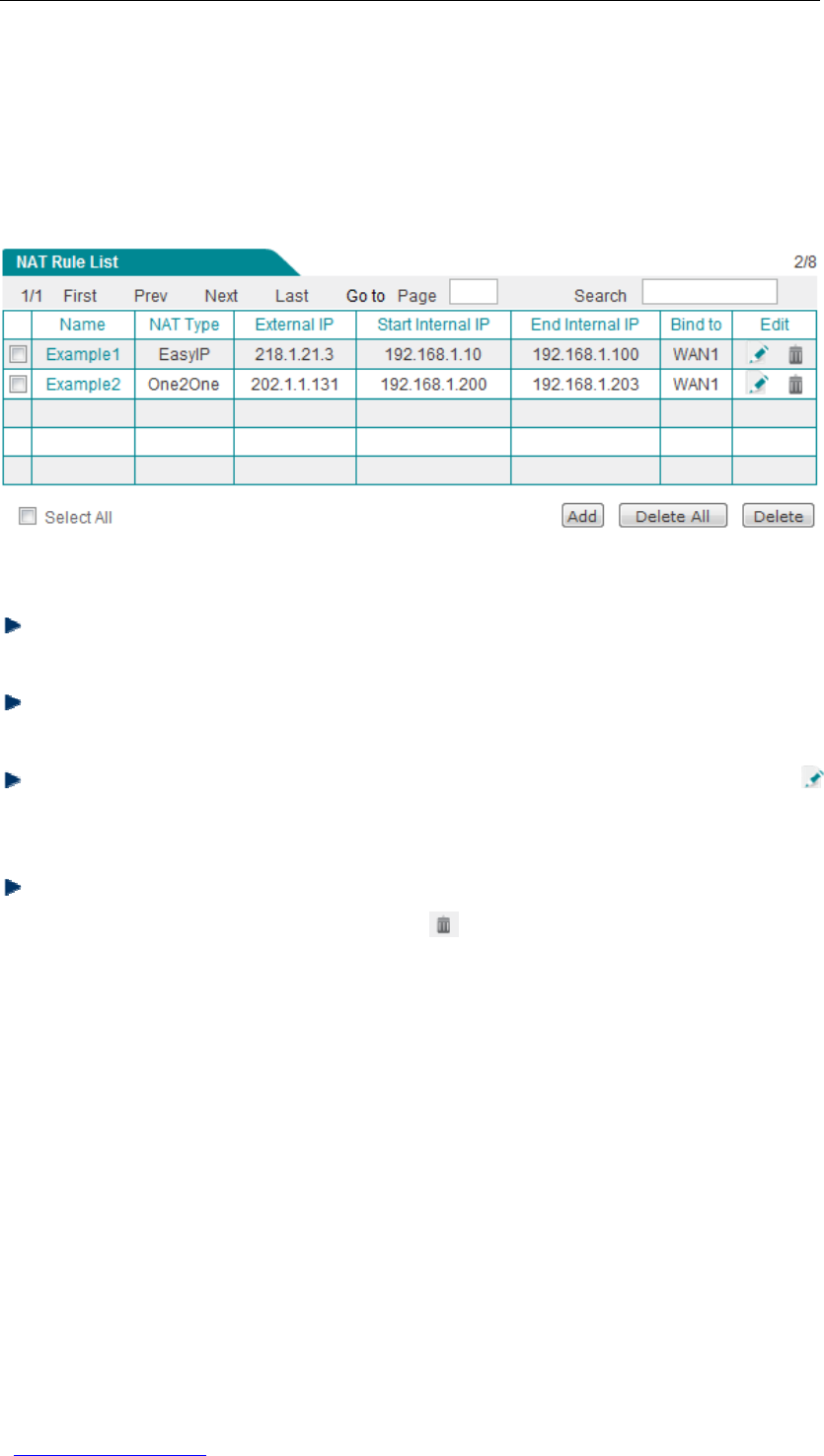
UTT Technologies Chapter 7 Advanced
http://www.uttglobal.com Page 106
7.1.3 NAT Rule
7.1.3.1 NAT Rule List
Figure 7-4 NAT Rule List
Add a NAT Rule: To add a new NAT rule, first click the Add button to go to the NAT
Rule Settings page, next configure it, lastly click the Save button.
View NAT Rule(s): When you have configured one or more NAT rules, you can view
them in the NAT Rule List.
Modify a NAT Rule: To modify a configured NAT rule, click its Name hyperlink or
icon, the related information will be displayed in the setup page. Then modify it, and
click the Save button.
Delete NAT Rule(s): There are three ways to delete NAT rules.
1. To delete a NAT rule, directly click its icon.
2. To delete more than one NAT rule at a time, select the leftmost check boxes of
the NAT rules that you want to delete, and then click the Delete button.
3. To delete all the NAT rules at a time, directly click the Delete All button.
7.1.3.2 NAT Rule Settings
The following sections describe the settings of the EasyIP NAT rule and One2One NAT
rule respectively, see Figure 7- 5 and Figure 7- 6.
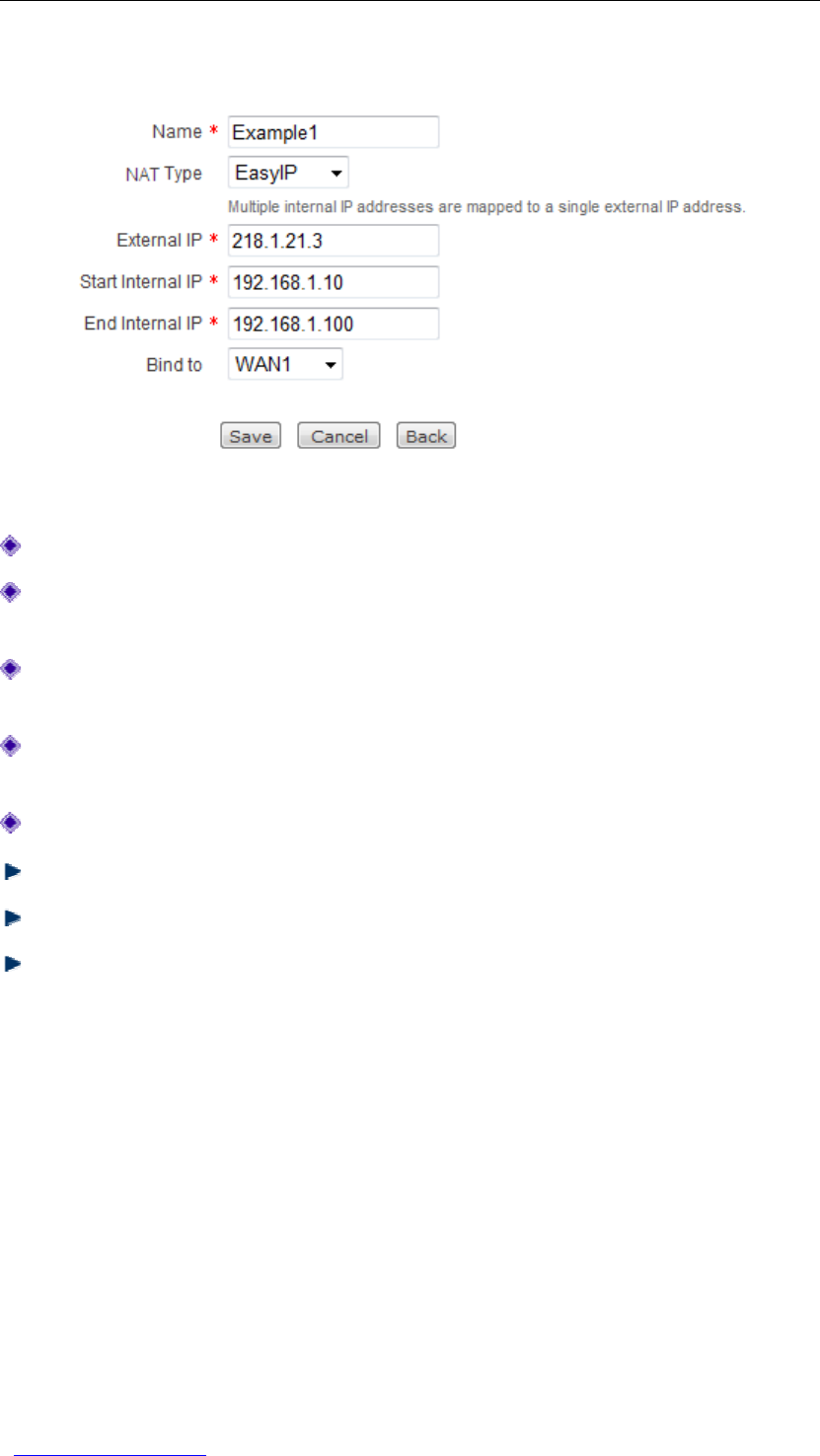
UTT Technologies Chapter 7 Advanced
http://www.uttglobal.com Page 107
7.1.3.2.1 NAT Rule Settings - EasyIP
Figure 7- 5 NAT Rule Settings - EasyIP
Name: It specifies a unique name of the NAT rule.
NAT Type: It specifies the type of the NAT rule. The available options are EasyIP and
One2One. Here please select EasyIP.
External IP: It specifies the external IP address to which the local computers’ IP
addresses are mapped.
Start Internal IP and End Internal IP: They specify a range of internal IP addresses.
The local computers within the specified range will preferentially use the NAT rule.
Bind to: It specifies the interface to which the NAT rule is bound.
Save: Click to save your changes.
Cancel: Click to revert to the last saved settings.
Back: ClicktogobacktotheNAT Rule List.
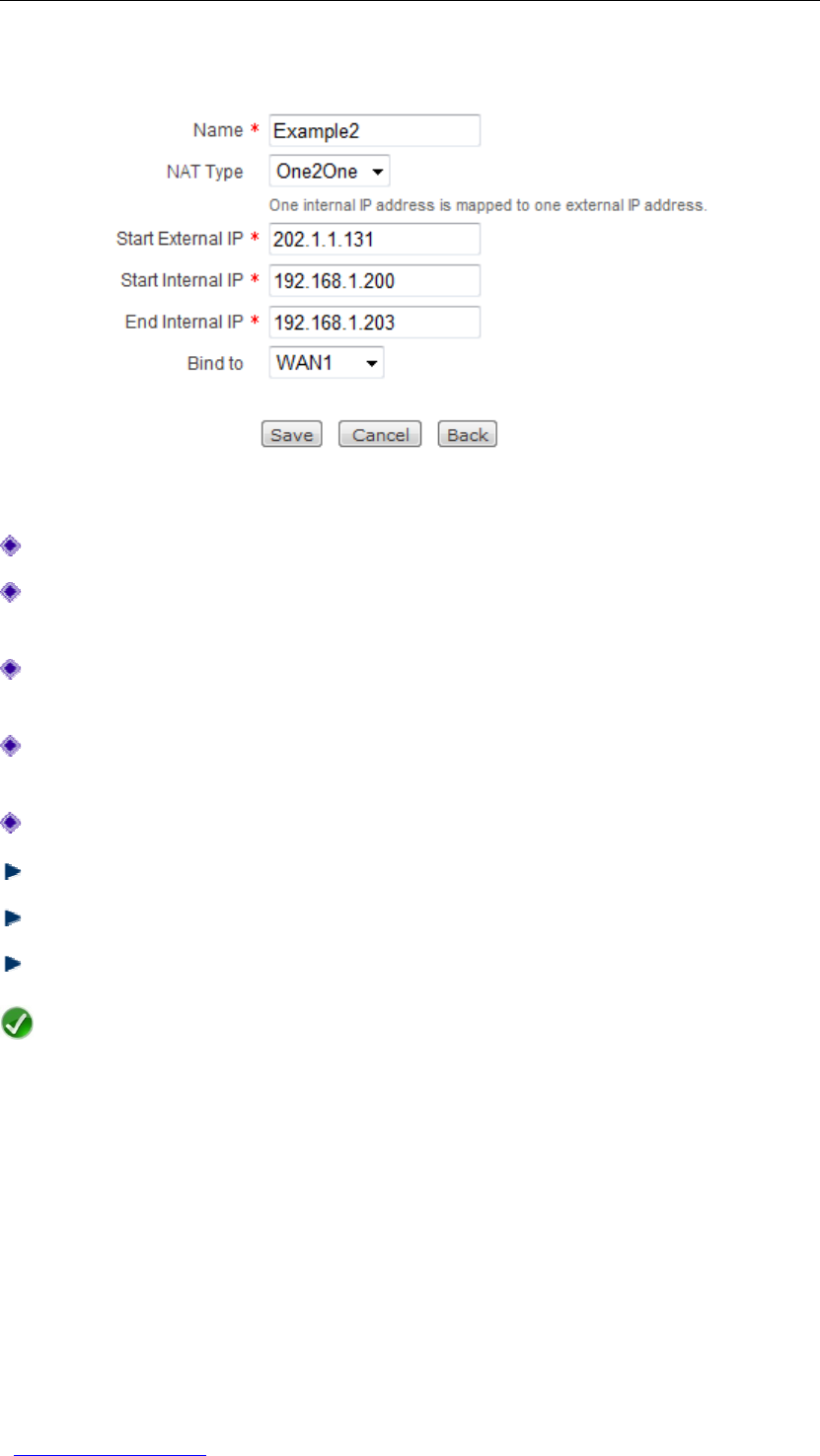
UTT Technologies Chapter 7 Advanced
http://www.uttglobal.com Page 108
7.1.3.2.2 NAT Rule Settings - One2One
Figure 7- 6 NAT Rule Settings - One2One
Name: It specifies a unique name of the NAT rule.
NAT Type: It specifies the type of the NAT rule. The available options are EasyIP and
One2One. Here please select One2One.
Start External IP: It specifies the start external IP address to which the start internal
IP address is mapped.
Start Internal IP and End Internal IP: They specify the internal IP address range of
the NAT rule.
Bind to: It specifies the interface to which the NAT rule is bound.
Save: Click to save your changes.
Cancel: Click to revert to the last saved settings.
Back: ClicktogobacktotheNAT Rule List.
Note
1. When creating a One2One NAT rule, you must set the Start External IP.The
number of the external IP addresses is the same as the number of internal IP
addresses, which is determined by the Start Internal IP and End Internal IP.For
example, if the Start Internal IP is 192.168.16.6, End Internal IP is 192.168.16.8,
and Start External IP is 200.200.200.116, then 192.168.16.6, 192.168.16.7, and
192.168.16.8 will be mapped to 200.200.200.116, 200.200.200.117, and
200.200.200.118 respectively.
2. A One2One NAT rule can contain up to 20 external/internal IP addresses.

UTT Technologies Chapter 7 Advanced
http://www.uttglobal.com Page 109
7.1.3.3 How to Add NAT Rules
To add one or more NAT rules, follow these steps:
Step 1 Please identify the type of the NAT rule that you want to add.
Step 2 Go to the Advanced > NAT > NAT Rule page, and click the Add button to go to
the NAT Rule Settings page.
Step 3 Specify the Name for the NAT rule, and select a type from the NAT Type
drop-down list as required.
Step 4 There are two cases:
1) If the NAT rules’ type is EasyIP, please specify the External IP,Start
Internal IP,andEnd Internal IP as required.
2) If the NAT rules’ type is One2One, please specify the Start External IP,
Start Internal IP,andEnd Internal IP as required.
Step 5 Select an interface from the Bind to drop-down list as required.
Step 6 Click the Save button to save the settings. You can view the NAT rule in the
NAT Rule List.
Step 7 If you want to add another new NAT rule, please repeat the above steps.
Note
If you want to delete NAT rule(s), please follow the ways described in Section 7.1.3.1
NAT Rule List.
7.1.3.4 Configuration Examples for NAT Rule
7.1.3.4.1 An Example for Configuring an EasyIP NAT Rule
1. Requirements
In this example, an Internet café has a single Internet connection, and obtains eight public
IP addresses (from 218.1.21.0/29 to 218.1.21.7/29) from the ISP. Therein, 218.1.21.1/29
is used as the Internet connection’s gateway IP address, 218.1.21.2/29 is used as the
Wireless Router’s WAN1 interface IP address. Note that 218.1.21.0/29 and 218.1.21.7/29
cannot be used as they are the subnet number and broadcast address respectively.
The administrator want the local computers in the online game area (its address range is
from 192.168.1.10/24 to 192.168.1.100/24) to use 218.1.21.3/29 to access the Internet. To
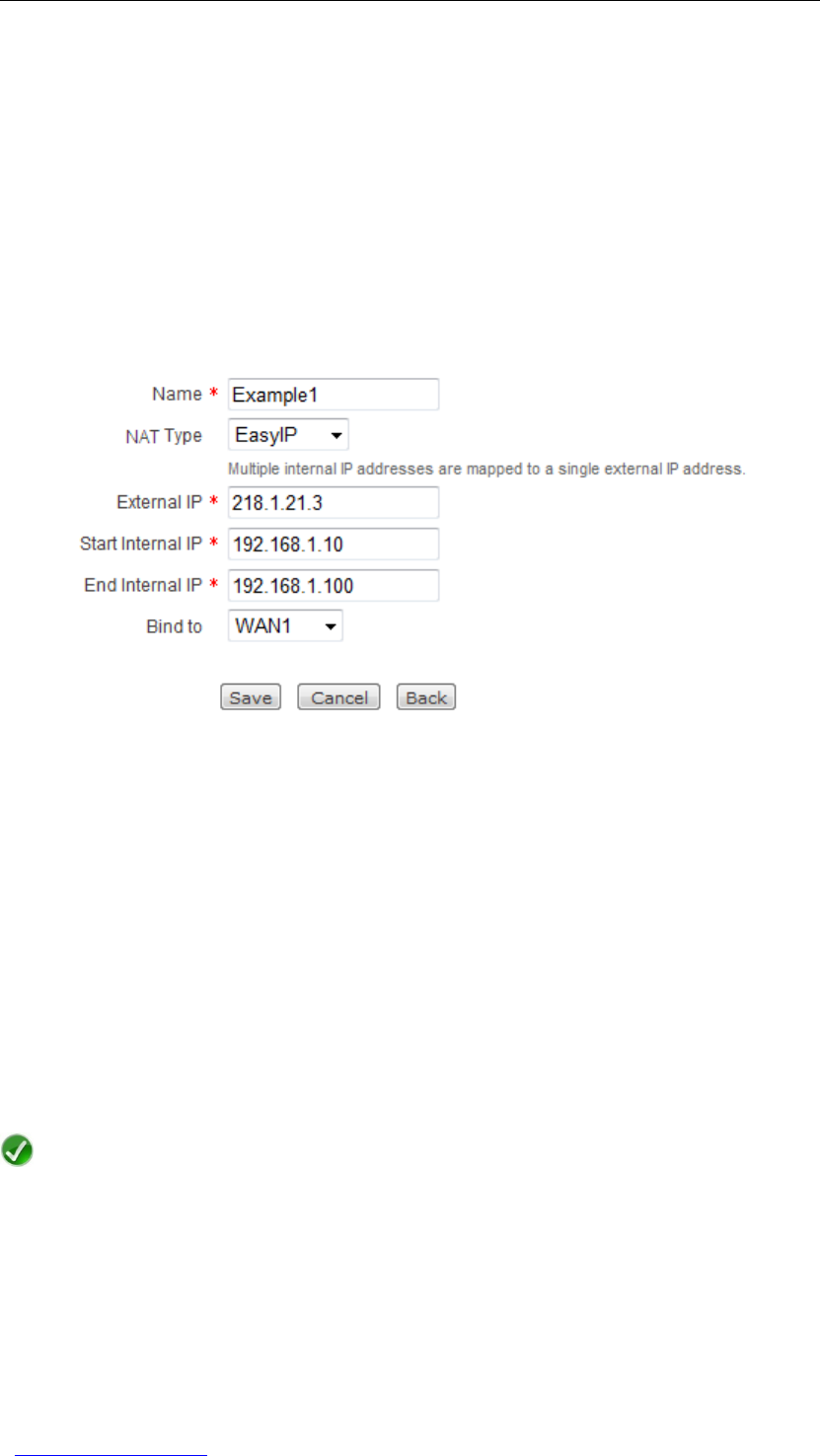
UTT Technologies Chapter 7 Advanced
http://www.uttglobal.com Page 110
achieve this purpose, he should create an EasyIP NAT rule for them. The rule’s External
IP is 218.1.21.3, Start Internal IP is 192.168.1.10, End Internal IP is 192.168.1.100, and
Bind to be WAN1.
2. Configuration Steps
The configuration steps are the following:
Step 1 Go to the Advanced > NAT > NAT Rule page, and click the Add button to go to
the NAT Rule Settings page, see the following figure.
Figure 7-7 EasyIP NAT Rule Settings - Example
Step 2 Enter Example1 in the Name text box.
Step 3 Select EasyIP from the NAT Type drop-down list.
Step 4 Enter 218.1.21.3 in the External IP text box; enter 192.168.1.10 and
192.168.1.100 in the Start Internal IP and End Internal IP text boxes
respectively.
Step 5 Select WAN1 from the Bind to drop-down list.
Step 6 Click the Save button to save the settings. Till now you have finished
configuring the NAT rule, and you can view it in the NAT Rule List.
Note
If an EasyIP NAT rule’s External IP is not on the same subnet as the IP address of the
interface to which the rule is bound, the Wireless Router’s default gateway requires a
subnet route for the network to which the External IP belongs, or a host route for the
External IP pointing to the bound interface.

UTT Technologies Chapter 7 Advanced
http://www.uttglobal.com Page 111
7.1.3.4.2 An Example for Configuring a One2One NAT Rule
1. Requirements
In this example, a business has a single static IP Internet connection, and obtains eight
public IP addresses (202.1.1.128/29 - 202.1.1.1.135/29) from the ISP. Therein,
202.1.1.129/29 is used as the Internet connection’s gateway IP address, 202.1.1.130/2 is
used as the Wireless Router’s WAN1 IP address. Note that 202.1.1.128/29 and
202.1.1.1.135/29 cannot be used as they are the subnet number and broadcast address
respectively.
The business wants its employees to share a single public IP address of 202.1.1.130/29
to access the Internet; and it wants its four local servers to provide services for the outside
users. The LAN subnet is 192.168.1.0/24. The four local servers IP addresses are from
192.168.1.200/24 to 192.168.1.203/24.
2. Analysis
Firstly we need to configure a static IP Internet connection on the WAN1 interface in the
Network > WAN page or through the Start > Setup Wizard. After you have configured
the Internet connection, the Wireless Router will automatically create a related system
reserved EasyIP NAT rule, and also enable NAT.
Secondly, we need to create a One2One NAT rule for the four local servers. The IP
addresses of the four local servers are mapped to 202.1.1.131/29, 202.1.1.132/29,
202.1.1.133/29, 202.1.1.134/29 respectively. Thus the outside users can use these public
addresses to access the local servers through the Wireless Router.
3. Configuration Steps
Here we only describe how to create the One2One NAT rule.
Step 1 Go to the Advanced > NAT > NAT Rule page, and click the Add button to go to
the NAT Rule Settings page, see the following figure.
Step 2 Enter Example2 in the Name text box.
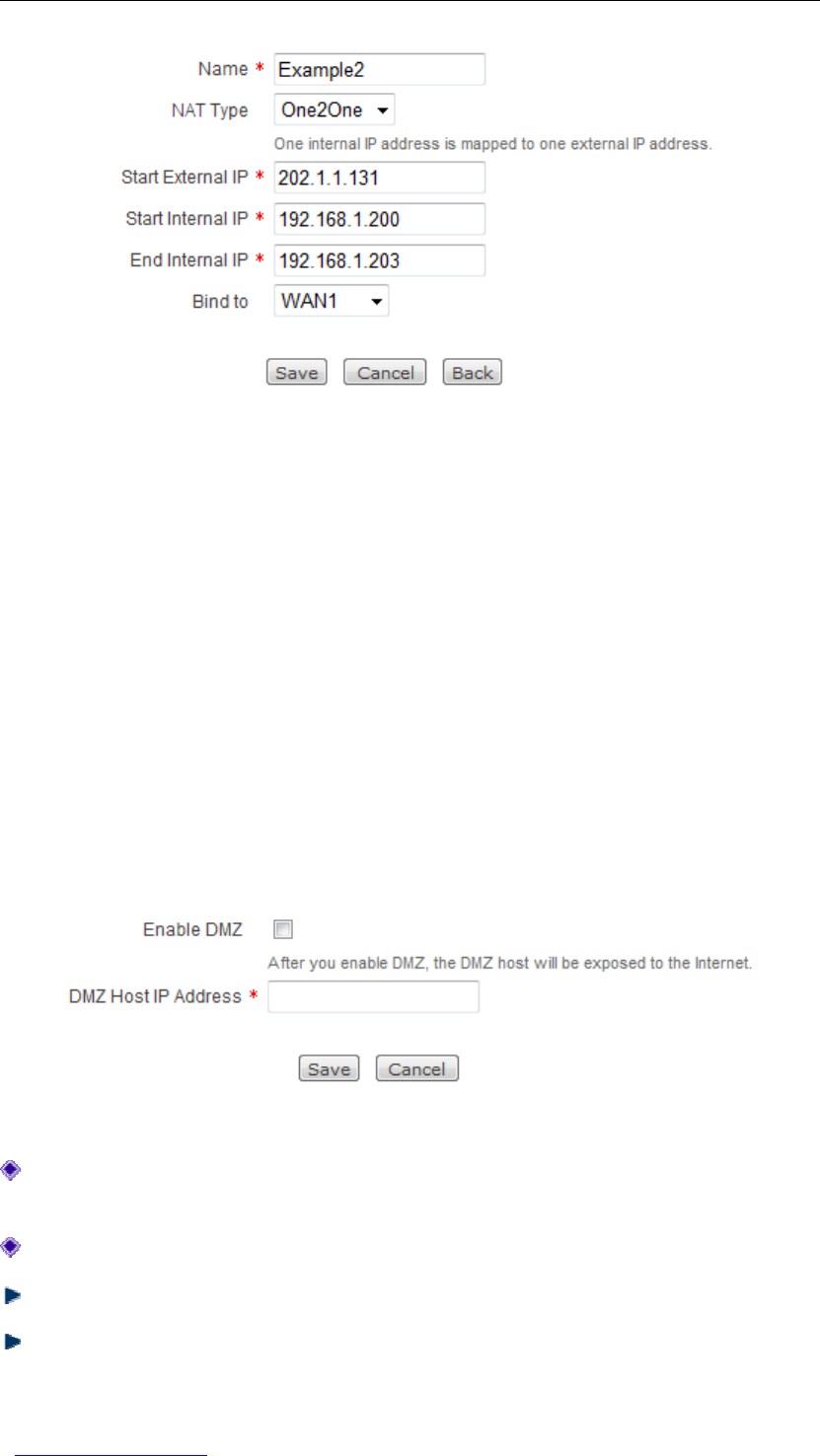
UTT Technologies Chapter 7 Advanced
http://www.uttglobal.com Page 112
Figure 7-8 One2One NAT Rule Settings - Example
Step 3 Select One2One from the NAT Type drop-down list.
Step 4 Enter 202.1.1.131 in the Start External IP text box; enter 192.168.1.200 and
192.168.1.203 in the Start Internal IP and End Internal IP text boxes
respectively.
Step 5 Select WAN1 from the Bind to drop-down list.
Step 6 Click the Save button to save the settings. Till now you have finished
configuring the NAT rule, and you can view it in the NAT Rule List.
7.1.4 DMZ
Figure 7-9 DMZ Host Settings
Enable DMZ: It allows you to enable or disable DMZ feature. If you want to enable
DMZ feature on the Wireless Router, please select this check box.
DMZ Host IP Address: It specifies the private IP address of the DMZ host.
Save: Click to save your changes.
Cancel: Click to revert to the last saved settings.

UTT Technologies Chapter 7 Advanced
http://www.uttglobal.com Page 113
Note
When a local computer is designated as the DMZ host, it loses firewall protection
provided by the Wireless Router. The DMZ host can be accessed through all the
WAN interfaces.

UTT Technologies Chapter 7 Advanced
http://www.uttglobal.com Page 114
7.2 IP/MAC Binding
This section describes the Security > IP/MAC Binding page.
7.2.1 Introduction to IP/MAC Binding
7.2.1.1 IP/MAC Binding Overview
To achieve network security management, you should perform user identification before
performing user authorization. In this section, we describe how to implement user
identification. In Section 9.1 Firewall > Access Control, we will describe how to control
the Internet behaviors of the LAN users in detail.
The Wireless Router provides IP/MAC binding feature to implement user identification.
Using the IP/MAC address pair as a unique user identity, you can protect the Wireless
Router and your network against IP spoofing attacks. IP spoofing attack refers to that a
computer attempts to use another trusted computer’s IP address to connect to or pass
through the Wireless Router. The computer’s IP address can easily be changed to a
trusted address, but MAC address cannot easily be changed as it is added to the Ethernet
card at the factory.
7.2.1.2 The Operation Principle of IP/MAC Binding
For the sake of convenience, we firstly introduce several related terms including legal user,
illegal user and undefined user.
●Legal User: A legal user’s IP and MAC address pair matches an IP/MAC binding
whose Allow check box is checked.
●Illegal User: An illegal user’s IP and MAC address pair matches an IP/MAC binding
whose Allow check box is cleared; or the IP address or MAC address is the same as
that of an IP/MAC binding, but not both.
●Undefined User: An undefined user’s IP address and MAC address both are
different from any IP/MAC binding. The undefined users are all the users except legal
and illegal users.
It allows the legal users to access the Wireless Router or access the Internet through the
Wireless Router, and denies the illegal users. And the parameter of Allow Undefined
LAN PCs determines whether it allows the undefined users to access the Wireless Router
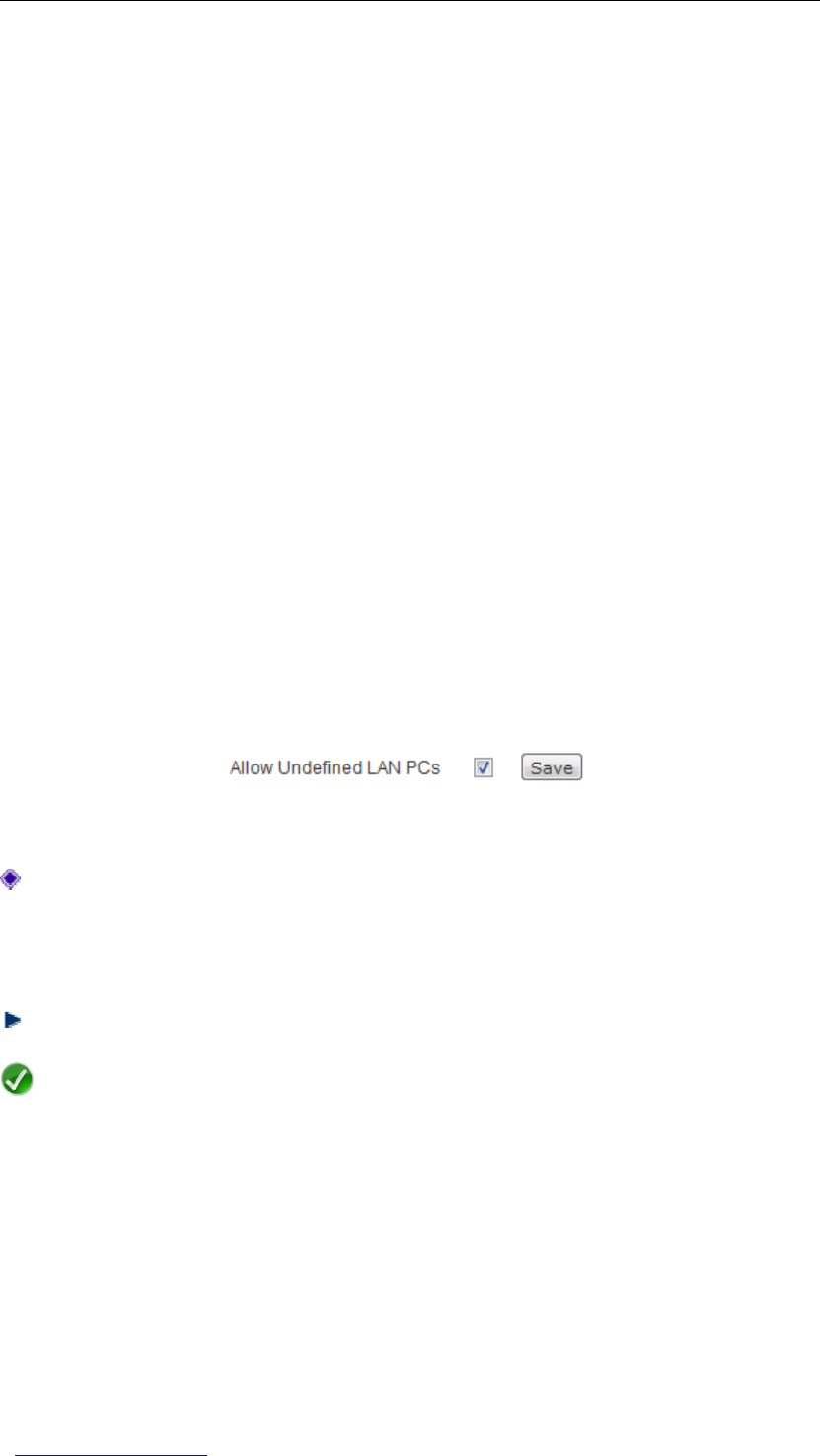
UTT Technologies Chapter 7 Advanced
http://www.uttglobal.com Page 115
or access the Internet through the Wireless Router, that is, it will allow them if they Allow
Undefined LAN PCs check box is checked, else block them.
IP/MAC binding feature can act on the packets initiated from the local computers to the
Wireless Router or outside computers. When receiving a packet initiated from LAN, the
Wireless Router will firstly determine the sender’s identity by comparing the packet with
the bindings in the IP/MAC Binding List, and then process the packet according to the
sender’s identity. The details are as follows:
1. If the sender is a legal user, the packet will be allowed to pass, and then be further
processed by other function modules.
2. If the sender is an illegal user, the packet will be dropped immediately to prevent IP
spoofing.
3. If the sender is an undefined user, there are two cases:
1) If the Allow Undefined LAN PCs check box is checked, the packet will be
allowed to pass, and then be further processed by other function modules.
2) Else, the packet will be dropped immediately.
7.2.2 IP/MAC Binding Global Settings
Figure 7- 10 IP/MAC Binding Global Settings
Allow Undefined LAN PCs: It allows or blocks the undefined local computers from
accessing the Wireless Router or accessing the Internet through the Wireless Router.
If you want to allow the undefined local computers to access the Wireless Router and
Internet, please select the check box.
Save: Click to save your changes.
Note
If you want to clear the Allow Undefined LAN PCs check box to block the undefined
local computers, please make sure that you have added the IP/MAC address pair of
the computer that you use to administer the Wireless Router into the IP/MAC
Binding List. Otherwise you cannot access the Wireless Router from that computer.
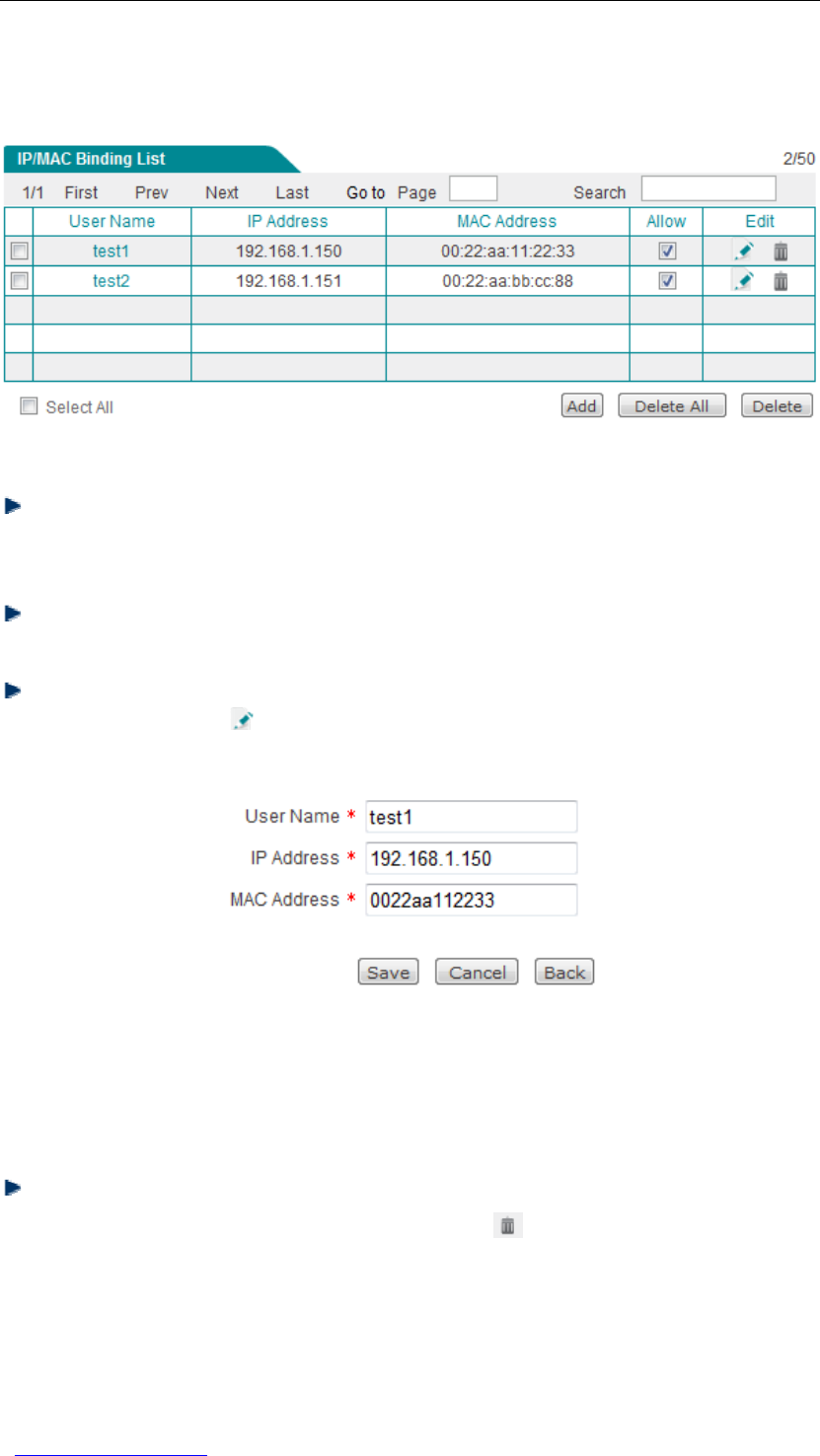
UTT Technologies Chapter 7 Advanced
http://www.uttglobal.com Page 116
7.2.3 IP/MAC Binding List
Figure 7-11 IP/MAC Binding List
Add One or More IP/MAC Bindings: To add one or more IP/MAC bindings, first click
the Add button to go to the IP/MAC Binding Settings page shown in Figure 7-14,
next configure them, lastly click the Save button.
View IP/MAC Binding(s): When you have configured one or more IP/MAC bindings,
you can view them in the IP/MAC Binding List.
Modify an IP/MAC Binding: To modify a configured IP/MAC binding, click its User
Name hyperlink or icon, the related information will be displayed in the setup
page shown in Figure 7- 12. Then modify it, and click the Save button.
Figure 7- 12 Modifying an IP/MAC Binding
The Allow check box is used to allow or block a user matching an IP/MAC binding
from accessing the Wireless Router and Internet. To allow the user matching the
IP/MAC binding to access, select the IP/MAC binding’s Allow check box; else clear it.
Delete IP/MAC binding(s): There are three ways to delete IP/MAC bindings.
1. To delete a IP/MAC binding, directly click its icon.
2. To delete more than one IP/MAC binding at a time, select the leftmost check
boxes of the bindings that you want to delete, and then click the Delete button.
3. To delete all the IP/MAC bindings at a time, directly click the Delete All button.
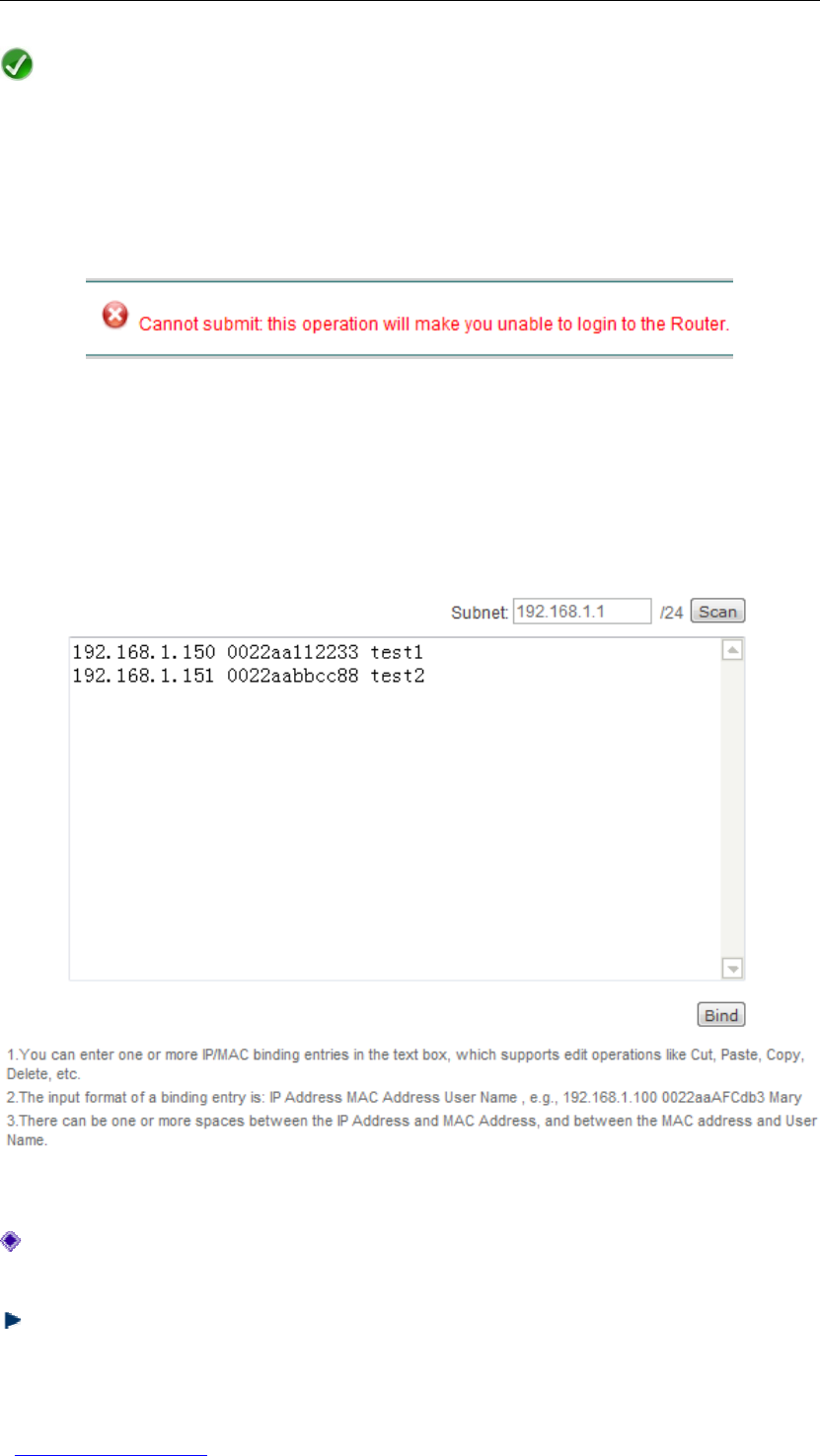
UTT Technologies Chapter 7 Advanced
http://www.uttglobal.com Page 117
Note
When you add the IP/MAC address pair of the computer that you use to administer
the Wireless Router into the IP/MAC Binding List, please leave the Allow check box
checked. Otherwise you cannot access the Wireless Router from that computer. If
you attempt to clear the check box, you will be prompted that the operation is not
permitted, see the following figure.
Figure 7- 13 IP/MAC Binding Error Message
7.2.4 IP/MAC Binding Settings
Figure 7- 14 IP/MAC Binding Settings
Subnet: It specifies the subnet you want to scan. The default is the Wireless Router’s
LAN IP address and subnet mask.
Scan: If you click the Scan button, the Wireless Router will immediately scan the
specified subnet to detect active computers connected to the Wireless Router, learn
and display dynamic ARP information (that is, IP and MAC address pairs) in the text

UTT Technologies Chapter 7 Advanced
http://www.uttglobal.com Page 118
box. Note that if a computer’s IP/MAC address pair has been added in the IP/MAC
Binding List, this IP/MAC address pair will not be displayed here.
Bind: Click to bind all the valid IP and MAC address pairs in the text box.
Add IP/MAC Binding(s) Manually: To manually add one or more IP/MAC bindings,
follow these steps: Enter one or more IP/MAC address pair entries in the text box,
and then click the Bind button. The input contents are: IP Address,MAC Address
and User Name, one address pair entry per line; and the input format for each entry
is: IP Address <Space> MAC Address <Space> User Name <Enter>.
●IP Address: It specifies the IP address of the local computer.
●MAC Address: It specifies the MAC address of the local computer.
●User Name: It specifies a unique user name of the local computer whose
IP/MAC address pair will be bound. It is an optional parameter. If you don’t enter
it, the system will automatically create a user name for the computer.
Note
1. You can use the ipconfig /all command at the command prompt to find a
Windows-based computer’s IP address and MAC address.
2. For an IP/MAC address pair entry entered manually, there can be one or more
spaces between the IP Address and MAC Address, and between the MAC address
and User Name.
3. The Bind operation will skip any invalid IP and MAC address pairs in the text box. In
other words, it will only bind the valid IP and MAC address pairs.
7.2.5 How to Add IP/MAC Bindings
To add one or more IP/MAC bindings, follow these steps:
Step 1 Go to the Advanced > IP/MAC Binding page, and click the Add button to go to
the IP/MAC Binding Settings page.
Step 2 There are two methods to add IP/MAC bindings:
1) Method One: Click the Scan button to learn current dynamic ARP
information (that is, IP and MAC address pairs) of the local computers, next
click the Bind button to bind the valid IP/MAC address pairs in the text box.
2) Method Two: You can manually add one or more IP/MAC address pairs in
the text box, next click the Bind button to bind these IP/MAC address pairs.
Refer to Section 7.2.4 IP/MAC Binding Settings for more information.

UTT Technologies Chapter 7 Advanced
http://www.uttglobal.com Page 119
Step 3 After you have added some IP/MAC bindings, you can view them in the IP/MAC
Binding List.
Step 4 If you want to block the undefined local computers from accessing the Wireless
Router and Internet, please clear the Allow Undefined LAN PCs check box;
else, the undefined local computers are allowed to access the Wireless Router
and Internet.
Step 5 If you want to temporarily block a user matching an IP/MAC binding from
accessing the Wireless Router and Internet, please clear the binding’s Allow
check box.
After you have finished configuring IP/MAC binding feature, when receiving a packet
initiated from LAN, the Wireless Router will firstly compare the packet with the bindings in
the IP/MAC Binding List, and then process the packet according to the related
configuration. The packet will be allowed to pass or be dropped immediately. If it is
allowed to pass, the packet will be further processed by other function modules.
7.2.6 Internet Whitelist and Blacklist
7.2.6.1 Introduction to Internet Whitelist and Blacklist
Based on IP/MAC Binding
By utilizing IP/MAC binding feature, you can flexibly configure an Internet whitelist or
blacklist for the LAN users.
If you want to allow only a small number of LAN users to access the Internet, you can
configure an Internet whitelist for these users. Then all users cannot access the Internet,
except those listed in the whitelist.
If you want to block only a small number of LAN users from accessing the Internet, you
can configure an Internet blacklist for these users. Then all users can access the Internet,
except those listed in the blacklist.
On the Wireless Router, a user listed in the whitelist is a legal user, i.e., the user’s IP and
MAC address pair matches an IP/MAC binding whose Allow check box is checked. A user
listed in the blacklist is an illegal user, i.e., the user’s IP and MAC address pair matches an
IP/MAC binding whose Allow check box is cleared; or the IP address or MAC address is
the same as that of an IP/MAC binding, but not both.
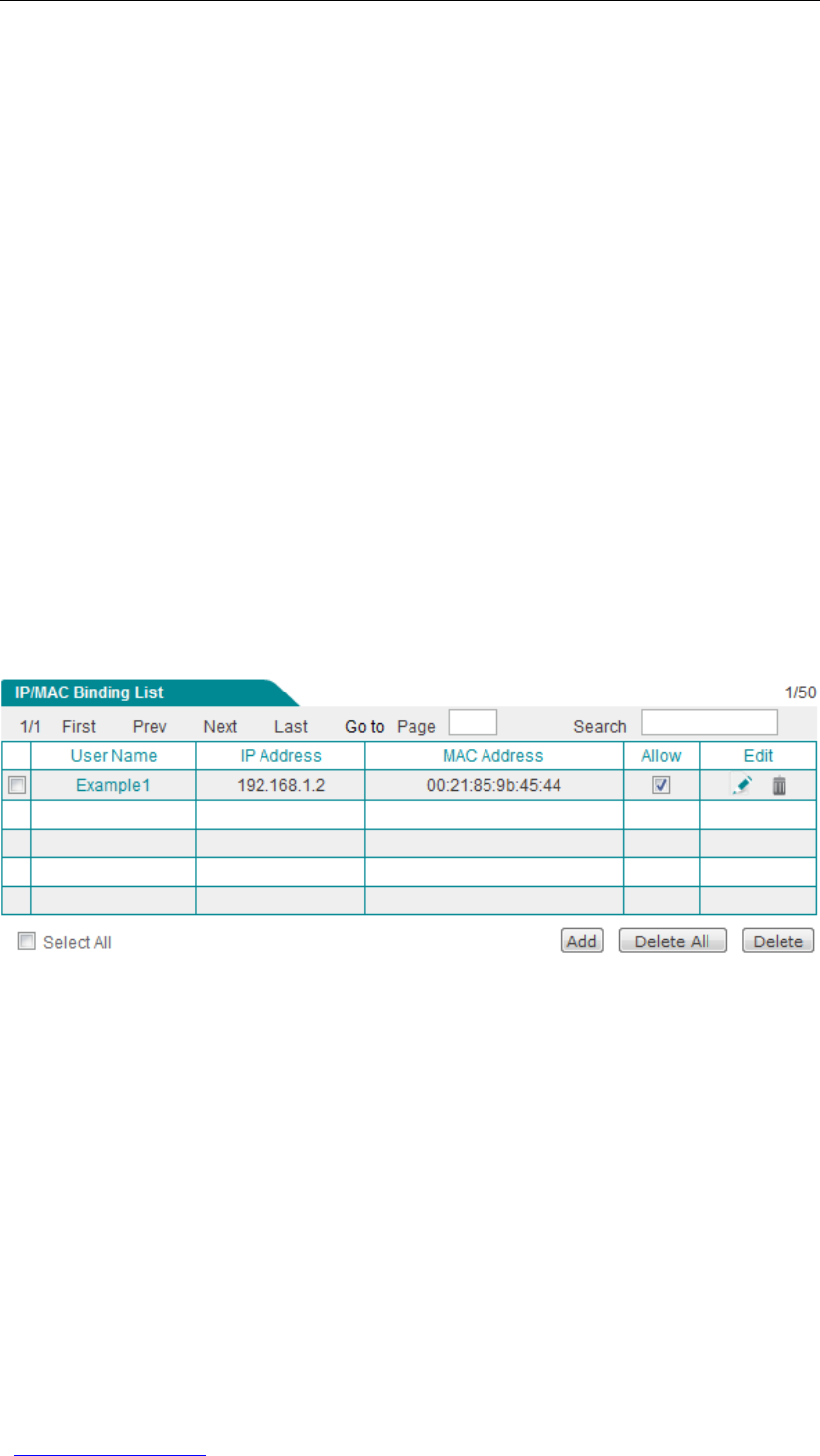
UTT Technologies Chapter 7 Advanced
http://www.uttglobal.com Page 120
7.2.6.2 How to Configure an Internet Whitelist
To configure an Internet whitelist, follow these steps:
Step 1 Go to the Advanced > IP/MAC Binding page, and click the Add button to go to
the IP/MAC Binding Settings page.
Step 2 Specify the legal users by creating the IP/MAC bindings: Add these users’ IP
and MAC address pairs into the IP/MAC Binding List. By default, an IP/MAC
binding’s Allow check box is checked, which means that the user matching the
IP/MAC binding can access the Wireless Router and Internet, so please leave
the default value. Refer to Section 7.2.4 IP/MAC Binding Settings for detailed
information.
Step 3 Clear the Allow Undefined LAN PCs check box to block all the undefined
users from accessing the Wireless Router and Internet.
For example, if you want to allow a local computer with IP address 192.168.1.2 and MAC
address 0021859b4544 to access the Wireless Router and Internet, you can add its
IP/MAC address pair into the IP/MAC Binding List, see Figure 7- 15. The binding’s Allow
check box is checked by default, so please leave the default value.
Figure 7- 15 IP/MAC Binding List - Example 1
7.2.6.3 How to Configure an Internet Blacklist
To configure an Internet blacklist, follow these steps:
Step 1 Go to the Advanced > IP/MAC Binding page, and click the Add button to go to
the IP/MAC Binding Settings page.
Step 2 Specify the illegal users by creating the IP/MAC bindings. There are two
methods (Refer to Section 7.2.4 IP/MAC Binding Settings for detailed
information.):
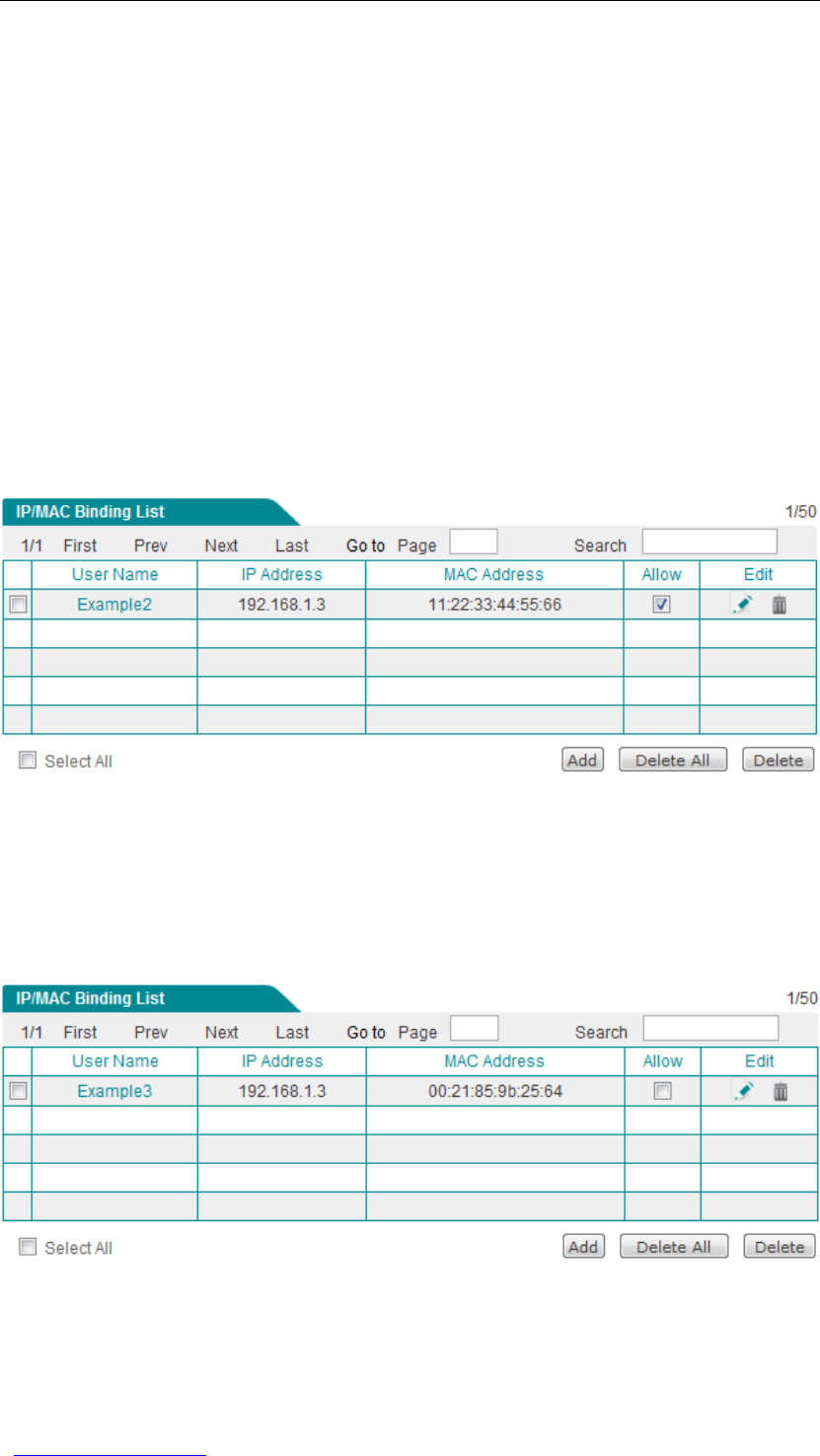
UTT Technologies Chapter 7 Advanced
http://www.uttglobal.com Page 121
1) Method One: Bind each illegal user’s IP address to a MAC address which is
different from any local computer’s, and add these IP/MAC address pairs
into the IP/MAC Binding List.
2) Method Two: Add these users’ IP and MAC address pairs into the IP/MAC
Binding List, and clear each IP/MAC binding’s Allow check box
respectively. Thus the matched users cannot access the Wireless Router
and Internet.
Step 3 Select the Allow Undefined LAN PCs check box to allow all the undefined
users to access the Wireless Router and Internet.
For example, if you want to block a local computer with IP address 192.168.1.3 from
accessing the Wireless Router and Internet, you can add an IP/MAC binding into the
IP/MAC Binding List:theIP Address is 192.168.1.3, and the MAC Address is different
from any local computer’s MAC address (112233445566 here), see Figure 7- 16.
Figure 7- 16 IP/MAC Binding List - Example 2
Another example is that if you want to block a local computer with IP address 192.168.1.3
and MAC address 0021859b2564 from accessing the Wireless Router and Internet, you
can add its IP/MAC address pair into the IP/MAC Binding List, next clear the binding’s
Allow check box, see Figure 7- 17.
Figure 7- 17 IP/MAC Binding List - Example 3
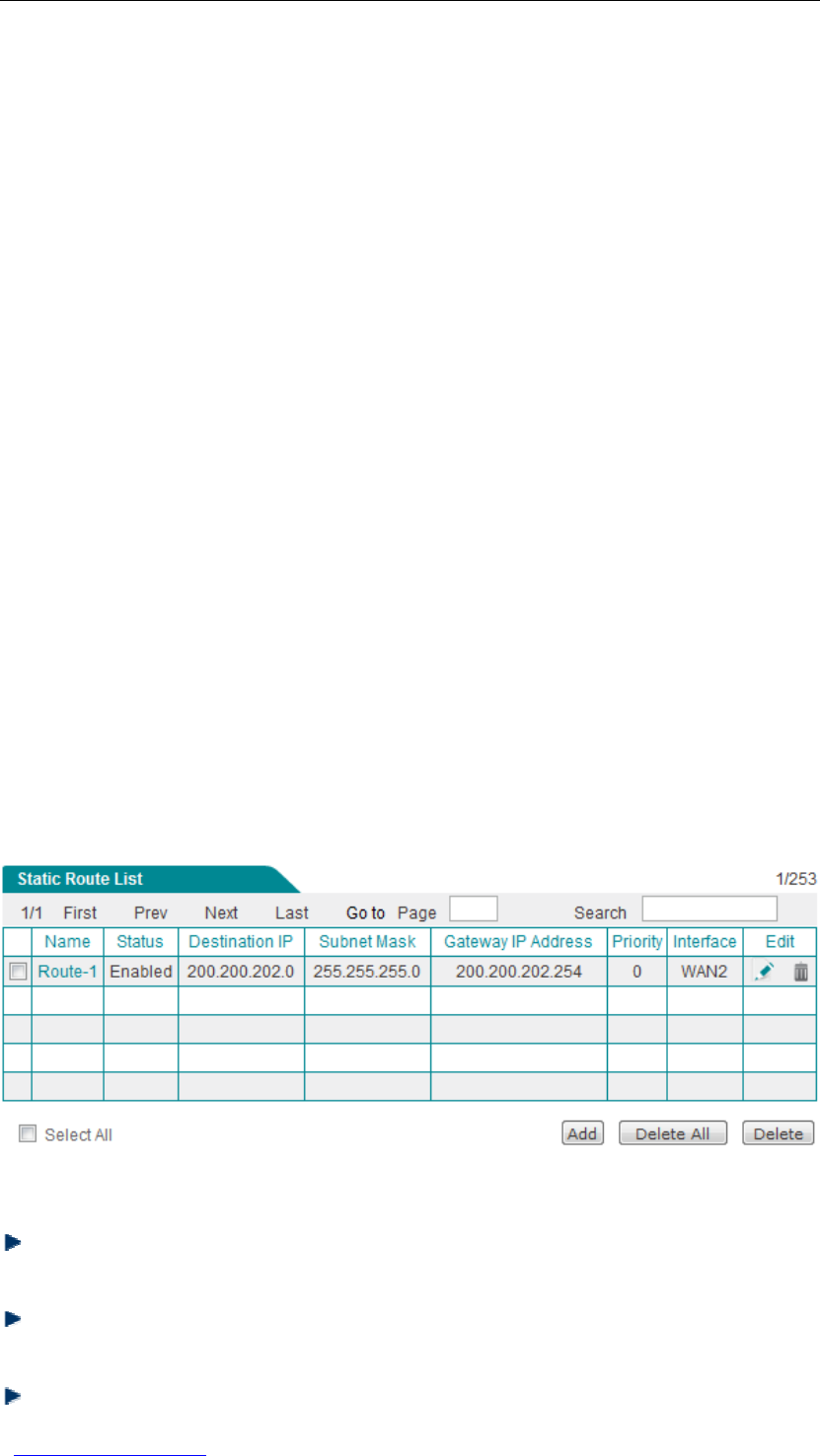
UTT Technologies Chapter 7 Advanced
http://www.uttglobal.com Page 122
7.3 Static Route
This section describes the Advanced > Static Route page, where you can configure and
view static routes.
7.3.1 Introduction to Static Route
A static route is manually configured by the network administrator, which is stored in a
routing table. By using routing table, the Wireless Router can select an optimal
transmission path for each received packet, and forward the packet to the destination site
effectively. The proper usage of static routes can not only improve the network
performance, but also achieve other benefits, such as traffic control, provide a secure
network environment.
The disadvantage of using static routes is that they cannot dynamically adapt to the
current operational state of the network. When there is a change in the network or a failure
occurs, some static routes will be unreachable. In this case, the network administrator
should update the static routes manually.
7.3.2 Static Route List
Figure 7-18 Static Route List
Add a Static Route: To add a new static route, first click the Add button to go to the
setup page, next configure it, lastly click the Save button.
View Static Route(s): When you have configured one or more static routes, you can
view them in the Static Route List.
Modify a Static Route: To modify a configured static route, click its Name hyperlink
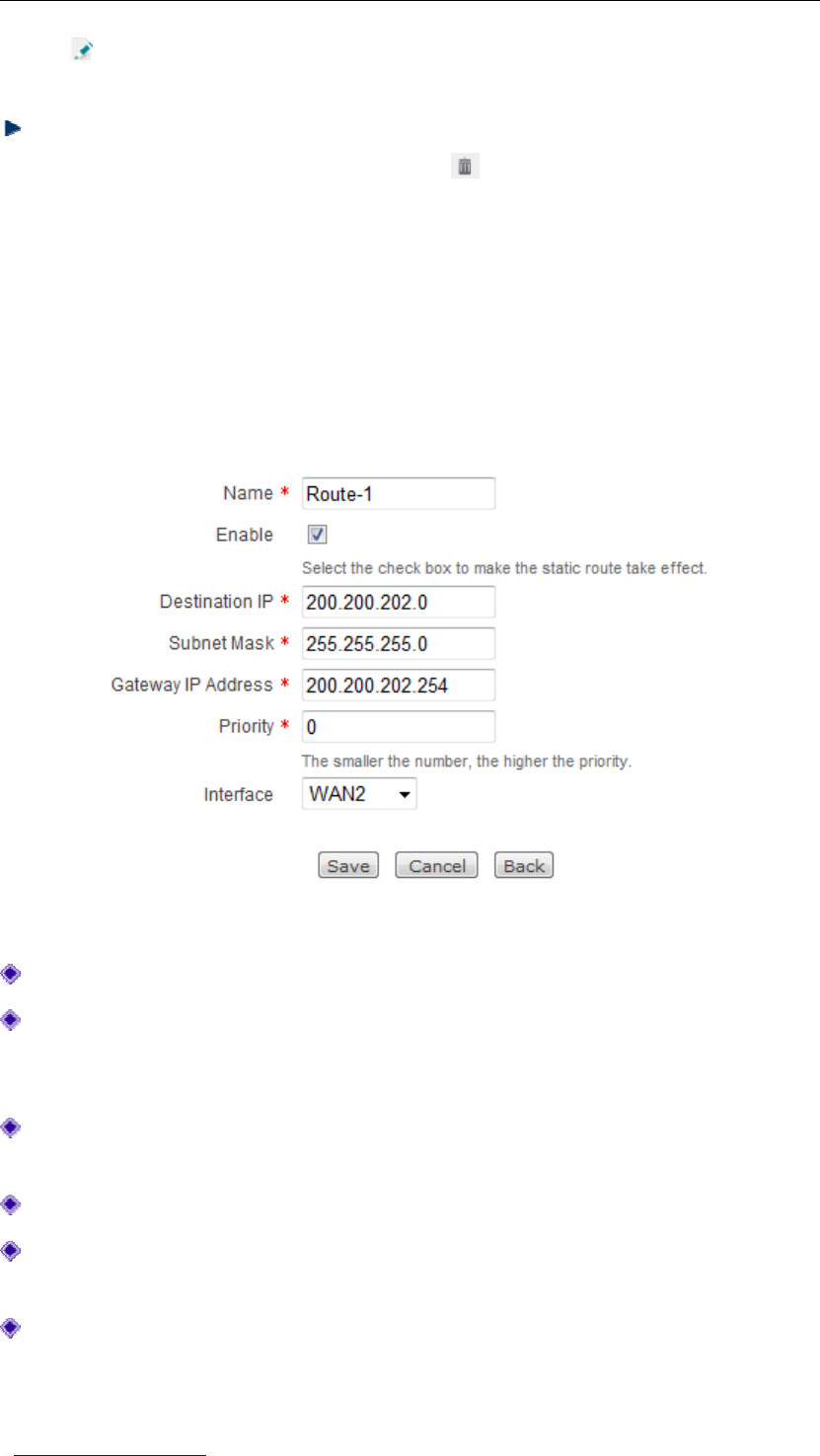
UTT Technologies Chapter 7 Advanced
http://www.uttglobal.com Page 123
or icon, the related information will be displayed in the setup page. Then modify it,
and click the Save button.
Delete Static Route(s): There are three ways to delete static route(s).
1. To delete a static route, directly click its icon.
2. To delete more than one static route at a time, select the leftmost check boxes of
the static routes that you want to delete, and then click the Delete button.
3. To delete all the static routes at a time, directly click the Delete All button.
7.3.3 Static Route Settings
Figure 7- 19 Static Route Settings
Name: It specifies a unique name of the static route.
Enable: It allows you to enable or disable the static route. The default value is
checked, which means the static route is in effect. If you want to disable the static
route temporarily instead of deleting it, please clear the check box.
Destination IP: It specifies the IP address of the destination network or destination
host.
Subnet Mask: It specifies the subnet mask associated with the destination network.
Gateway IP Address: It specifies the IP address of the next hop gateway or router to
which to forward the packets.
Priority: It specifies the priority of the static route. If there are multiple routes to the
same destination with different priorities, the Wireless Router will choose the route
with the highest priority to forward the packets. The smaller the number, the higher
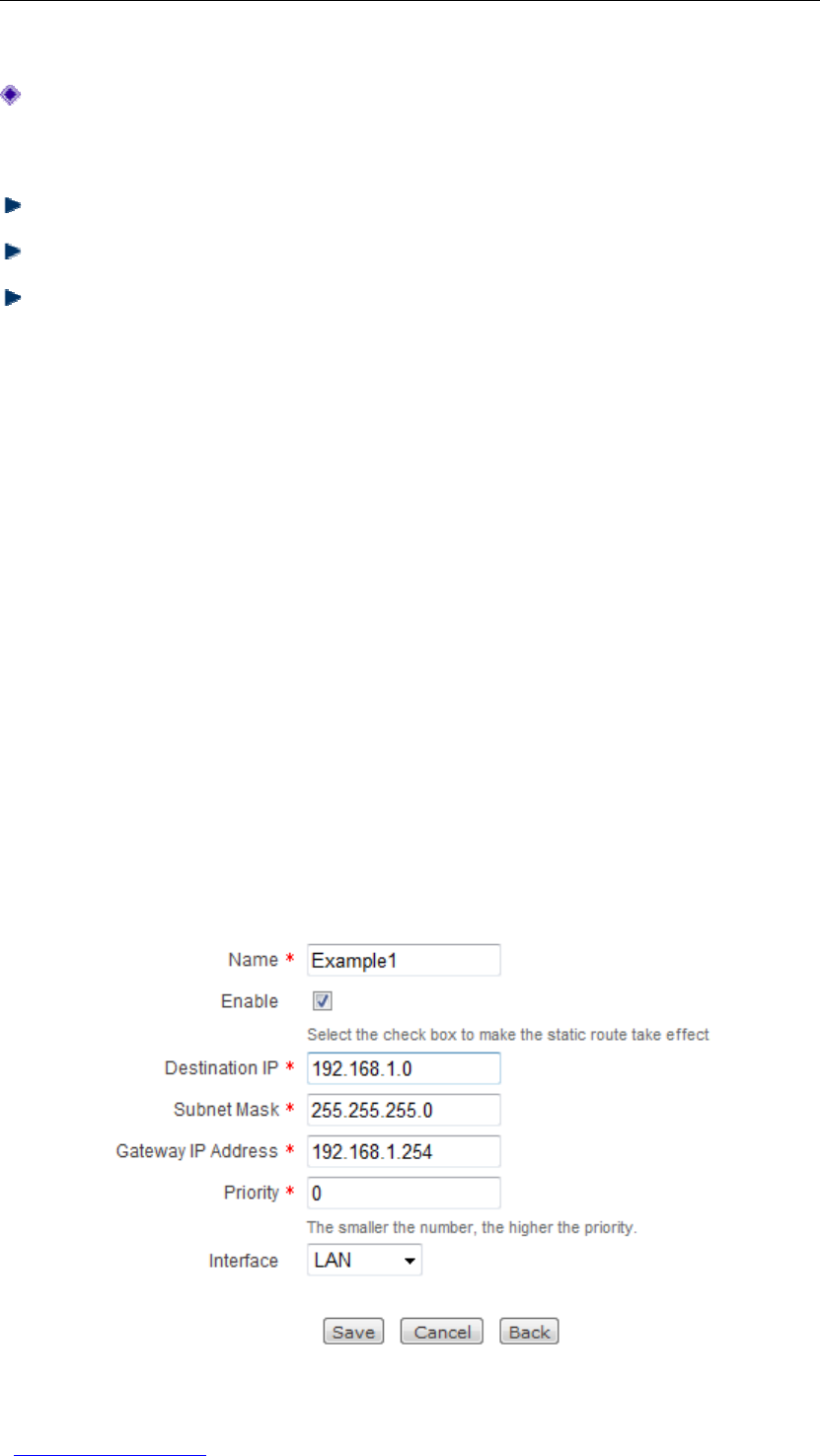
UTT Technologies Chapter 7 Advanced
http://www.uttglobal.com Page 124
the priority.
Interface: It specifies an outbound interface through which the packets are forwarded
to the next hop gateway or router. The available options are LAN, WAN1, WAN2,
APClient and 3G.
Save: Click to save your changes.
Cancel: Click to revert to the last saved settings.
Back: ClicktogobacktotheStatic Route List.
7.3.4 How to Add Static Routes
To add one or more static routes, follow these steps:
Step 1 Go to the Advanced > Static Route page, and click the Add button to go to the
setup page.
Step 2 Specify the Name for the static route, and leave the Enable check box
checked.
Step 3 Specify the Destination IP,Subnet Mask,andGateway IP Address.
Step 4 Specify the Priority as required.
Step 5 Select an outbound interface from the Interface drop-down list as required.
For example, if you want to add a static route for the network 192.168.1.0/24 pointing to
192.168.1.254, please choose LAN as the outbound interface. The following figure shows
the detailed settings.
Figure 7- 20 Static Route Settings - Example

UTT Technologies Chapter 7 Advanced
http://www.uttglobal.com Page 125
Step 6 Click the Save button to save the settings. You can view the static route in the
Static Route List.
Step 7 To add another new static route, please repeat the above steps.
Note
If you want to delete static route(s), please follow the ways described in Section 7.3.2
Static Route List.
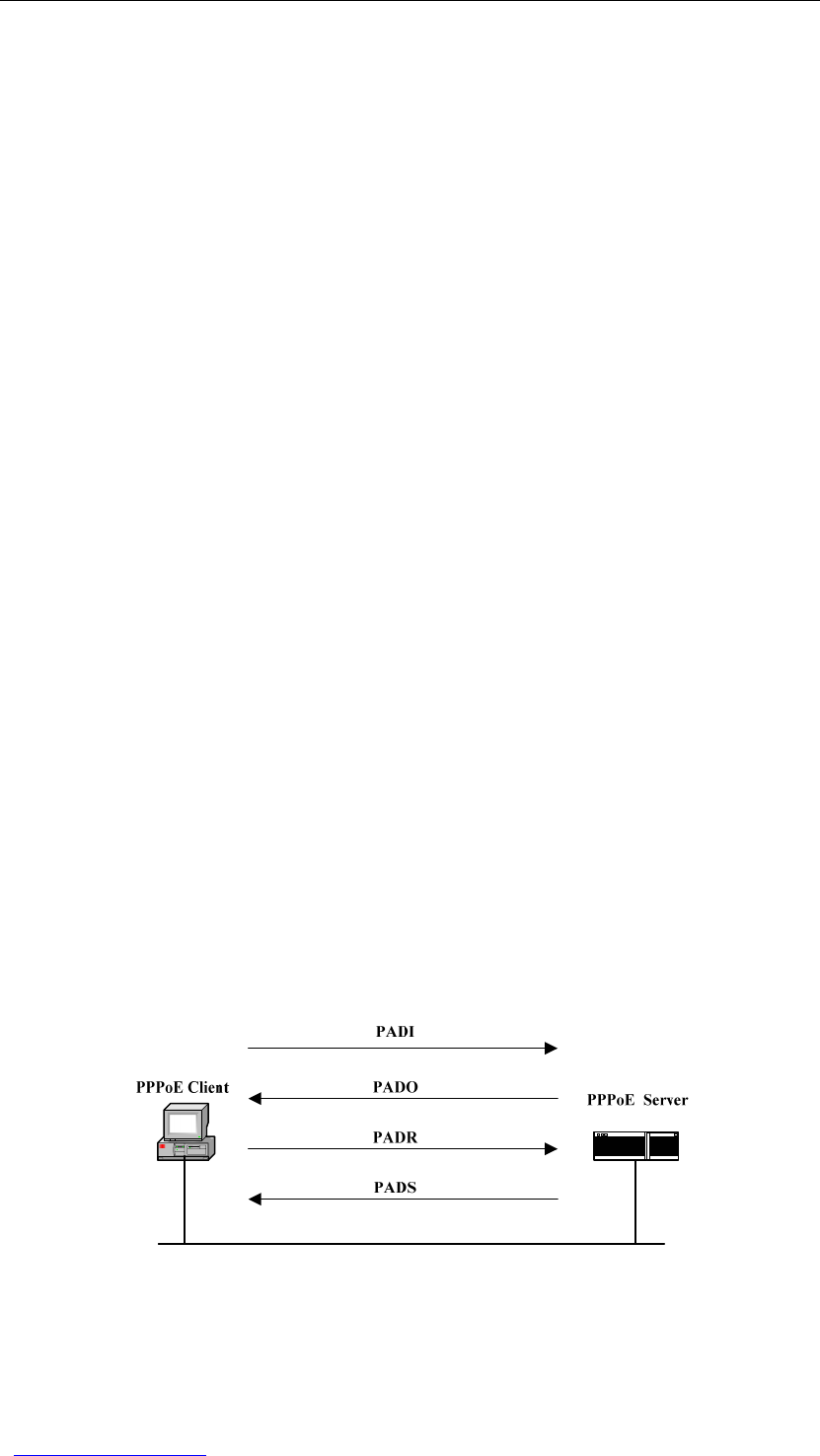
UTT Technologies Chapter 7 Advanced
http://www.uttglobal.com Page 126
7.4 PPPoE Server
This section describes how to configure PPPoE server global settings and PPPoE
account settings, and how to view PPPoE user status.
7.4.1 PPPoE Overview
The PPPoE stands for Point-to-Point Protocol over Ethernet, which uses client/server
model. The PPPoE provides the ability to connect the Ethernet hosts to a remote Access
Concentrator (AC) over a simple bridging access device. And it provides extensive access
control management and accounting benefits to ISPs and network administrators.
The PPPoE is a network protocol for encapsulating PPP frames in Ethernet frames to
provide point-to-point connection over an Ethernet network.
7.4.1.1 PPPoE Stages
As specified in RFC 2516, the PPPoE has two distinct stages: a discovery stage and a
PPP session stage. The following describes them respectively.
7.4.1.2 PPPoE Discovery Stage
In the PPPoE discovery stage, a PPPoE client will find a proper server, and then build the
connection. When a client initiates a PPPoE session, it should perform discovery to
indentify the PPPoE server’s Ethernet MAC address, and establish a PPPoE session ID.
Figure 7- 21 PPPoE Discovery Stage Flows
As shown in Figure 7-21, the discovery stage includes the following four steps:
1. PADI (PPPoE Active Discovery Initiation): At the beginning, a PPPoE client

UTT Technologies Chapter 7 Advanced
http://www.uttglobal.com Page 127
broadcasts a PADI packet to find all the servers that can be connected possibly. Until
it receives PADO packets from one or more servers. The PADI packet must contain a
service name which indicates the service requested by the client.
2. PADO (PPPoE Active Discovery Offer): When a PPPoE server receives a PADI
packet in its service range, it will send a PADO response packet. The PADO packet
must contain the server’s name, and a service name identical to the one in the PADI,
and any number of other service names which indicate other services that the PPPoE
server can offer. If a PPPoE server receives a PADI packet beyond its service range,
it cannot respond with a PADO packet.
3. PADR (PPPoE Active Discovery Request): The client may receive more than one
PADO packet as the PADI was broadcast. The client chooses one server according
to the server’s name or the services offered. Then the client sends a PADR packet to
the selected server. The PADR packet must contain a service name which indicates
the service requested by the client.
4. PADS (PPPoE Active Discovery Session- confirmation): When a PPPoE server
receives a PADR packet; it prepares to begin a PPP session. It generates a unique
PPPoE session ID, and respond to the client with a PADS packet. The PADS packet
must contain a service name which indicates the service provided to the client.
When the discovery stage completes successfully, both the server and client know the
PPPoE session ID and the peer's Ethernet MAC address, which together define the
PPPoE session uniquely.
7.4.1.3 PPP Session Stage
In the PPP session stage, the server and client perform standard PPP negotiation to
establish a PPP connection. After the PPP connection is established successfully, the
original datagram are encapsulated in PPP frames, and PPP frames are encapsulated in
PPPoE session frames, which have the Ethernet type 0x8864. Then these Ethernet
frames are sent to the peer. In a PPPoE session frame, the session ID must be the value
assigned in the Discovery stage, and cannot be changed in this session.
7.4.1.4 PPPoE Session Termination
After a session is established, either the server or client may send a PADT (PPPoE Active
Discovery Terminate) packet at anytime to indicate the session has been terminated. The
PADT packet’s SESSION-ID must be set, to indicate which session is to be terminated.
Once received a PADT, no further PPP packets (even normal PPP termination packets)
are allowed to be sent using the specified session. A PPP peer should use the PPP
protocol itself to terminate a PPPoE session, but can use the PADT packet to terminate
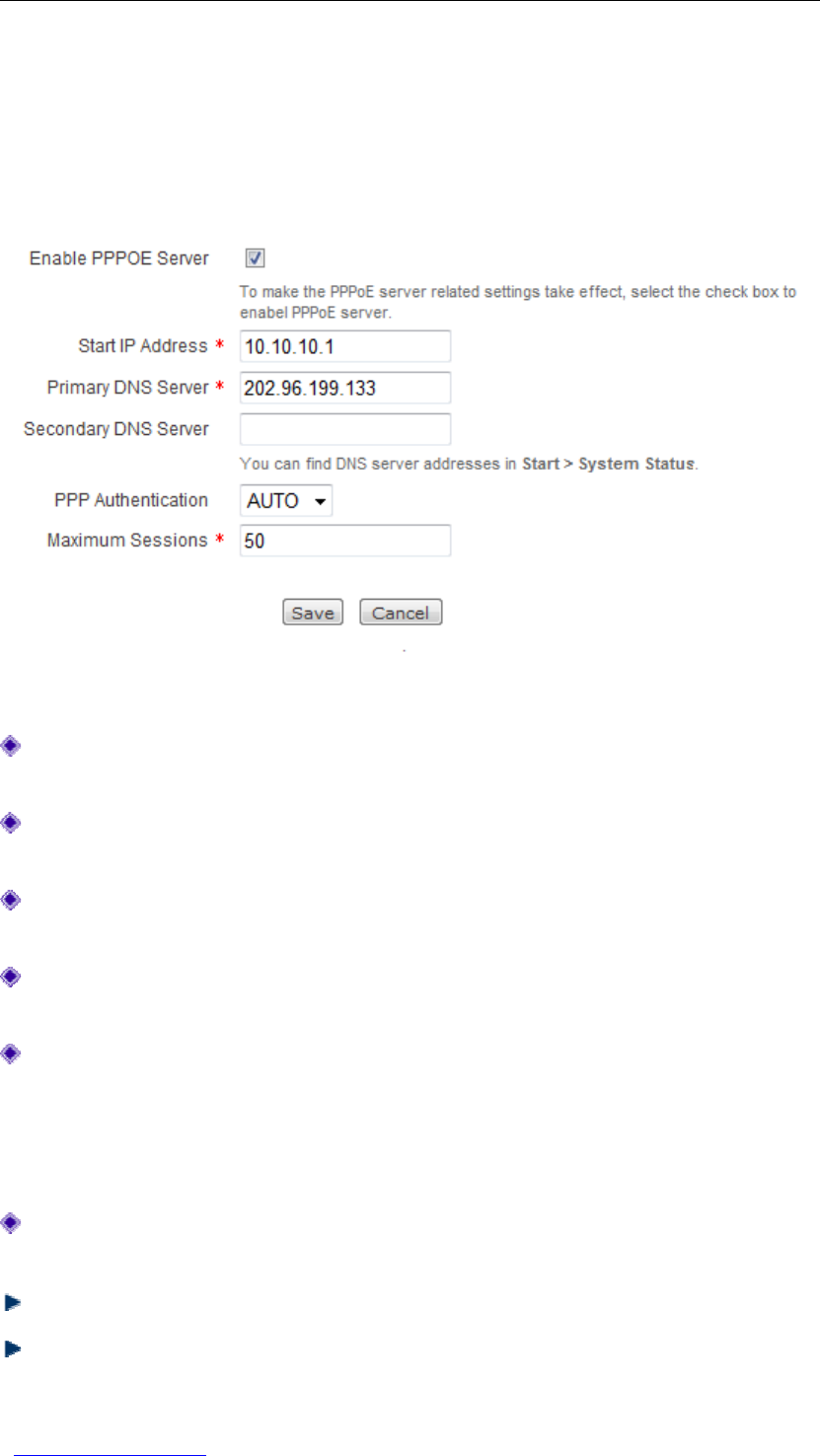
UTT Technologies Chapter 7 Advanced
http://www.uttglobal.com Page 128
the PPPoE session if PPP cannot be used.
7.4.2 PPPoE Server Global Settings
Figure 7-22 PPPoE Server Global Settings
Enable PPPoE Server: It allows you to enable or disable PPPoE server. If you want
to enable PPPoE server on the Wireless Router, please select this check box.
Start IP Address: It specifies the starting IP address that is assigned by the PPPoE
server.
Primary DNS Server: It specifies the IP address of the primary DNS server that is
available to a PPPoE client.
Secondary DNS Server: It specifies the IP address of the secondary DNS server
that is available to a PPPoE client.
PPP Authentication: It specifies the PPP authentication mode by which the PPPoE
server authenticates a PPPoE client. The available options are PAP,CHAP and
AUTO. In most cases, please leave the default value of AUTO, which means that the
Wireless Router will automatically choose PAP or CHAP to authenticate the PPPoE
client.
Maximum Sessions: It specifies the maximum number of PPPoE sessions that can
be created on the Wireless Router.
Save: Click to save your changes.
Cancel: Click to revert to the last saved settings.
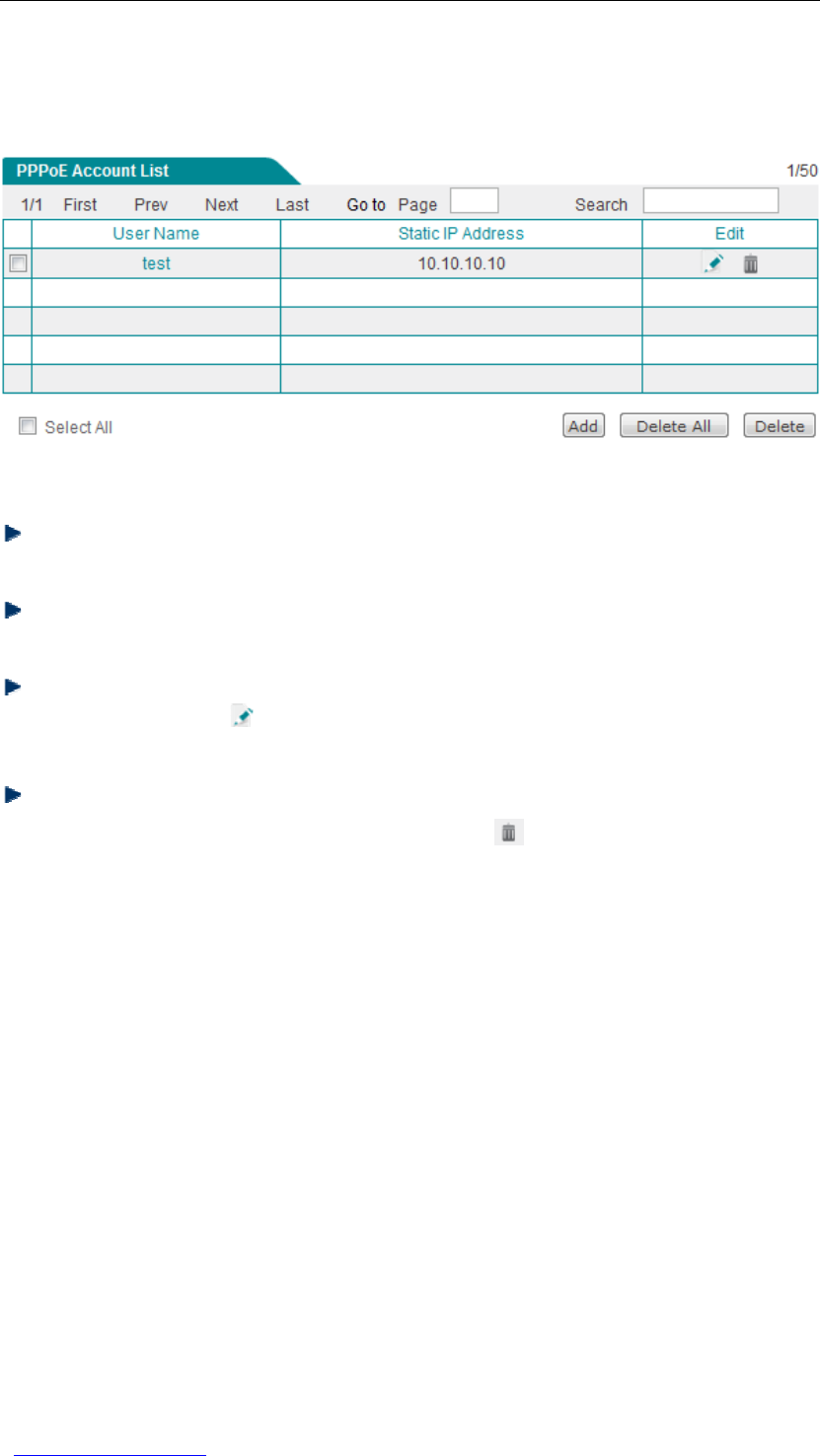
UTT Technologies Chapter 7 Advanced
http://www.uttglobal.com Page 129
7.4.3 PPPoE Account List
Figure 7- 23 PPPoE Account List
Add a PPPoE Account: To add a new PPPoE account, first click the Add button to
go to the setup page, next configure it, lastly click the Save button.
View PPPoE Account(s): When you have configured one or more PPPoE accounts,
you can view them in the PPPoE Account List.
Modify a PPPoE Account: To modify a configured PPPoE account, click its User
Name hyperlink or icon, the related information will be displayed in the setup
page. Then modify it, and click the Save button.
Delete PPPoE Account(s): There are three ways to delete PPPoE account(s).
1. To delete a PPPoE account, directly click its icon.
2. To delete more than one PPPoE account at a time, select the leftmost check
boxes of the PPPoE accounts that you want to delete, and then click the Delete
button.
3. To delete all the PPPoE accounts at a time, directly click the Delete All button.
7.4.4 PPPoE Account Settings
Go to the Advanced > PPPoE Server > PPPoE Account Settings page, and click the
Add button to go to the setup page shown in Figure 7- 24.
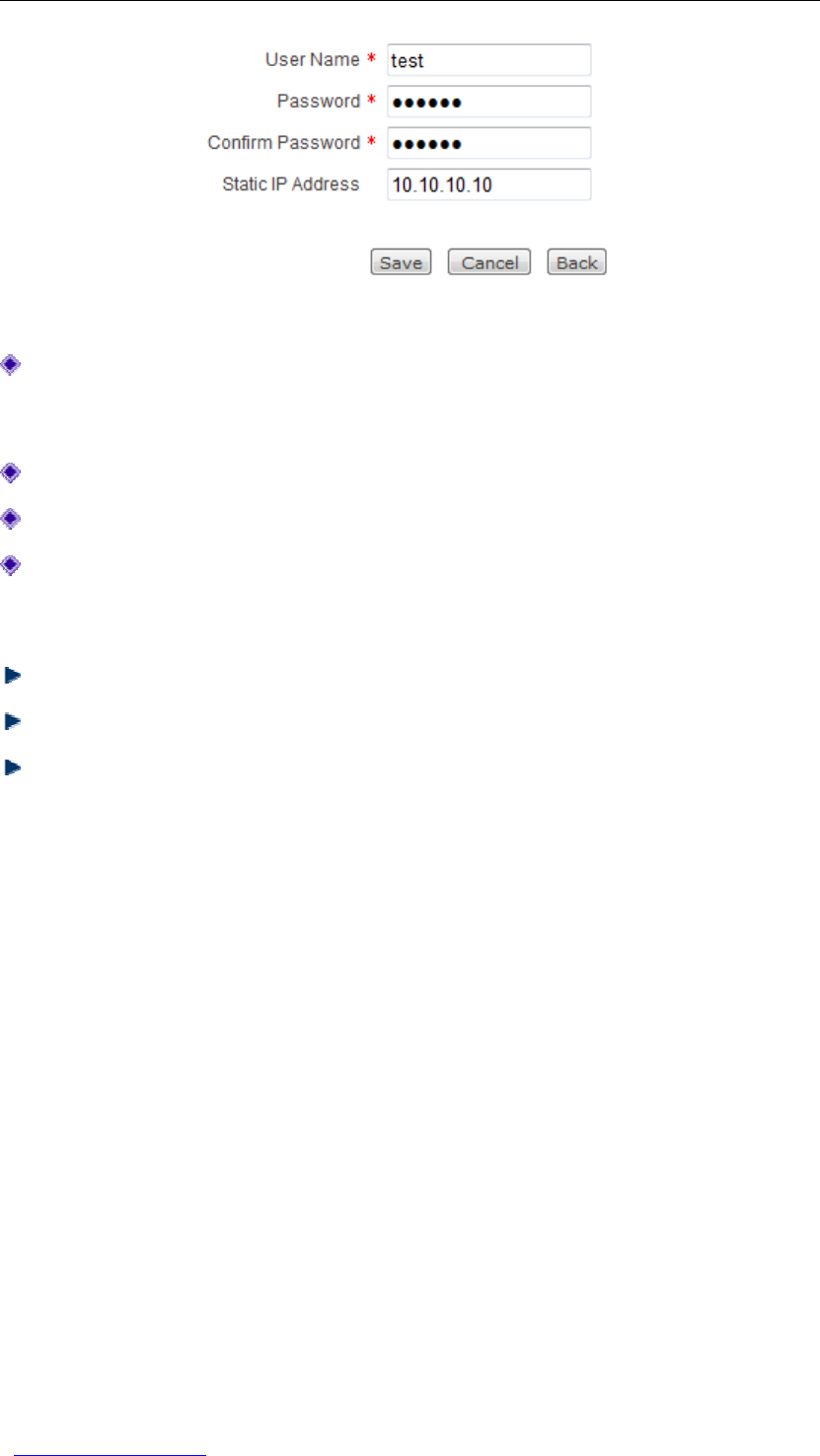
UTT Technologies Chapter 7 Advanced
http://www.uttglobal.com Page 130
Figure 7- 24 PPPoE Account Settings
User Name: It specifies a unique user name of the PPPoE account. It must be
between 1 and 31 characters long. The PPPoE server will use User Name and
Password to identify the PPPoE client.
Password: It specifies the password of the PPPoE account.
Confirm Password: You should re-enter the password.
Static IP Address: It specifies a static IP address that is assigned to the user who
uses the current PPPoE account. It must be a valid IP address within the range of IP
addresses assigned by the PPPoE server.
Save: Click to save your changes.
Cancel: Click to revert to the last saved settings.
Back: ClicktogobacktothePPPoE Account List.
7.4.5 PPPoE User Status
You can go to the Advanced > PPPoE Server > PPPoE User Status page view the
status information of online PPPoE dial-in users in the PPPoE User Status List,which
include the user name, assigned IP address, MAC address, Rx rate and Tx rate, and
online time.
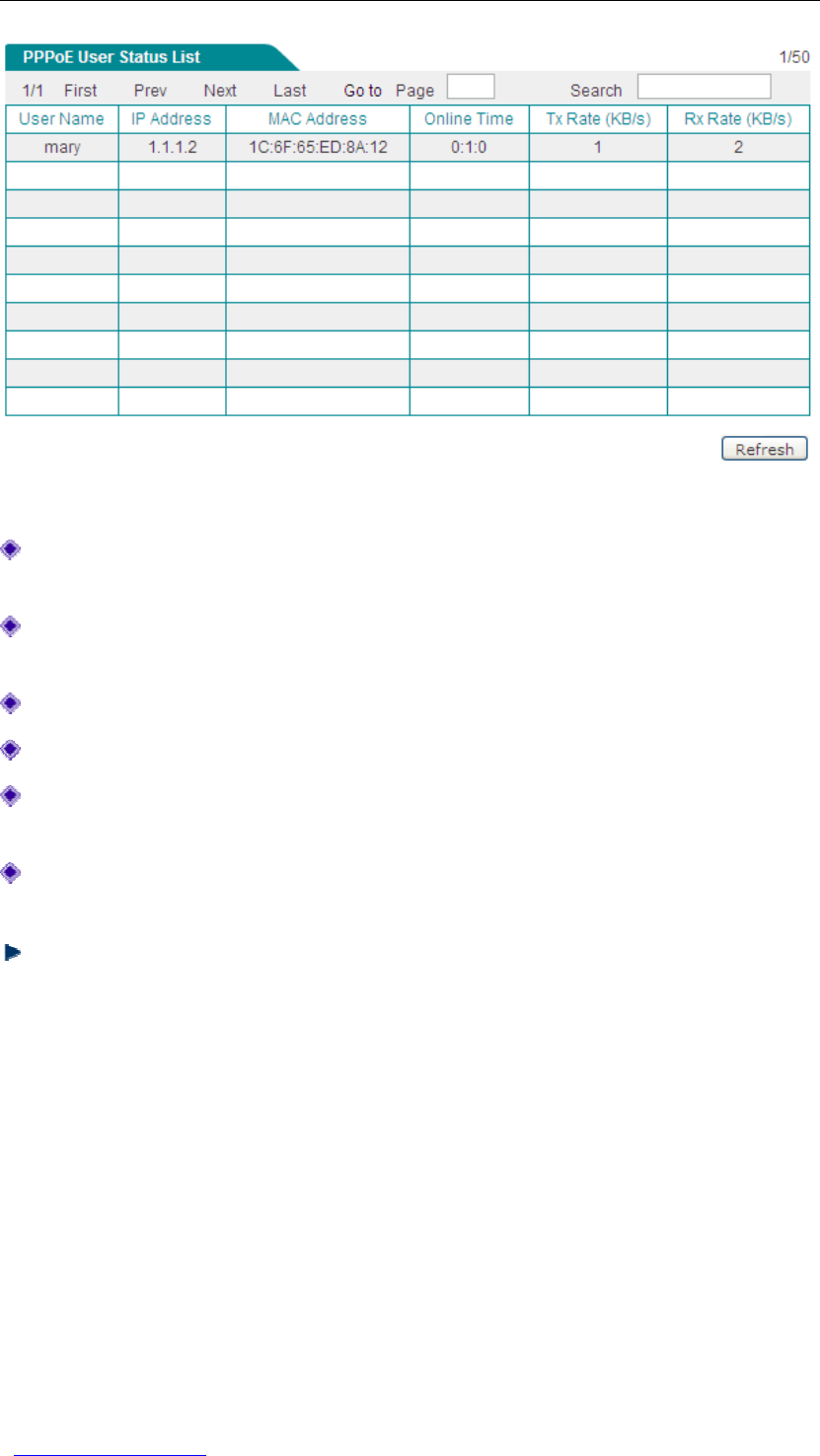
UTT Technologies Chapter 7 Advanced
http://www.uttglobal.com Page 131
Figure 7- 25 PPPoE User Status List
User Name: It displays the user name of the PPPoE account. The PPPoE dial-in
user uses it to dial-up and establish the PPPoE session to the Wireless Router.
IP Address: It displays the PPPoE dial-in user’s IP address assigned by the PPPoE
server.
MAC Address: It displays the PPPoE dial-in user’s MAC address.
Online Time: It displays the elapsed time since the PPPoE session was established.
Tx Rate: It displays the real-time upload rate (in kilobytes per second) of the PPPoE
dial-in user.
Rx Rate: It displays the real-time download rate (in kilobytes per second) of the
PPPoE dial-in user.
Refresh: Click to view the latest information in the list.
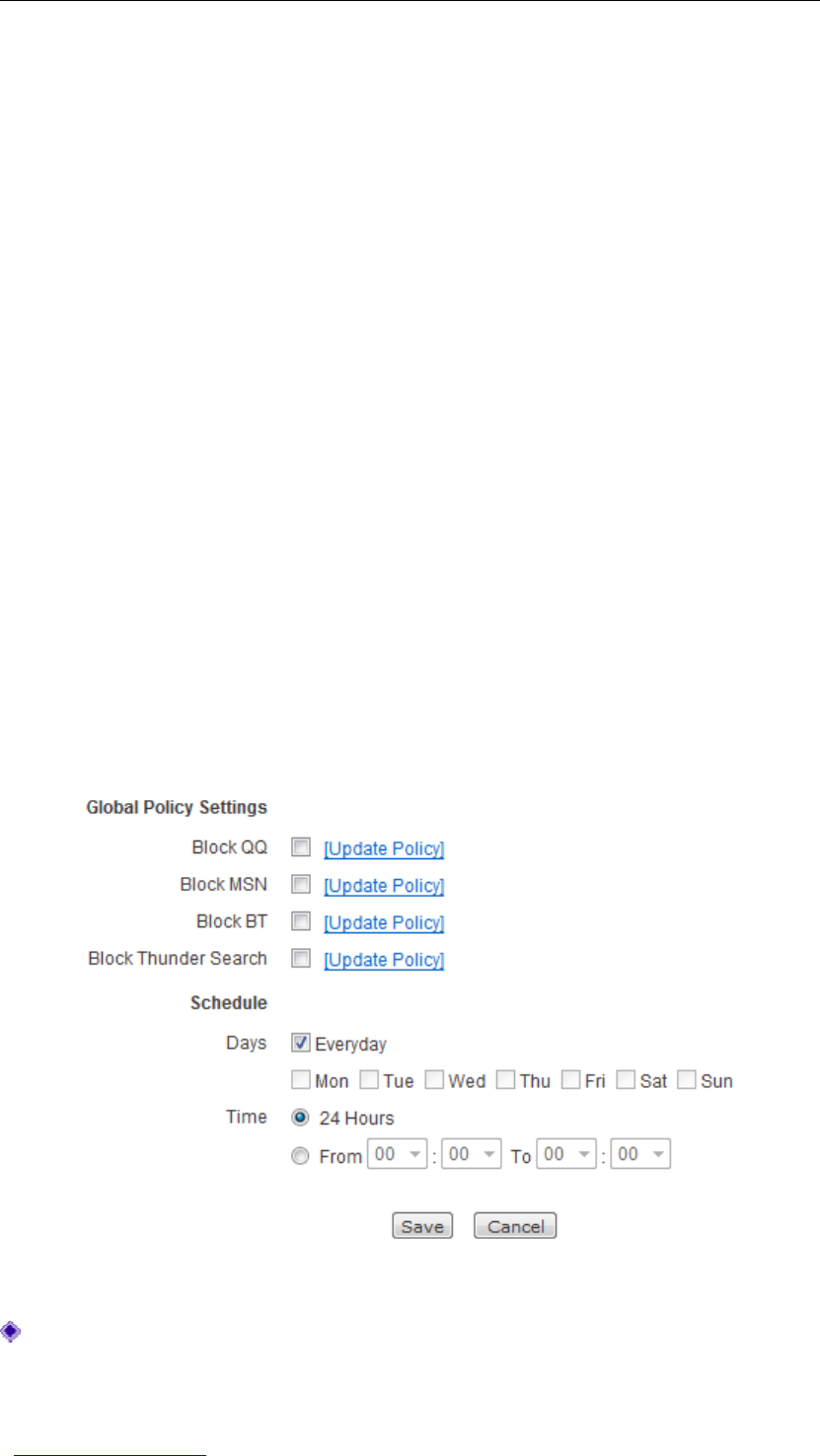
UTT Technologies Chapter 8 User Management
http://www.uttglobal.com Page 132
Chapter 8 User Management
This chapter describes how to control and manage the Internet behaviors of the LAN
users, including global management and group management.
8.1 Global Management
This section describes the User > Global Management page.
In this page, you can easily control and manage the Internet behaviors of the LAN users
based on schedule, which include: allow or block the LAN users from using popular IM
(e.g., QQ, MSN) and P2P applications (e.g., Bit Comet, Bit Spirit, Thunder Search) during
the specified schedule. Using P2P applications in the LAN will impact the other users
accessing the Internet, even cause network congestion and performance deterioration.
You can block P2P applications to avoid such situations.
8.1.1 Global Management Policy Settings
Figure 8- 1 Global Management Policy Settings
Block QQ: It allows or blocks QQ application. If you want to block the LAN users from
using QQ to chat with others, please select this check box.
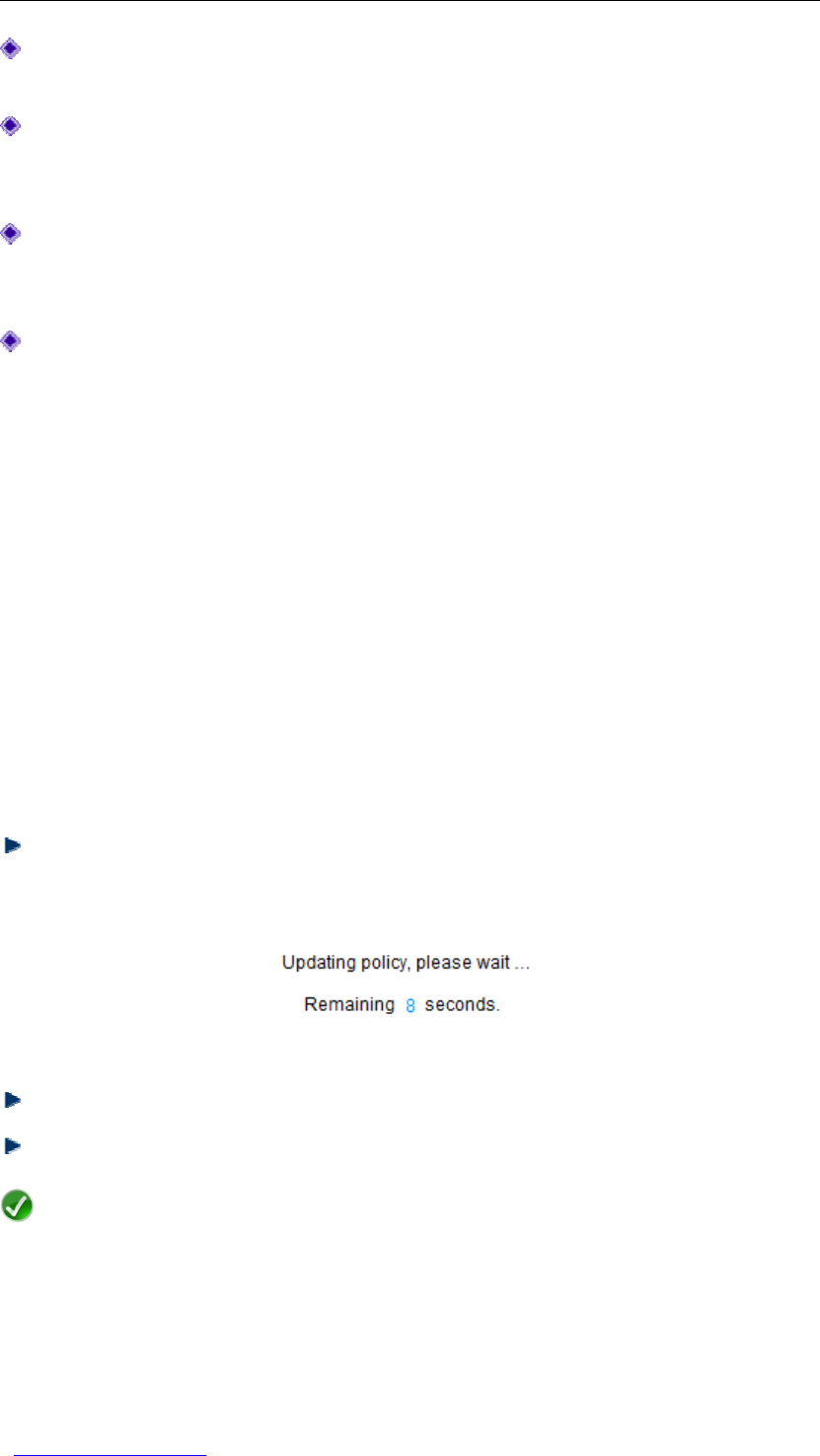
UTT Technologies Chapter 8 User Management
http://www.uttglobal.com Page 133
Block MSN: It allows or blocks MSN Messenger. If you want to block the LAN users
from using MSN Messenger to chat with others, please select this check box.
Block BT: It allows or blocks BitSpirit and BitComet applications. If you want to block
the LAN users from using BitSpirit or BitComet to download files, please select this
check box.
Block Thunder Search: It allows or blocks Thunder search application. If you want
to block the LAN users from using Thunder to search resources, please select this
check box.
Schedule: It allows you to define a schedule to restrict when the global management
policy is in effect. By default, it is always in effect.
•Days: It specifies the day(s) of the week during which the schedule is in effect.
By default, the Everyday check box is checked, which means all days of the
week. You may clear the Everyday check box, and then select any single day
(Monday, Tuesday, Wednesday, Thursday, Friday, Saturday, or Sunday) or
combinations of days as desired.
•Time: It specifies a range of hours and minutes during which the schedule is in
effect. By default, the 24 Hours check box is checked, which means the
schedule is in effect all day on the selected day(s). You may clear the 24 Hours
check box, and then choose the daily start time and end time as desired. If the
start time is later than the end time, the system will automatically divide it into two
time periods. E.g., if you select the Mon check box, and choose 23:00 and 06:00
as the daily start time and end time respectively, the schedule will be in effect
during 00:00~06:00 and 23:00~23:59 on Monday.
Update Policy: Click to update the corresponding policy. If you click the Update
Policy hyperlink, the system will jump to the Update Policy page (see Figure 8- 2),
and go back to the User > Global Management page after the update is complete.
Figure 8-2 Updating Policy
Save: Click to save your changes.
Cancel: Click to revert to the last saved settings.
Note
The global management policy applies to the LAN users whose IP address is on the
same subnet as the Wireless Router’s LAN interface, and PPPoE dial-in users. Other
users aren’t subject to the policy.
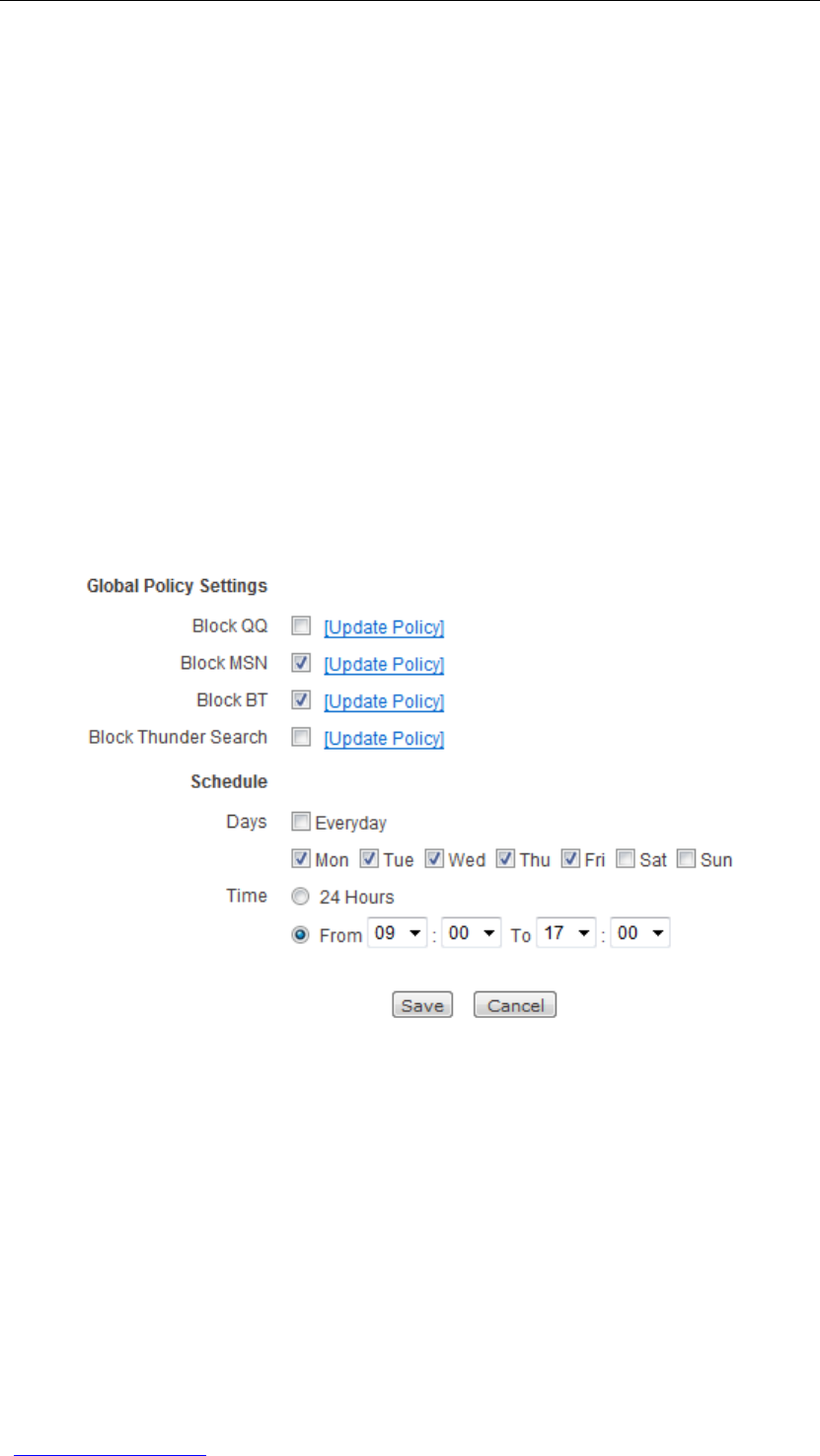
UTT Technologies Chapter 8 User Management
http://www.uttglobal.com Page 134
8.1.2 An Example for Global Management Policy
A business uses a AC750W Wireless Router to access the Internet. The CEO wants to
block the employees from using MSN and BT applications during business hours (Monday
to Friday, 9:00 to 17:00).
The configuration steps are the following:
Step 1 Go to the User > Global Management page.
Step 2 Select the Block MSN and Block BT check boxes.
Step 3 Define business hours: clear the Everyday check box, next select the Mon,
Tue,Wed,Thu,andFri check boxes; clear the 24 Hours check box, next
choose 09:00 and 17:00 as the daily start time and end time respectively. The
above settings are shown in Figure 8- 3.
Step 4 Click the Save button to save your settings.
Figure 8- 3 Global Management Policy - Example
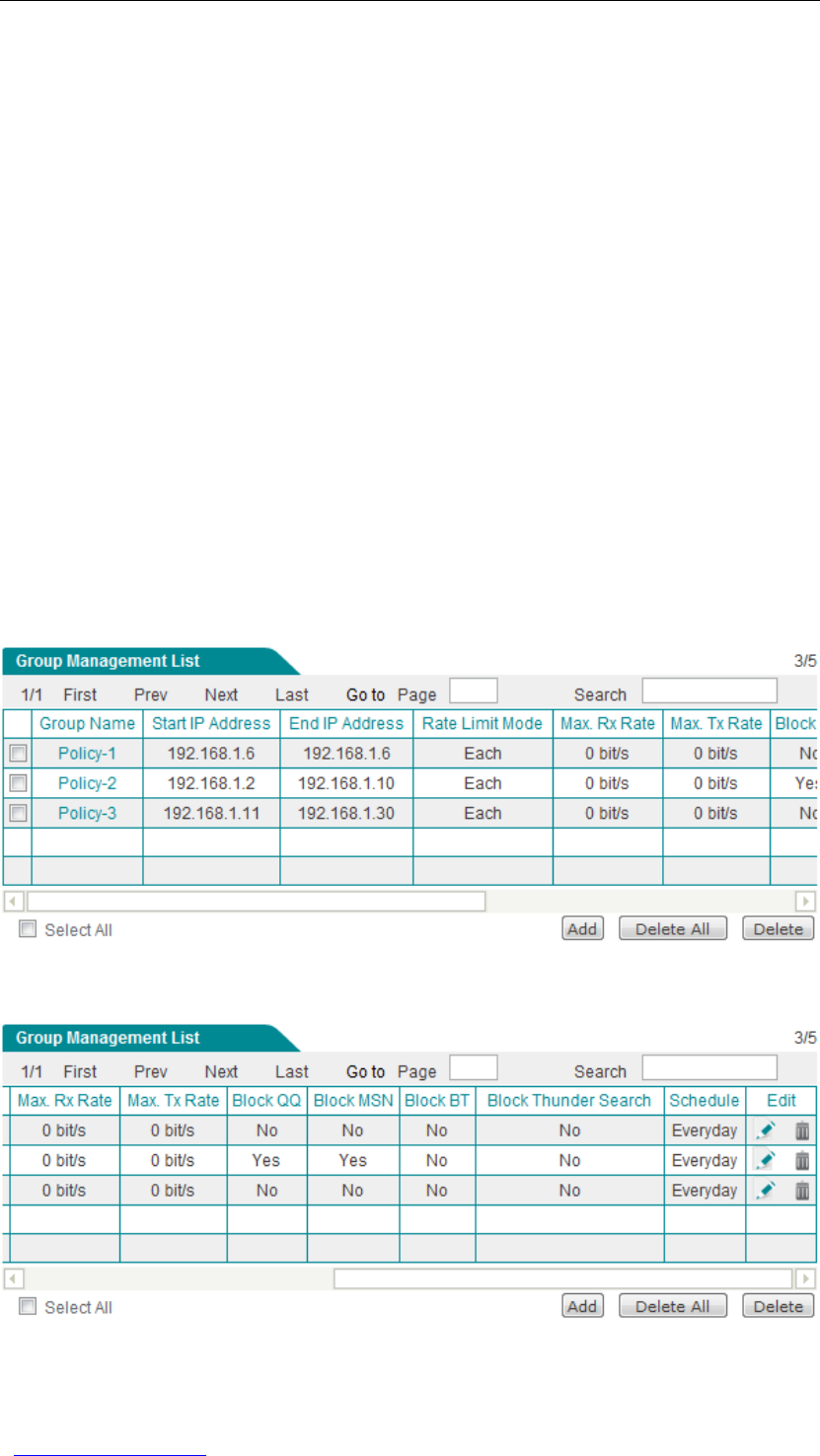
UTT Technologies Chapter 8 User Management
http://www.uttglobal.com Page 135
8.2 Group Management
This section describes the User > Group Management page.
In this page, you can group the users that have the same Internet access privileges into a
user group, and assign a range of contiguous IP addresses to them. After that, you can
create group management policies for each group based on schedule. For convenience, a
group can also contain a single user.
A group management policy is used to control the Internet behaviors of the users in the
group, which include: allow or block these users from using popular IM (e.g., QQ, MSN)
and P2P applications (e.g., Bit Comet, Bit Spirit, Thunder Search) during the specified
schedule; in addition, it is also used to control the maximum upload and download rate of
these users during the specified schedule.
8.2.1 Group Management Policy List
Figure 8-4 Group Management Policy List
Figure 8-5 Group Management Policy List (Continue)
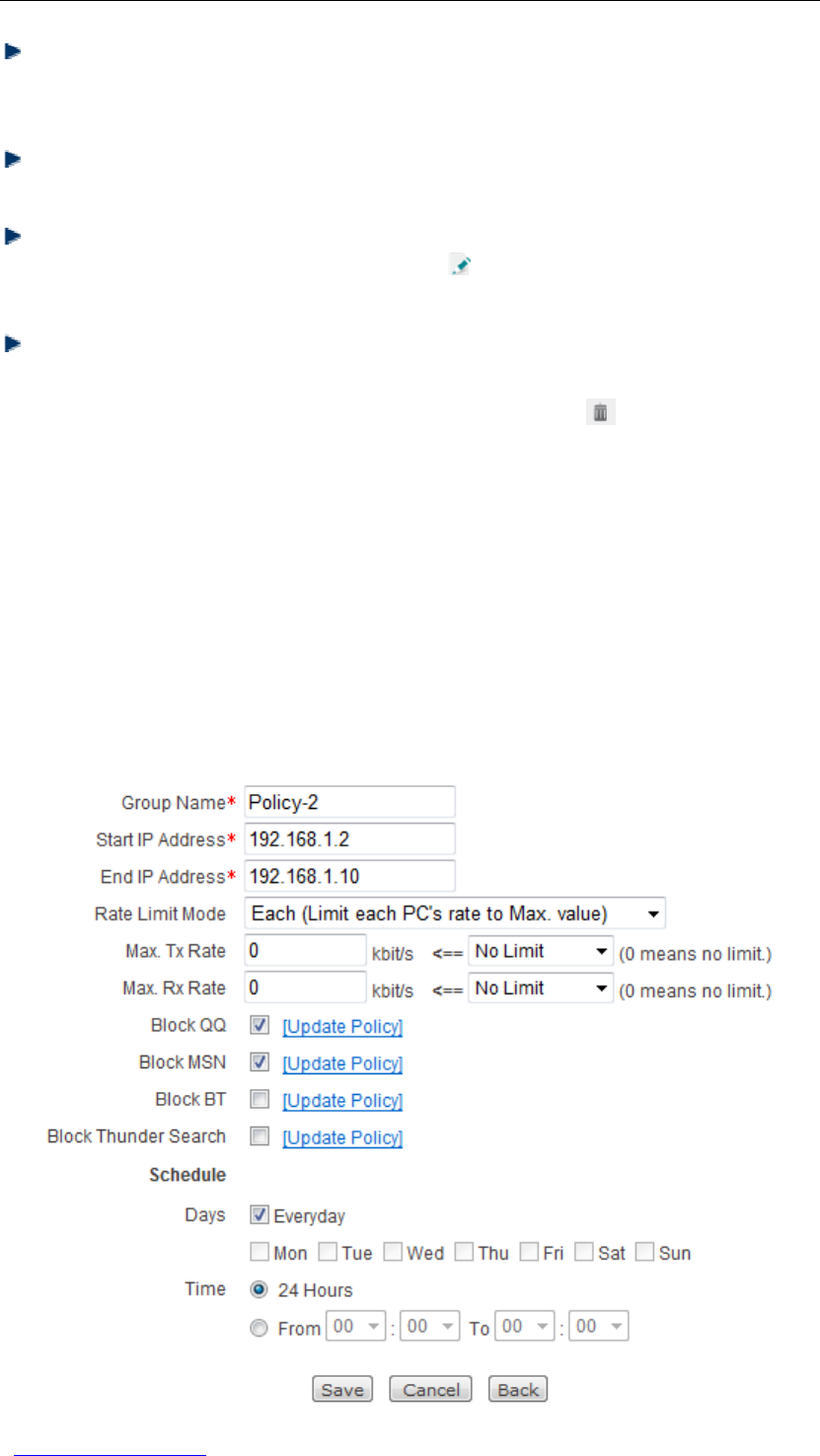
UTT Technologies Chapter 8 User Management
http://www.uttglobal.com Page 136
Add a Group Management Policy: To add a new group management policy, first
click the Add button to go to the Group Management Settings page, next configure
it, lastly click the Save button.
View Group Management Policy(s): When you have configured one or more group
management policies, you can view them in the Group Management List.
Modify a Group Management Policy: To modify a configured group management
policy, click its Group Name hyperlink or icon, the related information will be
displayed in the setup page. Then modify it, and click the Save button.
Delete Group Management Policy(s): There are three ways to delete group
management policy(s).
1. To delete a group management policy, directly click its icon.
2. To delete more than one group management policy at a time, select the leftmost
check boxes of the policies that you want to delete, and then click the Delete
button.
3. To delete all the group management policies at a time, directly click the Delete
All button.
8.2.2 Group Management Policy Settings
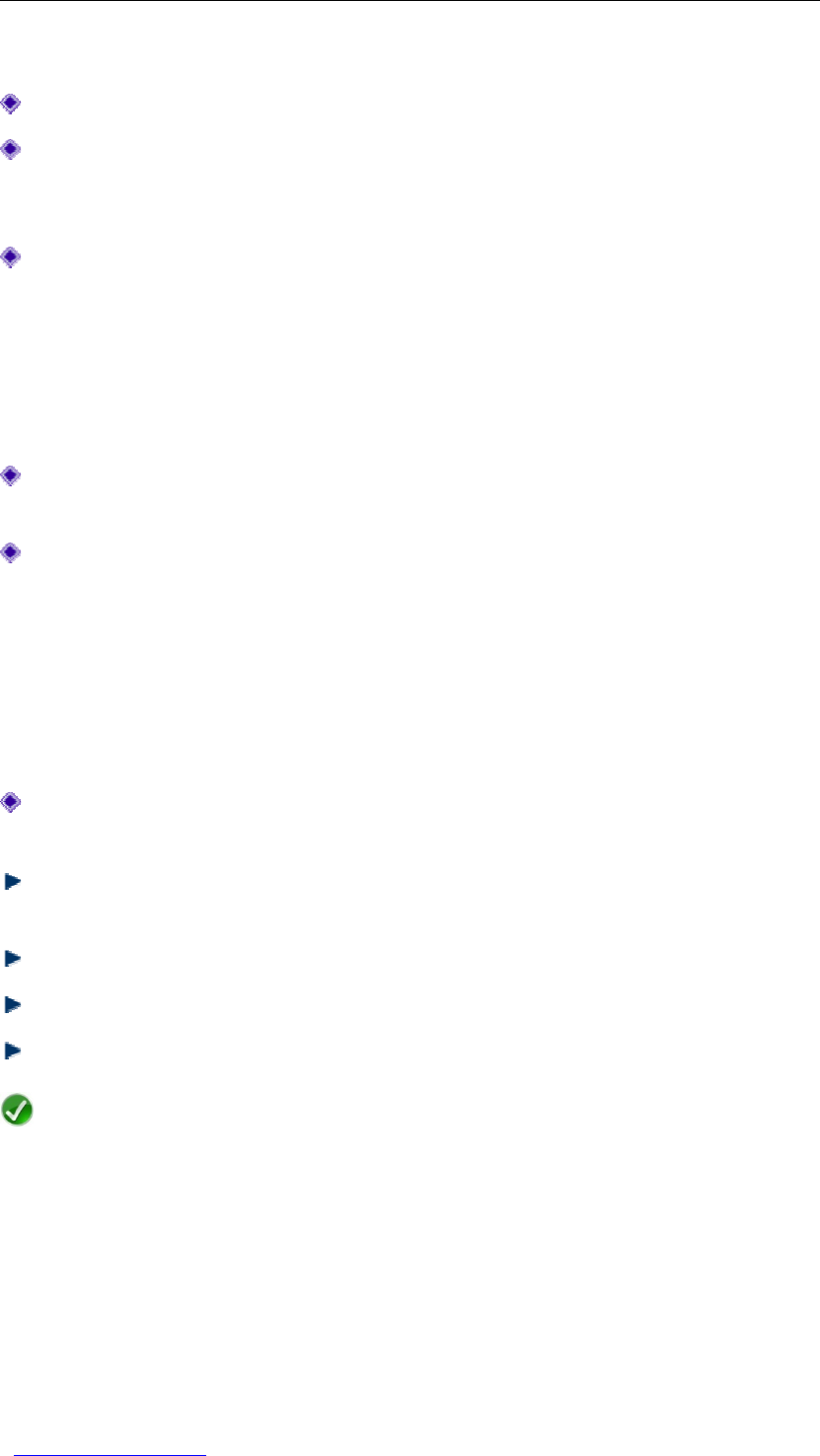
UTT Technologies Chapter 8 User Management
http://www.uttglobal.com Page 137
Figure 8- 6 Group Management Policy Settings
Group Name: It specifies a unique name of group.
Start IP Address and End IP Address: They specify a range of contiguous IP
addresses. All the computers within the specified range are members of the group,
and are subject to the group management policy.
Rate Limit Mode: It specifies the mode by which the Wireless Router will limit the
maximum Tx/Rx rate of the LAN computers belonging to the group.
●Each: If you select this option, the Tx/Rx rate of each computer can reach up
to the Max. Tx Rate/ Max. Rx Rate you specify.
●Share: If you select this option, the total Tx/Rx rate of all computers in the
group can reach up to the Max. Tx Rate/ Max. Rx Rate you specify.
Max. Tx Rate: It specifies the maximum upload rate (in Kbit/s) of the LAN computers
belonging to the group.
Max. Rx Rate: It specifies the maximum download rate (in Kbit/s) of the LAN
computers belonging to the group. There are two ways to set the Max. Tx Rate and
Max. Rx Rate.
●Enter a value in the associated text box. If you don’t want to limit Max. Tx
Rate/Max.RxRate, please leave the default value of 0.
zSelect an option from the associated drop-down list. If you don’t want to Max. Tx
Rate/Max.RxRate, please leave the default value of No Limit.
Block QQ,Block MSN,Block BT,Block Thunder Search,andSchedule: Refer to
Section 8.1.1 Global Management Policy Settings for detailed information.
Update Policy: Click to update the corresponding policy. Refer to Section 8.1.1
Global Management Policy Settings for detailed operation.
Save: Click to save your changes.
Cancel: Click to revert to the last saved settings.
Back: ClicktogobacktotheGroup Management List.
Note
1. The policy management policies take priority over the global management policy.
2. The Wireless Router supports up to five group management policies.
3. If both Start IP Address and End IP Address are set to 0.0.0.0, the group will
contain all computers on the LAN no matter what IP address they might have. In this
case, the Wireless Router will check all the packets initiated from the LAN computers,
so the system performance will be degraded to some extent. Therefore, you’d better
not set them to 0.0.0.0.

UTT Technologies Chapter 8 User Management
http://www.uttglobal.com Page 138
8.2.3 Execution Order of Group Management Policies
If a user’s computer belongs to more than one group, in other words, if the user matches
more than one group management policy, it will be subject to the first one added. More
specifically, after you configure some group management policies, the Wireless Router
will search the Group Management List to find out if there is a policy matching a user. It
will check the user’s IP address against each policy in the order in which the policies are
listed. The first matching policy will apply to the user. Note that the policies are listed in
chronological order of creation (i.e., most recent at the bottom).
8.2.4 Priorities of Global and Group Management
Policies and Access Rules
The access rules have higher priority than the group management policies, and the group
management policies have higher priority than the global management policy. That is,
when receiving a packet initiated from a local computer, the Wireless Router will first
check it against the access rules, next the group management policies, lastly the global
management policy. The first rule (or policy) that matches the packet is applied. After a
match is found, no further rules or policies are checked.
For example, if you have selected the Block MSN check box in the User > Global
Management page, added a group management policy which allows a group of users to
use MSN (Block MSN check box is cleared) in the User > Group Management page,
and added an access rule which denies all users access to the Internet in the Firewall >
Access Control page, then any users are unable to access the Internet because the
access rule is matched first. Now if you only delete the access rule, then the users belong
to the specified group can use MSN, but other users cannot.
8.2.5 An Example for Group Management Policy
1. Requirements
A business uses a AC750W Wireless Router to access the Internet. The CEO wants to
control Internet behaviors of the employees of the Administration Department and
Business Department:
1) Block the Administration Department’s employees (IP range: 192.168.1.2-
192.168.1.10) from using MSN and QQ, and allow them to access all other services.
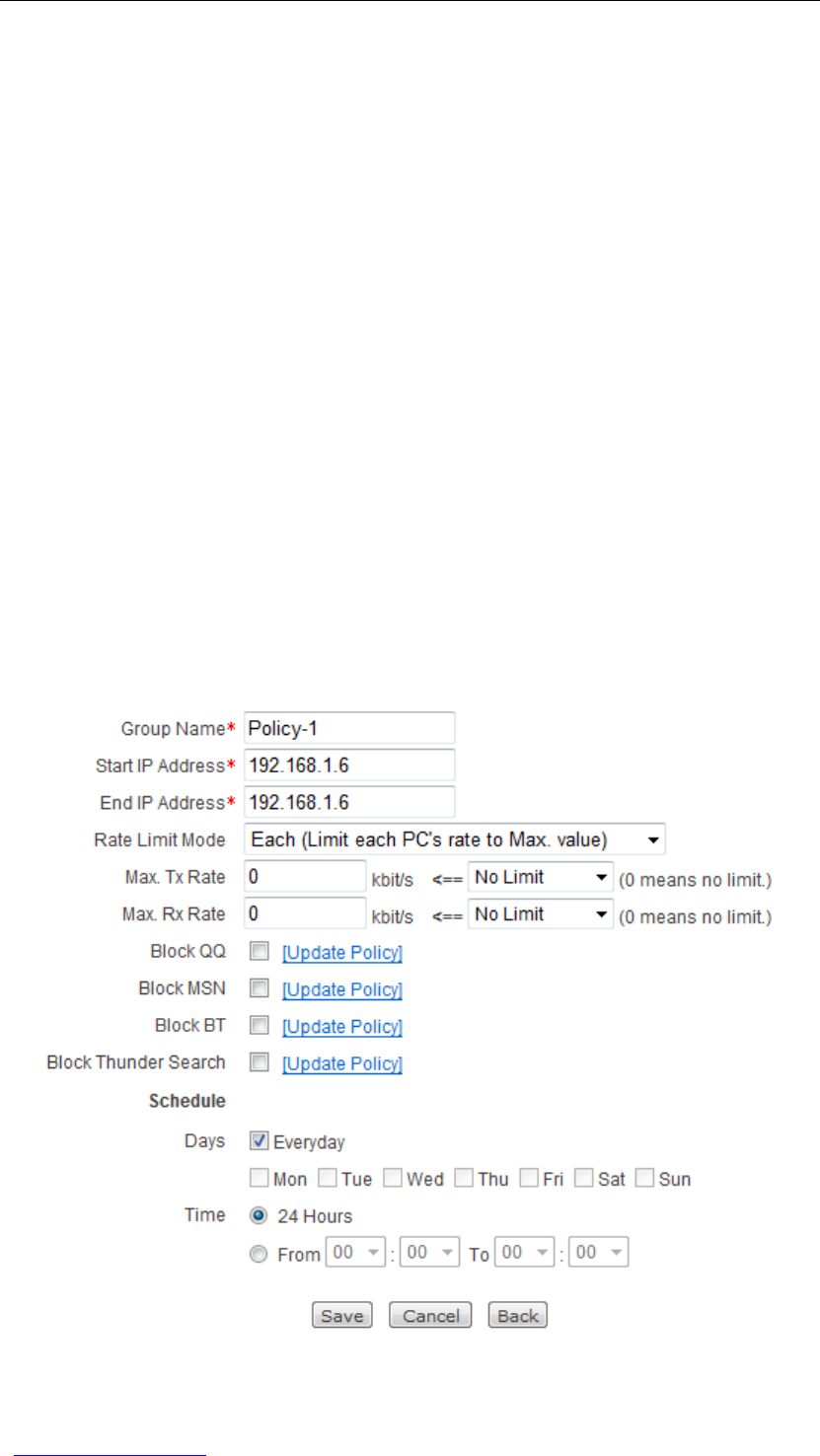
UTT Technologies Chapter 8 User Management
http://www.uttglobal.com Page 139
The exception is that the CEO with IP address 192.168.1.6 can access any services.
2) Allow the Business Department’s employees (IP range: 192.168.1.11-192.168.1.30)
to access any services.
2. Analysis
We need to create three group management policies to meet the requirements:
●Group management policy 1: It allows the CEO to access all Internet services.
●Group management policy 2: It blocks the Administration Department’s employees
from using QQ and MSN.
●Group management policy 3: It allows the Business Department’s employees to
access all Internet services.
3. Configuration Steps
Step 1 Go to the User > Group Management page.
Step 2 Click the Add button to go to the Group Management Settings page to create
the policy 1. The detailed settings are shown in Figure 8- 7.
Figure 8- 7 Group Management Policy Example - Policy 1
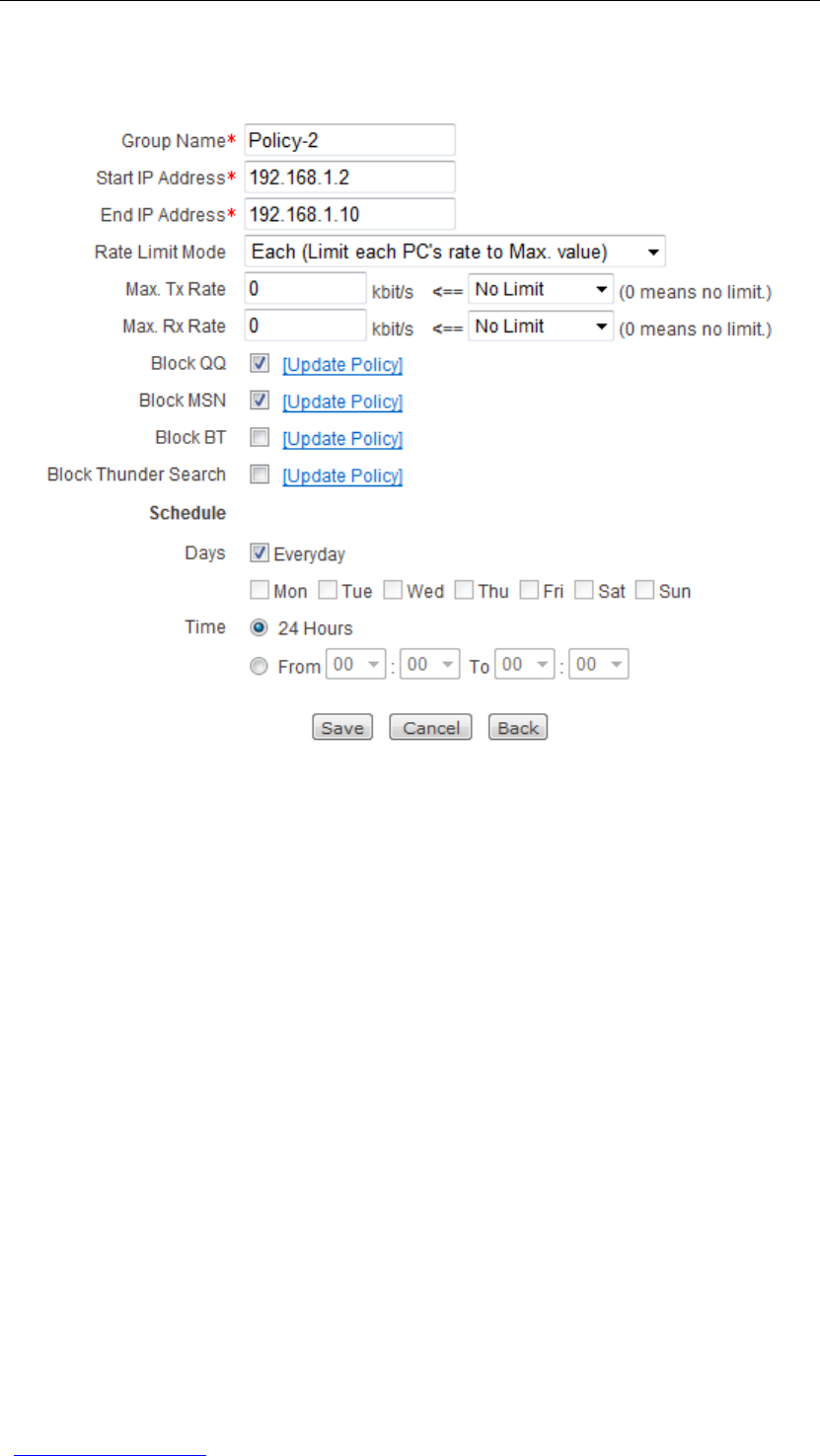
UTT Technologies Chapter 8 User Management
http://www.uttglobal.com Page 140
Step 3 Click the Add button to go to the Group Management Settings page to create
the policy 2. The detailed settings are shown in Figure 8- 8.
Figure 8- 8 Group Management Policy Example - Policy 2
Step 4 Click the Add button to go to the Group Management Settings page to create
the policy 3. The detailed settings are shown in Figure 8- 9.
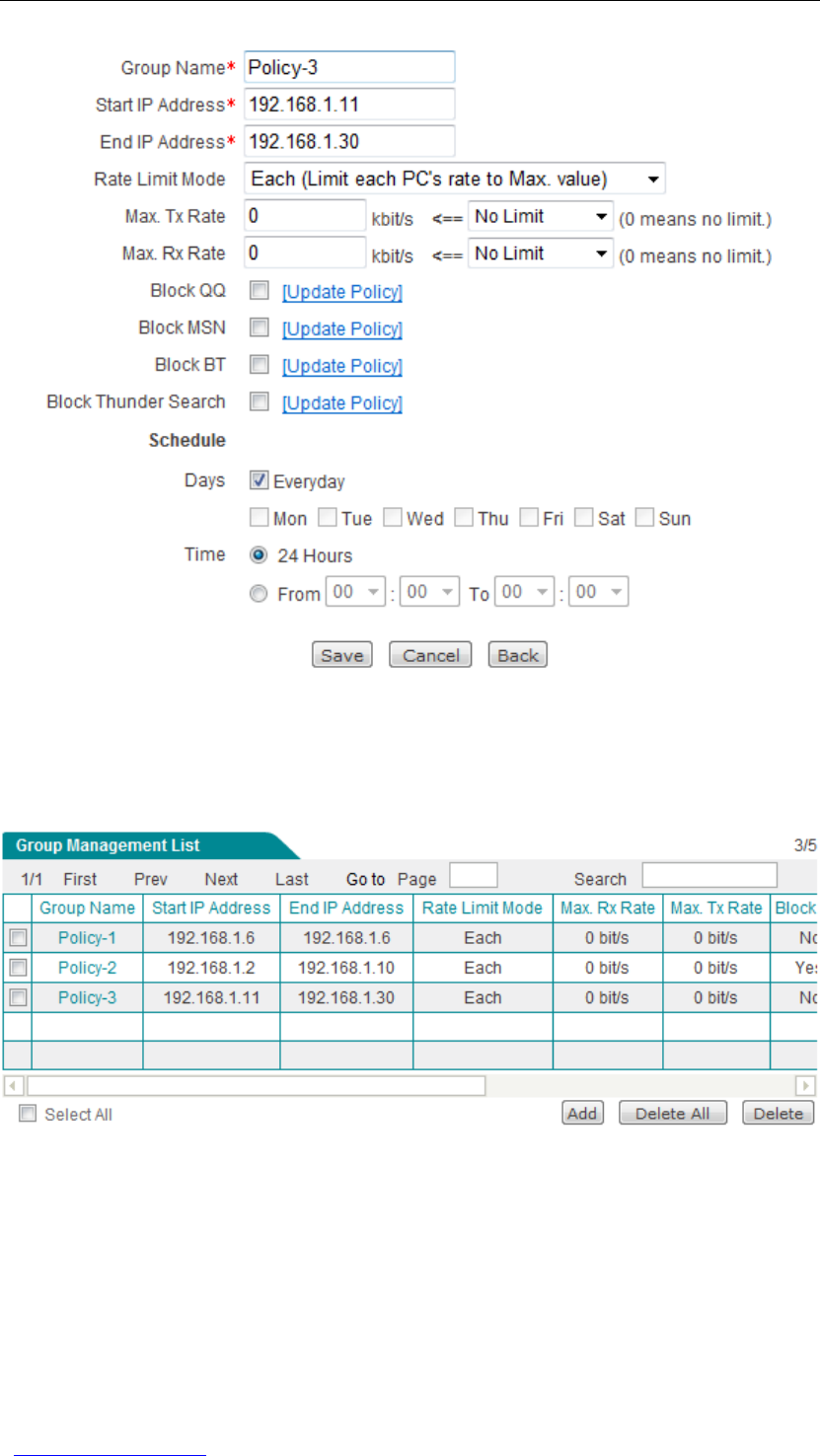
UTT Technologies Chapter 8 User Management
http://www.uttglobal.com Page 141
Figure 8- 9 Group Management Policy Example - Policy 3
Step 5 After you have configured the three policies, you can view them in the Group
Management List, see Figure 8- 10.
Figure 8- 10 Group Management List – Example
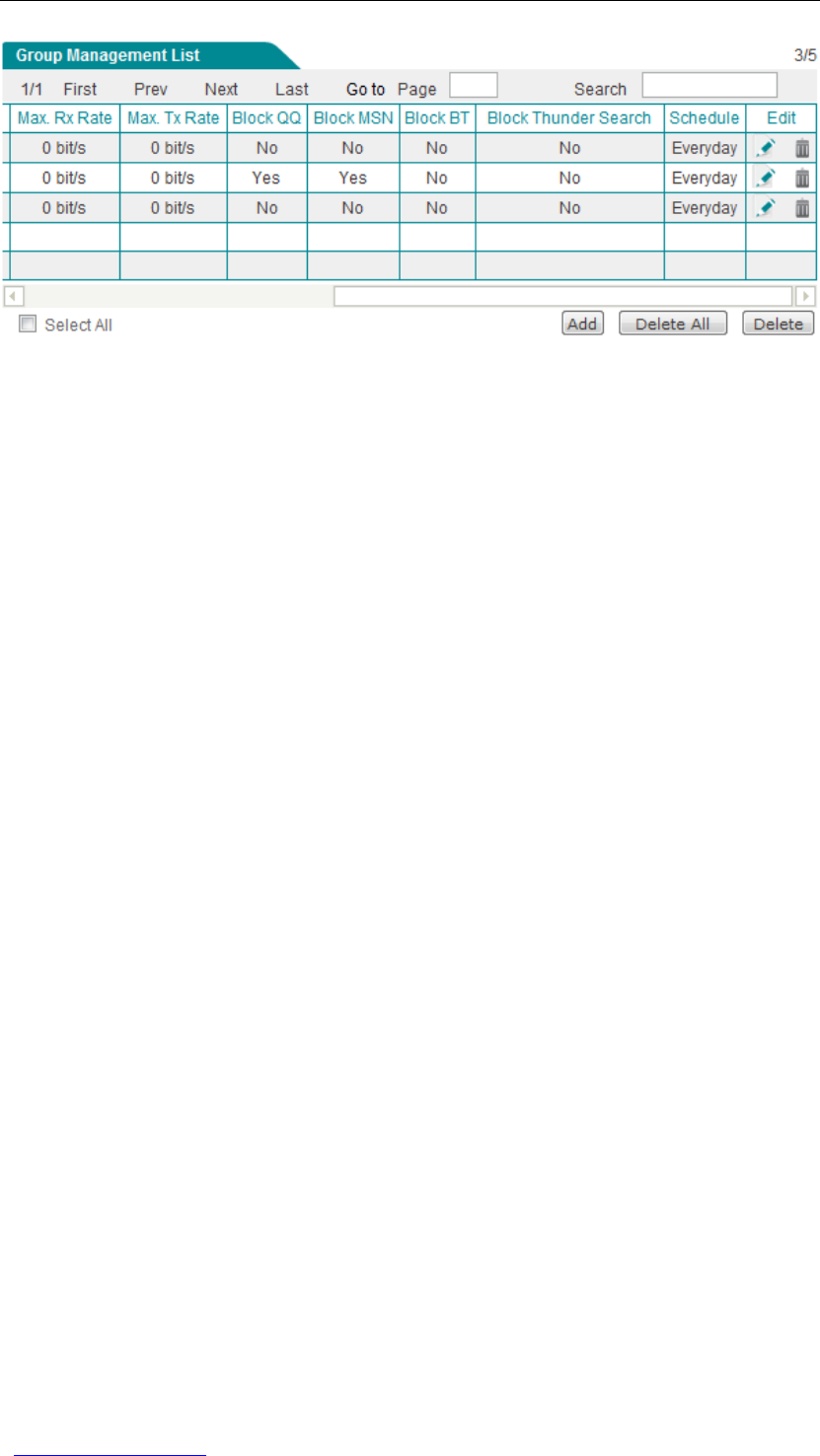
UTT Technologies Chapter 8 User Management
http://www.uttglobal.com Page 142
Figure 8- 11 Group Management List – Example (Continue)

UTT Technologies Chapter 9 Firewall
http://www.uttglobal.com Page 143
Chapter 9 Firewall
This chapter describes how to configure firewall features, including access control,
domain filtering, and attack prevention.
9.1 Access Control
This section describes the Firewall > Access Control page, which includes the Access
Rule List and Access Rule Settings.
9.1.1 Introduction to Access Control
9.1.1.1 The Purpose of Access Control Feature
By flexibly utilizing access control, you can not only assign different Internet access
privileges to different LAN users, but also assign different Internet access privileges to the
same users based on schedules. In practice, you can set appropriate access rules
according to the actual requirements of your organization. Such as, for a school, you can
block the students from accessing game websites; for a family, you can only allow your
children to access the Internet during the specified period of time; for a business, you can
block the Financial Department’s employees from accessing the Internet.
9.1.1.2 The Operation Principle of Access Control
By default, the Wireless Router will forward all the valid packets received by the LAN
interface because no access rule exists. After you have configured some access rules, the
Wireless Router will examine each packet received by the LAN interface to determine
whether to forward or drop it, based on the criteria you specified in the access rules.
More specifically, when receiving a packet initiated from LAN, the Wireless Router will
analyze the packet by extracting its source MAC address, source IP address, destination
IP address, protocol type, port number, content, and the date and time at which the packet
was received, and then compare them with each rule in decreasing order of priority. The

UTT Technologies Chapter 9 Firewall
http://www.uttglobal.com Page 144
first rule that matches the packet is applied, and the specified Action (Allow or Deny)is
taken. After a match is found, no further rules are checked. Note that the rules are listed in
decreasing order of priority in the Access Rule List: The rule with a higher priority is listed
before the one with a lower priority.
9.1.1.3 Filtering Type of Access Rule
The Wireless Router supports three filtering types of access rule, which include IP filtering,
URL filtering and keyword filtering. All of them support access control based on schedule.
1. IP Filtering
The IP filtering rules are used to filter IP packets based on the packet header information,
such as source IP address, destination IP address, protocol type (TCP, UDP, ICMP, etc.),
TCP/UDP source port and destination port.
The filtering criteria that you can specify within an IP filtering rule include: source IP
address, destination IP address, protocol, source port, destination port, and schedule.
2. URL Filtering
The URL filtering rules are used to filter URLs based on keyword in the URL. It allows you
to filter any web page whose URL contains the specified keyword. For example, if you
want to block sex related websites, you can use the URL keyword “sex”. This will block
any web page whose URL contains sex, such as www.sexpicture.com. Of course, you can
use the full URL (like “www.yahoo.com”) to filter only the specified URL.
The filtering criteria that you can specify within a URL filtering rule include: source IP
address, filtering content (i.e., URL keyword), and schedule.
3. Keyword Filtering
The keyword filtering rules are used to block users from submitting information to the web
page based on keyword, that is, the information that contains the specified keyword (such
as pornography, gambling, etc.) cannot be submitted to any web page. The Wireless
Router supports both Chinese and English keyword filtering.
The filtering criteria that you can specify within a keyword filtering rule include: source IP
address, filtering content (i.e., keyword in the web page), and schedule.
9.1.1.4 Action of Access Rule
The action of an access rule is either Allow or Deny. As mentioned earlier, the Wireless
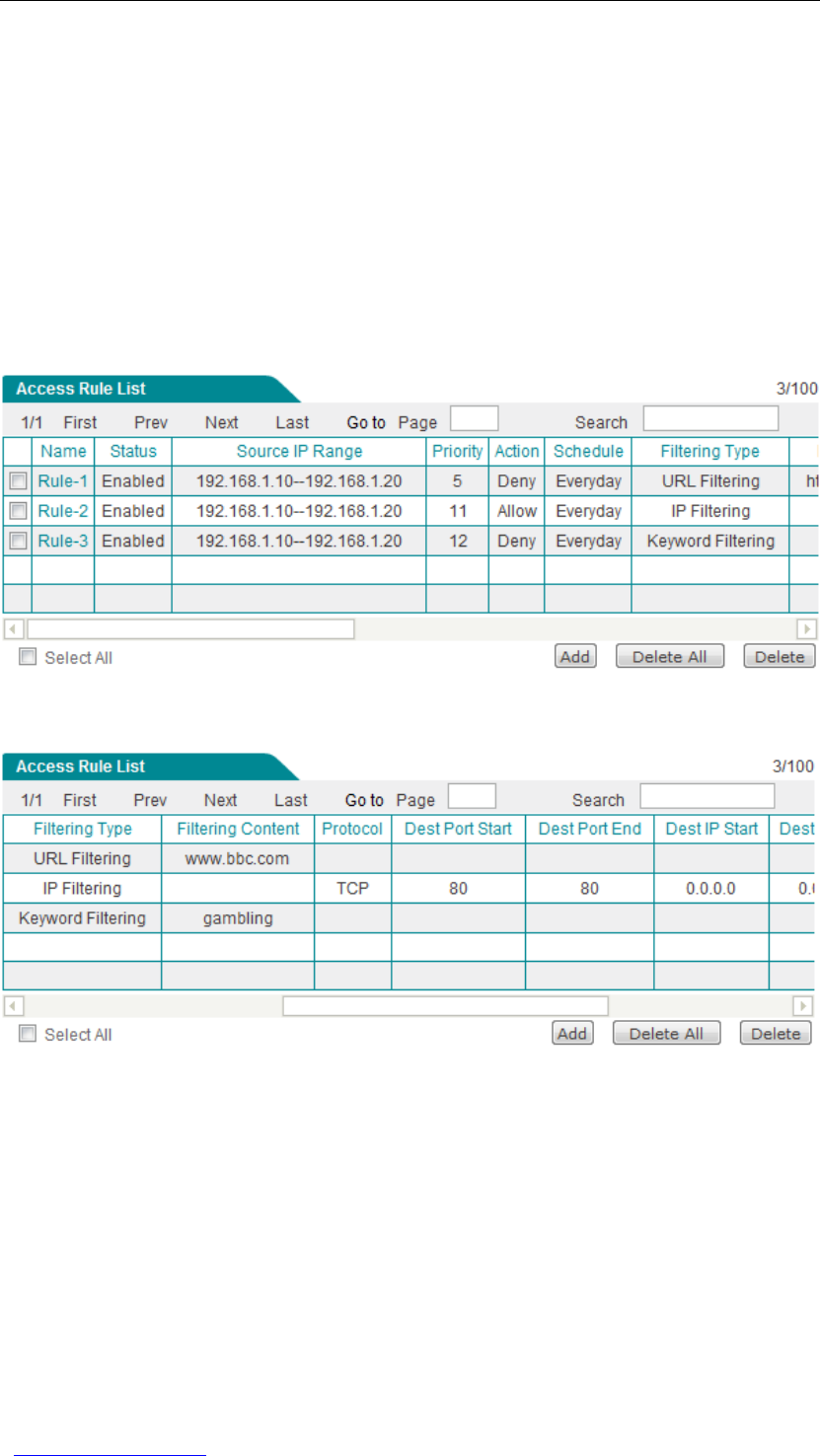
UTT Technologies Chapter 9 Firewall
http://www.uttglobal.com Page 145
Router checks each received packet against the access rules in the Access Rule List,
and the first access rule that matches a packet determines whether the Wireless Router
accepts or drops the packet. If the rule’s Action is Allow, the packet is forwarded. If the
rule’s Action is Deny, the packet is dropped.
Note that keyword filtering rules only support the Deny action.
9.1.2 Access Rule List
Figure 9- 1 Access Rule List
Figure 9- 2 Access Rule List (Continue)
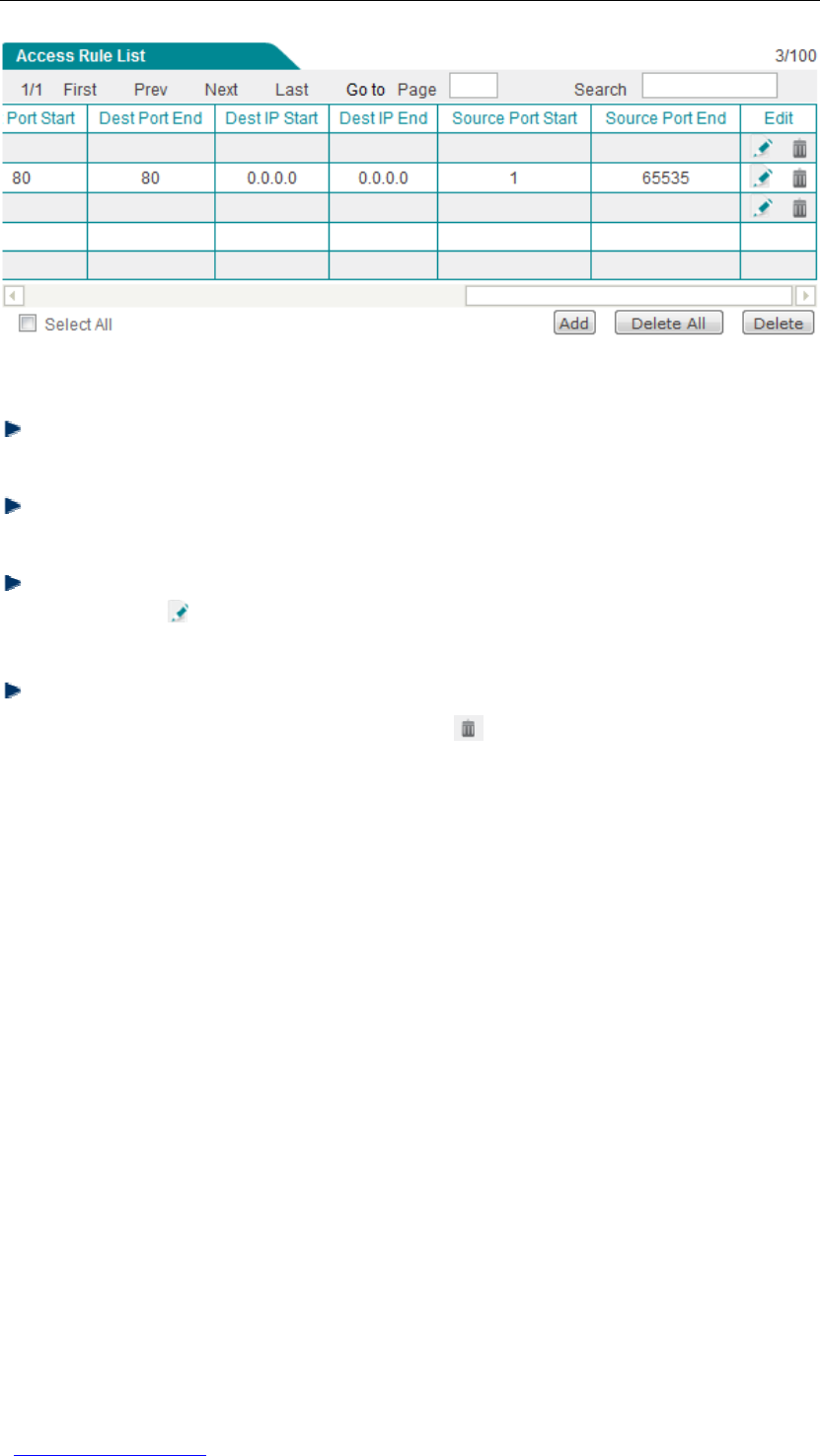
UTT Technologies Chapter 9 Firewall
http://www.uttglobal.com Page 146
Figure 9- 3 Access Rule List (Continue)
Add an Access Rule: To add a new access rule, first click the Add buttontogotothe
Access Rule Settings page, next configure it, lastly click the Save button.
View Access Rule(s): When you have configured one or more access rules, you can
view them in the Access Rule List.
Modify an Access Rule: To modify a configured access rule, click its Name
hyperlink or icon, the related information will be displayed in the setup page.
Then modify it, and click the Save button.
Delete Access Rule(s): There are three ways to delete access rule(s).
1. To delete a access rule, directly click its icon.
2. To delete more than one access rule at a time, select the leftmost check boxes of
the access rules that you want to delete, and then click the Delete button.
3. To delete all the access rules at a time, directly click the Delete All button.
9.1.3 Access Rule Settings
The following sections describe three types of access rule respectively, which include IP
filtering, URL filtering and keyword filtering.
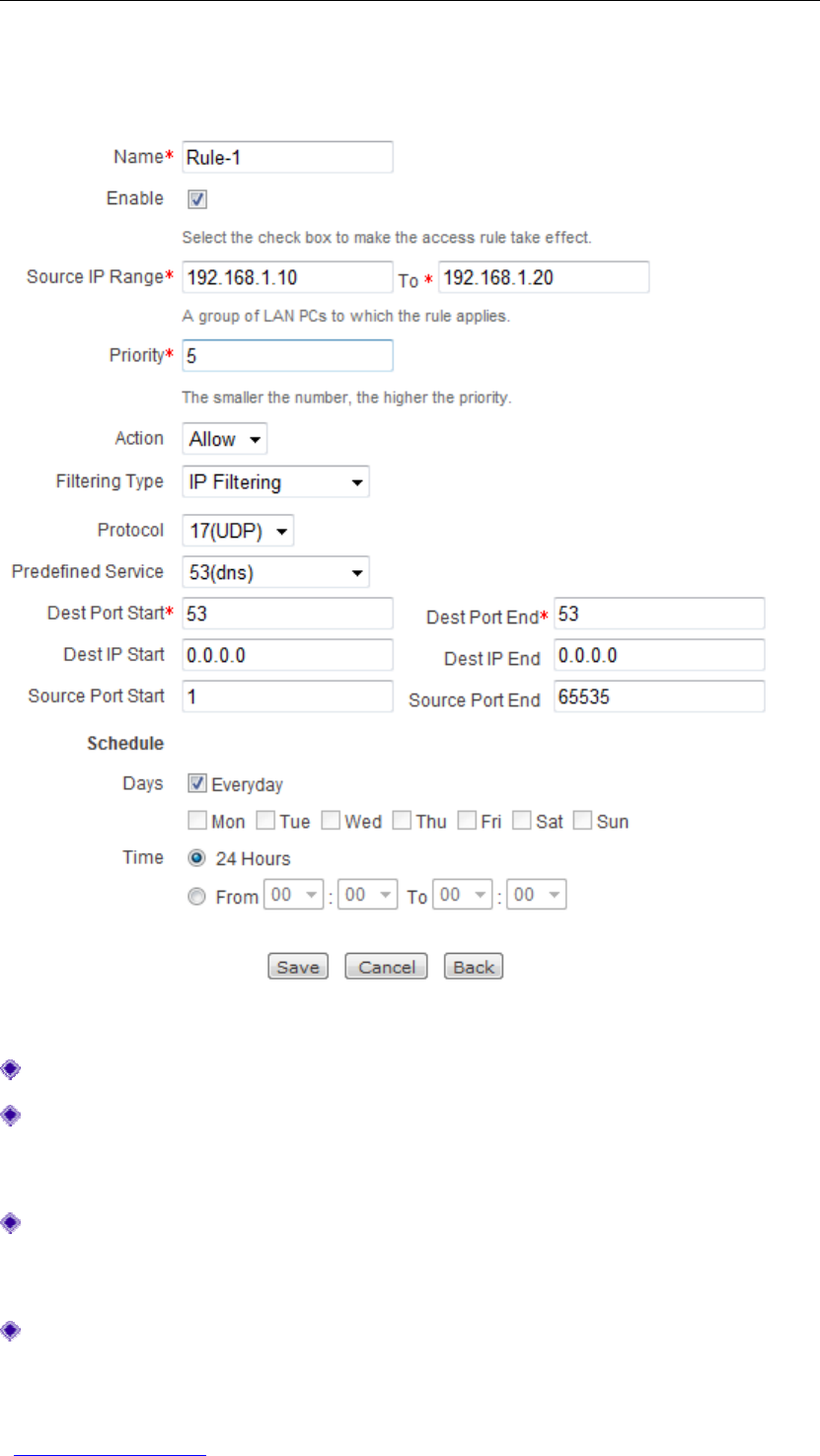
UTT Technologies Chapter 9 Firewall
http://www.uttglobal.com Page 147
9.1.3.1 Access Rule Settings - IP Filtering
Figure 9- 4 Access Rule Settings - IP Filtering
Name: It specifies a unique name of the access rule.
Enable: It allows you to enable or disable the access rule. The default value is
checked, which means the access rule is in effect. If you want to disable the rule
temporarily instead of deleting it, please clear the check box.
Source IP Range: It specifies a range of source IP addresses (i.e., a group of local
computers) to which the access rule applies. To specify a single local computer, enter
its address in both text boxes.
Prority: It specifies the priority of the access rule. The access rules will be checked
against the packets in descending order of priority. It must be between 0 and 100. The
smaller the number, the higher the priority. And the priority of each access rule cannot
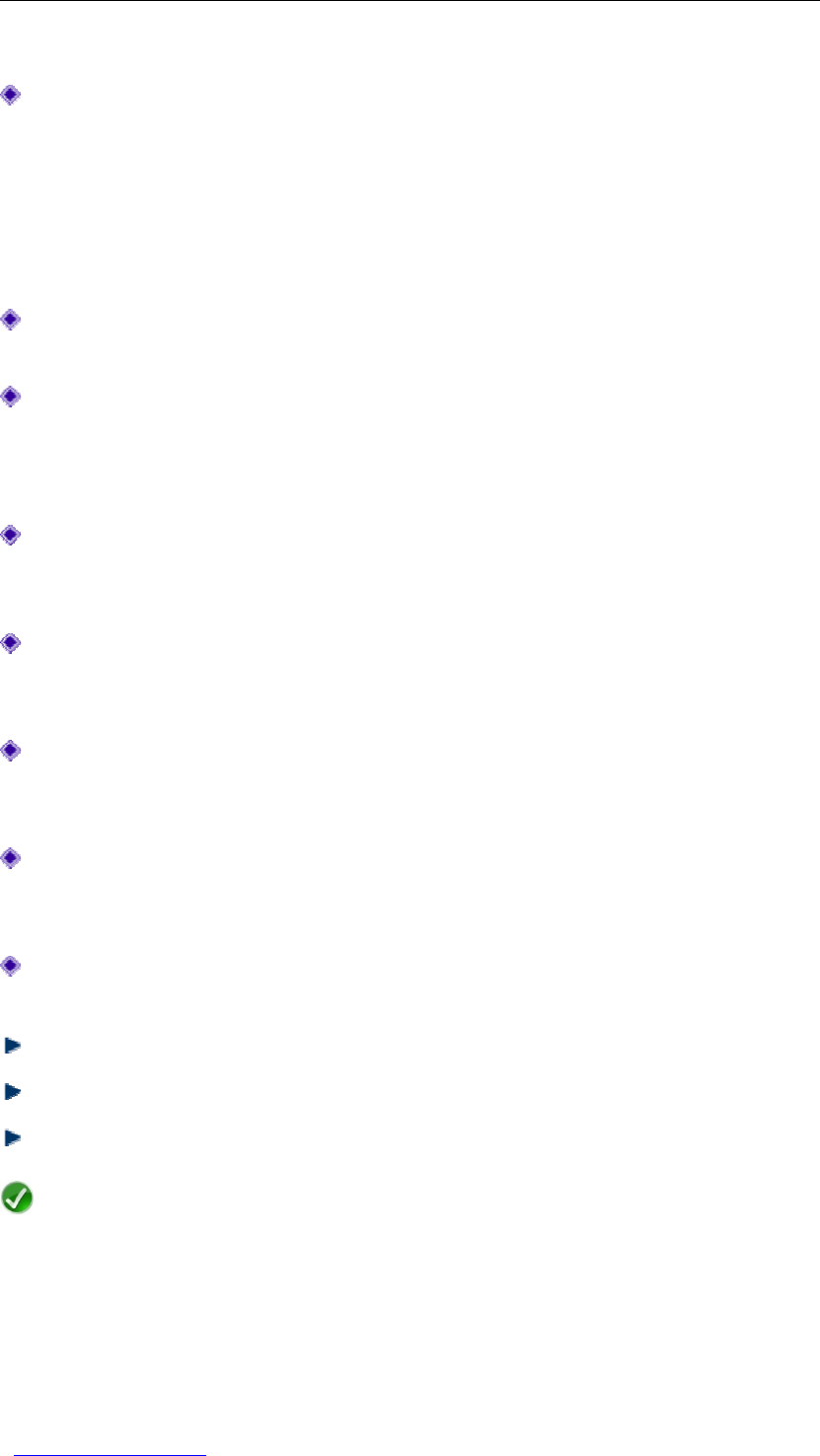
UTT Technologies Chapter 9 Firewall
http://www.uttglobal.com Page 148
be repeated.
Action: It specifies the action to be taken if a packet matches the access rule. The
available options are Allow and Deny.
●Allow: It indicates that the Wireless Router will allow the packets matching
the rule, that is, the Wireless Router will forward these packets.
●Deny: It indicates that the Wireless Router will deny the packets matching the
rule, that is, the Wireless Router will drop these packets.
Filtering Type: It specifies the filtering type of the access rule. The options are IP
Filtering,URL Filtering, and Keyword Filtering. Here please select IP Filtering.
Protocol: It specifies the protocol to which the access rule applies. The options are 1
(ICMP),6(TCP),17 (UDP),51 (AH),andAll. Select All if you want to the rule to
apply to all protocols. Apendix C provides the list of common IP protocols and their
protocol numbers.
Predefined Service: It provides some of the most common services and their
associated port numbers. Select All if you want to the rule to apply to all ports
1‐65535).Apendix D provides the list of common services and their port numbers.
Dest Port Start and Dest Port End: They specify a range of destination ports to
which the access rule applies. To specify a single port, enter the port number in both
text boxes. The port number must be between 1 and 65535.
Dest IP Start and Dest IP End: They specify a range of destination IP addresses to
which the access rule applies. To specify a single IP addres, enter the port number in
both text boxes.
Source Port Start and Source Port End: They specify a range of source ports to
which the access rule applies. To specify a single port, enter the port number in both
text boxes. The port number must be between 1 and 65535.
Schedule: It allows you to specify when the access rule is in effect. By default, the
access rule is always in effect.
Save: Click to save your changes.
Cancel: Click to revert to the last saved settings.
Back: ClicktogobacktotheAccess Rule List.
Note
By default, the Source IP Range is from 0.0.0.0 to 0.0.0.0, which means the access
rule applies to all computers on the LAN no matter what IP address they might have.
In this case, the Wireless Router will check any packets initiated from the LAN
computers, so the system performance will be degraded to some extent. Therefore,
you’d better change the default value.
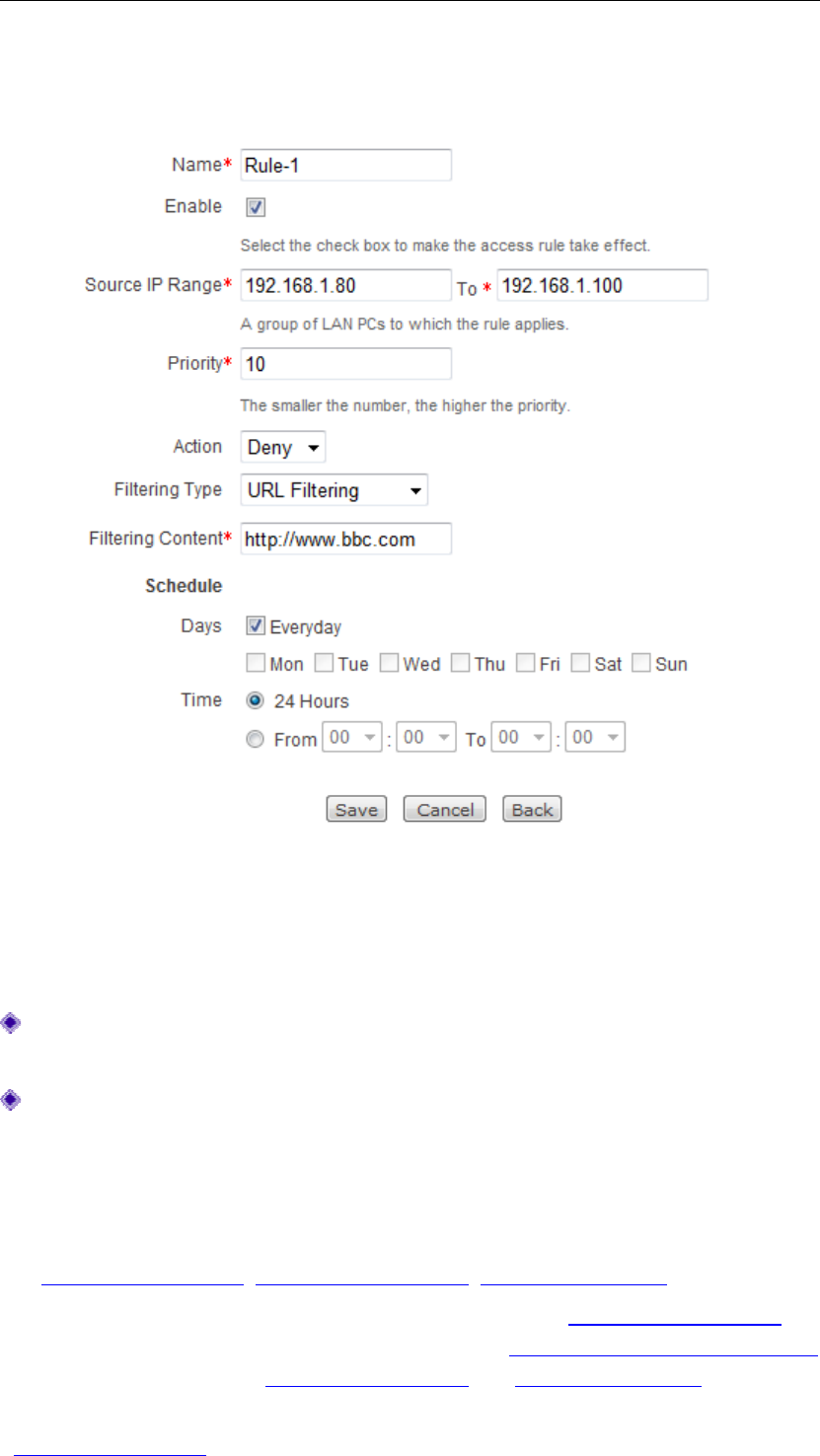
UTT Technologies Chapter 9 Firewall
http://www.uttglobal.com Page 149
9.1.3.2 Access Rule Settings - URL Filtering
Figure 9-5 Access Rule Settings - URL Filtering
The parameters Name,Source IP Range,Priority and Action,andSchedule related
parameters are the same as those of the IP Filtering access rule, please refer to Section
9.1.3.1 Access Rule Settings - IP Filtering for detailed information.
Filtering Type: It specifies the filtering type of the access rule. The options are IP
Filtering,URL Filtering, and Keyword Filtering. Here please select URL Filtering.
Filtering Content: It specifies the URL keyword that you want to filter. The access
rule is used to filter any web pages whose URL contains the specified keyword.
You can enter part of a URL to match all URLs that contain that string, or you can
enter the full URL to match only the specified URL. Here we give two examples.
Example1:Ifyouenteryahoo, it will match any URL that contains yahoo, such as
http://www.yahoo.com,http://news.yahoo.com/,http://cn.yahoo.com/,andsoon.
Example 2: If you enter news.yahoo.com, it will match http://news.yahoo.com/ and
all URLs that start with news.yahoo.com, such as http://news.yahoo.com/education/.
However, it won’t match http://www.yahoo.com and http://cn.yahoo.com/.
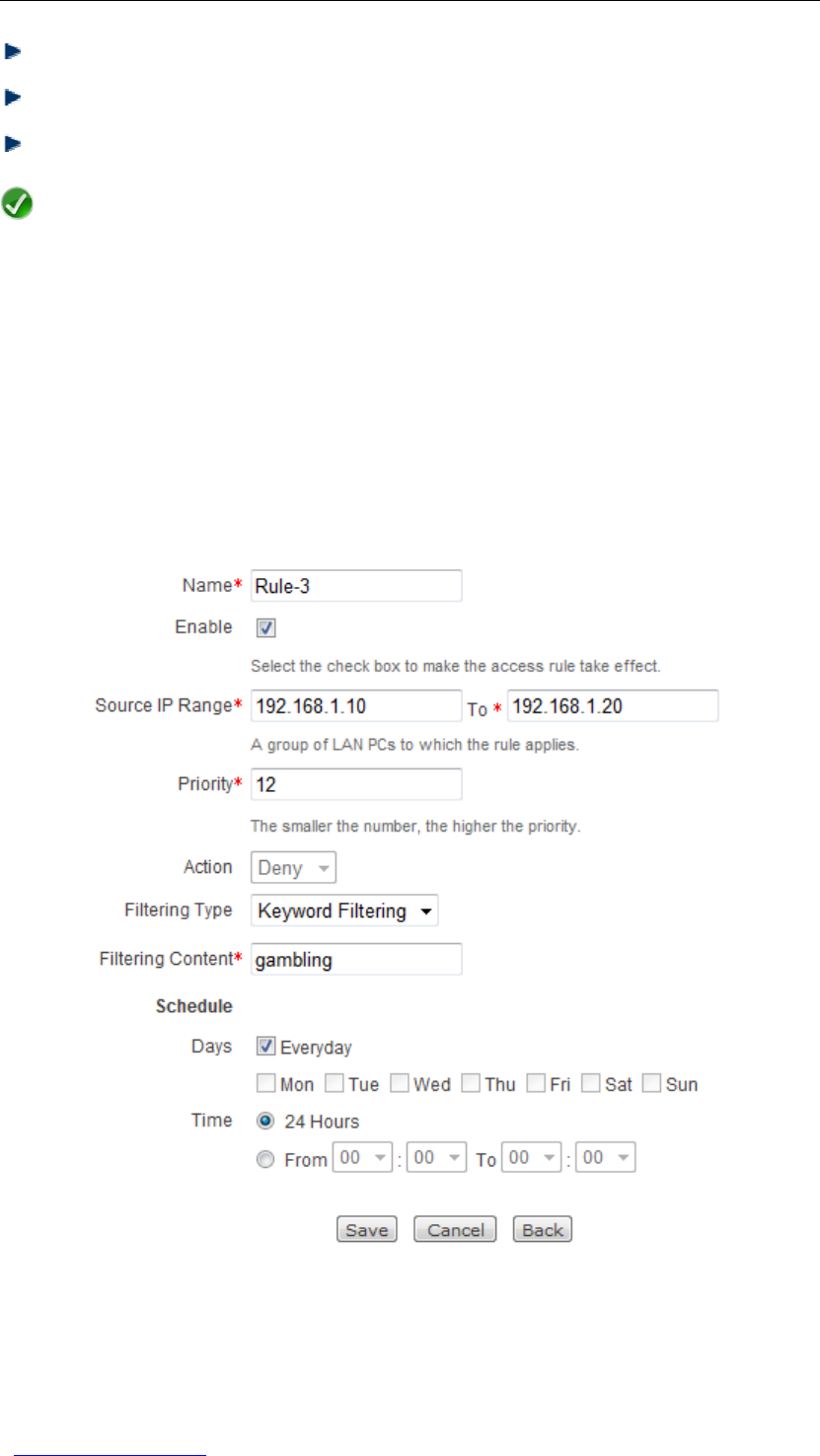
UTT Technologies Chapter 9 Firewall
http://www.uttglobal.com Page 150
Save: Click to save your changes.
Cancel: Click to revert to the last saved settings.
Back: ClicktogobacktotheAccess Rule List.
Note
1. The URL keyword that you enter in the Filtering Content text box is case
insensitive, and it needn’t include http://.
2. The URL filtering rules cannot be used to control users’ access to other services
through a web browser. For example, to control users’ access to ftp://ftp.utt.com.cn,
you need to configure an IP filtering rule to allow or deny ftp service.
9.1.3.3 Access Rule Settings - Keyword Filtering
Figure 9- 6 Access Rule Settings - Keyword Filtering
The parameters Name,Source IP Range,Priority and Action,andSchedule related
parameters are the same as those of the IP Filtering access rule, please refer to Section

UTT Technologies Chapter 9 Firewall
http://www.uttglobal.com Page 151
9.1.3.1 Access Rule Settings - IP Filtering for detailed information.
Filtering Type: It specifies the filtering type of the access rule. The options are IP
Filtering,URL Filtering,andKeyword Filtering. Here please select Keyword
Filtering.
Filtering Content: It specifies the keyword that you want to block. The access rule is
used to block users from submitting any information that contains the specified
keyword to any web page. The Wireless Router supports both Chinese and English
keyword filtering. A keyword must be a single word without white space.
Save: Click to save your changes.
Cancel: Click to revert to the last saved settings.
Back: ClicktogobacktotheAccess Rule List.
Note
1. The keyword filtering rules only support the Deny action.
2. The English keyword is case sensitive.
9.1.4 Configuration Examples for Access Rule
9.1.4.1 Example 1 -Only Allow a Group of Users to
Access Certain Services
In this example, we want to allow a group of users (IP address range:
192.168.1.10-192.168.1.20) to access web service, and block them from accessing any
other services.
We need to create three access rules to meet the requirements:
●Access rule 1: It allows those users to access DNS service. And it is used to ensure
that the domain names can be resolved successfully, thus the users can access web
service properly.
●Access rule 2: It allows those users to access Web service.
●Access rule 3: It blocks those users from accessing any Internet services.
Therein, both rule 1 and rule 2 must have a higher priority than rule 3. Otherwise, rule 3
will be matched first. This will make those users unable to access web service.
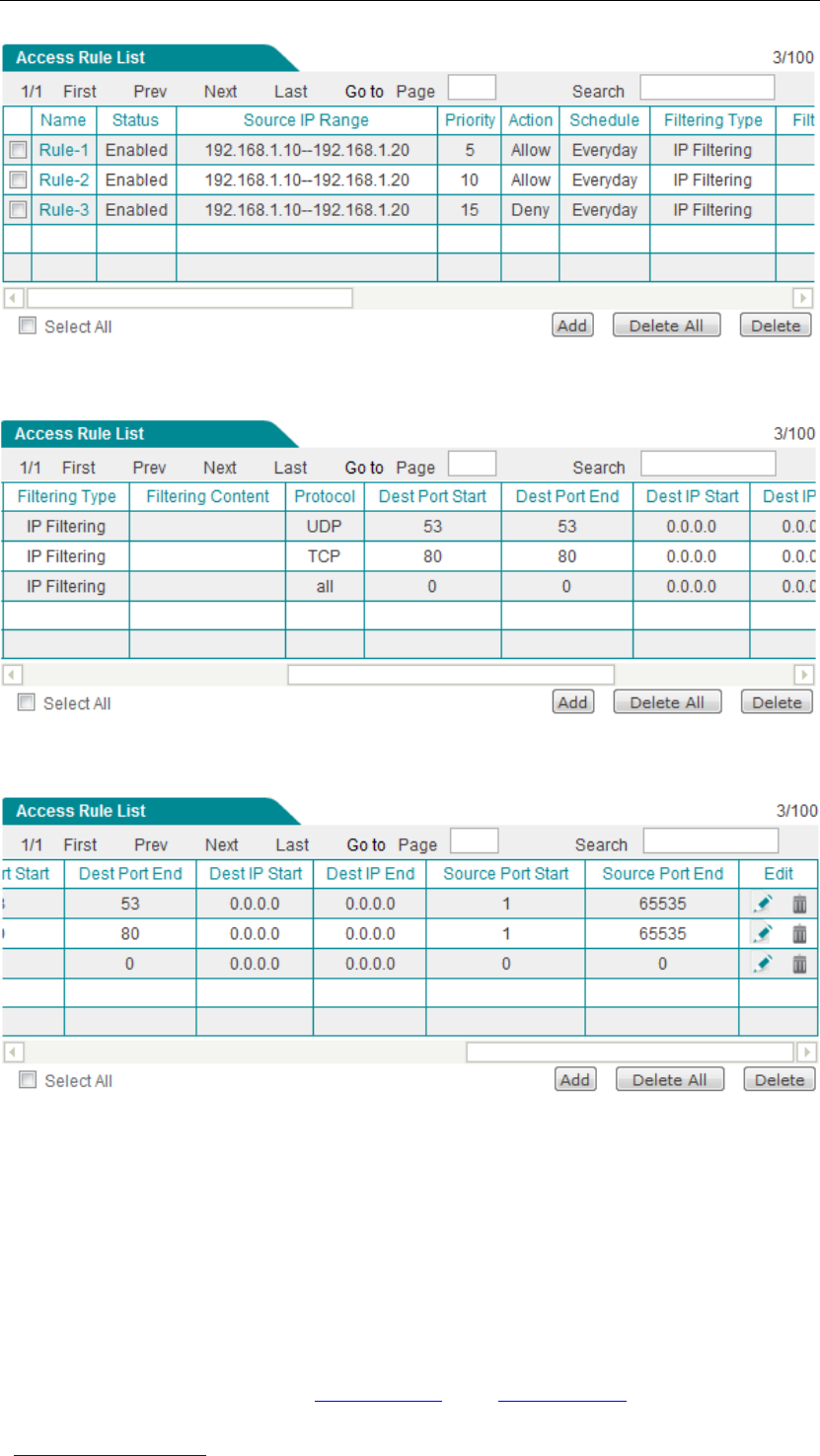
UTT Technologies Chapter 9 Firewall
http://www.uttglobal.com Page 152
Figure 9- 7 Access Rule List - Example 1
Figure 9- 8 Access Rule List - Example 1 (Continue)
Figure 9- 9 Access Rule List - Example 1 (Continue)
9.1.4.2 Example 2 -Only Block a Group of Users from
Accessing Certain Services
In this example, we want to block a group of users (IP address range: 192.168.1.80
-192.168.1.100) from accessing www.bbc.com and www.cnn.com, and allow them to
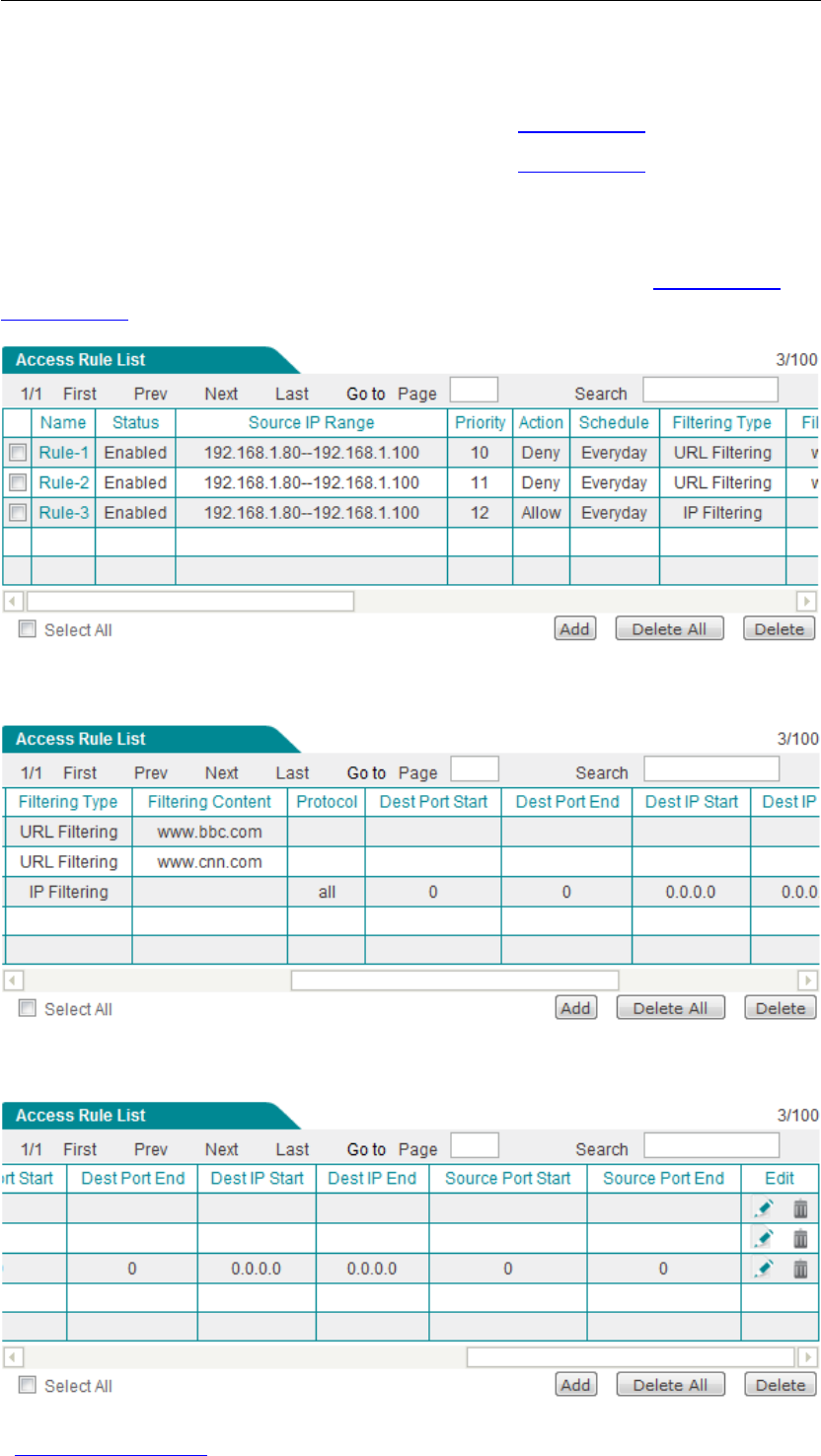
UTT Technologies Chapter 9 Firewall
http://www.uttglobal.com Page 153
access any other services. We need to create three access rules to meet the
requirements:
●Access rule 1: It blocks those users from accessing www.bbc.com.
●Access rule 2: It blocks those users from accessing www.cnn.com.
●Access rule 3: It allows those users to access all Internet services.
Therein, both rule 1 and rule 2 must have a higher priority than rule 3. Otherwise, rule 3
will be matched first. This will make those users unable to access www.bbc.com and
www.cnn.com.
Figure 9-10 Access Rule List - Example 2
Figure 9- 11 Access Rule List - Example 2 (Continue)
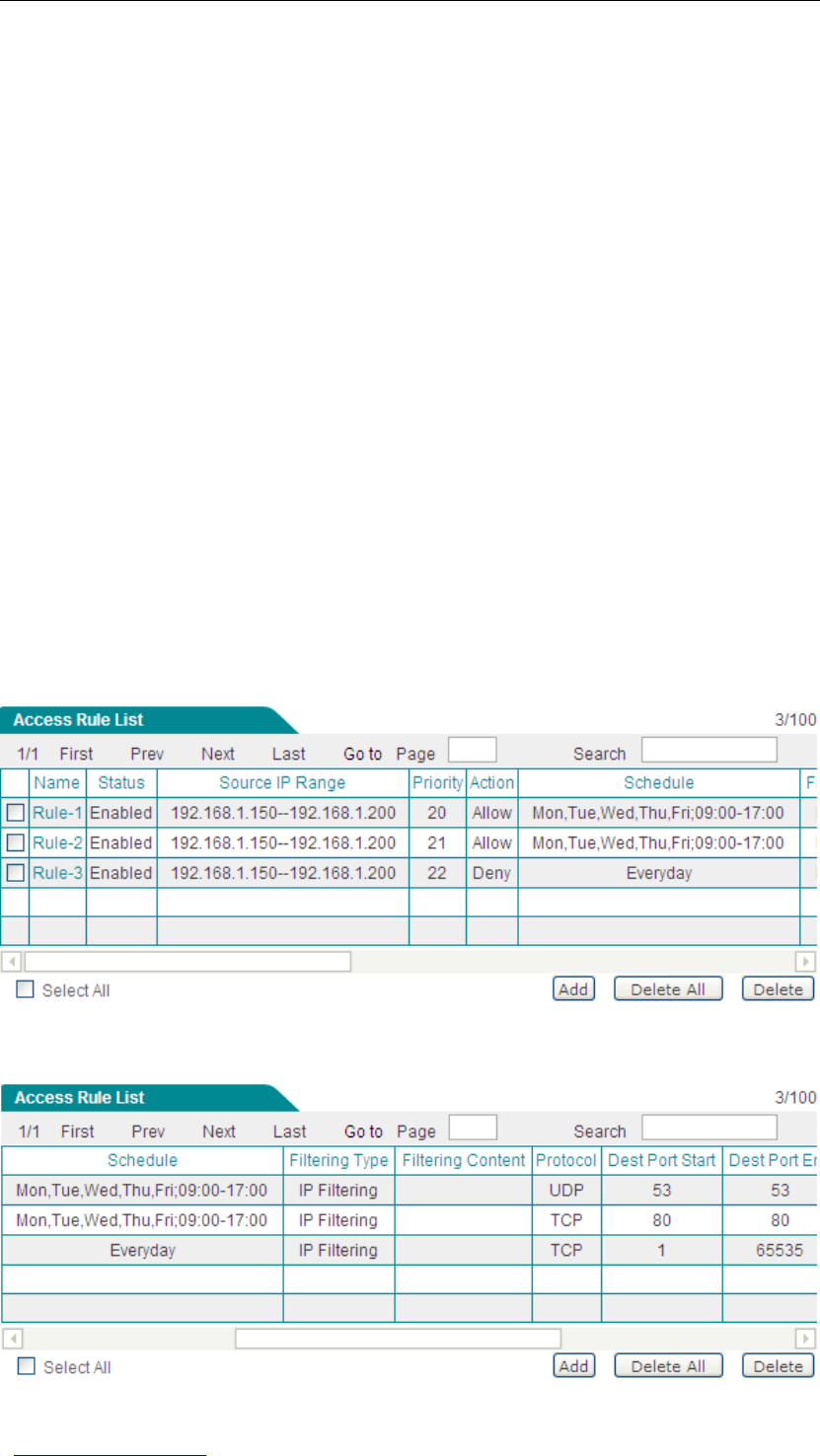
UTT Technologies Chapter 9 Firewall
http://www.uttglobal.com Page 154
Figure 9-12 Access Rule List - Example 2 (Continue)
9.1.4.3 Example 3 -Control Internet Behaviors of a
Group of Users based on Schedule
In this example, we want to only allow a group of users (IP address range: 192.168.1.150
-192.168.1.200) to access web service during business hours (Monday to Friday, 9:00 to
17:00), and block them from accessing any Internet services during rest periods.
We need to create three access rules to meet the requirements:
●Access rule 1: It allows those users to access DNS service during business hours.
And it is used to ensure that the domain names can be resolved successfully, thus the
users can access web service properly.
●Access rule 2: It allows those users to access web service during business hours.
●Access rule 3: It blocks those users from accessing any Internet services.
Therein, both rule 1 and rule 2 must have a higher priority than rule 3. Otherwise, rule 3
will be matched first. This will make those users unable to access web service during
business hours.
Figure 9-13 Access Rule List - Example 3
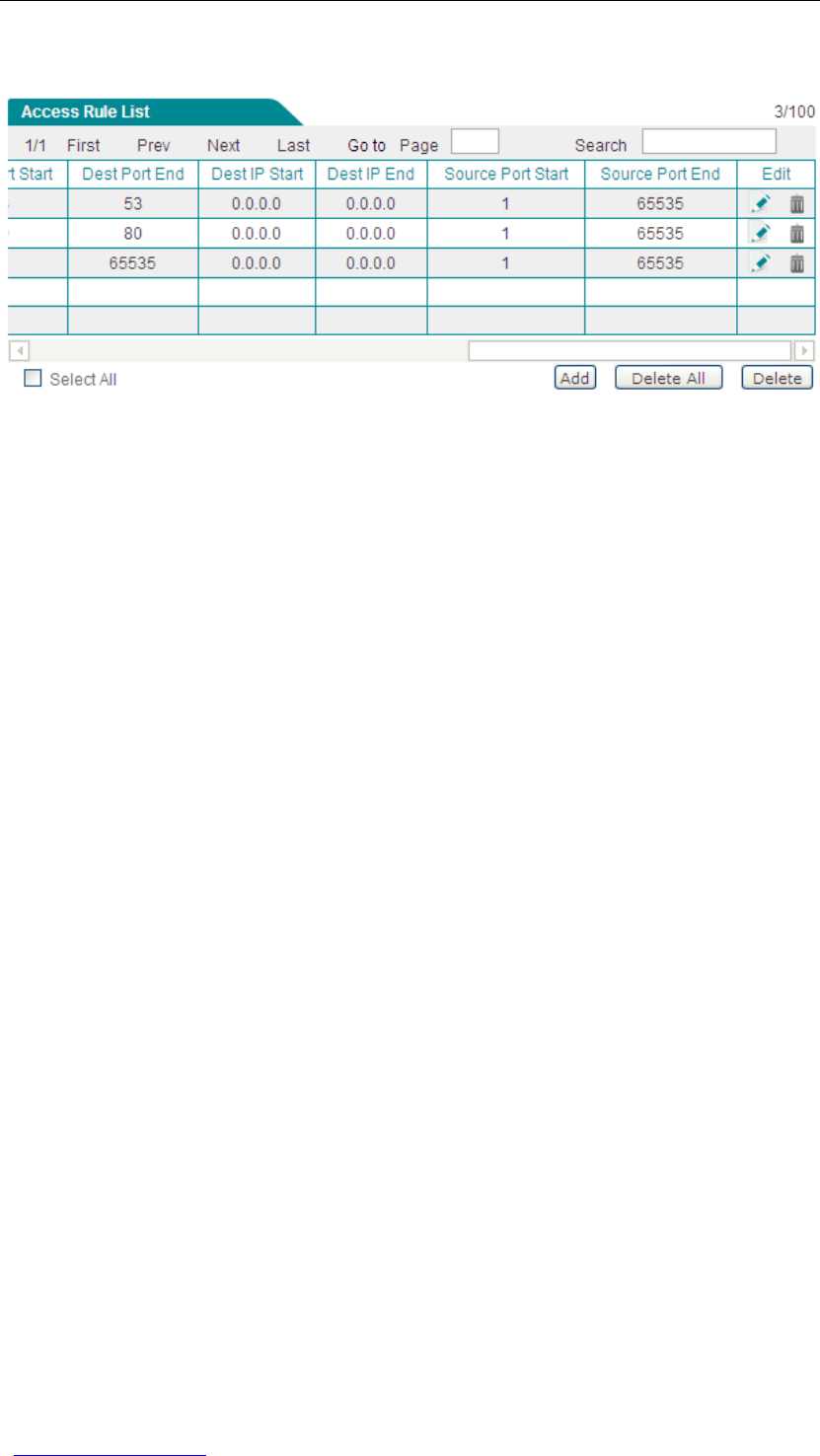
UTT Technologies Chapter 9 Firewall
http://www.uttglobal.com Page 155
Figure 9-14 Access Rule List - Example 3 (Continue)
Figure 9-15 Access Rule List - Example 3 (Continue)
9.1.4.4 Example 4 -Control Internet Behaviors of a
Single User
You can assign a range of contiguous IP addresses to the users that have the same
Internet access privileges, and then create access rules for the user group. However, if
one or several users in the group have special or new Internet needs, you need to
individually create access rules for a single user.
In this example, we want to allow a group of users (IP address range:
192.168.1.10-192.168.1.120) to access web service, and block them from accessing all
other services. The exception is that the user with IP address 192.168.1.16 is allowed to
access all Internet services during business hours (Monday to Friday, 9:00 to 17:00).
We need to create four access rules to meet the requirements:
●Access rule 1: It allows the user group to access DNS service.
●Access rule 2: It allows the user group to access web service.
●Access rule 3: It allows the user with IP address 192.168.1.16 to access all Internet
services during business hours.
●Access rule 4: It blocks the user group from accessing any Internet services.
Therein, rule 4 must have a lower priority than the other three rules.
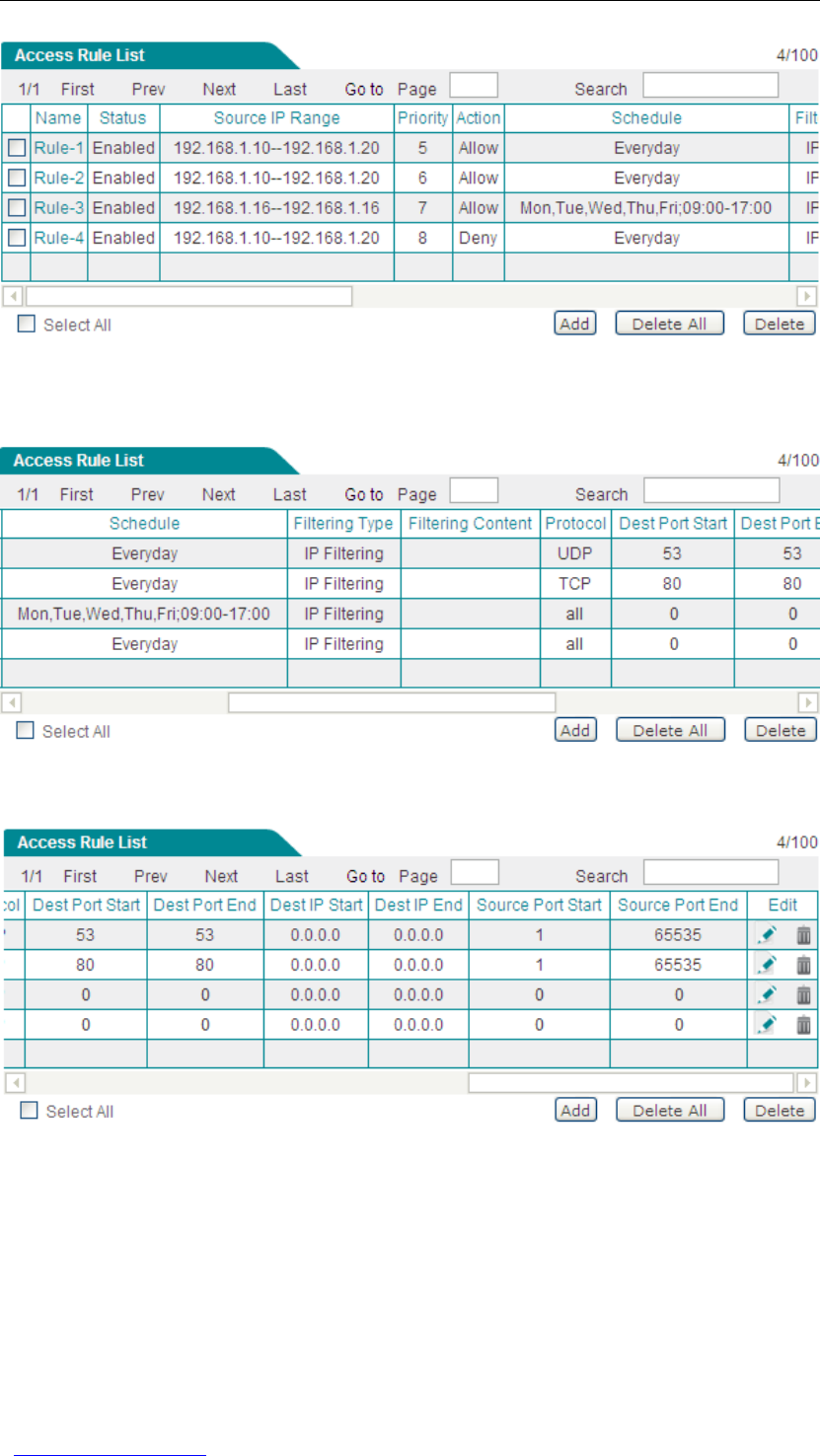
UTT Technologies Chapter 9 Firewall
http://www.uttglobal.com Page 156
Figure 9-16 Access Rule List - Example 4
Figure 9-17 Access Rule List - Example 4 (Continue)
Figure 9-18 Access Rule List - Example 4 (Continue)
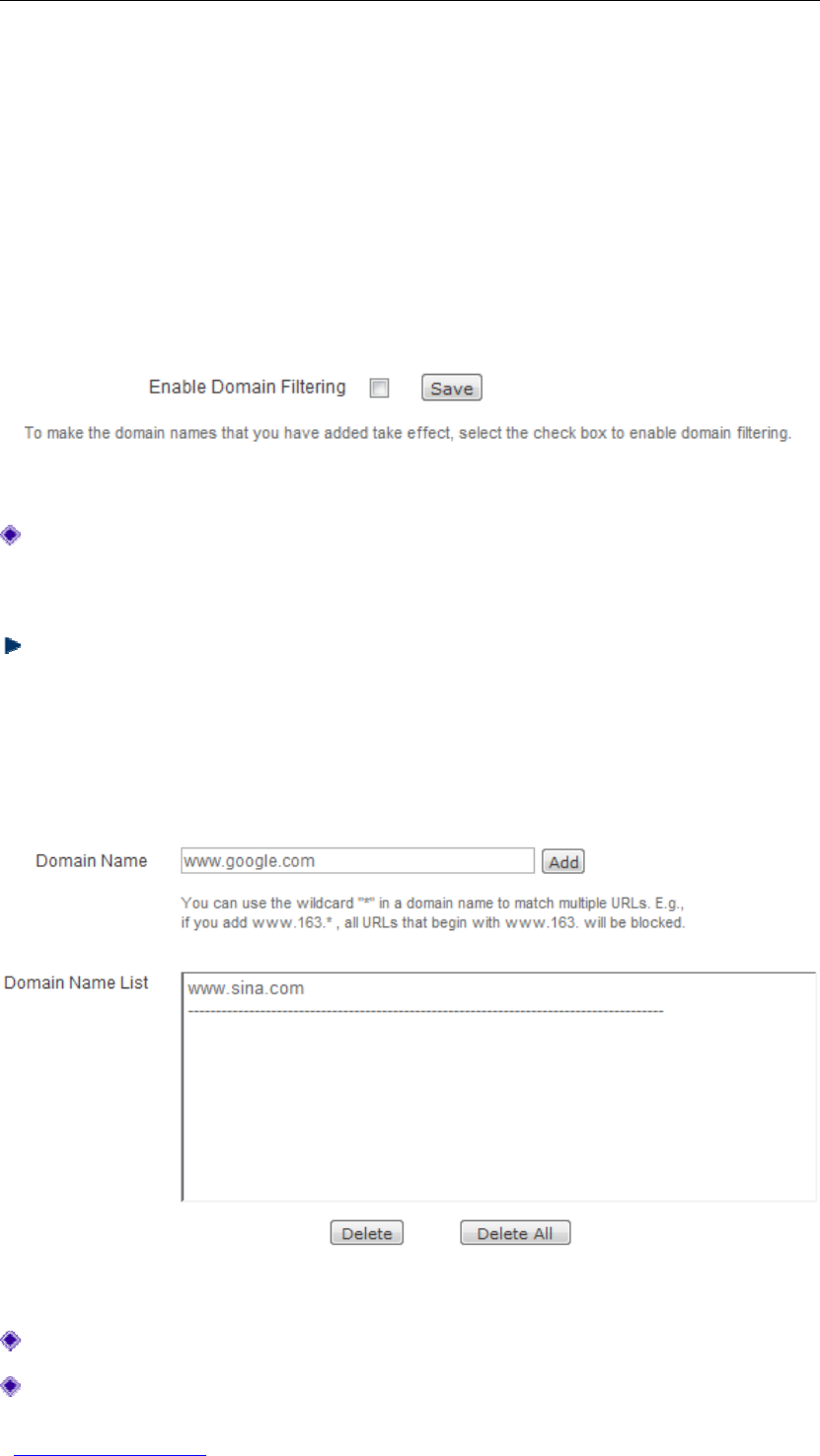
UTT Technologies Chapter 9 Firewall
http://www.uttglobal.com Page 157
9.2 Domain Filtering
This section describes the Firewall > Domain Filtering page. The domain filtering feature
allows you to block access to unwanted websites in your organization.
9.2.1 Domain Filtering Global Settings
Figure 9- 19 Domain Filtering Global Settings
Enable Domain Filtering: It allows you to enable or disable domain filtering. If you
select the check box to enable domain filtering, the domain names in the Domain
Name List will take effect. Else, they will be of no effect.
Save: Click to save your changes.
9.2.2 Domain Filtering Settings
Figure 9-20 Domain Filtering Settings
Domain Name: It specifies the domain name of the website that you want to block.
Domain Name List: It displays the domain names that you have added. The

UTT Technologies Chapter 9 Firewall
http://www.uttglobal.com Page 158
Wireless Router will block the LAN users from accessing these domain names.
Add a Domain Name: To add a domain name to the Domain Name List, enter the
domain name of the website that you want to block in the Domain Name text box,
and then click the Add button. You can add up to 100 domain names in the list.
Delete: To delete one or more domain names, select them in the Domain Name List,
and then click the Delete button.
Delete All: To delete all the domain names in the Domain Name List at a time,
directly click the Delete All button.
Note
1. The Wireless Router supports up to 100 domain names.
2. The matching rule of domain filtering is whole words matching, that is, only a
domain name matches the whole words of the domain name in the Domain Name
List, the Wireless Router will block access to it.
3. You can use the wildcard "*" in a domain name to filter multiple URLs. For
example, if you add www.163.* into the Domain Name List, then all the URLs that
begin withwww.163. will be blocked.
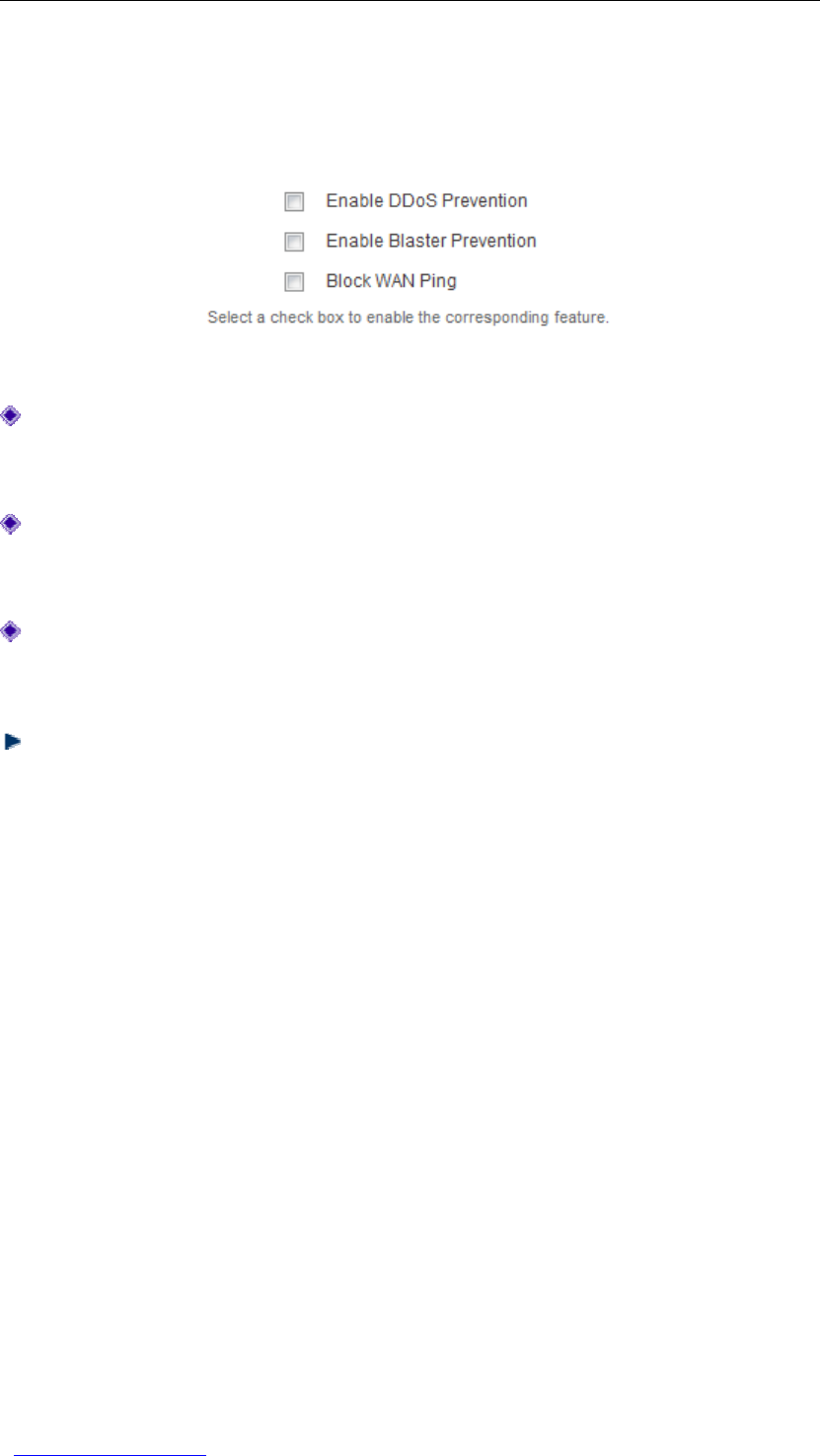
UTT Technologies Chapter 9 Firewall
http://www.uttglobal.com Page 159
9.3 Attack Prevention
This section describes the Firewall > Attack Prevention page.
Figure 9- 21 Attack Prevention Settings
Enable DDoS Prevention: It is used to enable or disable DDoS prevention. If you
select the check box to enable this feature, it will effectively protect the Wireless
Router against popular DoS/DDoS attacks.
Enable Blaster Prevention It is used to enable or disable blaster virus prevention. If
you select the check box to enable this feature, it will effectively protect the Wireless
Router against popular virus attacks such as Blaster and Sasser.
Block WAN Ping: It is used to block or allow WAN ping. If you select the check box to
block WAN ping, all the WAN interfaces of the Wireless Router will not respond to
ping requests from the Internet.
Save: Click to save your changes.
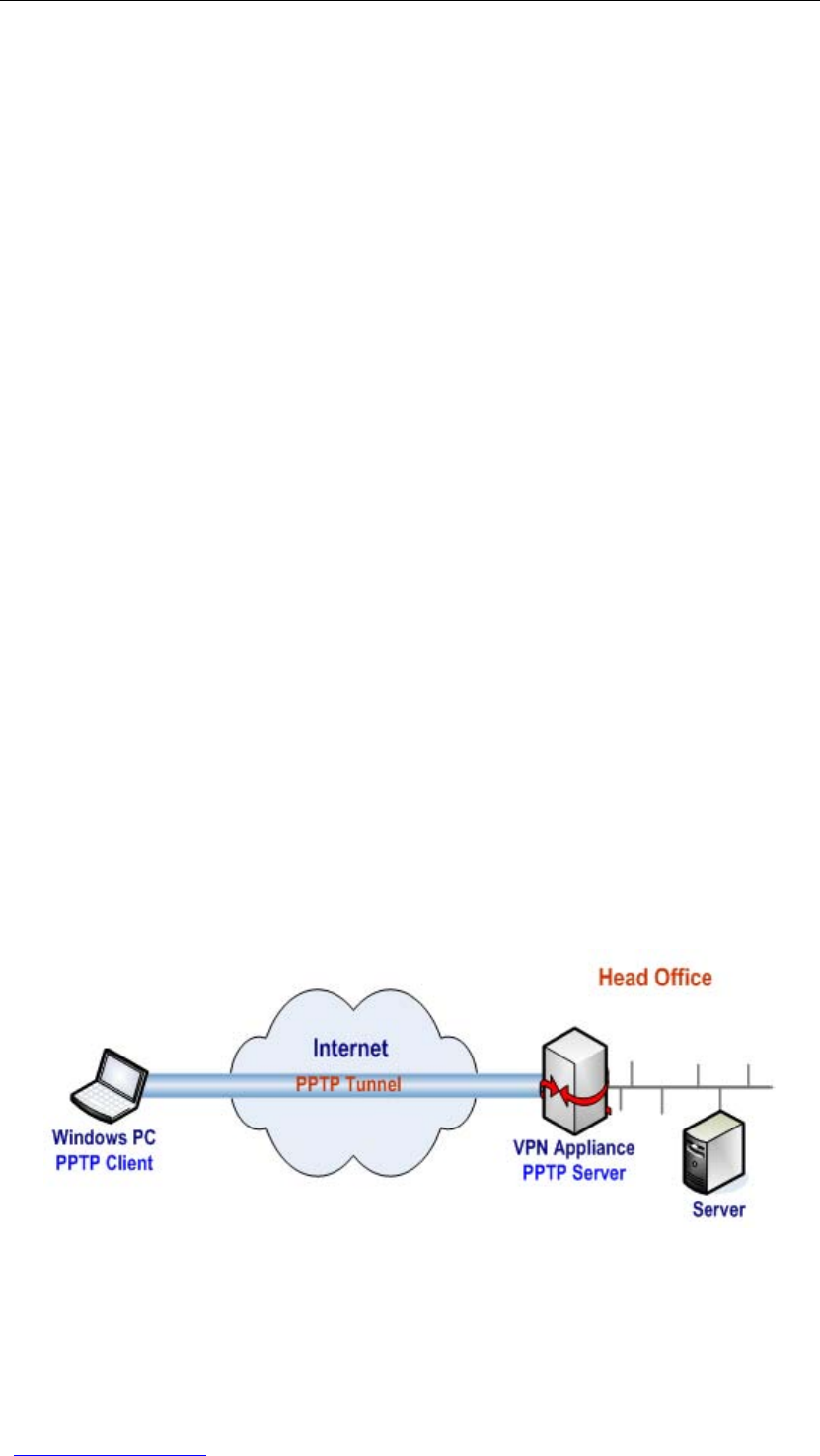
UTT Technologies Chapter 10 VPN
http://www.uttglobal.com Page 160
Chapter 10 VPN
The Wireless Router supports PPTP client feature. PPTP is a VPN tunneling protocol
which encapsulates PPP frames in IP packets for transmission over a public IP network
such as the Internet. PPTP is based on client/server model. The PPTP client initiates a
PPTP connection to the server, while the PPTP server accepts the incoming PPTP
connection from the client. PPTP is often used to implement remote access VPNs over an
IP network (such as a broadband network), to extend the reach of your Intranet.
10.1 Introduction to PPTP Implementation
PPTP is used to encapsulate PPP frames in IP packets for transmission over a public IP
network such as the Internet. The PPTP client or server encapsulates the original user
packets inside PPP frames before sending them through a PPTP tunnel over the Internet;
while the peer performs decapsulation firstly, and then forward the original packets to their
intended destinations.
As shown in Figure 10- 1, the typical application of PPTP is that some laptop or desktop
computers act as the PPTP client devices, that is, some employees in the remote branch
offices or mobile users (traveling employees, telecommuters, etc.) use the Windows
built-in PPTP client software to initiate PPTP connections; the PPTP server deployed at
the head office accepts the PPTP incoming connections from the clients. After a PPTP
tunnel has been established between the PPTP client and server, the PPTP server will
receive the PPTP packets from the client firstly, and then perform decapsulation, lastly
forward the original packets to their intended destinations.
Figure 10- 1 Typical Application of PPTP

UTT Technologies Chapter 10 VPN
http://www.uttglobal.com Page 161
10.1.1 Protocol Overview
There are two parallel components of PPTP:
1. A PPTP Control Connection
It is a logical connection representing the PPTP tunnel that must be created, maintained,
and terminated through a series of PPTP messages. The PPTP control connection traffic
uses a dynamically allocated TCP port on the PPTP client and the registered TCP port
1723 on the PPTP server.
2. GRE encapsulation for data
When data is sent through the PPTP tunnel, PPP frames are encapsulated with a Generic
Routing Encapsulation (GRE) header, which includes information that identifies the
specific PPTP tunnel for the data packet. GRE is described in RFC 1701.
The use of a separate GRE mechanism for PPTP data encapsulation has an interesting
side effect for NAT devices. Most NAT devices can translate TCP-based packets for PPTP
tunnel maintenance. However, many NAT devices or firewalls cannot handle GRE packets,
thus the PPTP data packets with the GRE header cannot pass them. The UTT products
support NAT traversal for PPTP tunnels.
In order for the PPTP tunnel to be established and function properly, the following basic
conditions are necessary:
1) The PPTP client and server should have IP-route reachability between them.
2) The firewalls between the two endpoints of the tunnel should be configured to open
TCP port 1723 and IP protocol 47 (GRE) to allow PPTP traffic.
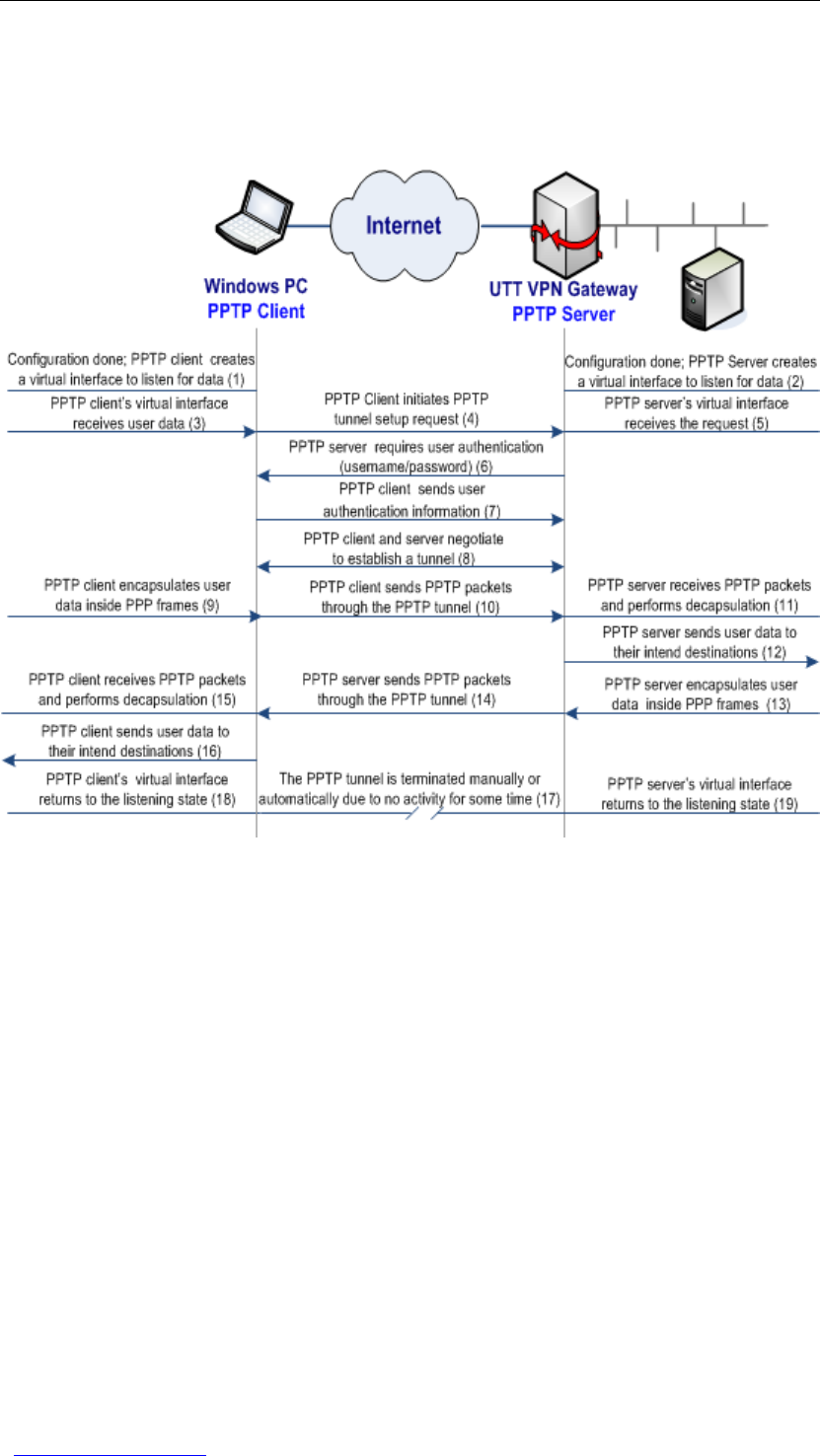
UTT Technologies Chapter 10 VPN
http://www.uttglobal.com Page 162
10.1.2 Packet Flow - PPTP Client
Figure 10- 2 PPTP Packet Flow
As shown in Figure 10- 2, during the PPTP tunnel establishment and data transmission
processes, the packet flow through the PPTP client can be summarized as follows:
¾After the PPTP tunnel parameters are configured properly, the PPTP client
automatically creates a virtual interface for the new tunnel to listen for user data ((1)
in Figure 10- 2).
¾The PPTP client’s virtual interface listens for the user packets destined for the remote
LAN ((3) in Figure 10- 2).
¾The PPTP client initiates the PPTP tunnel setup request ((4) in Figure 10- 2).
¾The PPTP client receives the user authentication request from the PPTP server, and
then responds to the request ((7) in Figure 10- 2).
¾The PPTP client negotiates with the PPTP server to establish a PPTP tunnel ((8) in
Figure 10- 2).
¾The PPTP client receives the user data (i.e., original packets) and encapsulates them
in the PPP frames ((9) in Figure 10- 2).

UTT Technologies Chapter 10 VPN
http://www.uttglobal.com Page 163
¾The PPTP client sends the PPTP packets to the PPTP server through the PPTP
tunnel ((10) in Figure 10- 2).
¾The PPTP client receives the PPTP packets from the PPTP server, and performs
decapsulation ((15) in Figure 10- 2).
¾The PPTP client forwards the user data (i.e., original packets) to their intend
destinations ((16) in Figure 10- 2).
¾The PPTP tunnel is terminated manually by the user or automatically due to no
activity for some time ((17) in Figure 10- 2).
¾After the PPTP tunnel is terminated, the PPTP client’s virtual interface returns to the
listening state ((18) in Figure 10- 2).
10.1.3 User Authentication
PPTP provides user authentication to authenticate the user attempting the PPTP
connection by PPP-based user authentication modes such as PAP, CHAP, etc. Note that
the two endpoints of a PPTP tunnel should use the same authentication mode.
On the Wireless Router, it allows you to choose PAP, CHAP or Either as the user
authentication mode for a PPTP client. It also allows you to choose None, which means
that no authentication is performed. By default, the authentication mode is Either, which
means that the PPTP client will automatically negotiate it with peer.
10.1.4 Data Confidentiality
PPTP doesn’t provide any data encryption service by itself; it uses PPP compression and
encryption mechanisms (such as CCP, PPE, etc.) to provide data confidentiality.
10.1.5 MTU and Fragmentation
The Wireless Router will fragment an IP packet if it exceeds the MTU of the outbound
physical interface. For example, a standard Ethernet-type interface has a MTU of 1500
bytes, thus the Wireless Router will fragment a packet exceeding 1500 bytes in order to
transmit it over the Ethernet interface.
With PPTP, the addition of PPTP headers may cause IP fragmentation. When an IP
packet is nearly the size of MTU of the outbound physical interface (for example, ERP or
FTP packets are often relatively large), and it is further encapsulated with PPTP headers,
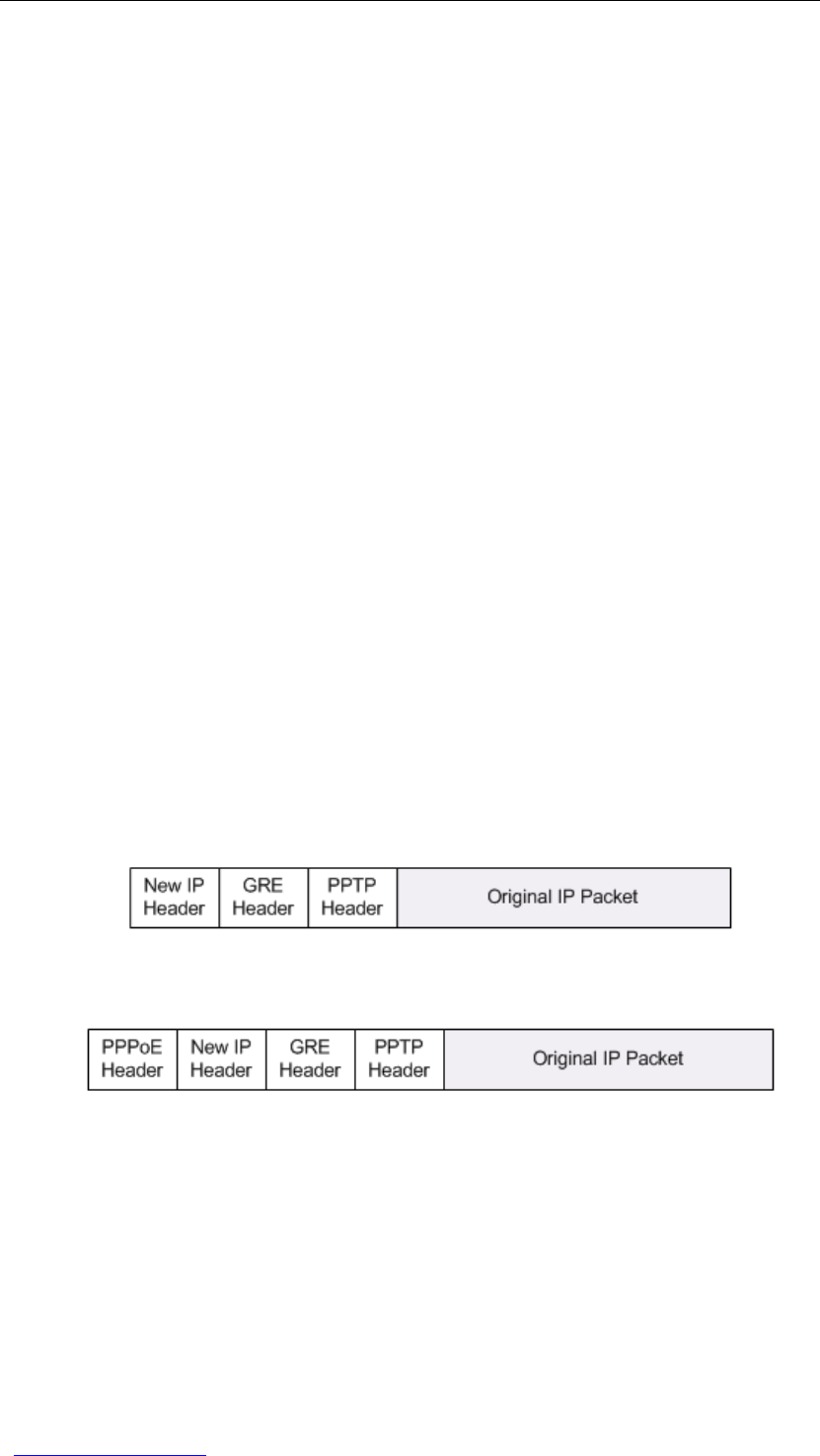
UTT Technologies Chapter 10 VPN
http://www.uttglobal.com Page 164
the encapsulated packet is likely to exceed the MTU of the outbound physical interface.
This causes the encapsulated packet to be fragmented before transmission, and the
PPTP receiver is responsible for reassembling the fragments back into the original
encapsulated packet before decapsulation. More specifically, the receiver cannot perform
reassembly until the last fragment is received; and if one fragment is lost, the entire
original encapsulated packet must be resent, and it will also be fragmented.
Data fragmentation and reassembly can seriously degrade the system performance, so it
is highly necessary to avoid fragmentation and reassembly in the PPTP switching path. To
solve this problem, PPTP allows the client and server to negotiate PPP MRU/MTU during
PPTP tunnel establishment.
In addition, on the Wireless Router, you can adjust the global PPTP tunnel MTU (i.e.,
tunnelmtu) to minimize the fragmentation: if an IP packet exceeds the specified MTU, it
will be fragmented by the original computer before transmission. The following two
examples describe how to calculate PPTP tunnel MTU. Figure 10- 3 illustrates the format
of the PPTP packet to be sent over a static IP or DHCP Internet connection; and Figure
10- 4 illustrates the format of the PPTP packet to be sent over a PPPoE Internet
connection. Therein, the sizes of standard Ethernet MTU and each encapsulation header
are as follows:
Ethernet MTU 1500 Bytes
IP Header 20 Bytes
GRE Header 8 Bytes
PPTP Header 30 Bytes (at most)
PPPoE Header 8 Bytes
Figure 10-3 PPTP Packet Format - Static IP/DHCP Internet Connection
Figure 10-4 PPTP Packet Format - PPPoE Internet Connection
Therefore, to avoid fragmentation and reassembly in the PPTP switching path, the PPTP
tunnel MTU should be smaller or equal to 1442 bytes (1500-20-8-30=1442) when the
PPTP packets are sent over a static IP or DHCP Internet connection (see Figure 10- 3);
and it must be smaller or equal to 1434 bytes (1442-8=1434) when the PPTP packets are
sent over a PPPoE Internet connection (see Figure 10- 4).
On the Wireless Router, the PPTP tunnel MTU is 1400 bytes by default. In most cases,
please leave the default value because it can meet most application needs.
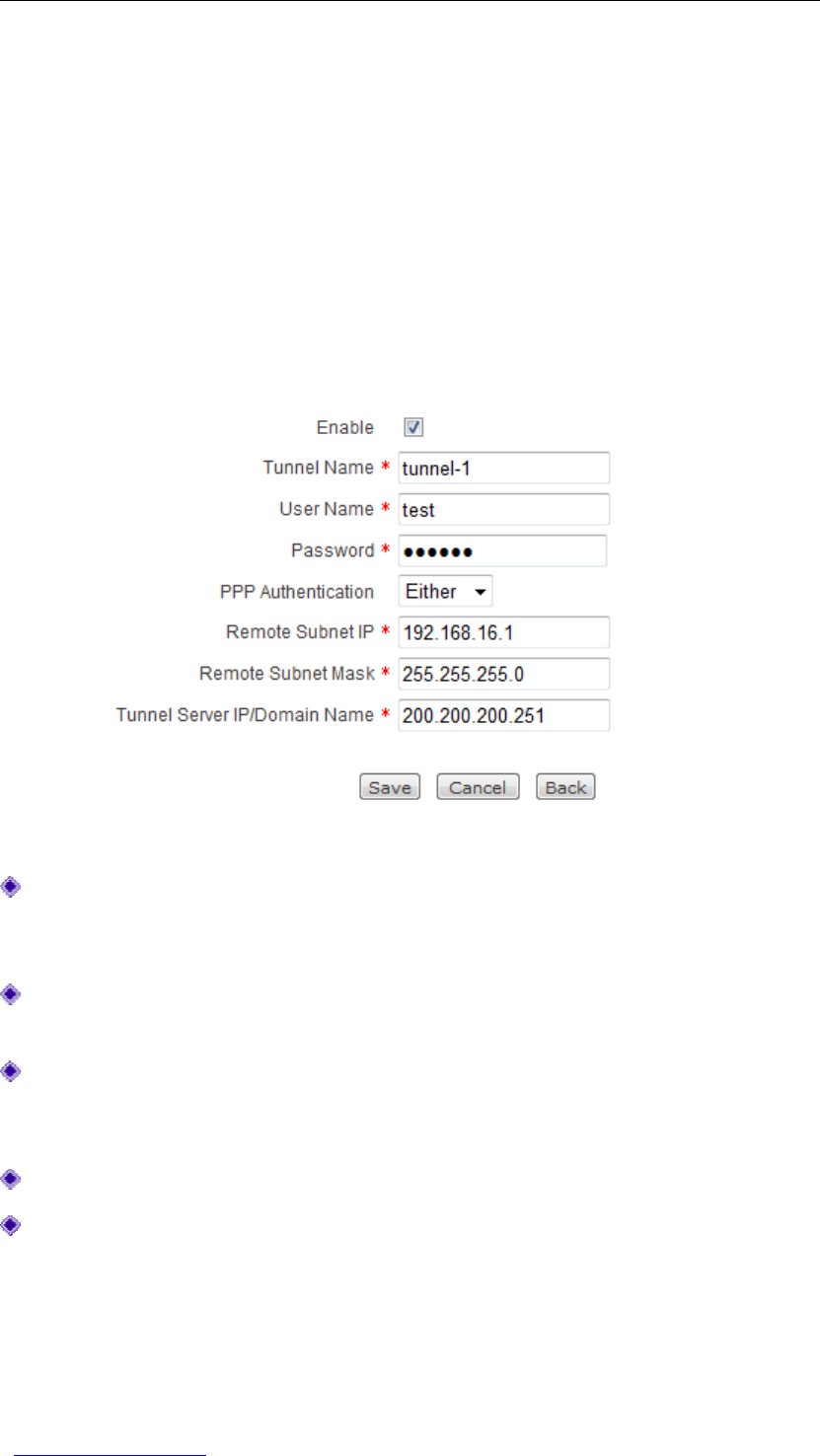
UTT Technologies Chapter 10 VPN
http://www.uttglobal.com Page 165
10.1.6 PPTP Sessions Limit
The Wireless Router supports two concurrent PPTP sessions (i.e., tunnels) at most. If
there are already two active PPTP sessions on the Wireless Router, the system will reject
any request for creating a new PPTP session and prompt you.
10.2 PPTP Client Settings
Figure 10-5 PPTP Client Settings
Enable: It allows you to enable or disable the PPTP client entry. The default value is
checked, which means the PPTP client entry is in effect. If you want to disable the
entry temporarily instead of deleting it, please clear the check box.
Tunnel Name: It specifies a unique name of the PPTP tunnel. It is used to identify
multiple tunnels.
User Name: It specifies a unique user name of the PPTP/L2TP client. It must be
between 1 and 31 characters long. The remote PPTP/L2TP server will use the User
Name and Password to identify the client.
Password: It specifies a password of the PPTP/L2TP client.
PPP Authentication: It specifies the PPP authentication mode by which the remote
PPTP server authenticates the PPTP client. The available options are None,PAP,
CHAP and Either.
•PAP: Password Authentication Protocol.
•CHAP: Challenge Handshake Authentication Protocol.
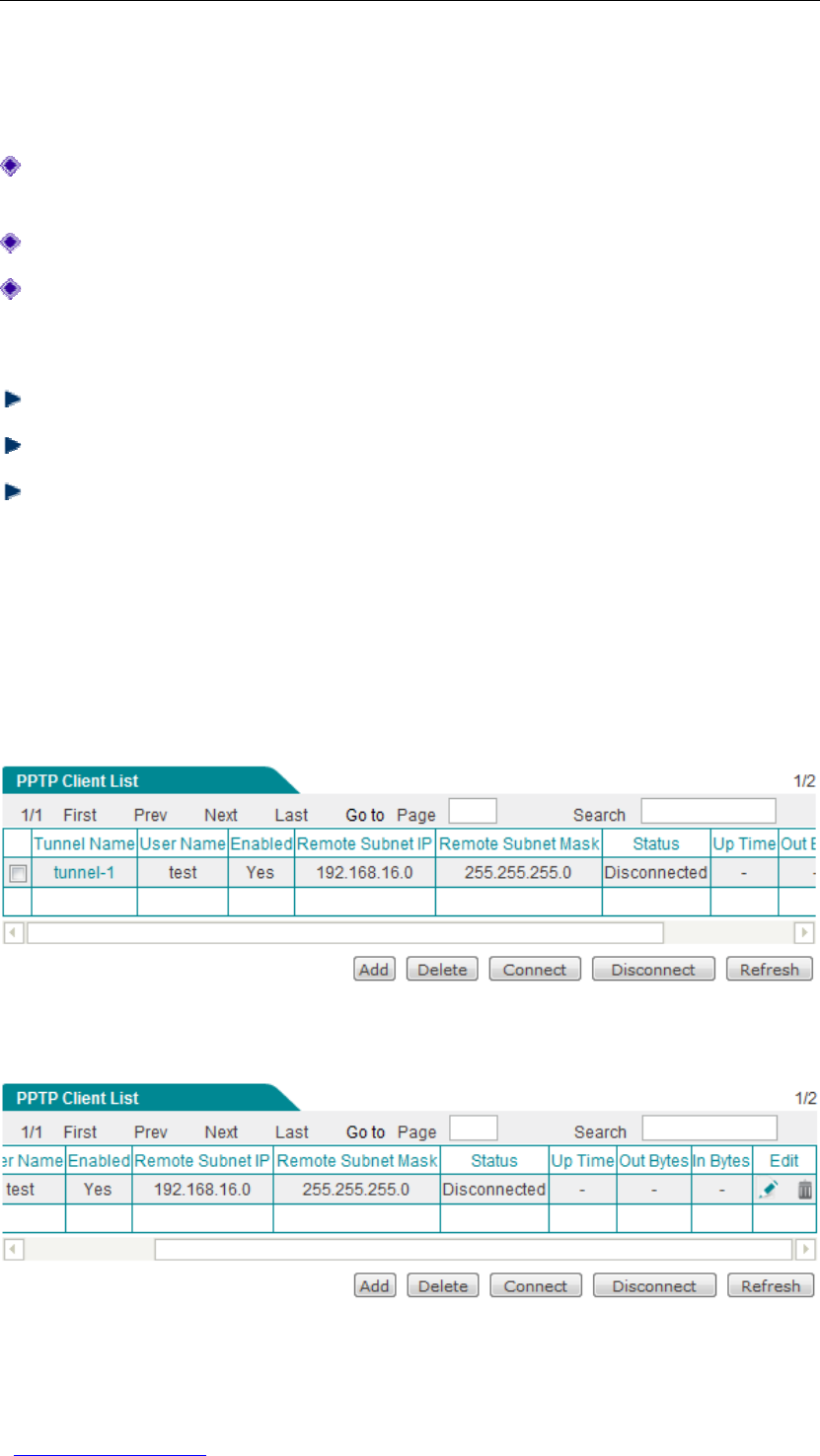
UTT Technologies Chapter 10 VPN
http://www.uttglobal.com Page 166
•None: It means that no authentication is performed.
•Either: It means that the Wireless Router will automatically negotiate it with the
remote VPN appliance.
Remote Subnet IP: It specifies the subnet IP address of the remote network. In most
cases, you may enter the IP address of the remote VPN appliance’s LAN interface.
Remote Subnet Mask: It specifies the subnet mask of the remote network.
Tunnel Server IP/Domain Name: It specifies the IP address or domain name of the
remote PPTP/L2TP server. In most cases, you may enter the WAN IP address or
domain name of the remote VPN appliance.
Save: Click to save your changes.
Cancel: Click to revert to the last saved settings.
Back: ClicktogobacktothePPTP Client List.
10.3 PPTP Client List
After you have configured a PPTP/L2TP client entry, you can view its configuration and
status in the PPTP Client List, see Figure 10- 6.
Figure 10- 6 PPTP Client List
Figure 10- 7 PPTP Client List (Continue)
After the Wireless Router has successfully established a PPTP tunnel with the remote
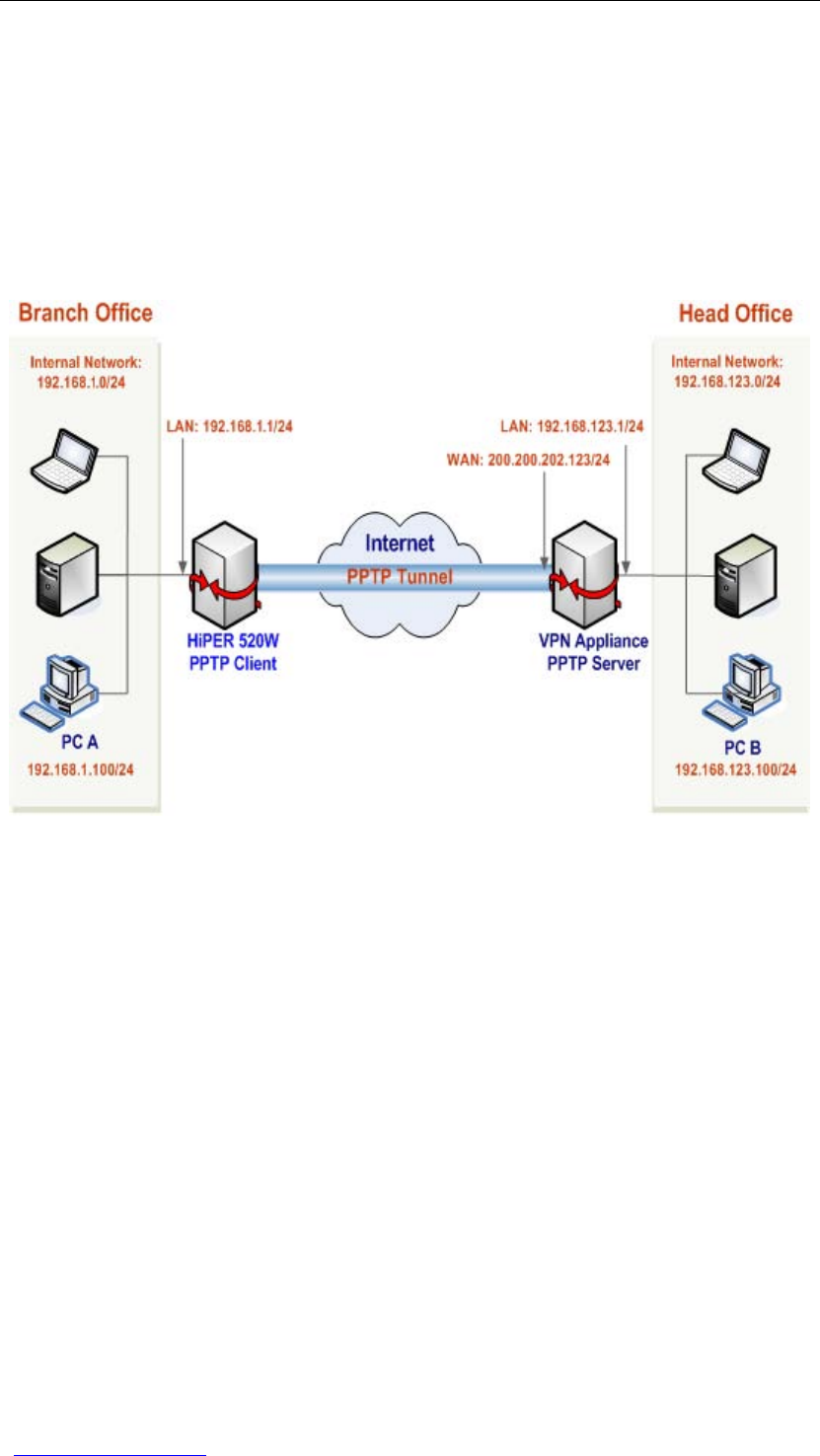
UTT Technologies Chapter 10 VPN
http://www.uttglobal.com Page 167
PPTP server, you will see that the tunnel’s Status changes from Disconnected to
Connected,theUp Time timer starts, and the Out Bytes and In Bytes will go on
increasing as long as there is some network traffic being passed through the PPTP tunnel.
10.4 Configuration Example for PPTP Client
Figure 10- 8 Network Topology - The Wireless Router Acts as a PPTP client
In this example, a company’s head office is located in Washington, and its branch office is
located in New York. Now the company wants the head office and branch office to
securely communicate with each other over the Internet.
As shown in Figure 10- 8, we will use PPTP to establish a VPN tunnel, deploy a AC750W
Wireless Router acting as a PPTP client at the branch office, and another VPN appliance
(a UTT VPN gateway is recommended) acting as a PPTP server at the head office. The IP
addresses are as follows:
The AC750W (PPTP Client) at the branch office:
zLAN Subnet: 192.168.1.0/255.255.255.0
zLAN Interface IP Address: 192.168.1.1/255.255.255.0
The VPN appliance (PPTP Server) at the head office:
zLAN Subnet: 192.168.123.0/255.255.255.0
zLAN Interface IP Address: 192.168.123.1/255.255.255.0

UTT Technologies Chapter 10 VPN
http://www.uttglobal.com Page 168
zWAN Interface IP Address: 200.200.202.123/255.255.255.0
To configure the AC750W as a PPTP client, follow these steps:
Step 1 Go to the VPN > PPTP Client page, and click the Add button to go to the PPTP
Client Settings page.
Step 2 Make the following settings.
Enable Select
Tunnel Name To_HQ
User Name VPN_test
Password vpntest
PPP Authentication Either
Remote Subnet IP 192.168.123.1
Remote Subnet Mask 255.255.255.0
Tunnel Server IP/Domain Name 200.200.202.123
Step 3 Click the Save button.
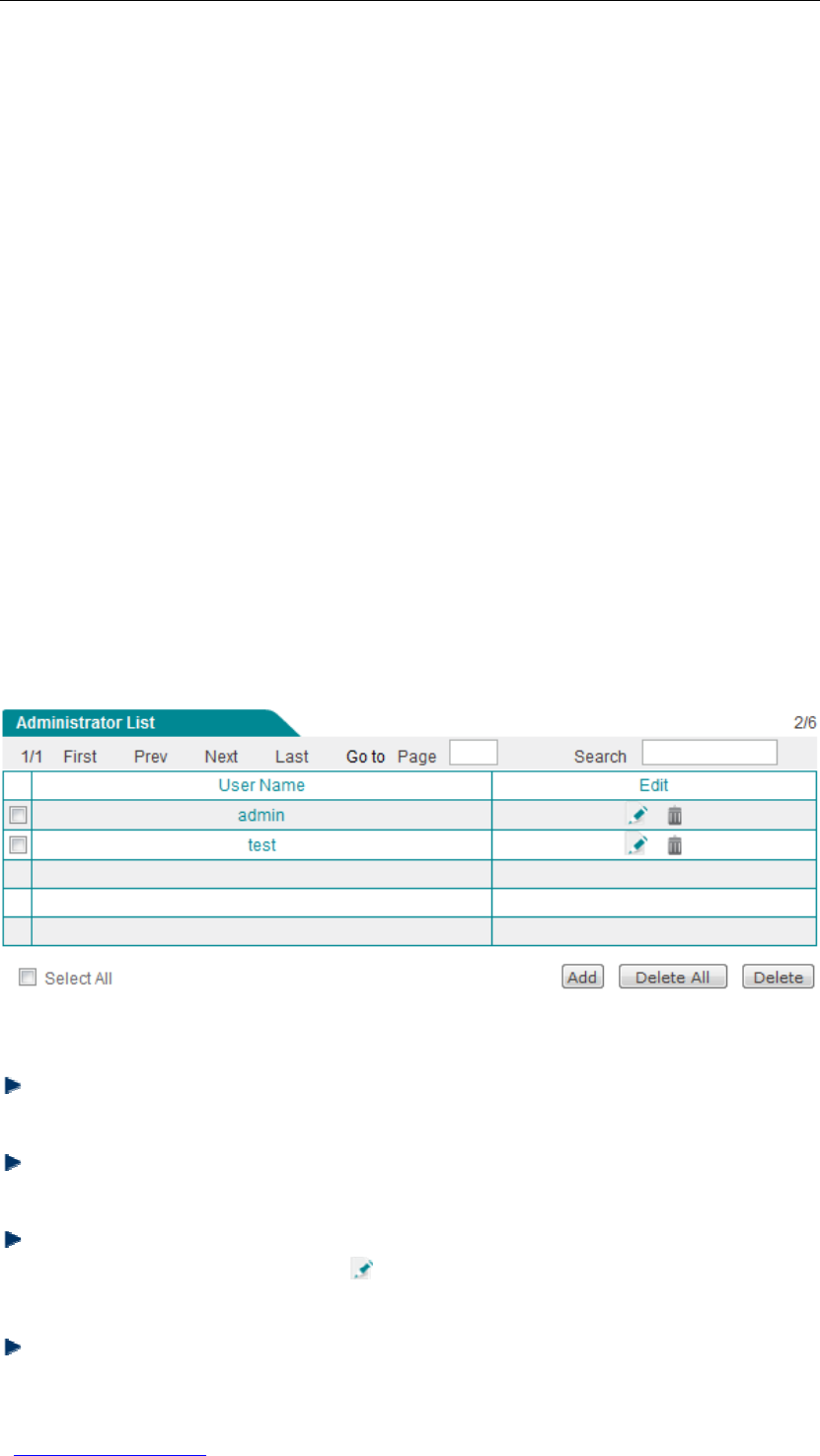
UTT Technologies Chapter 11 System Administration
http://www.uttglobal.com Page 169
Chapter 11System Administration
This chapter describes how to perform maintenance activities on the Wireless Router,
including administrator settings, system time settings, configuration backup and restore,
firmware upgrade, remote management, and scheduled task settings.
11.1 Administrator
This section describes the Administration > Administrator page, where you can add,
view, modify and delete the administrator accounts.
11.1.1 Administrator List
Figure 11- 1 Administrator List
Add an Administrator Account: To add a new administrator account, first click the
Add button to go to the setup page, next configure it, lastly click the Save button.
View Administrator Account(s): When you have configured one or more
administrator accounts, you can view them in the Administrator List.
Modify an Administrator Account: To modify a configured administrator account,
click its User Name hyperlink or icon, the related information will be displayed in
the setup page. Then modify it, and click the Save button.
Delete Administrator Account(s): There are three ways to delete administrator
account(s).
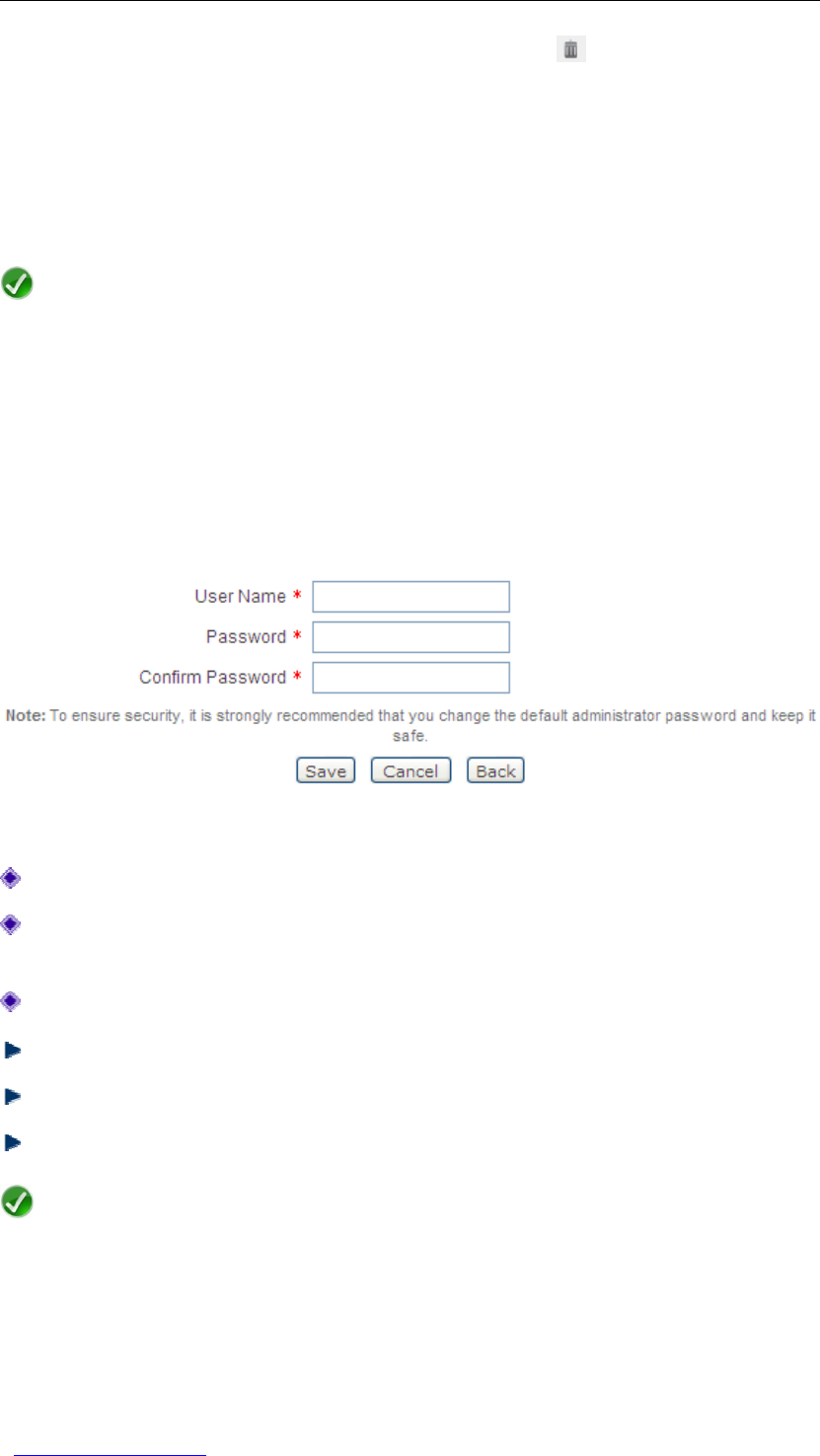
UTT Technologies Chapter 11 System Administration
http://www.uttglobal.com Page 170
1. To delete an administrator account, directly click its icon.
2. To delete more than one administrator account at a time, select the leftmost
check boxes of the administrator accounts that you want to delete, and then click
the Delete button.
3. To delete all the administrator accounts at a time, directly click the Delete All
button.
Note
You can change the default administrator password, but you cannot change its user
name or delete it.
11.1.2 Administrator Settings
Figure 11- 2 Administrator Settings
User Name: It specifies a unique login name (case sensitive) of the administrator.
Password: It specifies a login password (case sensitive) of the administrator. This
password will be required to login to the Wireless Router in the future.
Confirm Password: You should re-enter the password.
Save: Click to save your changes.
Cancel: Click to revert to the last saved settings.
Back: ClicktogobacktotheAdministrator List.
Note
To ensure security, it is strongly recommended that you change the default
administrator password, remember your new password and keep it safe. Once
changed, you should use the new password to login to the Wireless Router in the
future.
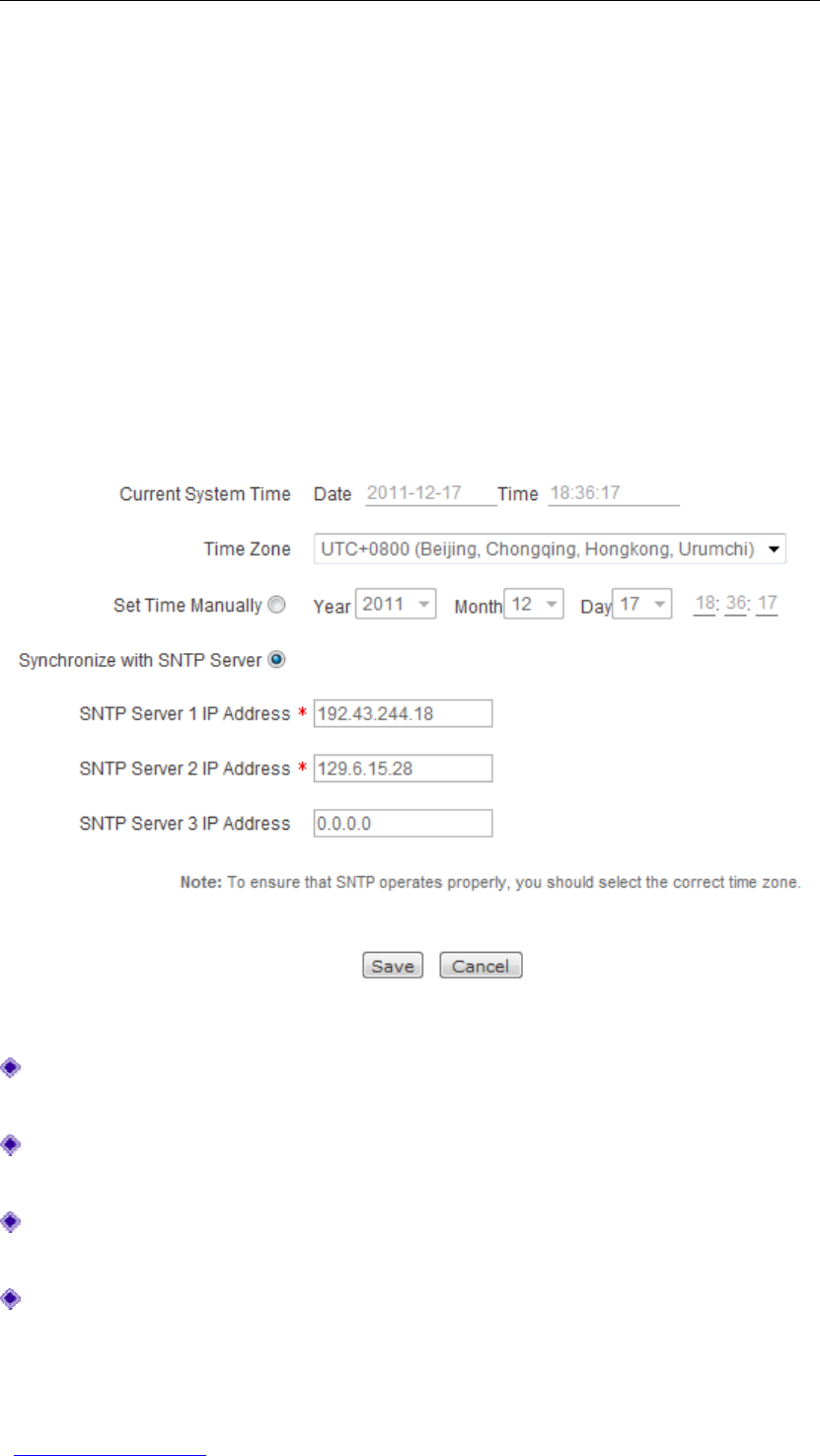
UTT Technologies Chapter 11 System Administration
http://www.uttglobal.com Page 171
11.2 System Time
This section describes the Administration > Time page, see Figure 11- 3.
To ensure that the time-related features (e.g., DDNS, Schedule, Access Control, etc.)
work well, you should synchronize the system clock.
You can manually configure the system time or enable SNTP (Synchronize with SNTP
Server) to automatically synchronize the system time from a designated SNTP server on
the Internet. It is suggested that you choose SNTP to automatically synchronize time in
most cases.
Figure 11-3 System Time Settings
Current System Time: It displays the Wireless Router’s current date (YYYY-MM-DD)
and time (HH:MM:SS).
Time Zone: It specifies the time zone for your local time. To ensure that SNTP
operates properly, you must select the correct time zone.
Set Time Manually: If you want to set the date (YYYY-MM-DD) and time (HH:MM:SS)
for the Wireless Router manually, select this radio button.
Synchronize with SNTP Server: If you want the Wireless Router to automatically
synchronize the system clock from a designated SNTP server on the Internet, select
this radio button.

UTT Technologies Chapter 11 System Administration
http://www.uttglobal.com Page 172
SNTP Server 1 IP Address ~ SNTP Server 3 IP Address: It allows you to configure
up to three SNTP servers on the Wireless Router. The Server 1 is the primary server
(the default is 192.43.244.18), and the Server 2 is the first backup server (the default
is 129.6.15.28), and the Server 3 is the second backup server (the default is 0.0.0.0).
Save: Click to save your changes.
Cancel: Click to revert to the last saved settings.
Note
For more information about SNTP, or to find an SNTP server with which you can
synchronize the system clock, please refer to http://www.ntp.org.
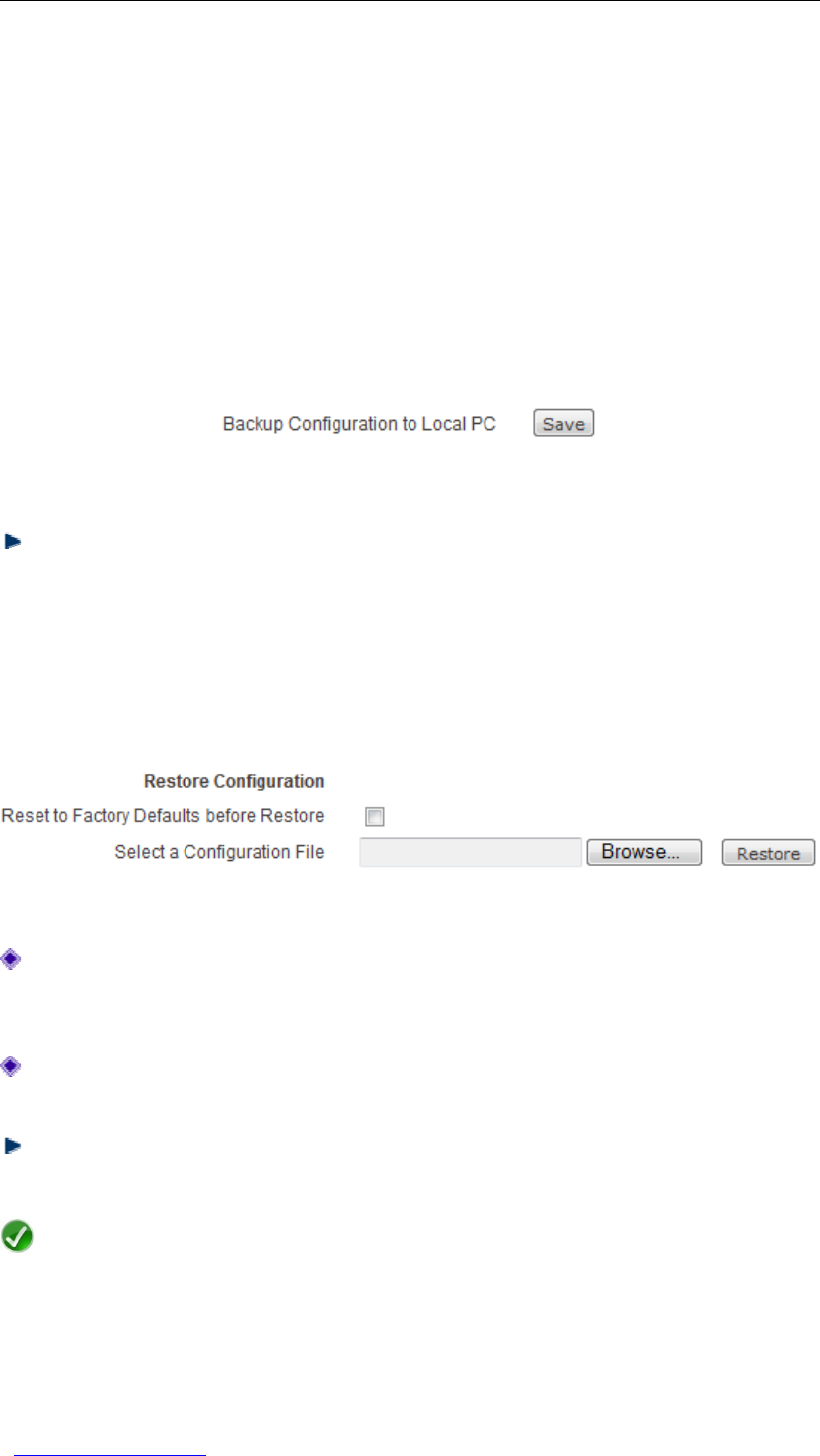
UTT Technologies Chapter 11 System Administration
http://www.uttglobal.com Page 173
11.3 Configuration
This section describes the Administration > Configuration page, where you can backup
the current configuration file to the local PC, restore your previous configuration using the
backup configuration file, and reset the Wireless Router to factory default settings.
11.3.1 Backup Configuration
Figure 11- 4 Backup Configuration
Backup: Click to export and save the Wireless Router’s current configuration to a text
file on your local computer.
11.3.2 Restore Configuration
Figure 11-5 Restore Configuration
Reset to Factory Defaults before Restore: If you select this check box, it will reset
the Wireless Router to factory default settings before importing the configuration file;
elseimportthefiledirectly.
Select a Configuration File: Click the Browse button to choose an appropriate
configuration file or enter the file path and name in the text box.
Restore: Click to import the selected configuration file. It will overwrite the current
configuration on the Wireless Router with the new configuration.
Note
To avoid any unexpected error, do not power off the Wireless Router during importing
the configuration file.
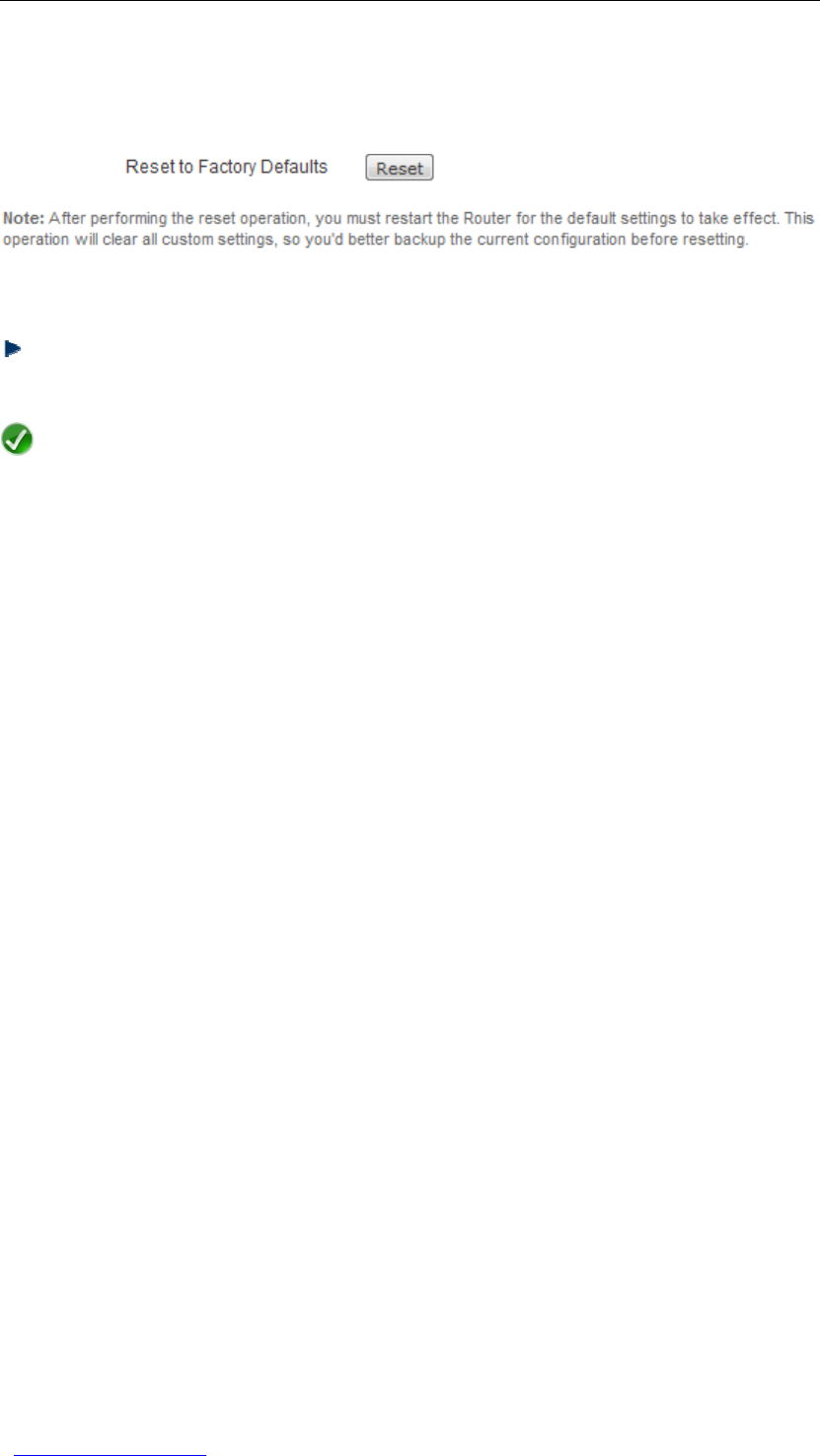
UTT Technologies Chapter 11 System Administration
http://www.uttglobal.com Page 174
11.3.3 Reset to Factory Defaults
Figure 11- 6 Reset to Factory Defaults
Reset: To reset the Wireless Router to factory default settings, click the Reset button,
and then restart the Wireless Router.
Note
1. After performing the reset operation, you must manually restart the Wireless
Router in order for the default settings to take effect.
2. The reset operation will clear all of the Wireless Router’s custom settings. It is
strongly recommended that you backup the current configuration before resetting.
3. The default administrator user name and password both are admin (case
sensitive). The default LAN IP address is 192.168.1.1 with a subnet mask of
255.255.255.0.
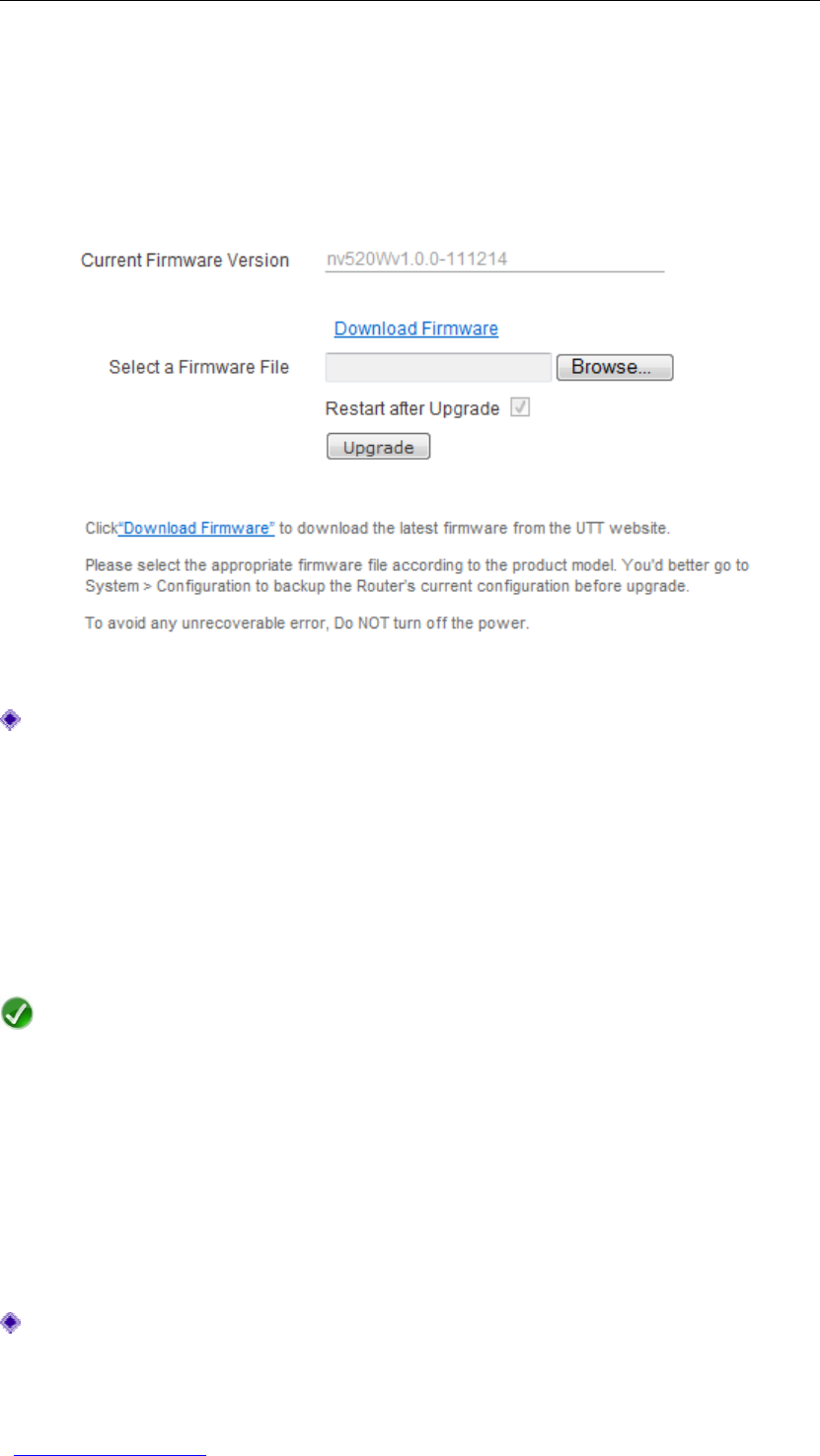
UTT Technologies Chapter 11 System Administration
http://www.uttglobal.com Page 175
11.4 Firmware Upgrade
This section describes the Administration > Firmware page, where you can view the
current firmware version information, download the latest firmware from the website of
UTT Technologies Co., Ltd., and upgrade the firmware.
Figure 11- 7 Firmware Upgrade
Current Firmware Version: It displays the version of the current firmware installed
on the Wireless Router.
To upgrade the Wireless Router’s firmware, follow these steps:
Step 1 Downloading the latest firmware
Click the Download Firmware hyperlink to download the latest firmware from the website
of UTT Technologies Co., Ltd.
Note
1. Please select the appropriate firmware file according to the product model.
2. It is recommended that you go to the Administration > Configuration to backup the
Wireless Router’s current configuration before upgrade.
Step 2 Choosing the firmware
Click the Browse button to choose the firmware file you want to upgrade or enter the file
path and name in the Select a Firmware File text box.
Restart after Upgrade: After the upgrade is complete, the Wireless Router will
automatically restart in order for the new firmware to take effect.
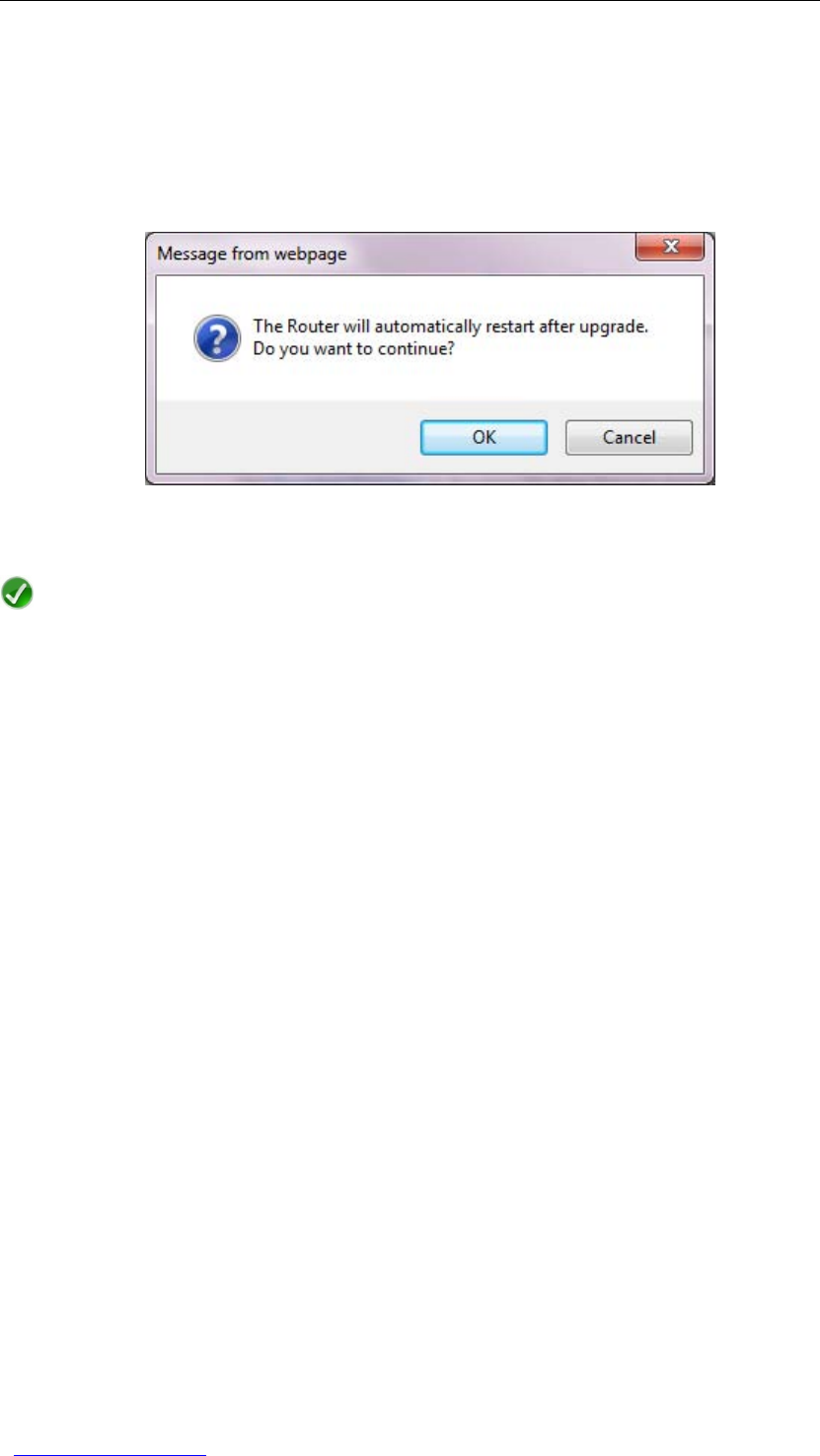
UTT Technologies Chapter 11 System Administration
http://www.uttglobal.com Page 176
Step 3 Renewing the firmware
Click the Upgrade button to renew the Wireless Router’s firmware. If you click the
Upgrade button, you will be prompted to confirm the upgrade (see Figure 11- 8). Then you
can click OK to upgrade the firmware and restart the Wireless Router, or click Cancel to
cancel the operation.
Figure 11-8 Prompt Dialog Box - Firmware Upgrade
Note
1. It is strongly recommended that you upgrade the firmware when the Wireless
Router is under light load.
2. If you upgrade firmware timely, the Wireless Router will have more functionality
and better performance. The right upgrade will not change the Wireless Router’s
current settings.
3. To avoid any unexpected error or unrecoverable hardware damage, do not
power off the Wireless Router during upgrading.
4. After the upgrade is complete, the Wireless Router will automatically restart in
order for the new firmware to take effect, without human intervention.
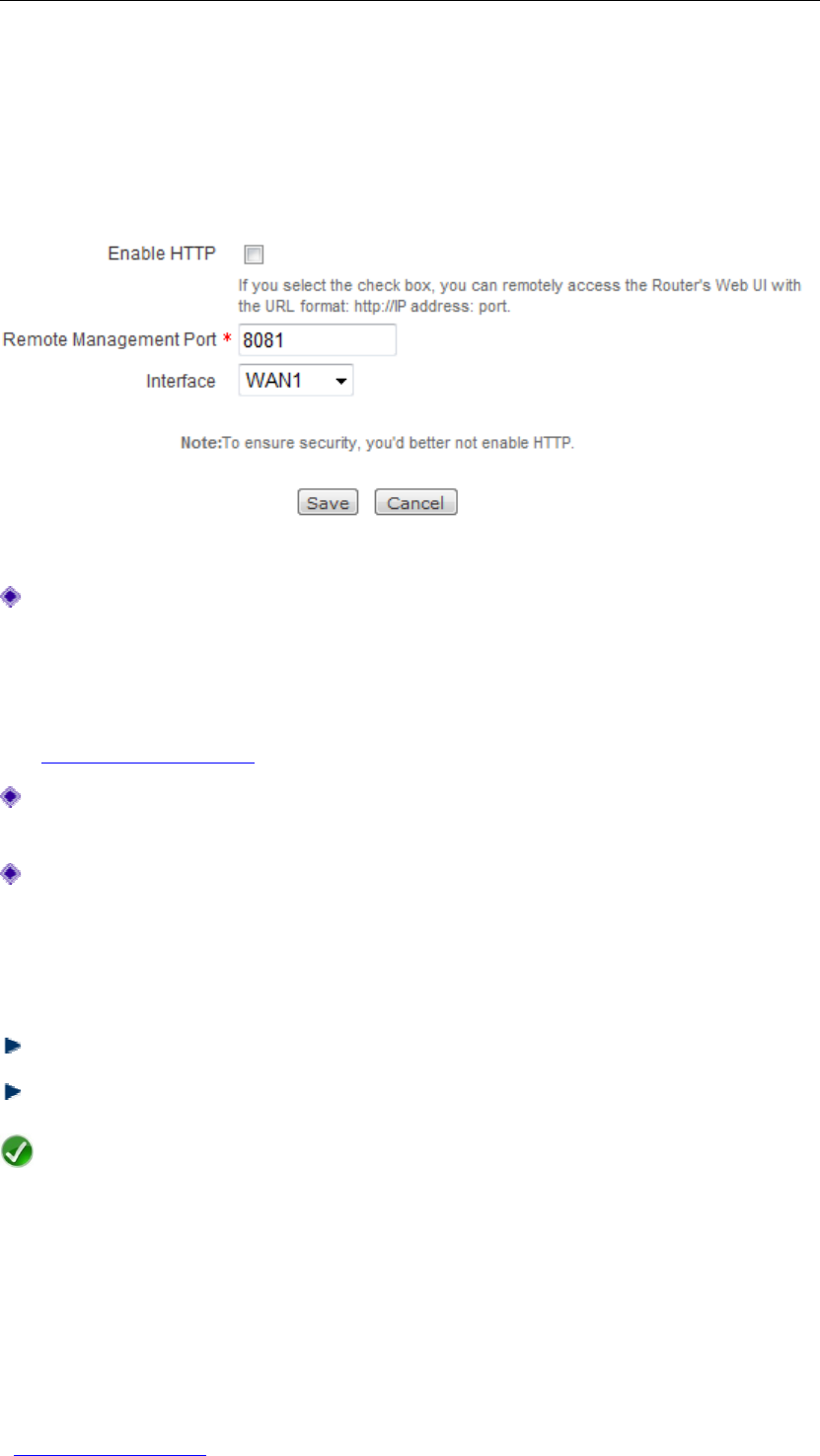
UTT Technologies Chapter 11 System Administration
http://www.uttglobal.com Page 177
11.5 Remote Access
This section describes the Administration > Remote Access page. In this page, you can
enable HTTP remote management, which allows you to access the Wireless Router’s
Web UI from anywhere over the Internet.
Figure 11- 9 Remote Access Settings
Enable HTTP: It allows you to enable or disable HTTP remote management. Select
this check box to enable HTTP remote management. To access the Wireless
Router’s Web UI over the Internet, you should enter http:// and the Wireless Router's
WAN IP address, followed by a colon and the port number. For example, if the WAN
IP address is 218.21.31.3 and port number is 8081, please enter
http://218.21.31.3:8081 in your browser’s address bar.
Remote Management Port: It specifies the port number that will be open to outside
access. The default value is 8081.
Interface: It specifies the interface on which the HTTP remote management is
enabled. Here you can select only one interface. To enable HTTP remote
management on multiple interfaces at the same time, you need to go to the
Advanced > NAT&DMZ > Port Forwarding page to create port forwarding entry(s)
for the other interface(s).
Save: Click to save your changes.
Cancel: Click to revert to the last saved settings.
Note
1. To ensure security, it is strongly recommended that you don’t enable HTTP remote
management unless necessary.
2. After you enable the HTTP remote management, the system will automatically create
a port forwarding entry whose name is admin.YoucangototheAdvanced >
NAT&DMZ > Port Forwarding page to view it in the Port Forwarding List.
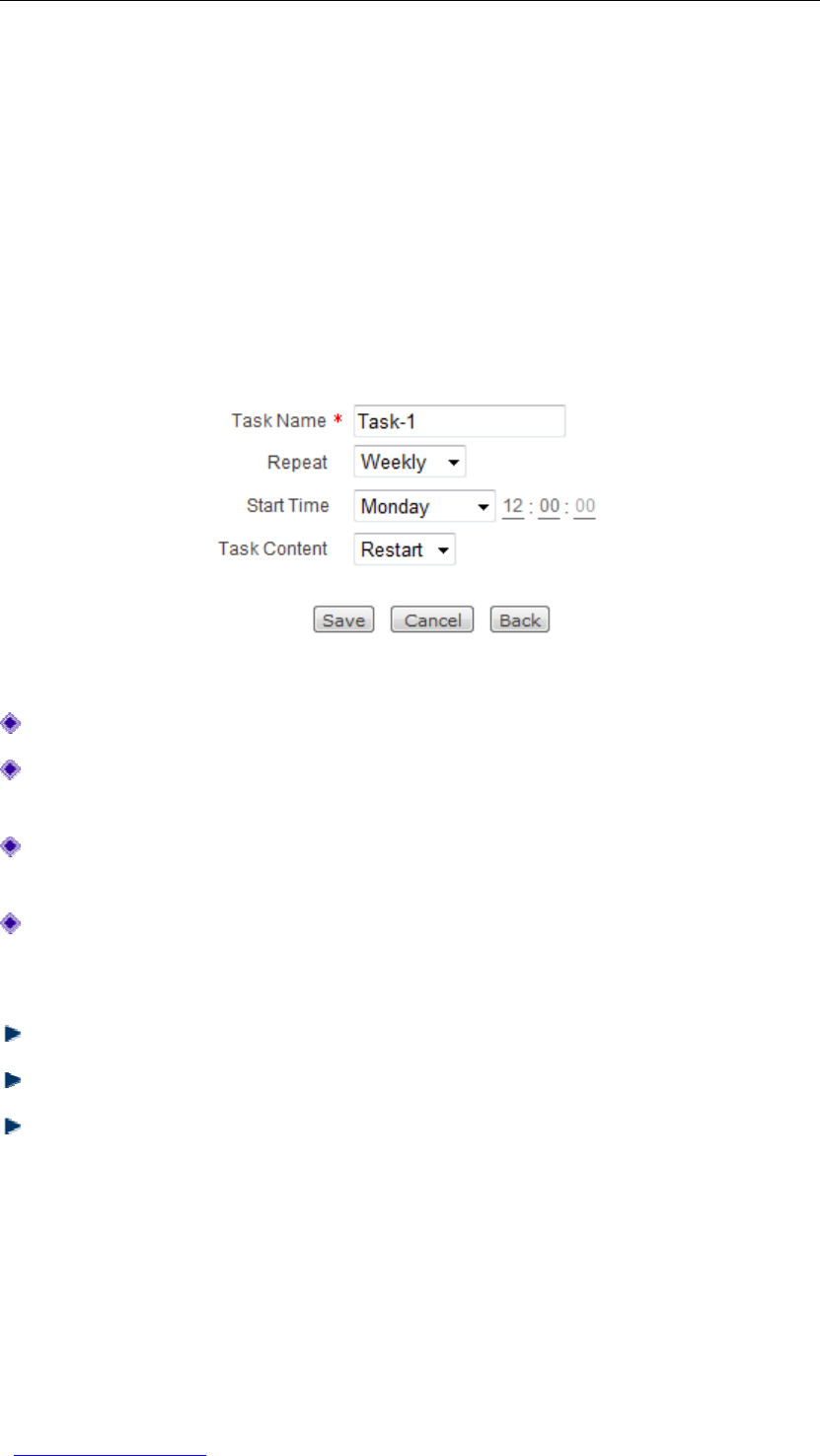
UTT Technologies Chapter 11 System Administration
http://www.uttglobal.com Page 178
11.6 Scheduled Task
This section describes the Administration > Scheduled Task page, where you can
create and view the scheduled tasks. With scheduled tasks, the Wireless Router can
periodically start each task at the time you specify.
11.6.1 Scheduled Task Settings
Figure 11- 10 Scheduled Task Settings
Task Name: It specifies a unique name of the task.
Repeat: It specifies how often the Wireless Router will perform the task. The
available options are Weekly,Daily,Hourly,Minutely.
Start Time: It specifies the time at which the Wireless Router will start the task. Its
settings depend on the value of Repeat.
Task Content: It specifies the content of the task. Now the Wireless Router only
provide one option: Restart, which means that the Wireless Router will restart itself
periodically.
Save: Click to save your changes.
Cancel: Click to revert to the last saved settings.
Back: ClicktogobacktotheScheduled Task List.
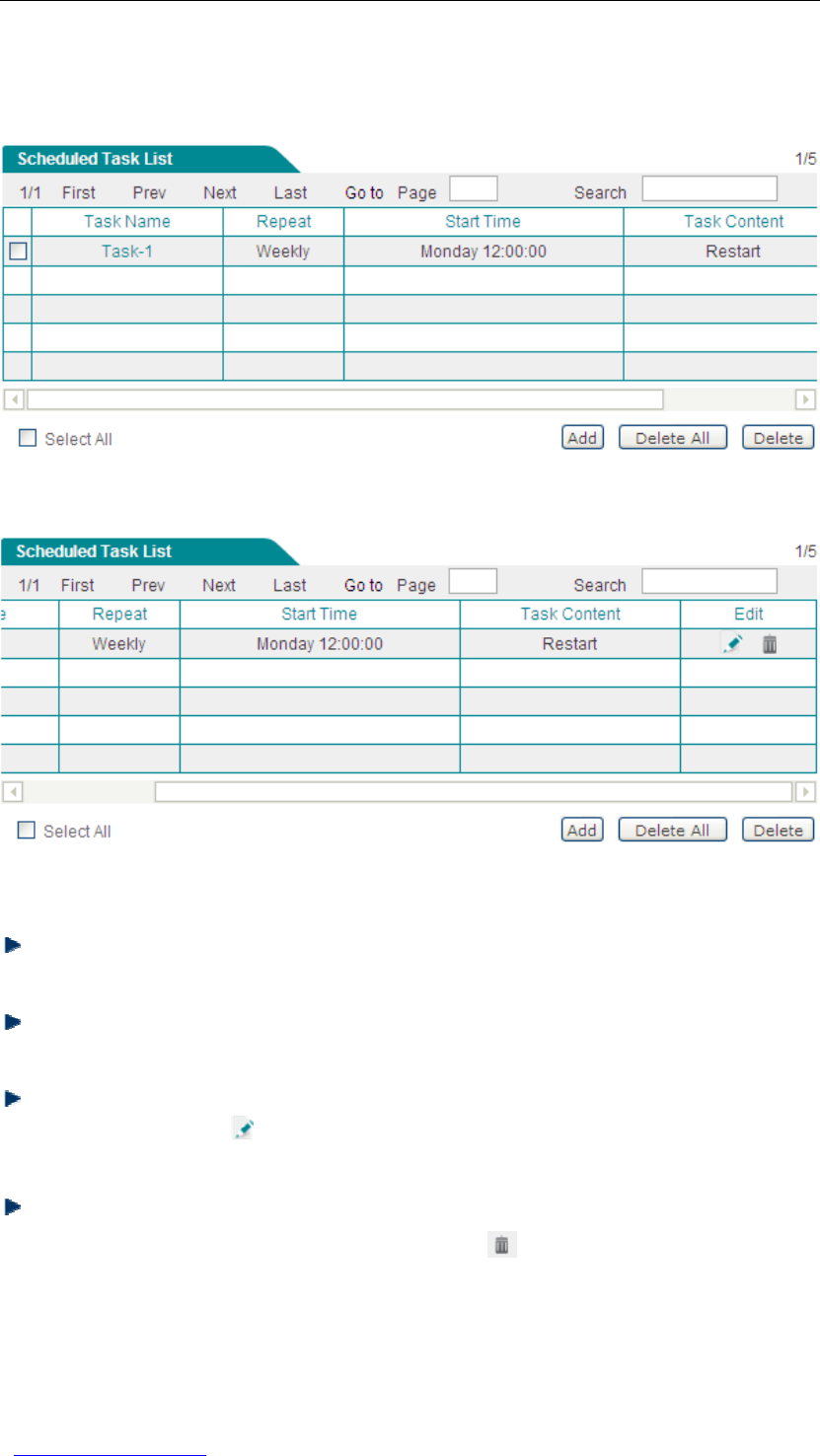
UTT Technologies Chapter 11 System Administration
http://www.uttglobal.com Page 179
11.6.2 Scheduled Task List
Figure 11- 11 Scheduled Task List
Figure 11-12 Scheduled Task List (Continue)
Add a Scheduled Task: To add a new scheduled task, first click the Add button to go
to the Scheduled Task Settings page, next configure it, lastly click the Save button.
View Scheduled Task(s): When you have configured one or more scheduled tasks,
you can view them in the Scheduled Task List.
Modify a Scheduled Task: To modify a configured scheduled task, click its User
Name hyperlink or icon, the related information will be displayed in the setup
page. Then modify it, and click the Save button.
Delete Scheduled Task(s): There are three ways to delete scheduled task(s).
1. To delete a scheduled task, directly click its icon.
2. To delete more than one scheduled task at a time, select the leftmost check
boxes of the tasks that you want to delete, and then click the Delete button.
3. To delete all the scheduled tasks at a time, directly click the Delete All button.
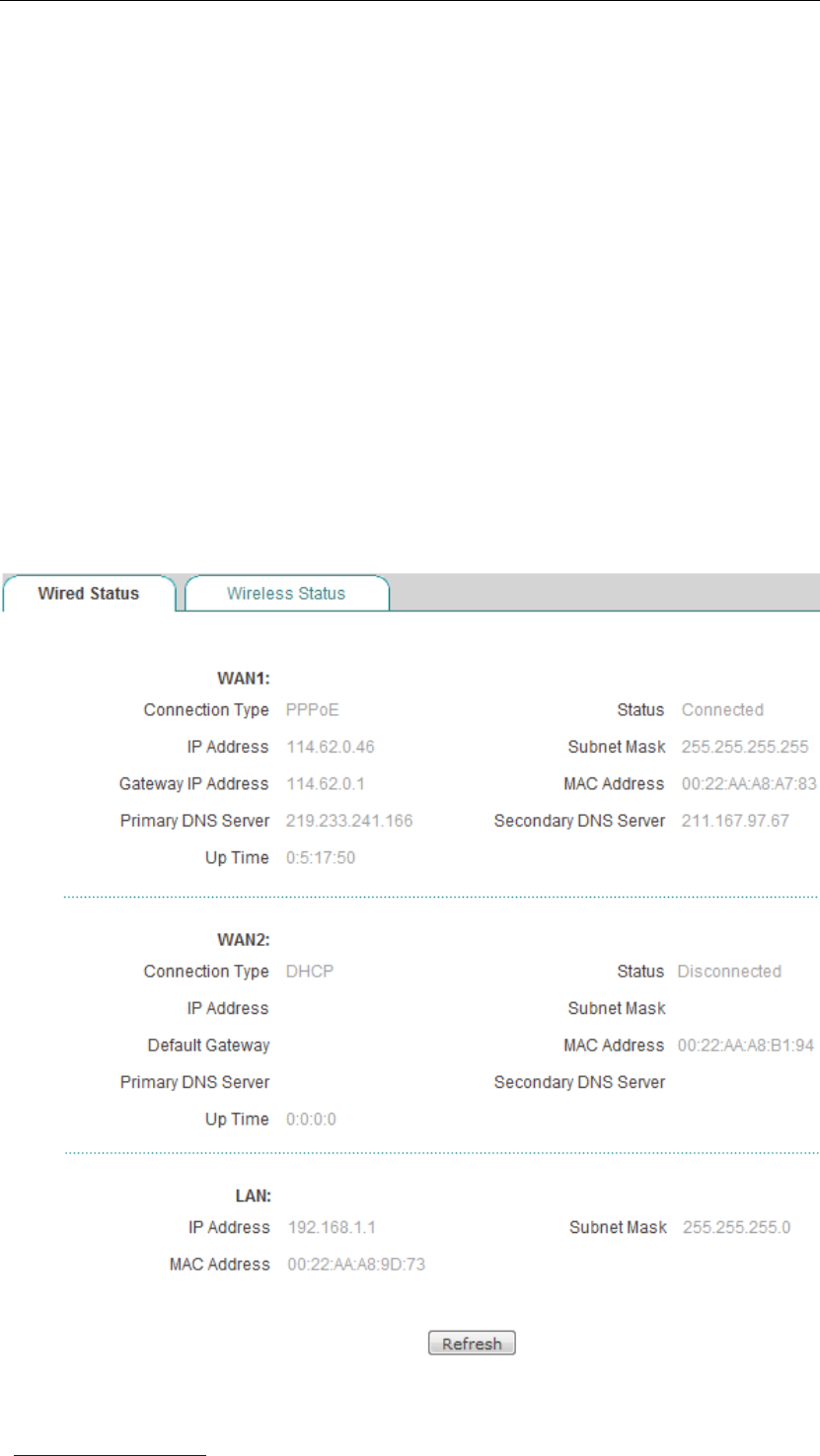
UTT Technologies Chapter 12 Status
http://www.uttglobal.com Page 180
Chapter 12 Status
This chapter describes how to view the wired status and wireless status, the traffic
statistics for each interface, and system information including the current system time,
system up time, system resources usage information, firmware version, and system log.
12.1 System Status
This section describes the Status > System Status page, which include Wired Status
and Wireless Status.
Figure 12- 1 System Status - Wired Status
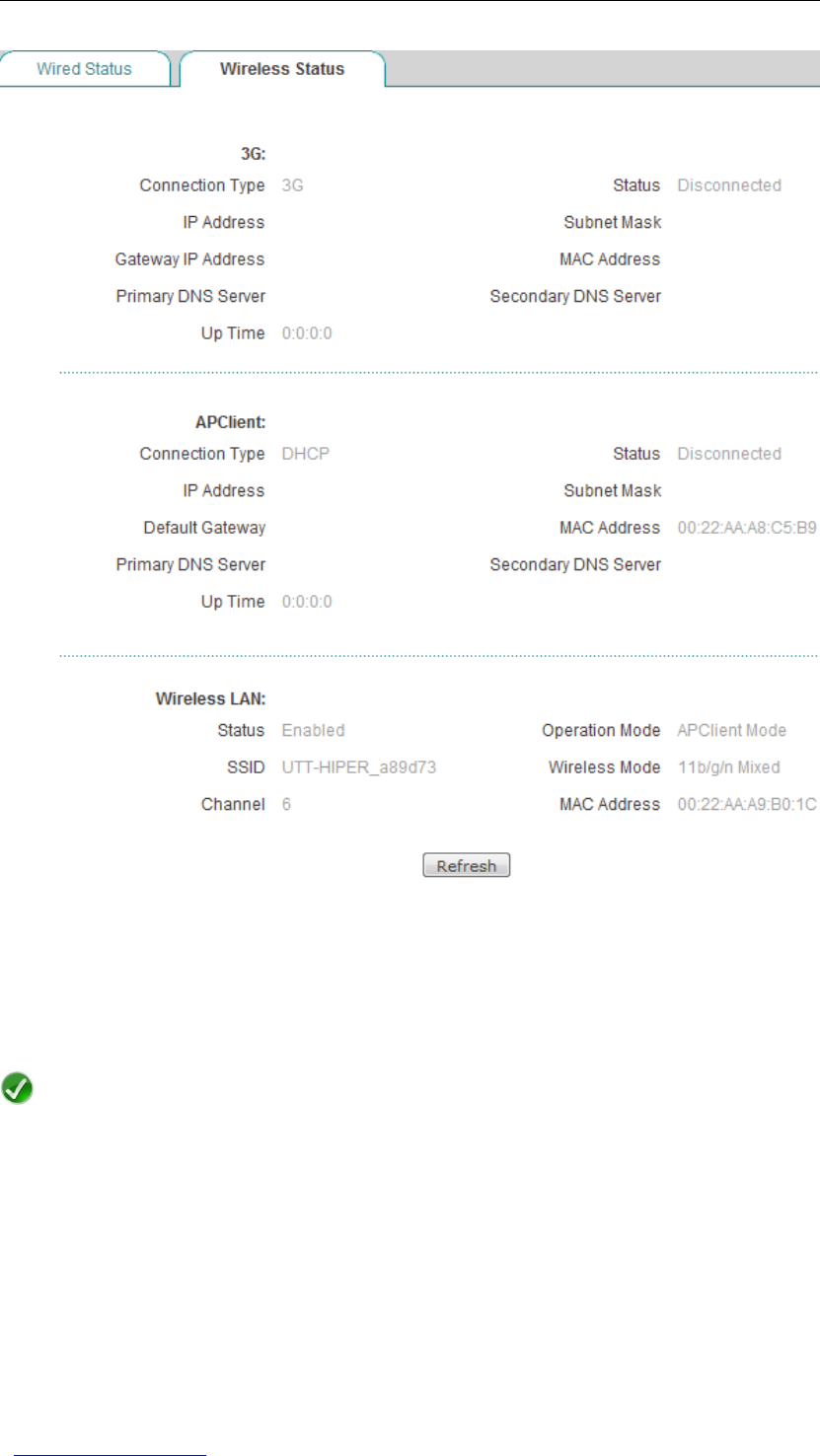
UTT Technologies Chapter 12 Status
http://www.uttglobal.com Page 181
Figure 12- 2 System Status - Wireless Status
●Wired Status: Refer to Section 4.2.1 Wired Status for detailed information.
●Wireless Status: Refer to Section 4.2.2 Wireless Status for detailed information.
Note
The Wired Status page and Wireless Status page only display the status
information of the interfaces that have been configured.
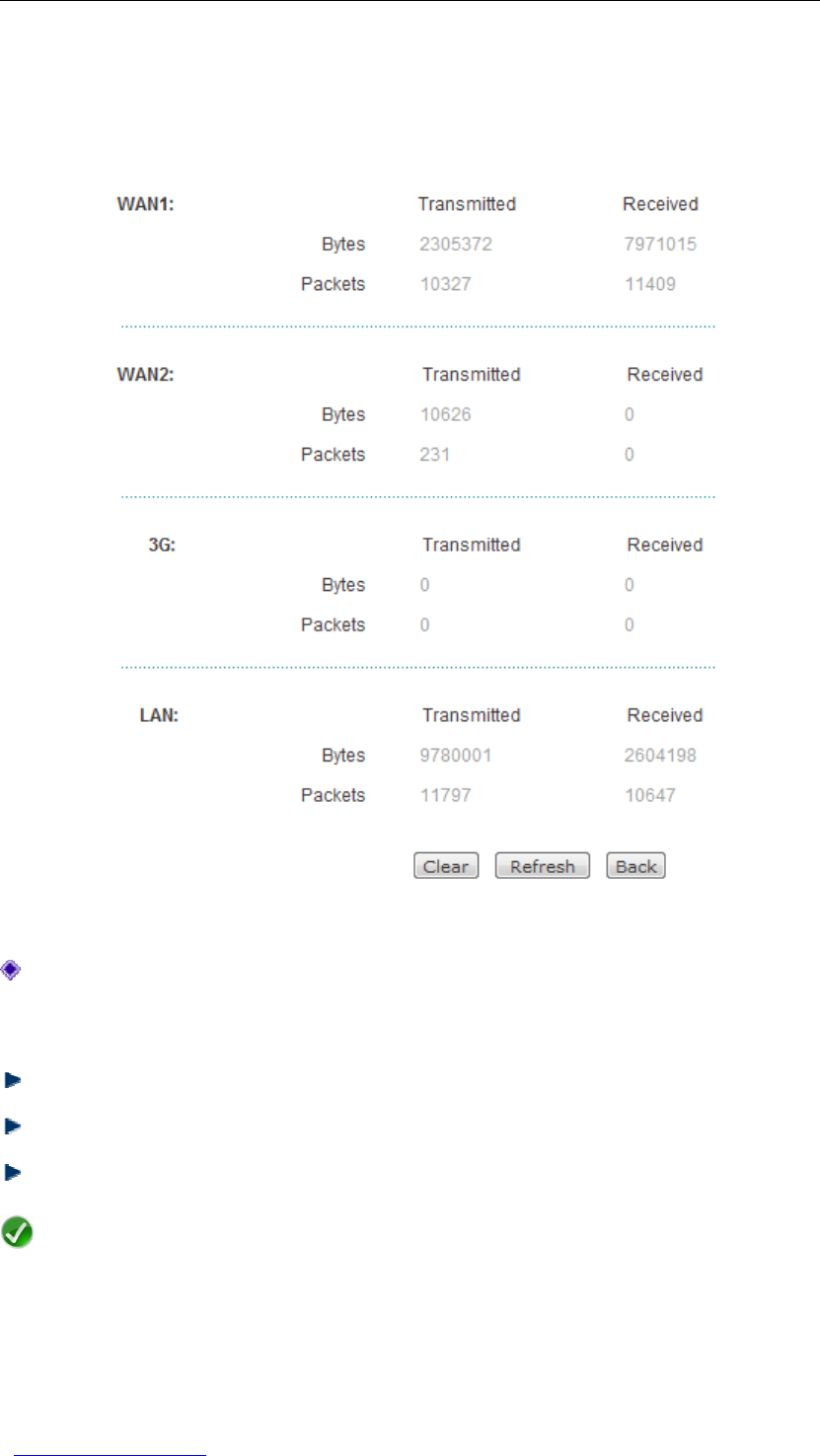
UTT Technologies Chapter 12 Status
http://www.uttglobal.com Page 182
12.2 Traffic Statistics
This section describes the ingress and egress traffic statistics for each interface.
Figure 12-3 Traffic Statistics
WAN1,WAN2,3G,APClient and LAN: You can view the traffic statistics for each
interface, including the number of bytes received and transmitted, and the number of
packets received and transmitted.
Clear: Click to clear all traffic statistics.
Refresh: Click to view the latest traffic statistics.
Back: ClicktogobacktotheStart > Interface Traffic page.
Note
This page only displays the traffic statistics for the interfaces that have been
configured.
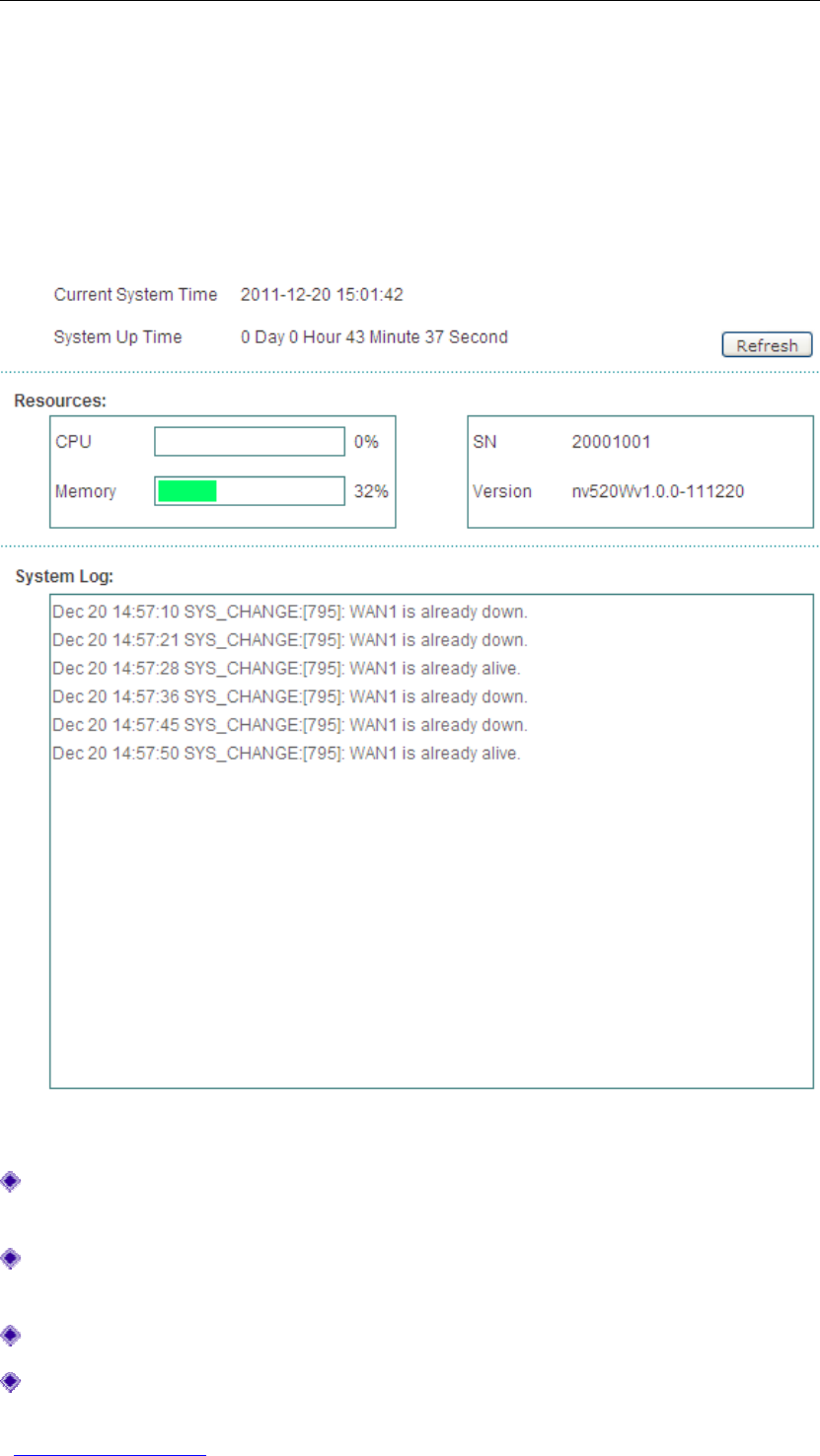
UTT Technologies Chapter 12 Status
http://www.uttglobal.com Page 183
12.3 System Information
This section describes the Status > System Info page, which includes the current system
time, system up time, system resources usage information, SN, firmware version, and
system log. System information can help you identify and diagnose the source of current
system problems, or help you predict potential system problems.
Figure 12- 4 System Information
Current System Time: It displays the Wireless Router’s current date (YYYY-MM-DD)
and time (HH:MM:SS).
System Up Time: It displays the elapsed time (in days, hours, minutes and seconds)
since the Wireless Router was last started.
CPU: It displays the current CPU usage.
Memory: It displays the current memory usage.

UTT Technologies Chapter 12 Status
http://www.uttglobal.com Page 184
SN: It displays the internal serial number of the Wireless Router, which may be
different from the SN found on the label at the bottom of the Wireless Router.
Version: It displays the version of the current firmware installed on the Wireless
Router.
System Log: It records the events that occur in the system, such as, system startup,
wireless enabled, and so on.
Refresh: Click to view the latest system information.
Note
The CPU and Memory are displayed as a status bar and percentage value. The color
of the status bar indicates the usage percentage for each resource.
●When the percentage is below 1%, the bar is blank.
●When the percentage is between 1% and 50% (below 50%), the color is green.
●When the percentage is between 50% and 70% (below 70%), the color is
orange.
●When the percentage is equal to or above 70%, the color is red.
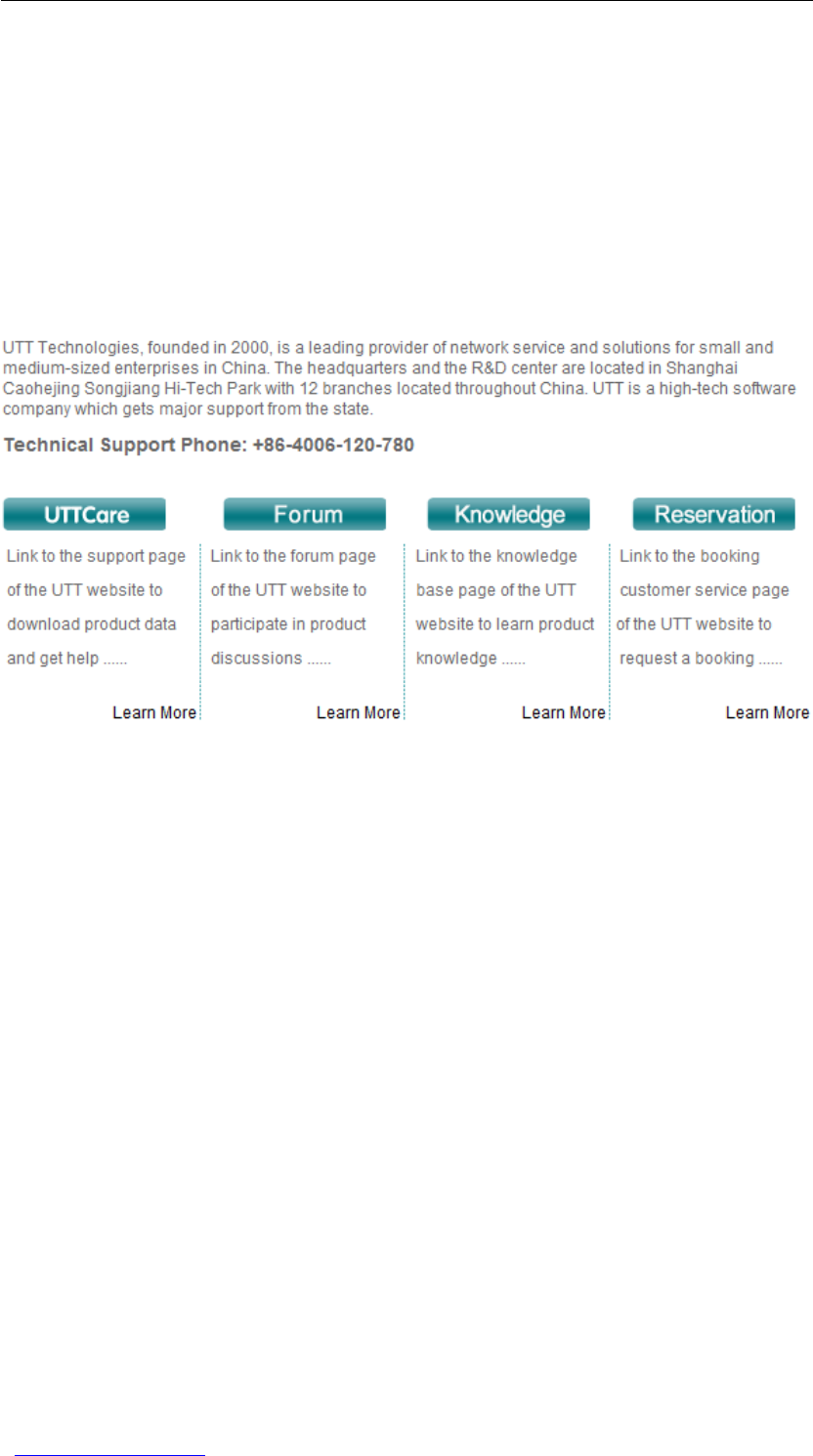
UTT Technologies Chapter 13 Support
http://www.uttglobal.com Page 185
Chapter 13 Support
The Support page provides links to the UTTCare, Forum, Knowledge and Reservation
page of the UTT website, which can help you quickly learn the UTT Technologies service
system and enjoy the most intimate and professional services.
Figure 13- 1 Support
As shown in Figure 13- 1, it allows you to click each Learn More hyperlink to directly open
the corresponding page of the UTT website.
●UTTCare: Link to the support page of the UTT website to download product data
and get help.
●Forum: Link to the forum page of the UTT website to participate in product
discussions.
●Knowledge: Link to the knowledge base page of the UTT website to learn more
about our products and how to use them.
●Reservation: Link to the booking customer service page of the UTT website to
request a booking.
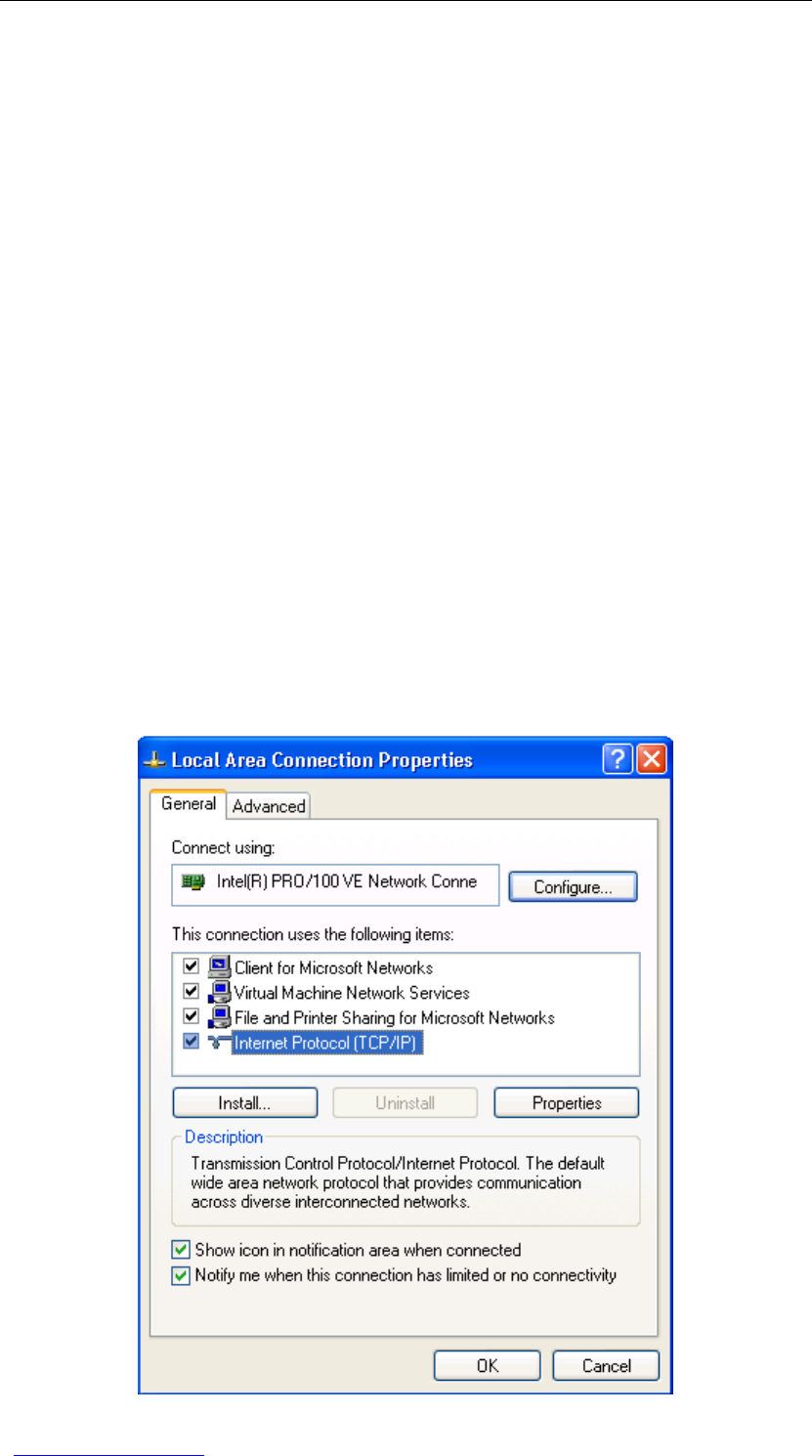
UTT Technologies Appendix A How to configure your PC
http://www.uttglobal.com Page 186
Appendix A How to Configure Your PC
This appendix describes how to configure TCP/IP settings on a Windows XP-based
computer.
There are two ways to configure TCP/IP settings: manually configuring TCP/IP settings,
and automatically configuring TCP/IP settings with DHCP. The following describes the two
ways respectively.
●Method One: Manually Configuring TCP/IP
To configure the TCP/IP protocol manually, follow these steps:
1. On the Windows taskbar, click Start > Settings > Control Panel.
2. Double-click the Network Connections icon, right-click the Local Area Connection
icon and select Properties.OntheGeneral tab (see Figure A-0-1), in the This
connection uses the following items box, click the Internet Protocol (TCP/IP)
item, and then click the Properties button.
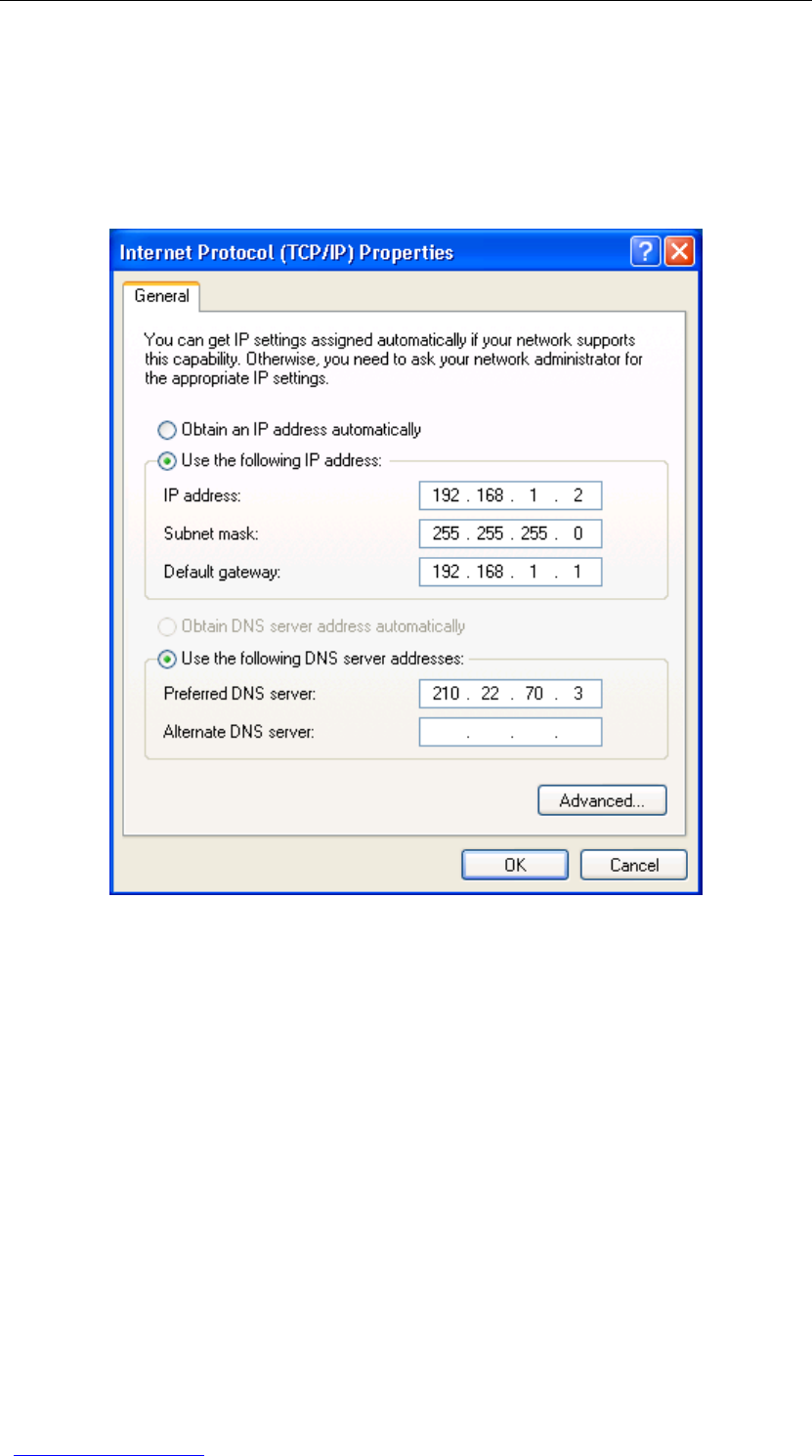
UTT Technologies Appendix A How to configure your PC
http://www.uttglobal.com Page 187
Figure A- 0- 1 Local Area Connection Properties
3. In the Internet Protocol (TCP/IP) Properties dialog box (see Figure A-0-2), select
the Use the following IP address option,enter 192.168.1.x (x is between 2 and 254,
including 2 and 253) in the IP address text box, 255.255.255.0 in the Subnet mask
text box, and 192.168.1.1 in the Default gateway text box.
Figure A-0- 2 Internet Protocol (TCP/IP) Properties
4. Select the Use the following DNS server address option, enter the primary DNS
server IP address in the Preferred DNS server text box, and enter the secondary
DNS server IP address in the Alternate DNS server text box (optional). A DNS query
is sent to the primary DNS server at first. If the primary DNS server is unable to
service the query, the query will be sent to the secondary DNS server.
5. Click the OK button. Now you have finished configuring the TCP/IP settings.
●Method Two: Automatically Configuring TCP/IP with DHCP
1. To ensure that the PC can obtain an IP address and other TCP/IP parameters
automatically from the Wireless Router, you should go to the Network > DHCP
Server page to enable DHCP server on the Wireless Router.
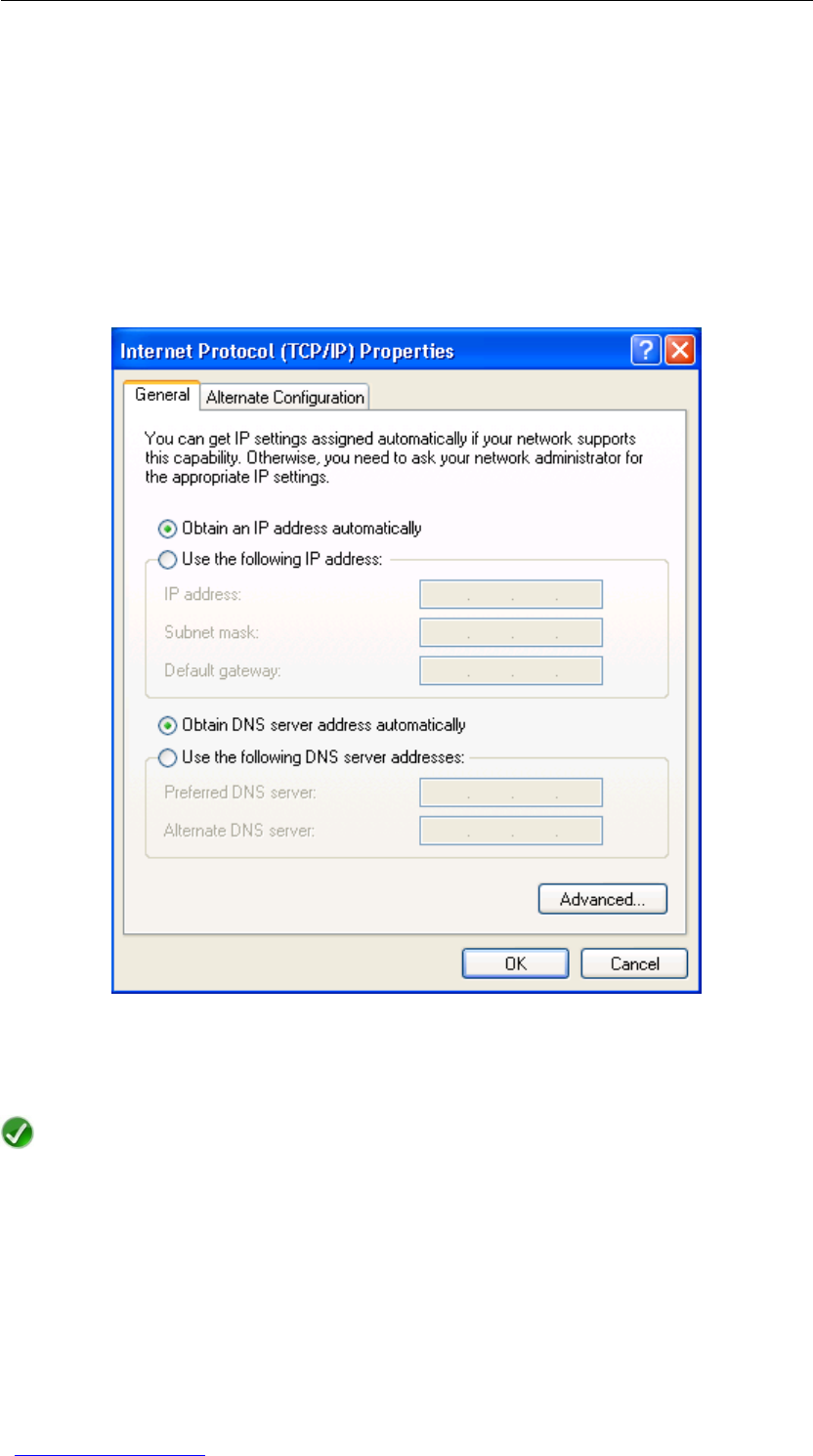
UTT Technologies Appendix A How to configure your PC
http://www.uttglobal.com Page 188
2. On the Windows taskbar, click Start > Settings > Control Panel.
3. Double-click the Network Connections icon, right-click the Local Area Connection
icon and select Properties.OntheGeneral tab (see Figure A-0-1), in the This
connection uses the following items box, click the Internet Protocol (TCP/IP)
item, and then click the Properties button.
4. In the Internet Protocol (TCP/IP) Properties dialog box, on the General tab (see
Figure A-0-3), select the Obtain an IP address automatically option and Obtain
DNS server address automatically option.
Figure A-0- 3 Internet Protocol (TCP/IP) Properties
5. Click the OK button. Now you have finished configuring the TCP/IP settings.
Note
In Windows XP, the TCP/IP stack is a core component of the operating system.
Therefore, you cannot remove TCP/IP in Windows XP. However, if you have network
connectivity problems and think its TCP/IP related, you can reinstall TCP/IP on your
Windows XP-based computer. To install TCP/IP on top of itself, follow these steps:
a. On the Windows taskbar, click Start > Settings > Control Panel.
a. Double-click Network Connections, right-click Local Area Connection and
select Properties.

UTT Technologies Appendix A How to configure your PC
http://www.uttglobal.com Page 189
b. Click Install.
c. Click Protocol, and then click Add.
d. Click Have Disk.
e. In the Copy manufacturer's files from box, type
System_Drive_Letter:\windows\inf,andthenclickOK.
f. In the list of available protocols, click Internet Protocol (TCP/IP),andthenclick
OK.
g. Restart your computer.
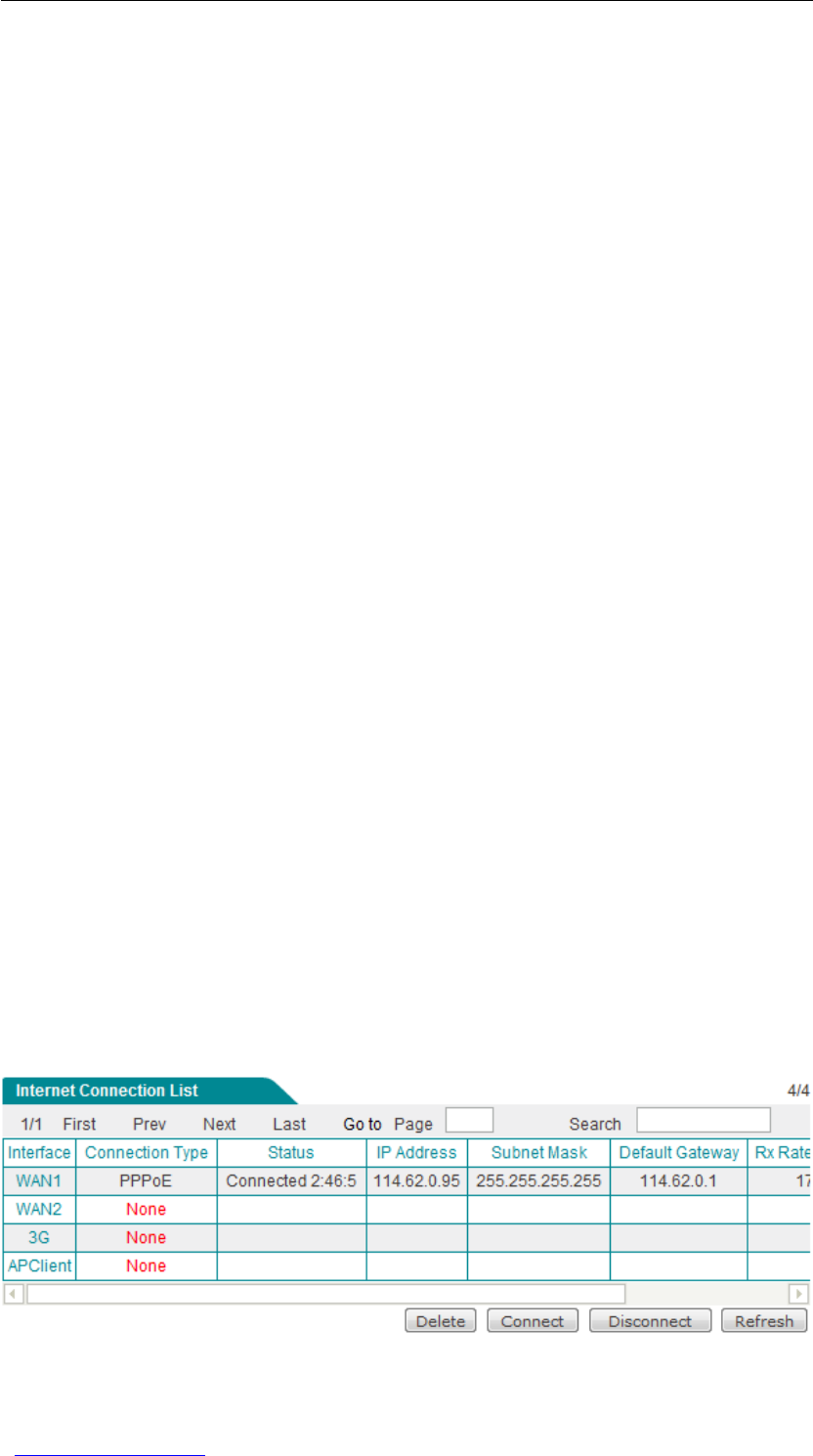
UTT Technologies Appendix B FAQ
http://www.uttglobal.com Page 190
Appendix B FAQ
1. How to connect the Wireless Router to the Internet
using PPPoE?
Step 1 Set your ADSL Modem to bridge mode (RFC 1483 bridged mode).
Step 2 Please make sure that your PPPoE Internet connection use standard dial-type.
You may use Windows XP built-in PPPoE dial-in client to test.
Step 3 Connect a network cable from the ADSL modem to a WAN port of the Wireless
Router, and connect your telephone line to the ADSL modem’s line port.
Step 4 Configure the PPPoE Internet connection related parameters in the Start >
Setup Wizard or the Network > WAN page.
Step 5 If you pay monthly for the Internet connection, you can choose Always On as
the Dial Type; else, you can choose On Demand or Manual as the Dial Type,
and specify the Idle Timeout to avoid wasting online time due to that you forget
to hang up the connection in time.
Step 6 If you choose Manual as the Dial Type, you need to dial up manually in the
Internet Connection List on the Network > WAN page. Refer to Section
5.1.1.3 for more information.
Step 7 After the PPPoE connection is established successfully, you can view its
configuration and status information in the Internet Connection List on the
Network > WAN page, such as Status (Connected means that the connection
is established successfully), the connection’s IP address and Gateway
assigned by your ISP, Tx Rate,Rx Rate, and so on, see Figure B-0- 1.
Figure B-0- 1 Viewing PPPoE Connection Status in the Internet Connection List
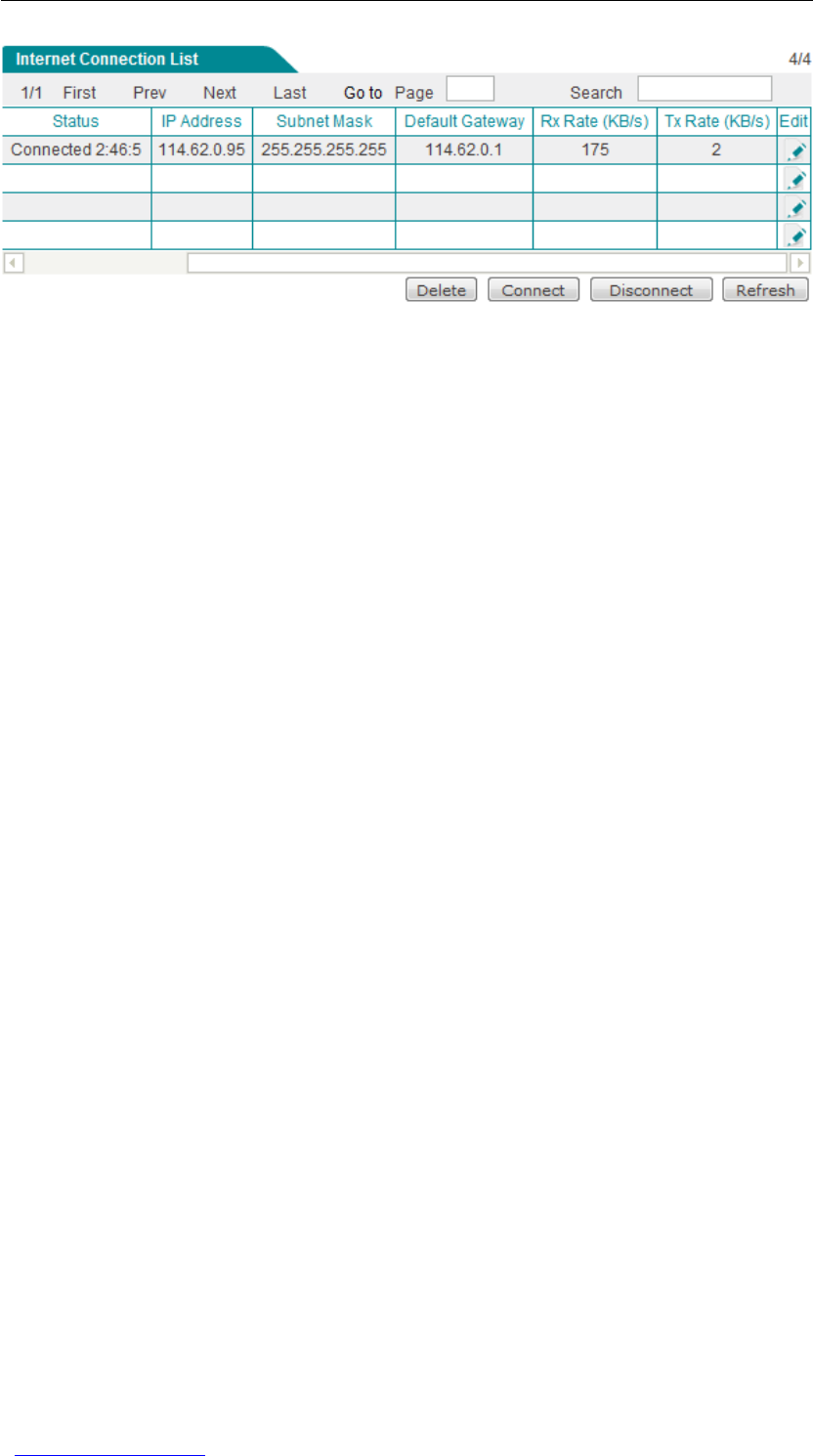
UTT Technologies Appendix B FAQ
http://www.uttglobal.com Page 191
Figure B-0- 2 Viewing PPPoE Connection Status in the Internet Connection List (Continue)
Step 8 Configure the local computers according to the steps described in Appendix A
How to Configure Your PC.
2. How to connect the Wireless Router to the Internet
using Static IP?
Step 1 Please make sure the Internet connection is normal. You may use your PC to
test.
Step 2 Connect a network cable from the network device provided by your ISP to a
WAN port of the Wireless Router.
Step 3 Configure the Static IP Internet connection related parameters in the Start >
Setup Wizard or the Network > WAN page.
Step 4 After the Static IP connection is established successfully, you can view its
configuration and status information in the Internet Connection List on the
Network > WAN page.
Step 5 Configure the local computers according to the steps described in Appendix A
How to Configure Your PC.
3. How to connect the Wireless Router to the Internet
using DHCP?
Step 1 Please make sure the Internet connection is normal. You may use your PC to
test.
Step 2 Connect a network cable from the network device provided by your ISP to a
WAN port of the Wireless Router.
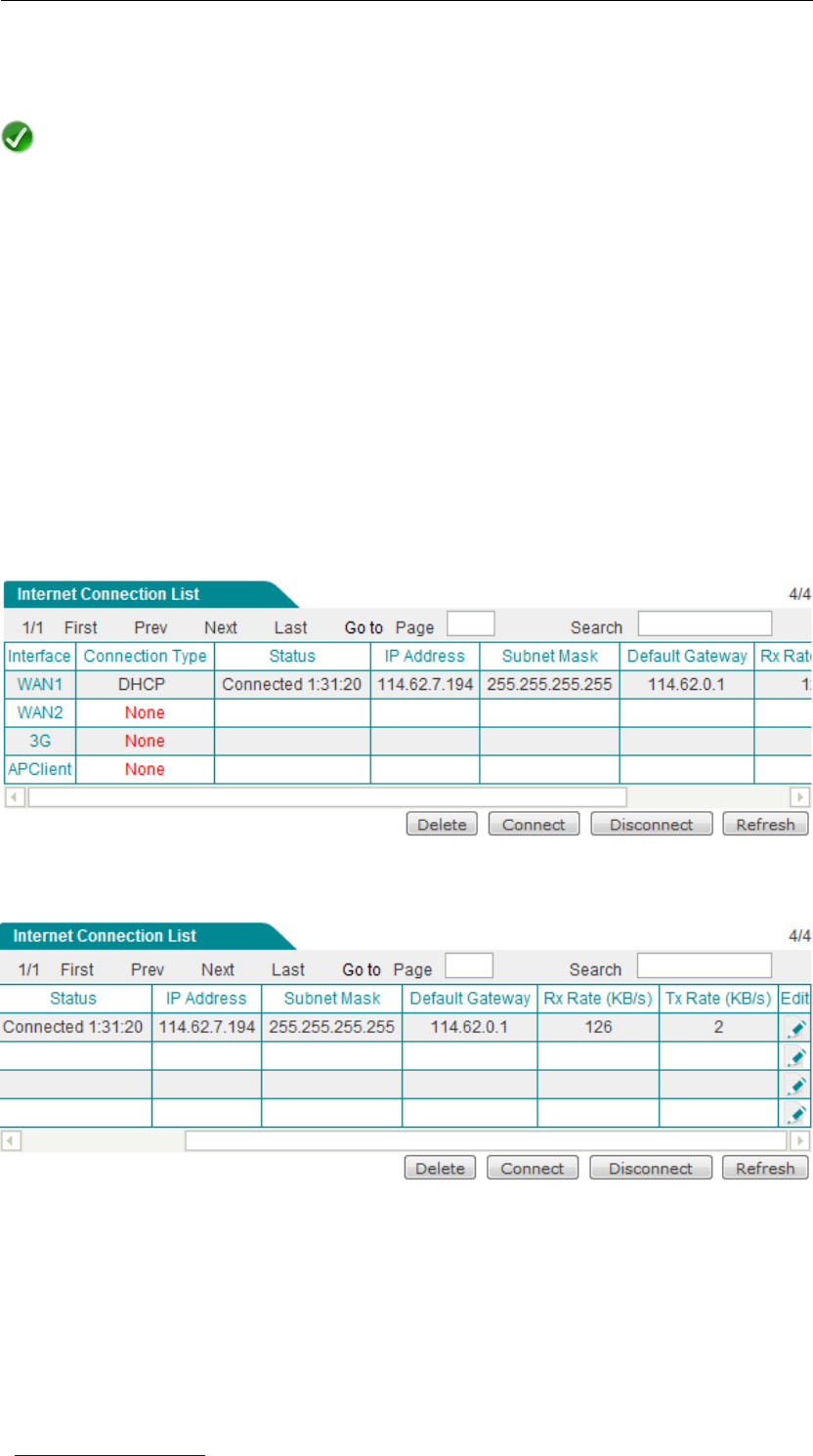
UTT Technologies Appendix B FAQ
http://www.uttglobal.com Page 192
Step 3 Configure the DHCP Internet connection related parameters in the Start >
Setup Wizard or the Network > WAN page.
Note
Some ISPs register the MAC address of your network device (usually a computer)
when your account is first opened, and they will only accept traffic from that MAC
address. In this case, you need to change the new Router’s MAC address to the
registered MAC address. The operation is as follows: Go to the Network > WAN
page, select the MAC Address Clone tab, and then change the MAC address of the
corresponding interface, lastly click the Save button.
Step 4 After the DHCP Internet connection is established successfully, you can go to
the view its configuration and status information in the Internet Connection
List on the Network > WAN page, such as Status (Connected means the
connection is established successfully), the connection’s IP address and
Gateway assigned by your ISP, Tx Rate,Rx Rate, and so on, see Figure
B- 0- 4.
Figure B-0-3 Viewing DHCP Connection Status in the Internet Connection List
Figure B- 0- 4 Viewing DHCP Connection Status in the Internet Connection List (Continue)
Step 6 Configure the local computers according to the steps described in Appendix A
How to Configure Your PC.

UTT Technologies Appendix B FAQ
http://www.uttglobal.com Page 193
4. How to reset the Wireless Router to factory default
settings?
Note
The reset operation will clear all the custom settings on the Wireless Router, so do it
with caution.
The following describes how to reset the Wireless Router to factory default settings. There
are two cases depending on whether you remember the administrator password or not.
●Case One: Remember the administrator password
When you remember the administrator password, you can reset the Wireless Router to
factory default settings via the Web UI. The operation is as follows: Go to the
Administration > Configuration page, and then click the Reset button in the Reset to
Factory Defaults configuration field, lastly manually restart the Wireless Router.
●Case Two: Forget the administrator password
If you forget the administrator password, you cannot login to the Wireless Router’s Web UI.
However, you can reset the Wireless Router to factory default settings via the RESET
button, which is located on the rear panel of the Wireless Router. The operation is as
follows: While the Wireless Router is powered on, use a pin or paper clip to press and hold
the RESET button for more than 5 seconds, and then release the button. After that, the
Wireless Router will restart with factory default settings.

UTT Technologies Appendix C Common IP Protocols
http://www.uttglobal.com Page 194
Appendix C Common IP Protocols
Protocol Name Protocol Number Full Name
IP 0 Internet Protocol
ICMP 1 Internet Protocol Message Protocol
IGMP 2 Internet Group Management
GGP 3 Gateway-Gateway Protocol
IPINIP 4 IP in IP Tunnel Driver
TCP 6 Transmission Control Protocol
EGP 8 Exterior Gateway Protocol
IGP 9 Interior Gateway Protocol
PUP 12 PARC Universal Packet Protocol
UDP 17 User Datagram Protocol
HMP 20 Host Monitoring Protocol
XNS-IDP 22 Xerox NS IDP
RDP 27 Reliable Datagram Protocol
GRE 47 General Routing Encapsulation
ESP 50 Encap Security Payload
AH 51 Authentication Header
RVD 66 MIT Remote Virtual Disk
EIGRP 88 Enhanced Interior Gateway Routing Protocol
OSPF 89 Open Shortest Path First

UTT Technologies Appendix D Common Service Ports
http://www.uttglobal.com Page 195
Appendix D Common Service Ports
Service Name Port Protocol Description
echo 7 tcp
echo 7 udp
discard 9 tcp
discard 9 udp
systat 11 tcp Active users
systat 11 udp Active users
daytime 13 tcp
daytime 13 udp
qotd 17 tcp Quote of the day
qotd 17 udp Quote of the day
chargen 19 tcp Character generator
chargen 19 udp Character generator
ftp-data 20 tcp FTP, data
ftp 21 tcp FTP. control
telnet 23 tcp
smtp 25 tcp Simple Mail Transfer Protocol
time 37 tcp timserver
time 37 udp timserver
rlp 39 udp Resource Location Protocol
nameserver 42 tcp Host Name Server
nameserver 42 udp Host Name Server
nicname 43 tcp whois
domain 53 tcp Domain Name Server

UTT Technologies Appendix D Common Service Ports
http://www.uttglobal.com Page 196
domain 53 udp Domain Name Server
bootps 67 udp Bootstrap Protocol Server
bootpc 68 udp Bootstrap Protocol Client
tftp 69 udp Trivial File Transfer
gopher 70 tcp
finger 79 tcp
http 80 tcp World Wide Web
kerberos 88 tcp Kerberos
kerberos 88 udp Kerberos
hostname 101 tcp NIC Host Name Server
iso-tsap 102 tcp ISO-TSAP Class 0
rtelnet 107 tcp Remote Telnet Service
pop2 109 tcp Post Office Protocol - Version 2
pop3 110 tcp Post Office Protocol - Version 3
sunrpc 111 tcp SUN Remote Procedure Call
sunrpc 111 udp SUN Remote Procedure Call
auth 113 tcp Identification Protocol
uucp-path 117 tcp
nntp 119 tcp Network News Transfer Protocol
ntp 123 udp Network Time Protocol
epmap 135 tcp DCE endpoint resolution
epmap 135 udp DCE endpoint resolution
netbios-ns 137 tcp NETBIOS Name Service
netbios-ns 137 udp NETBIOS Name Service
netbios-dgm 138 udp NETBIOS Datagram Service
netbios-ssn 139 tcp NETBIOS Session Service
imap 143 tcp Internet Message Access Protocol
pcmail-srv 158 tcp PCMail Server

UTT Technologies Appendix D Common Service Ports
http://www.uttglobal.com Page 197
snmp 161 udp
snmptrap 162 udp SNMP trap
print-srv 170 tcp Network PostScript
bgp 179 tcp Border Gateway Protocol
irc 194 tcp Internet Relay Chat Protocol
ipx 213 udp IPX over IP
ldap 389 tcp Lightweight Directory Access Protocol
https 443 tcp MCom
https 443 udp MCom
microsoft-ds 445 tcp
microsoft-ds 445 udp
kpasswd 464 tcp Kerberos (v5)
kpasswd 464 udp Kerberos (v5)
isakmp 500 udp Internet Key Exchange
exec 512 tcp Remote Process Execution
biff 512 udp
login 513 tcp Remote Login
who 513 udp
cmd 514 tcp
syslog 514 udp
printer 515 tcp
talk 517 udp
ntalk 518 udp
efs 520 tcp Extended File Name Server
router 520 udp route routed
timed 525 udp
tempo 526 tcp
courier 530 tcp

UTT Technologies Appendix D Common Service Ports
http://www.uttglobal.com Page 198
conference 531 tcp
netnews 532 tcp
netwall 533 udp For emergency broadcasts
uucp 540 tcp
klogin 543 tcp Kerberos login
kshell 544 tcp Kerberos remote shell
new-rwho 550 udp
remotefs 556 tcp
rmonitor 560 udp
monitor 561 udp
ldaps 636 tcp LDAP over TLS/SSL
doom 666 tcp Doom Id Software
doom 666 udp Doom Id Software
kerberos-adm 749 tcp Kerberos administration
kerberos-adm 749 udp Kerberos administration
kerberos-iv 750 udp Kerberos version IV
kpop 1109 tcp Kerberos POP
phone 1167 udp Conference calling
ms-sql-s 1433 tcp Microsoft-SQL-Server
ms-sql-s 1433 udp Microsoft-SQL-Server
ms-sql-m 1434 tcp Microsoft-SQL-Monitor
ms-sql-m 1434 udp Microsoft-SQL-Monitor
wins 1512 tcp Microsoft Windows Internet Name Service
wins 1512 udp Microsoft Windows Internet Name Service
ingreslock 1524 tcp
l2tp 1701 udp Layer Two Tunneling Protocol
pptp 1723 tcp Point-to-point tunnelling protocol
radius 1812 udp RADIUS authentication protocol

UTT Technologies Appendix D Common Service Ports
http://www.uttglobal.com Page 199
radacct 1813 udp RADIUS accounting protocol
nfsd 2049 udp NFS server
knetd 2053 tcp Kerberos de-multiplexor
man 9535 tcp Remote Man Server

UTT Technologies Appendix E Figure Index
http://www.uttglobal.com Page 200
Appendix E Figure Index
Figure 0- 1 MAC Address Filtering List...................................................................................................................3
Figure 2- 1 Front Panel of the Wireless Router..................................................................................................13
Figure 2- 2 Back Panel of the Wireless Router.................................................................................................. 14
Figure 3- 1 Entering IP address in the Address Bar.......................................................................................... 20
Figure 3- 2 Login Screen.........................................................................................................................................20
Figure 3- 3 Homepage.............................................................................................................................................21
Figure 3- 4 Running the Setup Wizard.................................................................................................................22
Figure 3- 5 Welcome Page.....................................................................................................................................23
Figure 3- 6 Setup Wizard - Internet Access Mode.............................................................................................23
Figure 3- 7 Setup Wizard - WAN1/WAN2 Internet Connection Settings (Static IP)....................................25
Figure 3- 8 Setup Wizard - WAN1/WAN2 Settings (DHCP).............................................................................26
Figure 3-9 Setup Wizard - WAN1/WAN2 Settings (PPPoE)...........................................................................26
Figure 3-10 Setup Wizard - 3G Internet Connection Settings........................................................................27
Figure 3- 11 Setup Wizard - APClient Connection Settings (Disabling Wireless Security)........................28
Figure 3-12 Setup Wizard - APClient Connection Settings (WEP)................................................................29
Figure 3-13 Setup Wizard - APClient Connection Settings (WPA-PSK/WAP2-PSK)................................ 31
Figure 3-14 Setup Wizard - Wireless Settings...................................................................................................32
Figure 4-1 System Status - Wired Status........................................................................................................... 35
Figure 4- 2 System Status - Wireless Status...................................................................................................... 36
Figure 4- 3 Interface Traffic Chart......................................................................................................................... 37
Figure 4- 4 Traffic Statistics....................................................................................................................................38
Figure 4- 5 Restart the Wireless Router.............................................................................................................. 39
Figure 4- 6 Prompt Dialog Box - Restart the Wireless Router.........................................................................39
Figure 5- 1 Internet Connection List..................................................................................................................... 40
Figure 5- 1 Internet Connection List (Continue)................................................................................................. 41
Figure 5- 2 Internet Connection List - PPPoE/3G Connection........................................................................44
Figure 5- 3 Internet Connection List - DHCP Connection................................................................................ 44
Figure 5- 4 Network - WAN Settings.....................................................................................................................45
Figure 5- 5 Static IP Internet Connection.............................................................................................................46
Figure 5- 6 DHCP Internet Connection Settings................................................................................................ 47
Figure 5- 7 PPPoE Internet Connection Settings...............................................................................................47
Figure 5- 8 3G Internet Connection Settings...................................................................................................... 49

UTT Technologies Appendix E Figure Index
http://www.uttglobal.com Page 201
Figure 5- 9 MAC Address Clone............................................................................................................................50
Figure 5-10 Global Settings - Full Load Balancing...........................................................................................53
Figure 5-11 Global Settings - Partial Load Balancing...................................................................................... 54
Figure 5- 12 Load Balancing List...........................................................................................................................55
Figure 5- 12 Load Balancing List (Continue)...................................................................................................... 55
Figure 5- 13 Connection Detection Settings....................................................................................................... 56
Figure 5- 14 LAN Interface Settings..................................................................................................................... 58
Figure 5-15 DHCP Server Settings......................................................................................................................59
Figure 5-16 Static DHCP Settings........................................................................................................................61
Figure 5-17 Static DHCP List................................................................................................................................62
Figure 5- 18 DHCP Client List................................................................................................................................63
Figure 5-19 DHCP Server Settings - Example.................................................................................................. 66
Figure 5- 20 Adding the Static DHCP Entry 1 - Example................................................................................. 66
Figure 5- 21 Adding the Static DHCP Entry 2 - Example................................................................................. 67
Figure 5-22 Static DHCP List - Example............................................................................................................ 67
Figure 5- 23 Apply for a DDNS Account from 3322.org....................................................................................69
Figure 5-24 Disabling DDNS Service..................................................................................................................69
Figure 5-25 DDNS Settings Related to 3322.org..............................................................................................70
Figure 5- 26 DDNS Settings Related to iplink.com.cn...................................................................................... 71
Figure 5-27 DDNS Status......................................................................................................................................72
Figure 5-28 Enable UPnP......................................................................................................................................73
Figure 5-29 UPnP Port Forwarding List..............................................................................................................74
Figure 6- 1 Basic Wireless Settings - AP Mode..................................................................................................76
Figure 6- 2 Basic Wireless Settings - APClient Mode....................................................................................... 78
Figure 6- 3 Basic Wireless Settings - Repeater Mode......................................................................................80
Figure 6- 4 Security Settings - WEP Mode..........................................................................................................81
Figure 6-5 Key Settings Prompt Dialog Box...................................................................................................... 82
Figure 6- 6 Security Settings - TKIP Mode..........................................................................................................82
Figure 6- 7 Security Settings - AES Mode...........................................................................................................82
Figure 6- 8 Basic Wireless Settings - Bridge Mode...........................................................................................83
Figure 6-9 Basic Wireless Settings - Lazy Mode.............................................................................................. 84
Figure 6-10 Configuration Example for WDS - Network Topology................................................................ 85
Figure 6- 11 Configuration Example for WDS - Configuring the Wireless Router A................................... 86
Figure 6- 12 Configuration Example for WDS - Configuring the Wireless Router B...................................87
Figure 6-13 Configuration Example for WDS - Verifying Connectivity..........................................................87
Figure 6-14 Disabling Wireless Security.............................................................................................................88
Figure 6-15 Wireless Security Settings - WEP..................................................................................................89

UTT Technologies Appendix E Figure Index
http://www.uttglobal.com Page 202
Figure 6-16 Wireless Security Settings - WPA/WPA2......................................................................................90
Figure 6-17 Wireless Security Settings - WPA-PSK/WPA2-PSK...................................................................91
Figure 6-18 MAC Address Filtering Global Settings.........................................................................................93
Figure 6-19 MAC Address Filtering List..............................................................................................................94
Figure 6-20 MAC Address Filtering Settings......................................................................................................94
Figure 6-21 Adding a MAC Address Filtering Entry - Example...................................................................... 96
Figure 6- 22 MAC Address Filtering Global Settings - Example..................................................................... 96
Figure 6-23 MAC Address Filtering List - Example...........................................................................................96
Figure 6- 24 Advanced Wireless Settings............................................................................................................97
Figure 6-25 Wireless Client List............................................................................................................................99
Figure 7- 1 Port Forwarding List..........................................................................................................................103
Figure 7- 2 Port Forwarding Settings................................................................................................................. 104
Figure 7- 3 Port Forwarding Settings - Example..............................................................................................106
Figure 7- 4 NAT Rule List..................................................................................................................................... 106
Figure 7- 5 NAT Rule Settings - EasyIP............................................................................................................ 107
Figure 7- 6 NAT Rule Settings - One2One........................................................................................................108
Figure 7- 7 EasyIP NAT Rule Settings - Example............................................................................................110
Figure 7- 8 One2One NAT Rule Settings - Example.......................................................................................112
Figure 7- 9 DMZ Host Settings............................................................................................................................ 112
Figure 7-10 IP/MAC Binding Global Settings...................................................................................................115
Figure 7- 11 IP/MAC Binding List........................................................................................................................ 116
Figure 7-12 Modifying an IP/MAC Binding.......................................................................................................116
Figure 7-13 IP/MAC Binding Error Message....................................................................................................117
Figure 7-14 IP/MAC Binding Settings................................................................................................................117
Figure 7-15 IP/MAC Binding List - Example 1.................................................................................................120
Figure 7-16 IP/MAC Binding List - Example 2.................................................................................................121
Figure 7-17 IP/MAC Binding List - Example 3.................................................................................................121
Figure 7-18 Static Route List.............................................................................................................................. 122
Figure 7-19 Static Route Settings......................................................................................................................123
Figure 7-20 Static Route Settings - Example.................................................................................................. 124
Figure 7-21 PPPoE Discovery Stage Flows....................................................................................................126
Figure 7-22 PPPoE Server Global Settings.....................................................................................................128
Figure 7-23 PPPoE Account List........................................................................................................................129
Figure 7-24 PPPoE Account Settings............................................................................................................... 130
Figure 7-25 PPPoE User Status List.................................................................................................................131
Figure 8- 1 Global Management Policy Settings..............................................................................................132
Figure 8- 2 Updating Policy..................................................................................................................................133

UTT Technologies Appendix E Figure Index
http://www.uttglobal.com Page 203
Figure 8- 3 Global Management Policy - Example..........................................................................................134
Figure 8-4 Group Management Policy List...................................................................................................... 135
Figure 8-4 Group Management Policy List (Continue)..................................................................................135
Figure 8- 5 Group Management Policy Settings...........................................................................................137
Figure 8-6 Group Management Policy Example - Policy 1...........................................................................139
Figure 8-7 Group Management Policy Example - Policy 2...........................................................................140
Figure 8-8 Group Management Policy Example - Policy 3...........................................................................141
Figure 8-9 Group Management List – Example..............................................................................................141
Figure 8-9 Group Management List – Example (Continue)..........................................................................142
Figure 9- 1 Access Rule List................................................................................................................................145
Figure 9- 1 Access Rule List (Continue)............................................................................................................145
Figure 9- 1 Access Rule List (Continue)............................................................................................................146
Figure 9- 2 Access Rule Settings - IP Filtering.................................................................................................147
Figure 9- 3 Access Rule Settings - URL Filtering.............................................................................................149
Figure 9- 4 Access Rule Settings - Keyword Filtering.....................................................................................150
Figure 9- 5 Access Rule List - Example 1......................................................................................................... 152
Figure 9- 5 Access Rule List - Example 1 (Continue).....................................................................................152
Figure 9- 5 Access Rule List - Example 1 (Continue).....................................................................................152
Figure 9- 6 Access Rule List - Example 2......................................................................................................... 153
Figure 9- 6 Access Rule List - Example 2 (Continue).....................................................................................153
Figure 9- 6 Access Rule List - Example 2 (Continue).....................................................................................154
Figure 9- 7 Access Rule List - Example 3......................................................................................................... 154
Figure 9- 7 Access Rule List - Example 3 (Continue).....................................................................................155
Figure 9- 7 Access Rule List - Example 3 (Continue).....................................................................................155
Figure 9- 8 Access Rule List - Example 4......................................................................................................... 156
Figure 9- 8 Access Rule List - Example 4 (Continue).....................................................................................156
Figure 9- 8 Access Rule List - Example 4 (Continue).....................................................................................156
Figure 9-9 Domain Filtering Global Settings....................................................................................................157
Figure 9-10 Domain Filtering Settings.............................................................................................................. 157
Figure 9- 11 Attack Prevention Settings.............................................................................................................159
Figure 10- 1 Typical Application of PPTP..........................................................................................................160
Figure 10- 2 PPTP Packet Flow..........................................................................................................................162
Figure 10-3 PPTP Packet Format - Static IP/DHCP Internet Connection................................................. 164
Figure 10-4 PPTP Packet Format - PPPoE Internet Connection................................................................164
Figure 10- 5 PPTP Client Settings......................................................................................................................165
Figure 10- 6 PPTP Client List.............................................................................................................................. 166
Figure 10- 6 PPTP Client List (Continue)..........................................................................................................166

UTT Technologies Appendix E Figure Index
http://www.uttglobal.com Page 204
Figure 10- 7 Network Topology - The Wireless Router Acts as a PPTP client...........................................167
Figure 11- 1 Administrator List.............................................................................................................................169
Figure 11- 2 Administrator Settings.....................................................................................................................170
Figure 11- 3 System Time Settings.....................................................................................................................171
Figure 11- 4 Backup Configuration..................................................................................................................... 173
Figure 11- 5 Restore Configuration.....................................................................................................................173
Figure 11- 6 Reset to Factory Defaults.............................................................................................................. 174
Figure 11- 7 Firmware Upgrade...........................................................................................................................175
Figure 11- 8 Prompt Dialog Box - Firmware Upgrade.....................................................................................176
Figure 11- 9 Remote Access Settings................................................................................................................177
Figure 11-10 Scheduled Task Settings............................................................................................................. 178
Figure 11- 11 Scheduled Task List......................................................................................................................179
Figure 11- 11 Scheduled Task List (Continue)..................................................................................................179
Figure 12- 1 System Status - Wired Status.......................................................................................................180
Figure 12- 2 System Status - Wireless Status..................................................................................................181
Figure 12- 3 Traffic Statistics................................................................................................................................182
Figure 12- 4 System Information.........................................................................................................................183
Figure 13- 1 Support..............................................................................................................................................185
Figure A-0- 1 Local Area Connection Properties.............................................................................................187
Figure A-0- 2 Internet Protocol (TCP/IP) Properties........................................................................................187
Figure A-0- 3 Internet Protocol (TCP/IP) Properties........................................................................................188
Figure B-0- 1 Viewing PPPoE Connection Status in the Internet Connection List....................................190
Figure B-0- 1 Viewing PPPoE Connection Status in the Internet Connection List (Continue)............... 191
Figure B- 0- 2 Viewing DHCP Connection Status in the Internet Connection List.....................................192
Figure B- 0- 2 Viewing DHCP Connection Status in the Internet Connection List (Continue)................ 192

UTT Technologies Appendix F Table Index
http://www.uttglobal.com Page 205
Appendix F Table Index
Table 0- 1 Common Button Descriptions................................................................................................................3
Table 0- 2 Basic Elements and Features of the List............................................................................................ 4
Table 0- 3 Factory Default Settings.........................................................................................................................5
Table 2- 1 Description of LEDs on the Front Panel........................................................................................... 14
Table 2- 2 Description of Ports on the Rear Panel.............................................................................................15
Table 2- 3 Description of Components on the Rear Panel...............................................................................15
Table 5-1 Description of PPPoE Connection Status.........................................................................................41
Table 5- 2 Description of Static IP Connection Status.......................................................................................42
Table 5- 3 Description of DHCP Connection Status.......................................................................................... 42
Table 5-4 Description of 3G Connection Status................................................................................................ 42
Federal Communication Commission Interference
Statement
This equipment has been tested and found to comply with the limits for a Class B
digital device, pursuant to Part 15 of the FCC Rules. These limits are designed to
provide reasonable protection against harmful interference in a residential installation.
This equipment generates, uses and can radiate radio frequency energy and, if not
installed and used in accordance with the instructions, may cause harmful
interference to radio communications. However, there is no guarantee that
interference will not occur in a particular installation. If this equipment does cause
harmful interference to radio or television reception, which can be determined by
turning the equipment off and on, the user is encouraged to try to correct the
interference by one of the following measures:
z Reorient or relocate the receiving antenna.
z Increase the separation between the equipment and receiver.
z Connect the equipment into an outlet on a circuit different from that to which
the receiver is connected.
z Consult the dealer or an experienced radio/TV technician for help.
FCC Caution: Any changes or modifications not expressly approved by the party
responsible for compliance could void the user's authority to operate this equipment.
This device complies with Part 15 of the FCC Rules. Operation is subject to the
following two conditions: (1) This device may not cause harmful interference, and (2)
this device must accept any interference received, including interference that may
cause undesired operation.
IMPORTANT NOTE:
FCC Radiation Exposure Statement:
This equipment complies with FCC radiation exposure limits set forth for an
uncontrolled environment. This equipment should be installed and operated with
minimum distance 20cm between the radiator & your body.